

20+ Malta Travel Tips for First Timers & Must Knows Before You Go
*FYI - this post may contain affiliate links, which means we earn a commission at no extra cost to you if you purchase from them. Also, as an Amazon Associate I earn from qualifying purchases. Check out our Privacy Policy and Disclosure. for more info.
If there’s one European destination that I dream most about returning to, it’s Malta.
This glorious sun-drenched movie set is filled with historic monuments, mouthwatering food, and a unique culture you won’t find anywhere else in the world. It is (in my mind) one of the most underrated tourist destinations in Europe, especially for overseas visitors.
… but you have to do it properly!
First time visitors to Malta often fall into the same traps and make the same mistakes, so I’m here today to list them all out to ensure you have all the Malta travel tips you need to have the trip of a lifetime.
So, keep scrolling for all my most important Malta must-knows (from basics to weirdly specific tips on saving money).
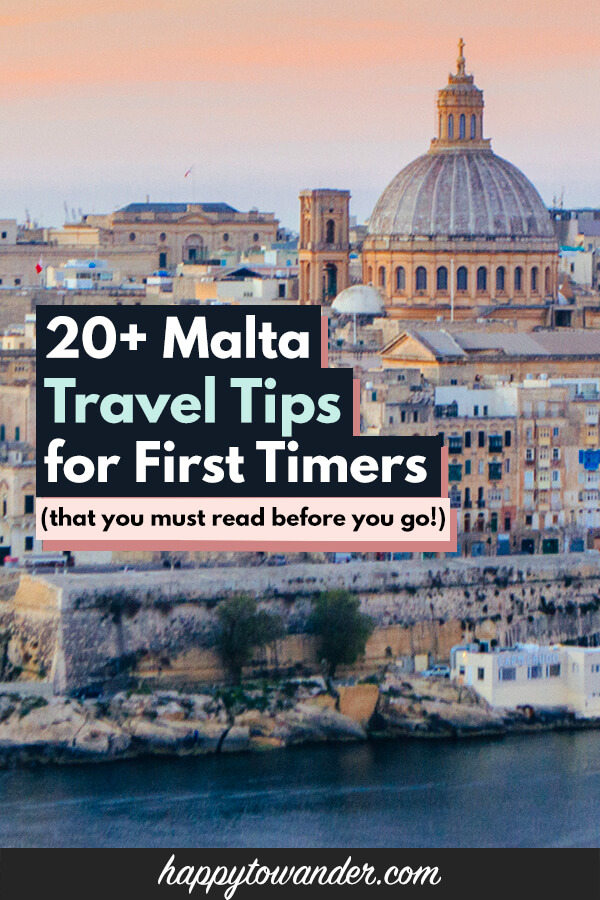
Save this list of Malta Travel Tips for later!
You’ll be very glad you did.
1. Understand that Malta is an archipelago
We’ll start with the most basic of basics: for those new to this wonderland of a country, Malta is an archipelago floating blissfully between Sicily and the Northern Coast of Africa, with its three inhabited islands being Malta, Gozo and Comino.
Depending on how much time they have, most first time visitors will stick to Malta, although visits to Gozo and Comino are popular picks as well thanks to the ease of travel between islands.
So, just know that if you do plan on covering the country of Malta properly, prepare for a few breezy boat rides.
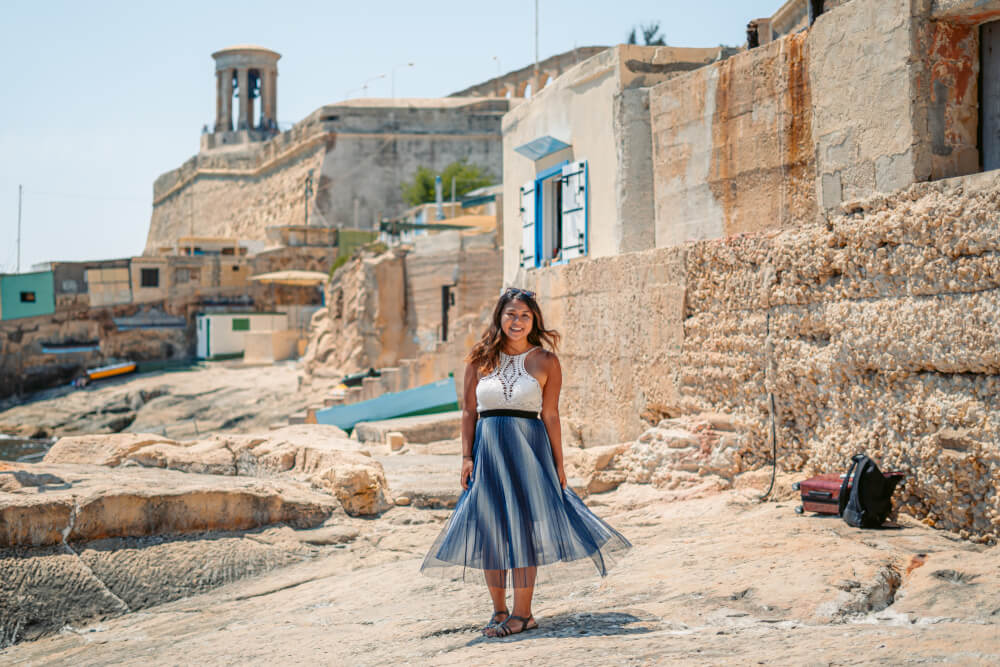
2. Plan your trip for a minimum of four days
Now, onto the next big question: how long should you spend in Malta?
Well, if you want to break my heart, do Malta in a weekend.
But if you want to make me a proud travel mom, plan your trip for at least four days.
Malta may be a tiny country when compared to some others, but it’s packed with impressive sights, so I would recommend coming for a minimum of four days if you want to get a good feel for the main must-dos and possibly venture out to Gozo and Comino as well.
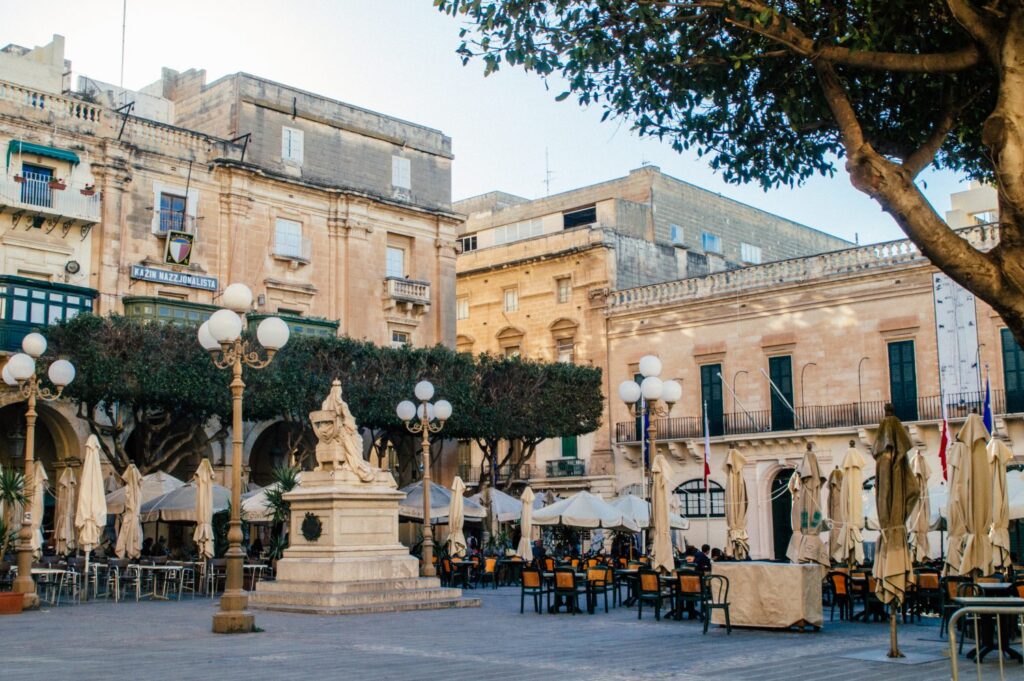
3. Spend more than just a day in Gozo
Now, onto another important Malta travel planning tip: if you plan to Gozo, I implore you to go for more than just a day!
A lot of people, myself included, do Gozo as a day trip, but I would personally stay at least a night there if possible, because that island is absolutely magical and has plenty of sights to fill two days or more.
… When I eventually get back there some day, I might even base myself in Gozo for the trip to explore it further. Yes, it’s that lovely.
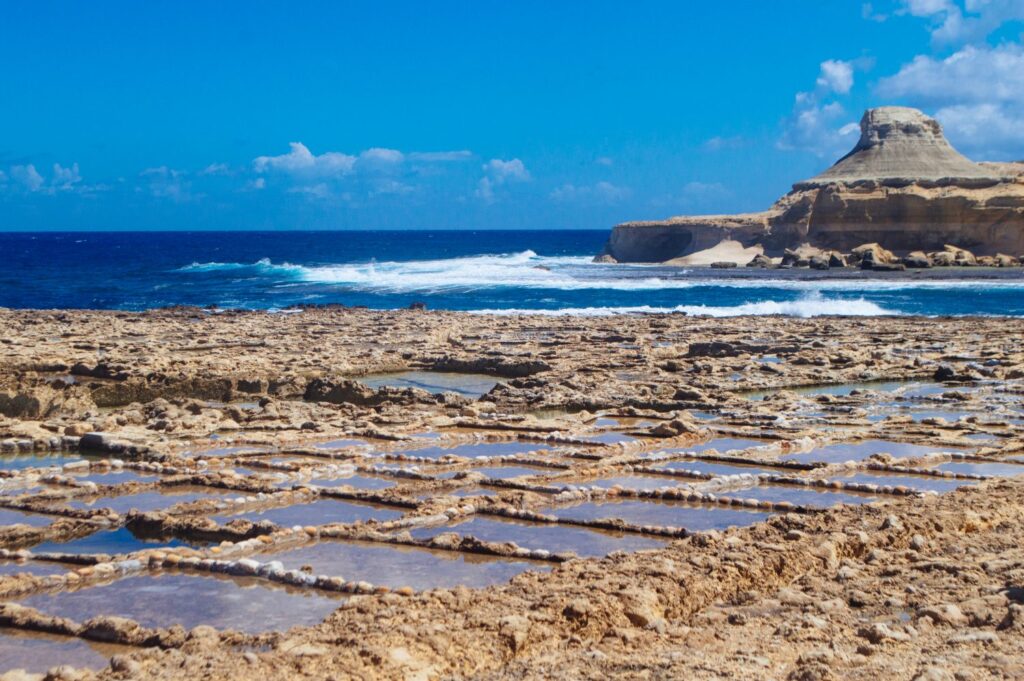
4. Learn some basic Maltese, although English is widely spoken
Now some good news for English speakers: English happens to be one of the official languages of Malta so you’ll have zero trouble getting by with English. Most locals (especially in tourist areas) do speak it well.
But as usual, I do think it’s nice to learn at least a few basics in the local language whenever you can, plus in Maltese it’s pretty simple, so here are a few phrases to commit to memory:
- Grazzi: Thank You
- Bonju: Good morning
- Bonswa: Good evening
- Waranofs in-har it-tajjeb: Good afternoon (maybe avoid greeting people in the afternoon)
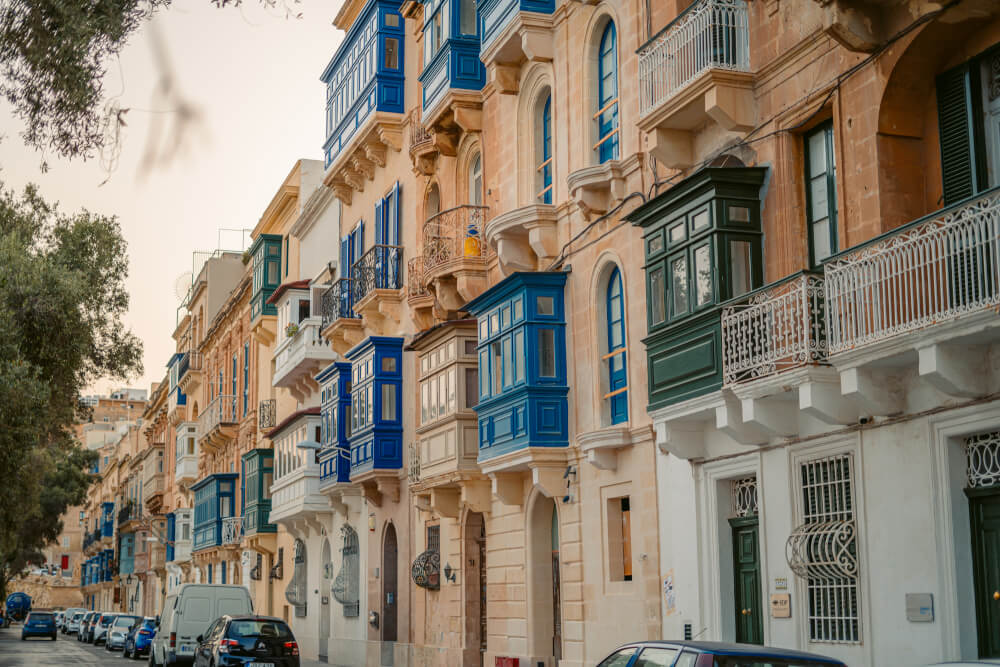
5. Prices are highest in Valletta, so consider staying in other areas
Another money-saving tip for Malta is to consider staying outside of the capital (Valletta) which is where prices will be highest.
Since Malta is so compact, staying somewhere outside Valletta is barely any bother, plus it can also be quieter and less crowded, depending on where you go.
Some options still close to Valletta include…
- The Three Cities – Located just across the water from Valletta, so you can just hop on a fun 10 minute ferry to get across
- Sliema – Great views of Valletta and lots of fun bars/restaurants (although getting increasingly pricey)
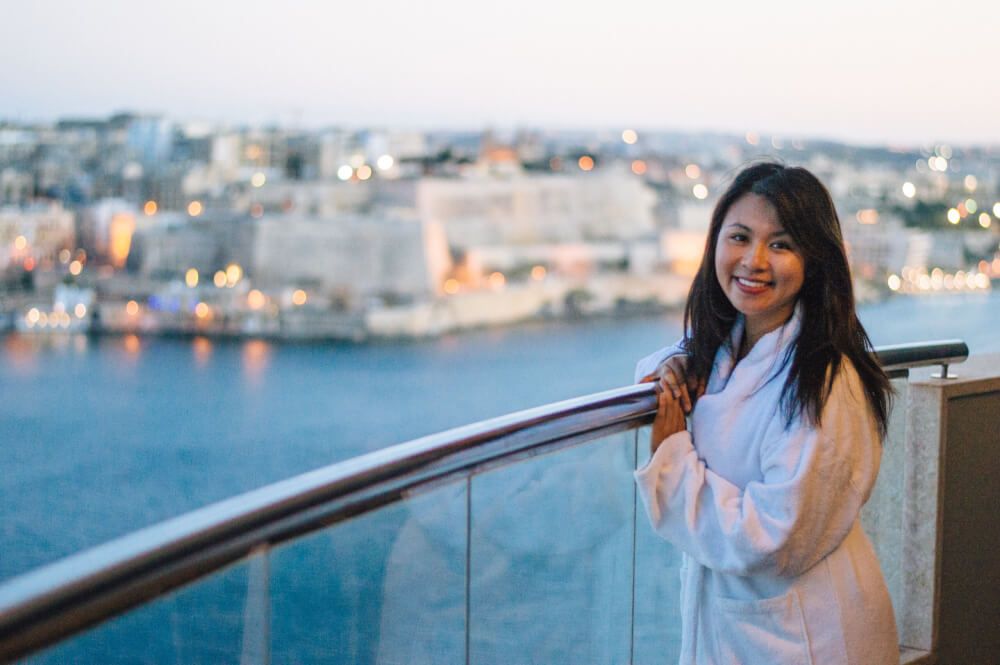
6. Consider visiting in the Spring or Fall
In terms of the best time to go, Malta is commonly known as a beachy ‘tan like a walrus on the beach’ type of place, hence huge crowds in the summer time.
BUT honestly, if you’re like me and want to visit Malta more for its cultural and historical sights, then going in the Spring is definitely a better idea. Summer temperatures in Malta make sightseeing a daunting task, and if you’d rather not be a slippery sweat stick during your trip, then look to avoid July and August.
My very first trip to Malta was in April , and the temperatures were absolutely perfect. I’ve heard Fall can be a good time to visit as well, although conditions tend to be a bit rainier.
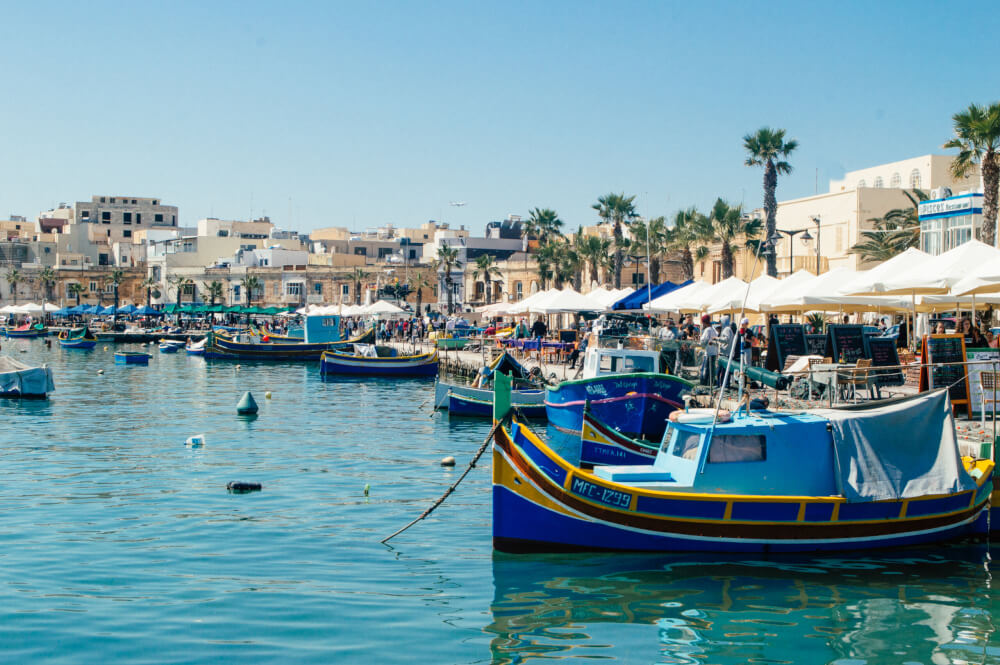
7. In the summer, explore early in the morning to avoid crowds/heat
That said, if you do visit Malta in the summer, one tip I have is to get up really early to explore just after sunrise because this is when you’ll get the least crowds and more tolerable temperatures.
Especially in Valletta, there’s not many places with shade so it gets hot and sticky frighteningly quick.
Then, you can spend the hot afternoons taking a dip in the sea or hiding somewhere with air conditioning. Oh the possibilities!
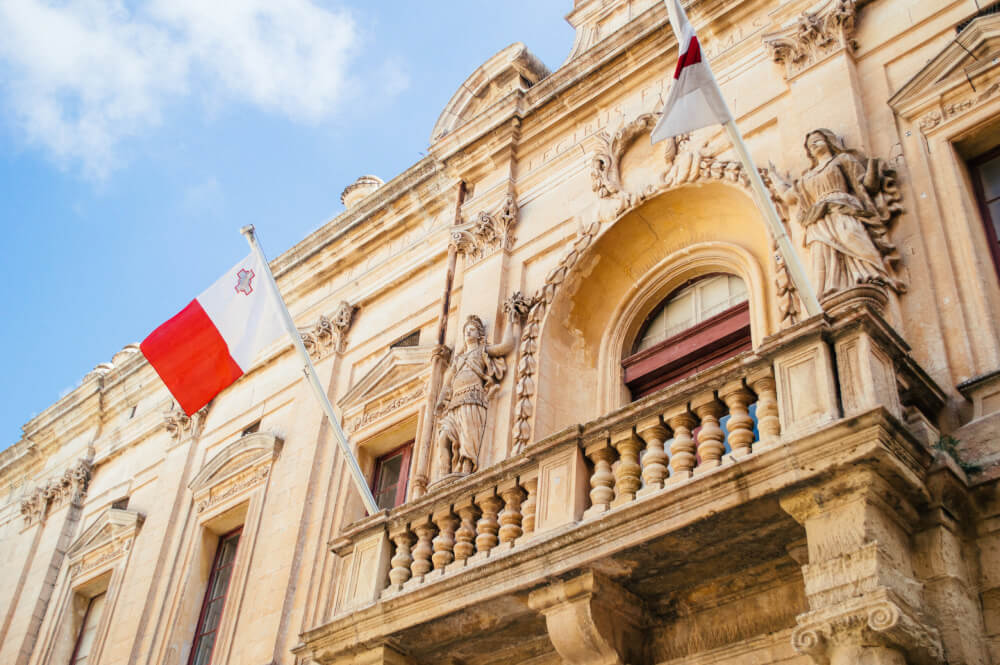
8. Look out for festas and festivals
If you need some help deciding when to visit Malta, it may be worth looking into their festival calendar.
Malta has tons of amazing festivals and festas (religious celebrations) throughout the year, during which the streets are really beautifully decorated and lively.
Visit Malta during one of these special events and you’re likely to encounter fireworks, bands, and processions. Luckily, with over 60 festas on the calendar each year, odds are good that you may run into one.
If not, there are also tons of other fun events throughout the year. During my trips, I’ve experienced a wine festival, a Freedom Day Regatta, and fireworks! Are you seeing why I’m so obsessed with this country now?
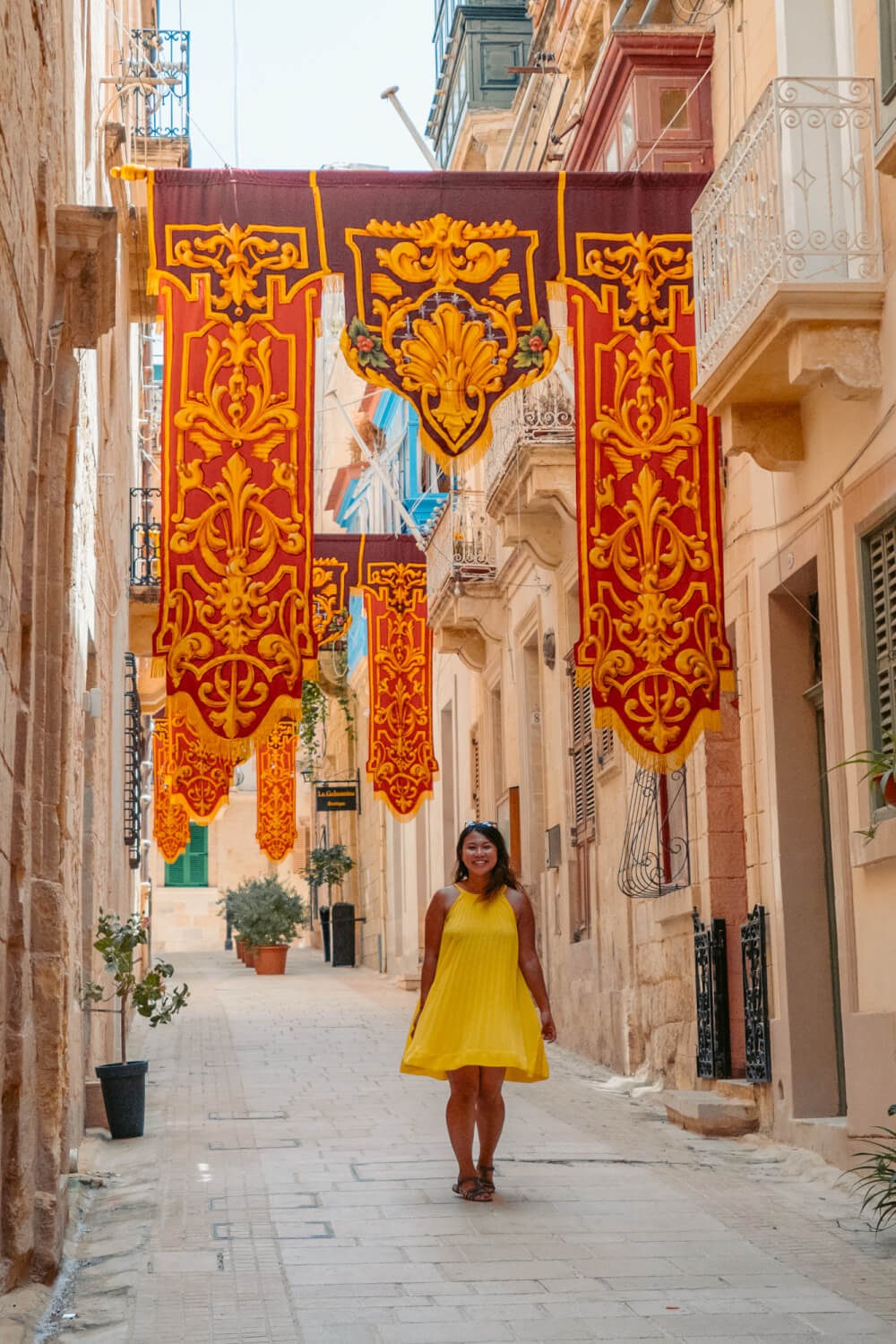
9. Read up on Maltese history before your trip
Another important Malta tip I have for you is to do a bit of research before your trip about the country’s history.
As I mentioned in the introduction, Malta has a really unique culture that you won’t find elsewhere in the world. A large factor in this is the country’s turbulent and lengthy history, which helps contextualize a lot of the sights you’ll see, so learning a bit in advance can be really helpful.
For instance, did you know that there are some temples on this island that predate the Pyramids of Giza by 1000 years?
Or that up until 1964, it was consistently under the rule of different groups? The reason Malta is unlike any place in the world is because the country we see today was formed under the combined influence of the Carthaginians, the Romans, the Byzantines, the Arabs, the French and the English.
… so yes, Malta is as interesting as it is pretty – be sure to read up on it to make the most of your trip!
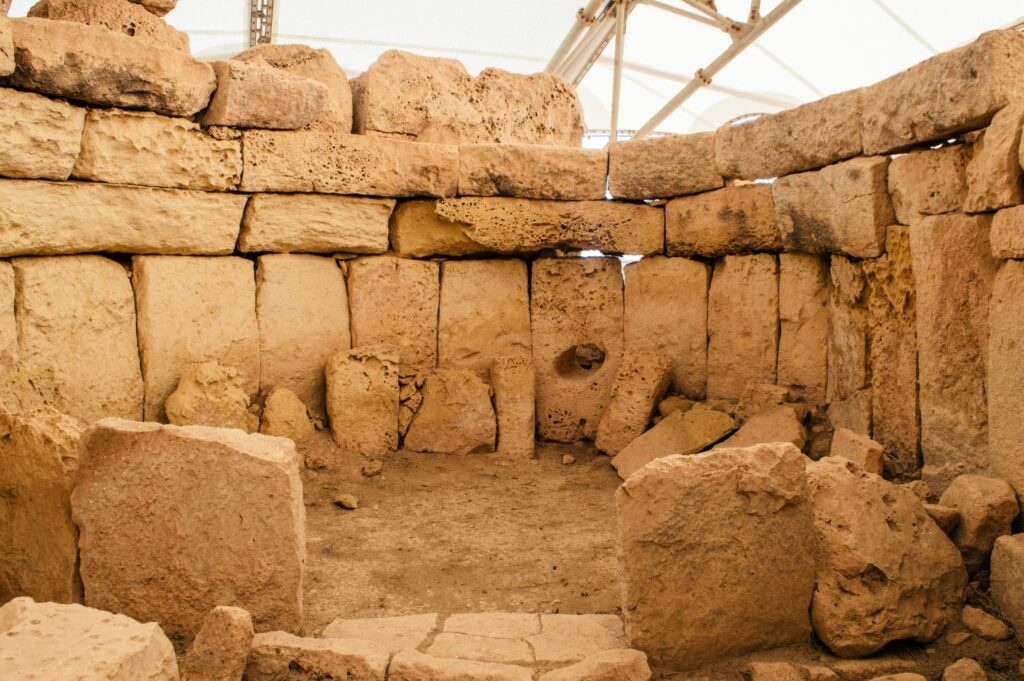
10. Beware of multiple names for streets and places
Now, one of the byproducts of Malta’s historic turbulence is that place names can be a bit confusing… in the sense that there’s often many of them.
Over the past 400 years alone, Malta has been ruled by four different groups with four different languages, hence why these days many names are floating around for various Maltese streets, squares and places.
As an example, the photo below is of Republic Square (Pjazza Repubblika), formerly/sometimes still known as Victoria Square, Piazza Regina, Place de l’Egalité, Piazza della Città and Piazza dei Cavallieri.
So yes, just keep that in mind when getting directions/navigating! There are often multiple names referring to the same place.
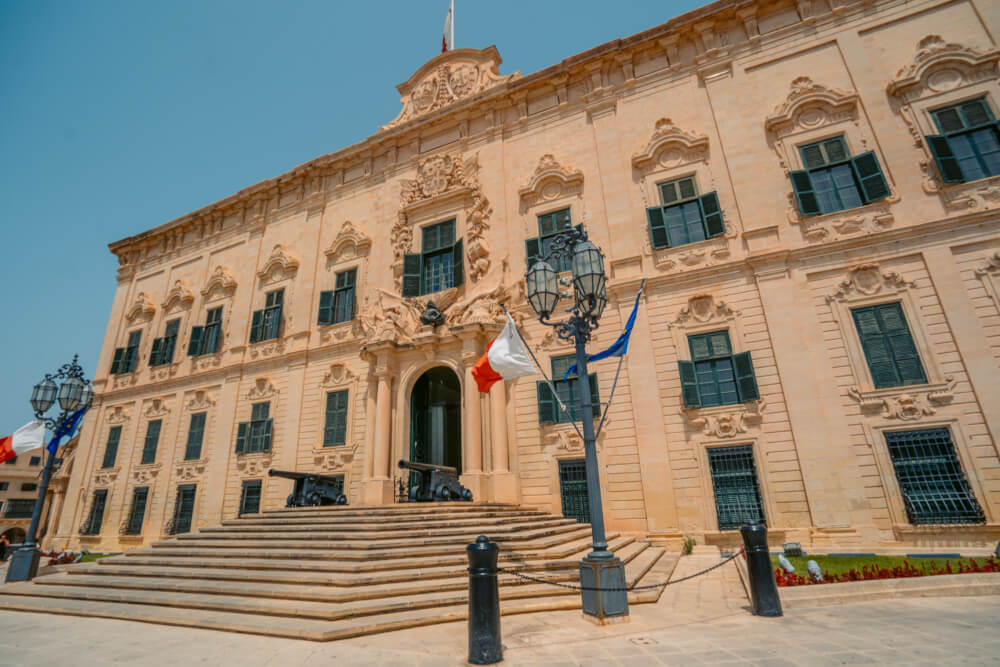
11. Malta is remarkably British
Another byproduct of Malta’s history (that shocks many first time visitors) is that Malta is fairly British in a lot of ways.
Not only do they drive on the left side of the road as we mentioned earlier, there are also red phone booths all over Valletta, their beer is served in pints… and they use the Type G outlets like in the UK, so bring an adapter if coming from Europe.
Currency-wise though, they do use the Euro here. Just to add to the confusion.
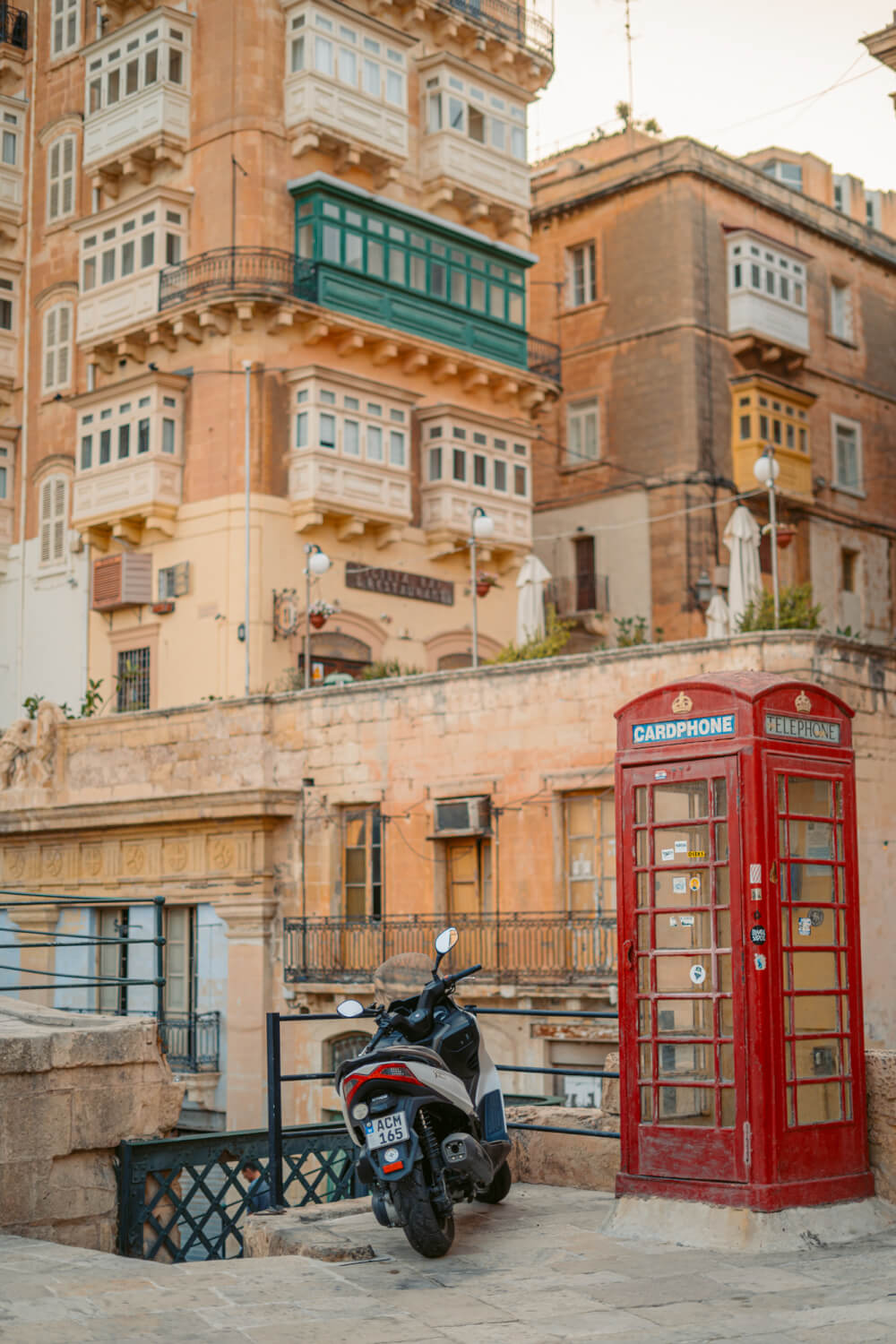
12. Consider hiring private transfers to get around
Malta is a tiny country with a relatively large population and also many tourists. This means a ton of traffic and general chaos on the roads.
… which is unfortunate, because if you want to have optimal flexibility to see the top sights, especially if you want to explore Gozo, having a car is quite essential.
So what should you do if you don’t want the fuss of renting a car and driving yourself?
While in most places, I would just opt for public transport (which we’ll discuss below), I’d say with Malta, private tours offer another great option because they can be surprisingly affordable compared to other touristy European destinations.
For instance, you can book this tour from Malta to Gozo for the day which includes transport and lunch for about 80 euros, which is not bad at all.
So, if I were to plan my own trip to Malta today, I would probably not rent a car and instead book little day trips out like this one to cover more remote destinations.
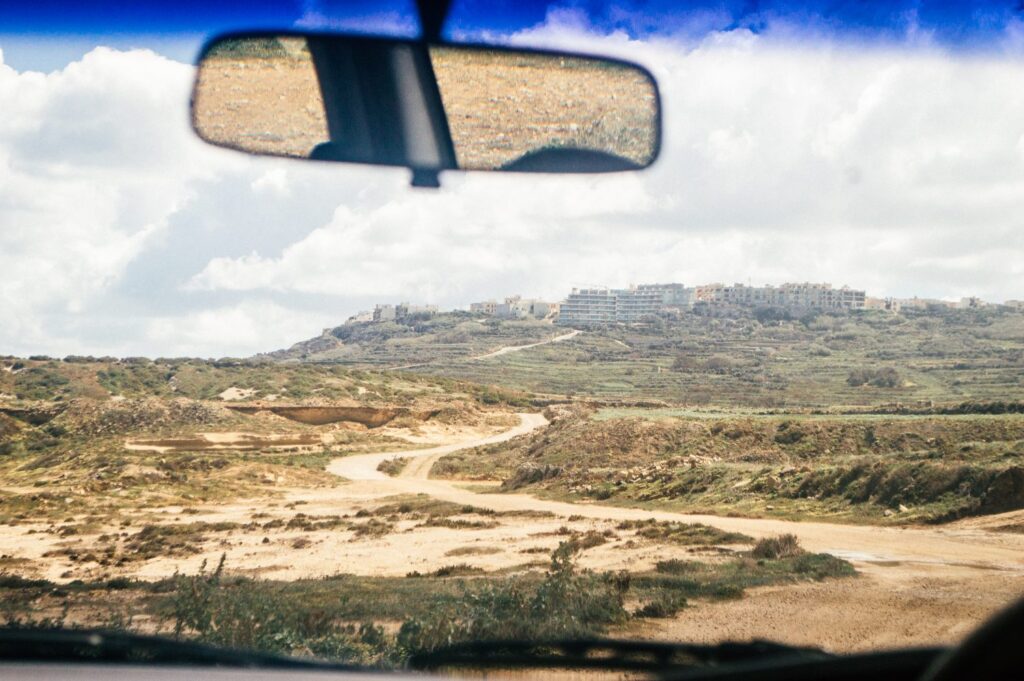
13. Bus travel in Malta is very affordable, though it has its downsides
That said, if you’re on a budget, the good news is bus travel in Malta is very affordable as well.
At full price, a ticket one way is 2 euro, but it can be much much cheaper if you buy a special pass.
So why did I recommend booking private transfers then? Well, unfortunately, bus travel in Malta (especially in the summer) isn’t the greatest. Not only can buses be really crowded, they’re also notoriously unreliable in terms of punctuality.
But hey, sometimes embracing the chaos is part of the fun, so if you plan to take buses around Malta, here is a summary of ways to save money on your bus journeys.
The best bus pass options for tourists in Malta are…
- 12 Single Day Journeys (€15) card: Saves you almost half price on each journey, ideal if you won’t take many trips
- 7-Day Explore Card: Offers unlimited journeys for €21, ideal for a longer stay
- Explore Plus Meep: Offers unlimited travel as well as two ferry trips. I couldn’t find the price for this on their website so it’s unclear if this is still something they offer, but be sure to ask!
NOTE: These passes are much better for tourists than paying the (similarly named) Explore Flex Card which is more for people who commute throughout the year since you only save 15-50 cents per journey and the card itself is 6 EUR.
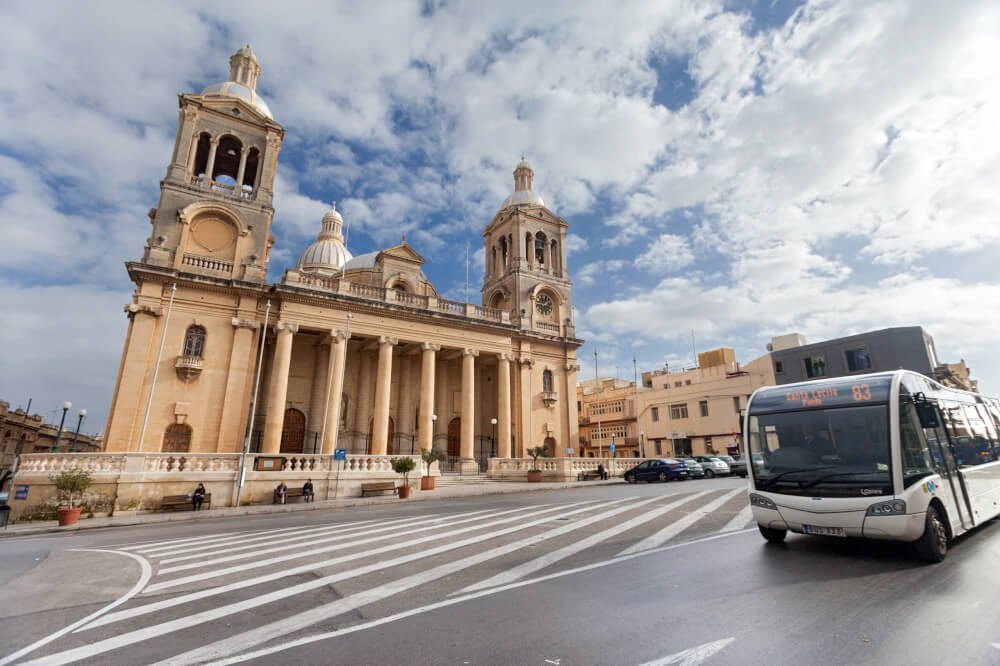
14. Make sure to try plenty of Maltese food
Alright. Are you ready? I’m about to share THE most important Malta travel tips I have with you…
Because we’re now going to talk about Maltese food!
The food in Malta is simply incredible. A few must tries include…
- Pastizzi: A magical pastry with crispy phyllo dough and usually a ricotta or pea filling
- Imqaret: A date-filled pastry best enjoyed with a scoop of creamy Maltese ice cream
- Stuffat tal-Fenek: A stewed rabbit dish that is unbelievably comforting and tender
- Bigilla: A creamy bean dip
- Bragioli: beef rolls stuffed with egg, bacon, bread crumbs, and braised in wine
And lastly, seafood. Eat as much seafood as possible when you’re in Malta. It’s so fresh and so delicious, especially when you go to the fishing villages like Marsaxlokk.
… I’m honestly just drooling while writing this. When can I book my flight?

15. Keep an eye out for Malta’s amazing churches
When you’re not busy swimming in a sea of Pastizzi , another thing to while exploring Malta is to look out for churches.
Malta has hundreds of churches, almost one for every day of the year.
The best part? They’re absolutely beautiful, so if you happen to pass one while exploring be sure to duck in and take a look.
Obviously the most famous one is the St John’s Co-Cathedral in Valletta, but you’ll easily find hundreds of others as you walk around, so be sure to take a peek inside if you get a chance.
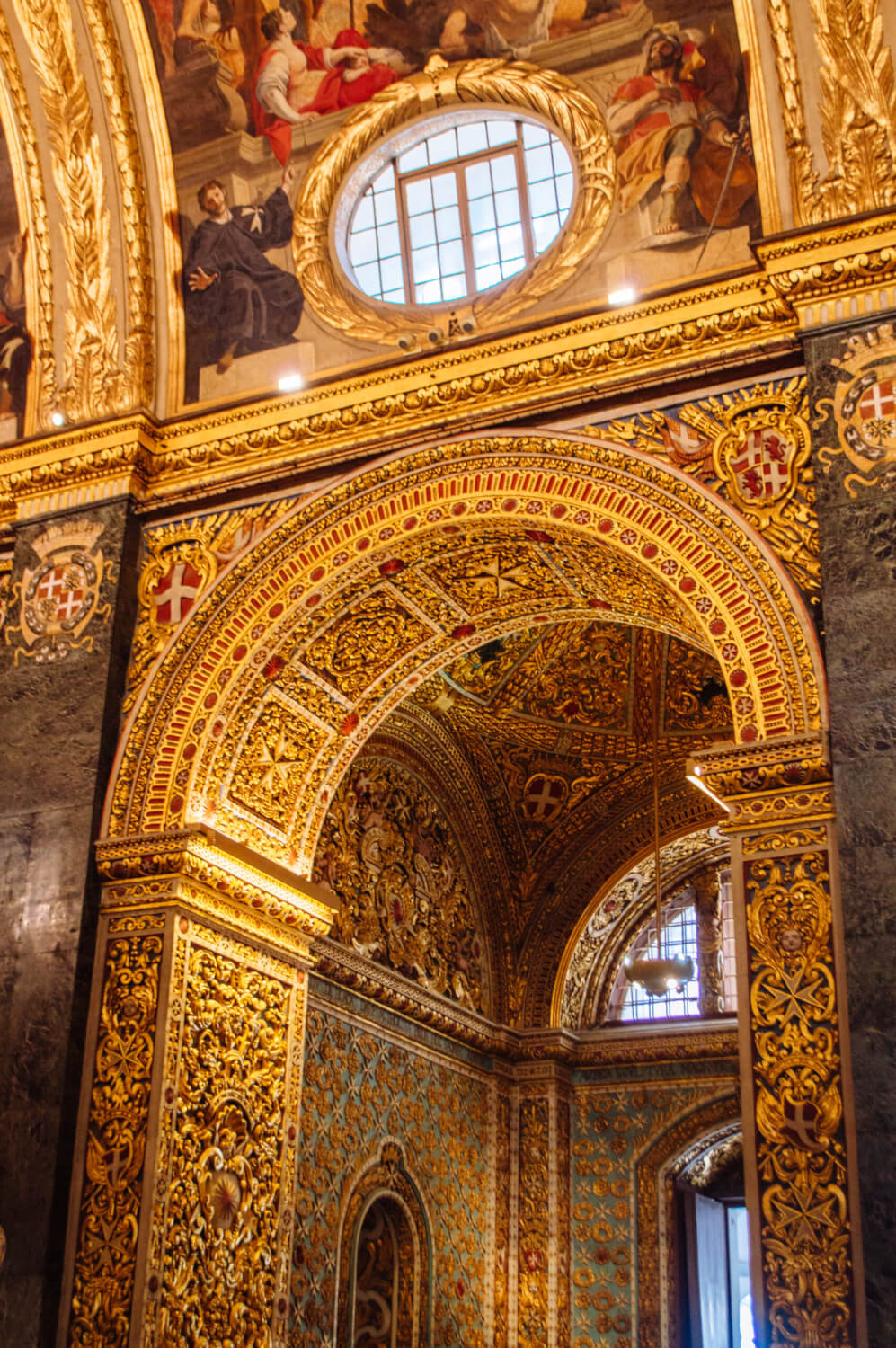
16. Bring coverings to enter churches
One thing to be mindful of though is that your shoulders and knees should be covered when you’re entering churches in Malta, so be sure to bring a lightweight scarf with you to cover up if you’re visiting in the summer.
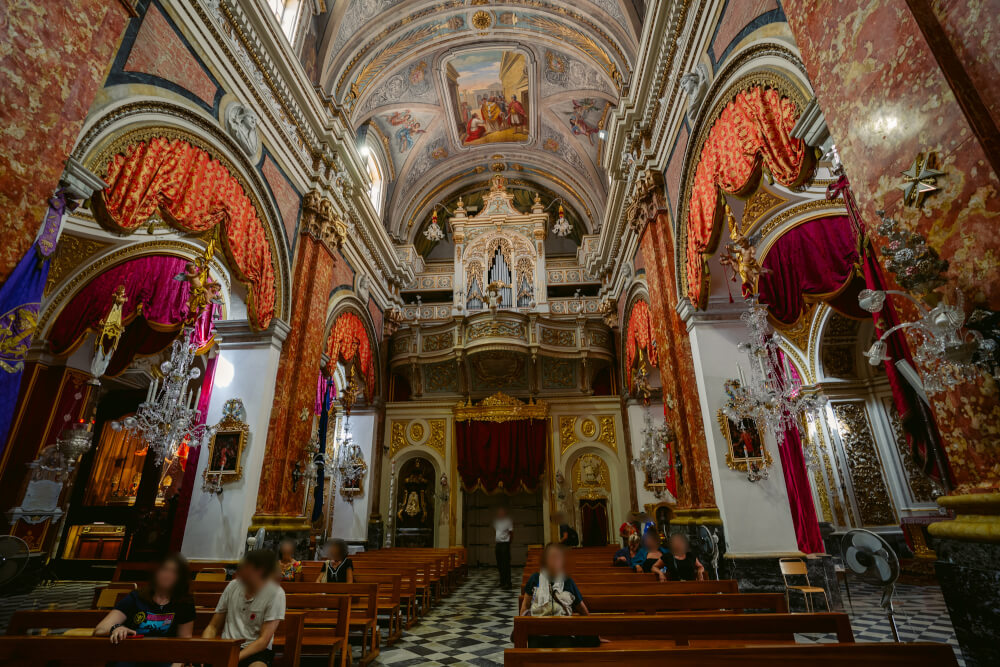
17. Be careful when going out for a swim
Alright, now for a Malta safety tip…
Swimming in Malta is a fun activity that many visitors look forward to, but often they don’t realize a lot of the swimming areas in Malta are quite rocky, and depending on the weather conditions can be a bit rough for swimming, with the occasional threat via Mother Nature too, like jellyfish.
So, definitely do your research before you head out to swim.!
There’s actually a great website for this called WhichBeach that lists out all the beaches in Malta and summarizes the weather conditions and even recommends beaches for particular days depending on the conditions. Be sure to consult it during your trip so you can enjoy Malta’s glimmering waters safely.
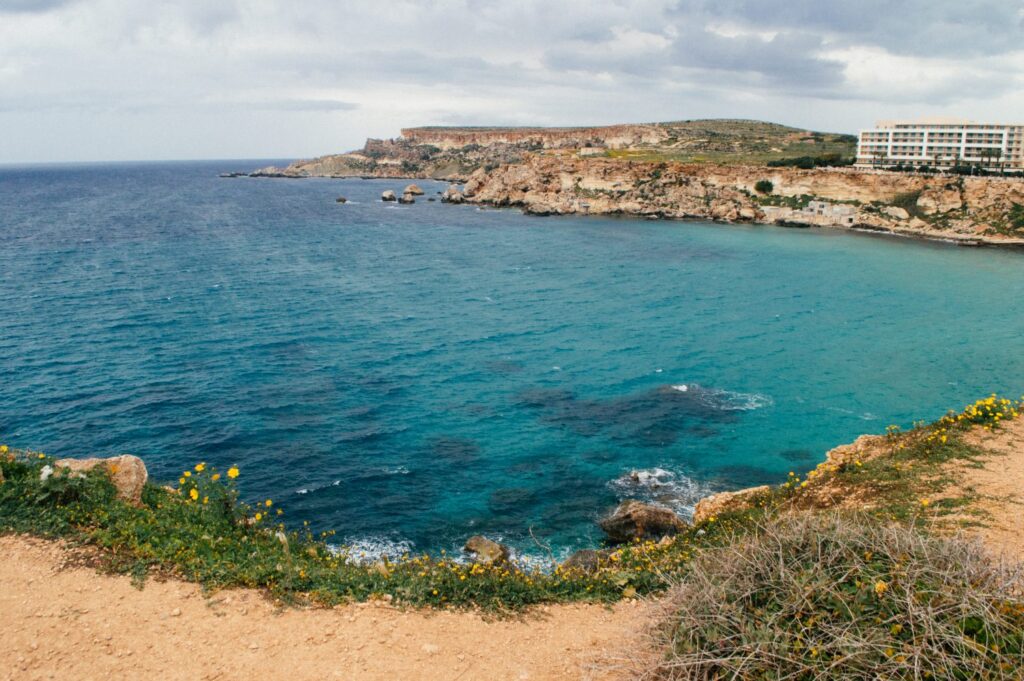
18. Look into a Malta Pass (potentially)
Now, if you plan on visiting a lot of attractions during your time in Malta, there is something called a MaltaPass that includes a bunch of attractions for one set price.
To be honest with you though, I don’t think it’s worth it for most people just because these attractions are really scattered, and many of them aren’t (in my opinion) the coolest things to see in Malta.
So, just know that an attraction pass is an option but look carefully at the actual list of sights before you commit to buying.
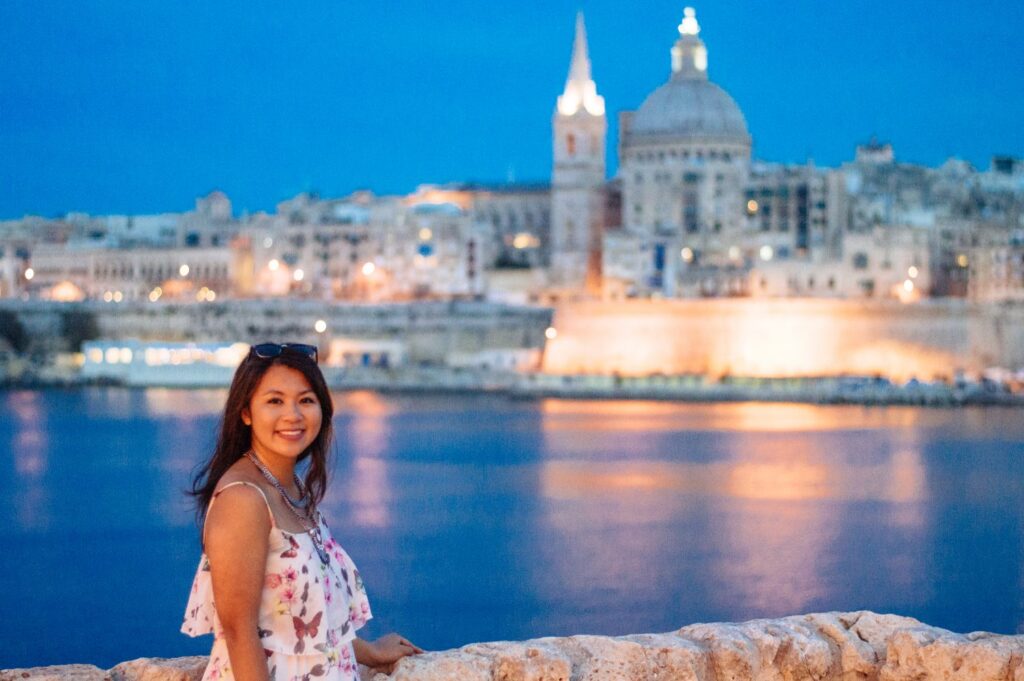
19. A boat ride is a must when in Malta
Now, while a MaltaPass isn’t a must, one thing that is (in my opinion) is taking a boat ride at some point.
Boat rides are just such a lovely way to enjoy Malta from a different perspective, and there are so many great options that you really have no excuse!
I can highly recommend a boat trip around the Blue Grotto in Southeastern Malta or a ferry ride to Gozo or Comino.
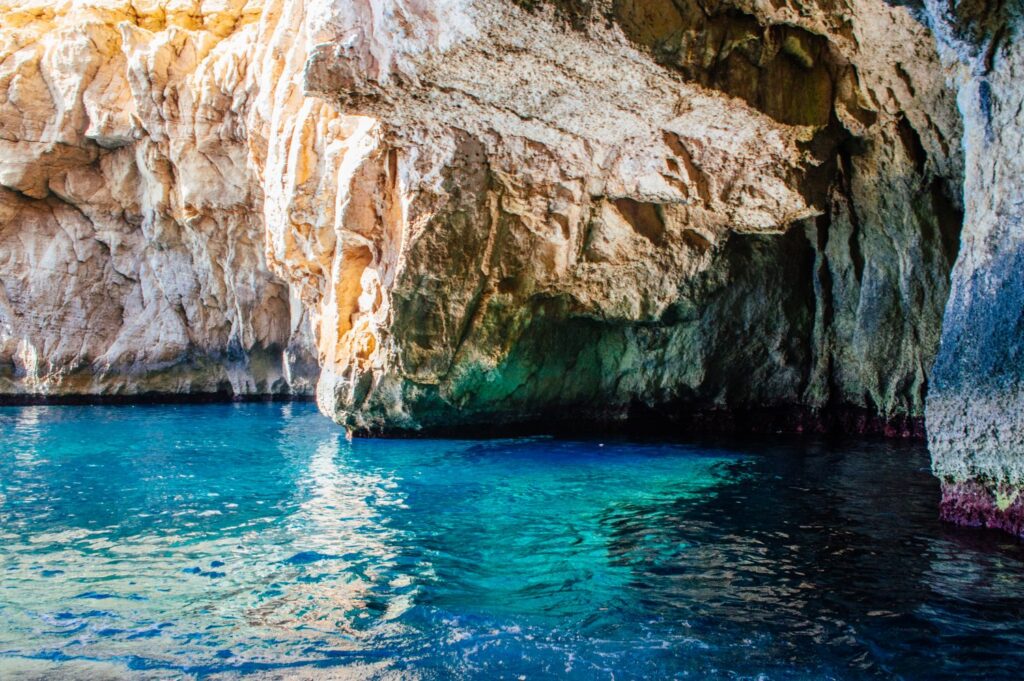
Or, if you’re looking for something cheaper, hopping on a ‘dghajsa’ from Valletta over to the Three Cities is also super fun.
These are gondola-esque Maltese water taxis that allow you to get amazing views from the water. They may not be one of those superyachts you’ll find docked nearby, but dayum if the views aren’t wonderful (and cheap – at only 2 euros one way!)
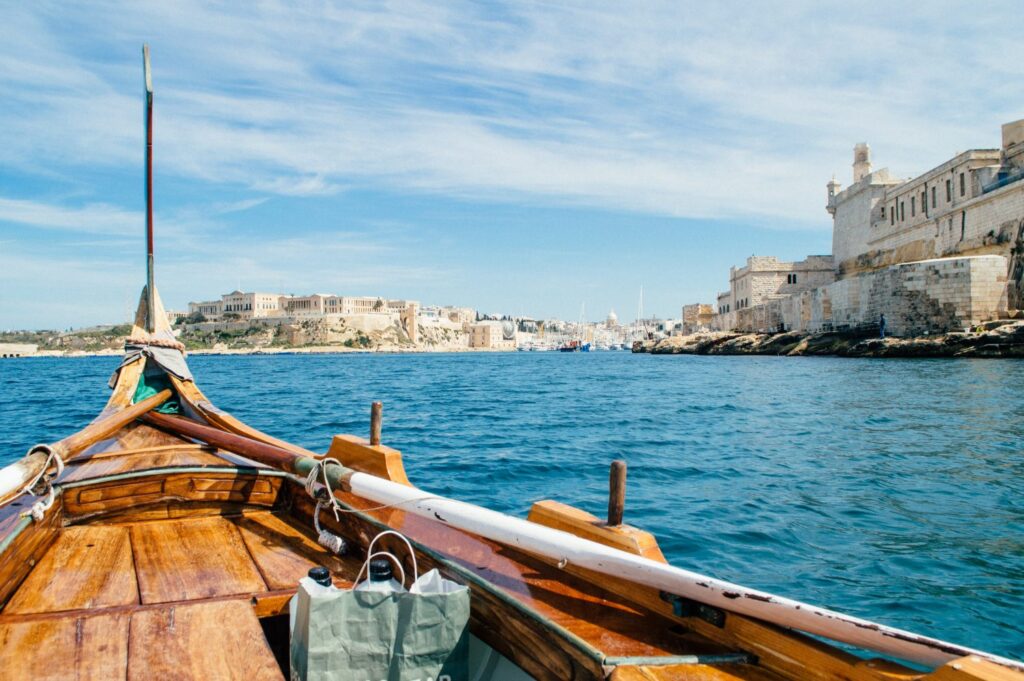
20. Beware that Instagram often doesn’t tell the full story
Now before we wrap up, I do want to do a quick round of Instagram vs reality… just because I think Malta (while undeniably stunning) is one of those very photogenic places that often get misrepresented on social media.
First off, some sad news: in case you weren’t already aware, the natural arch formerly known as the Azure Window sadly collapsed into the sea in 2017, so if you’ve seen photos of this iconic spot before, it’s unfortunately no longer around:
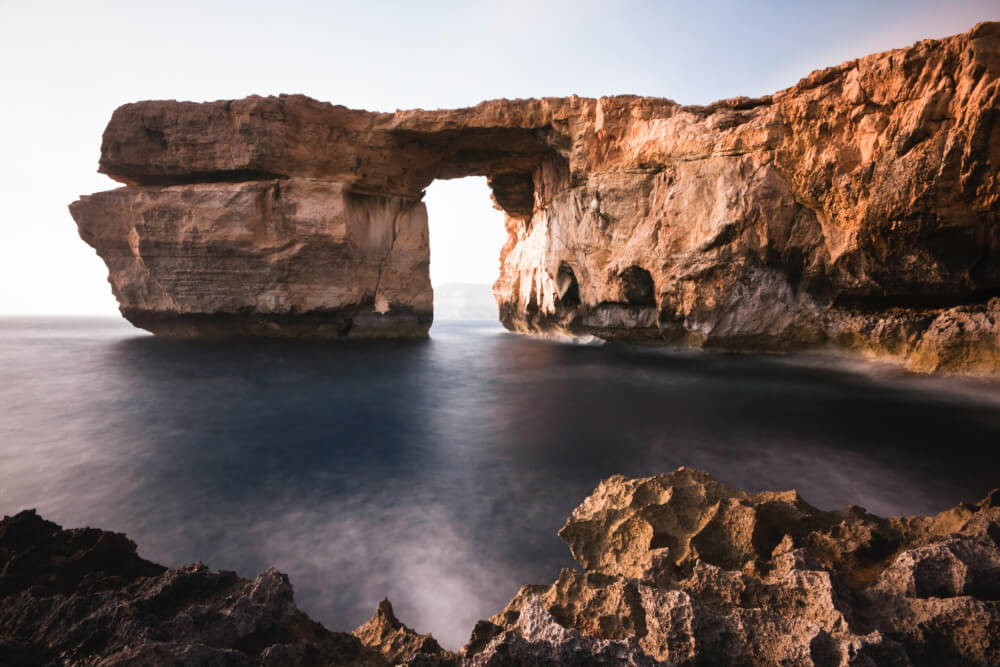
Now for Valletta, Malta’s capital. I just need you to beware that while they make for some truly epic photos, the streets here are actually quite steep and hilly, so make sure you pack good walking shoes to conquer them!
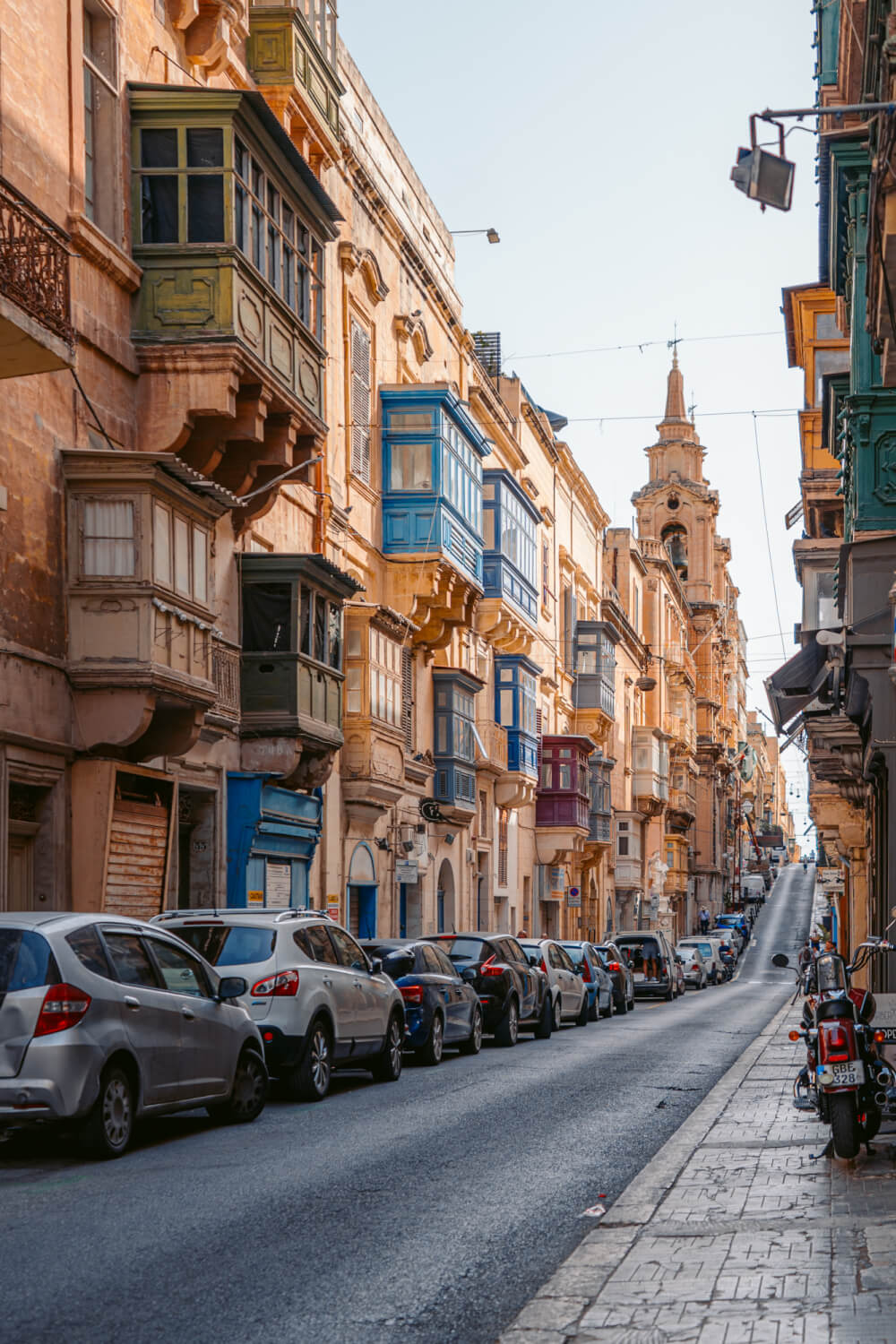
Another warning: Mdina is an amazing place to visit in Malta known as the Silent City, and although many photos will depict the streets looking empty, you should know that an early (or very late) arrival is crucial to actually seeing Mdina without huge tourist mobs, as it’s one of the most popular day trip destinations in Malta.
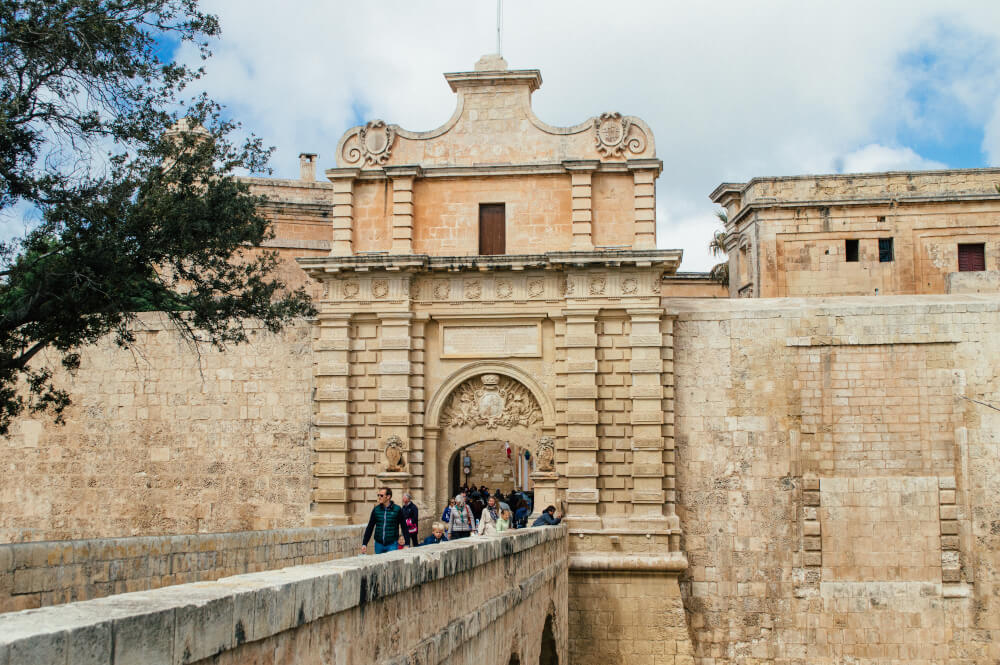
Lastly, we have to talk about the Blue Lagoon on Comino. Most photos you see will show it as an empty oasis, but in the summer time, it really does get so busy to the point where online reviewers liken it to a giant hotel pool, so just have your expectations in check if you’re visiting in peak season.
Visit in April and take the last boat out however, and you may luck out with these views like I did:
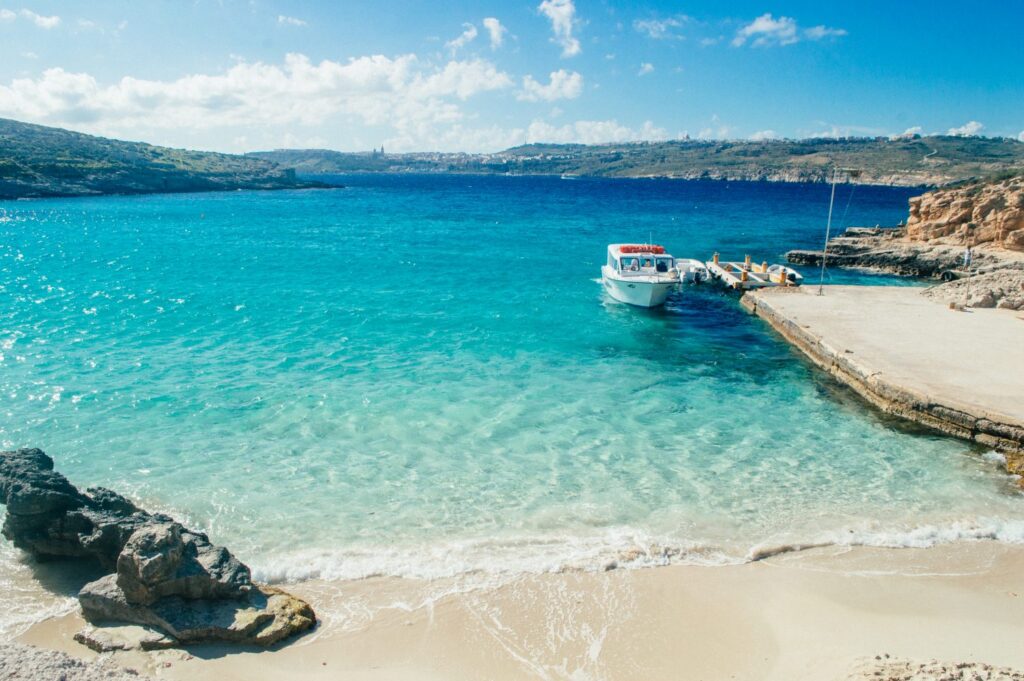
21. Know that Popeye Village is a theme park
This is a niche Malta tip, but one that I think nobody covers, so here goes…
Another spot you’ll see many photos of is Popeye Village , often shown as a scenic backdrop, like so:
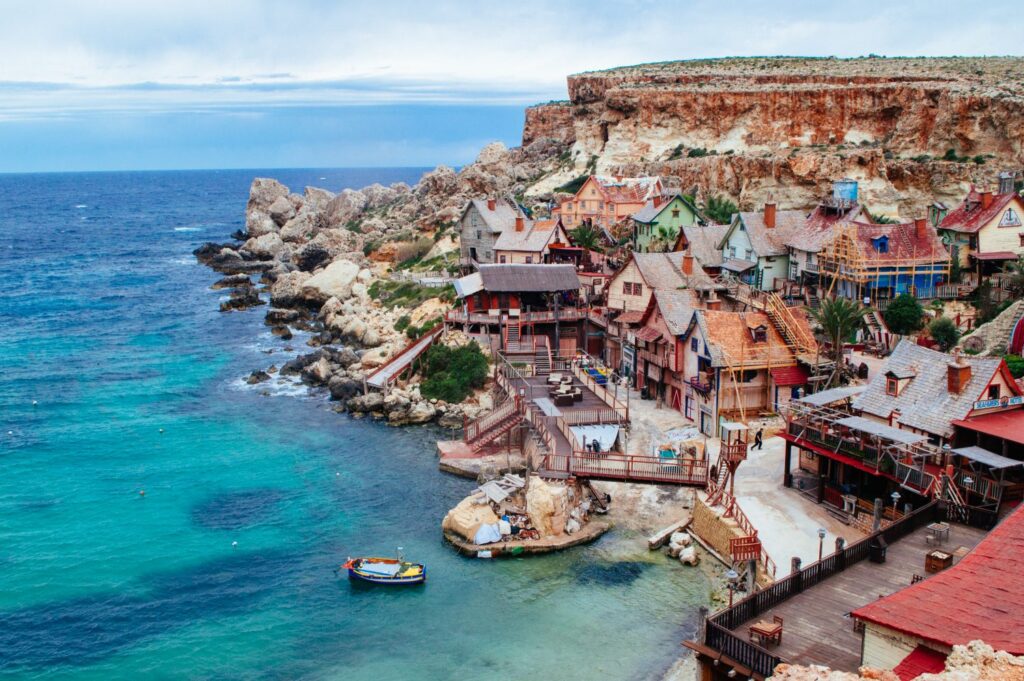
BUT, for first time visitors, it’s important you know that this spot is actually pretty far up North and not close to Valletta or any other big tourist sites so you do have to go sort of out of your way to come here. It’s also not a real village, but rather a film set from the 80s that they kept and turned into a theme park.
Do I recommend actually paying to see the inside? Well, I personally loved it because I’m a huge fan of quirky and strange places (like the Arnold Schwarzanegger Museum in Austria) but beware that the park is fairly outdated, there’s not really rides, and overall, it’s kind of expensive for Malta because an adult ticket is 20 euro.
That said, I do think it’s a fun place if you need to entertain kids, or if you’re a kid at heart like I clearly am.
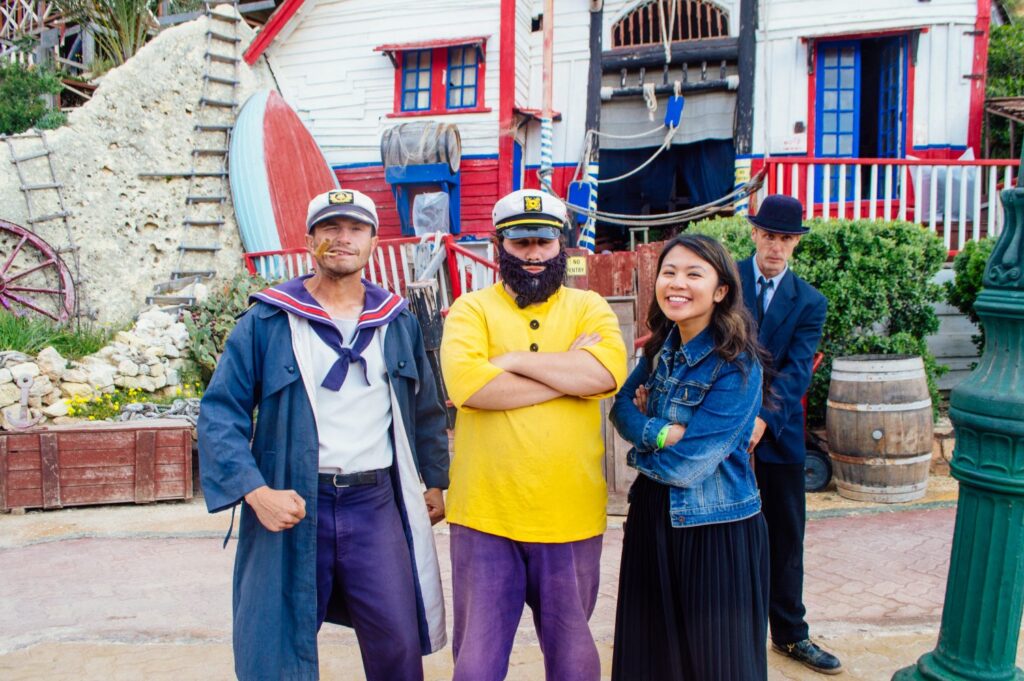
22. Binge some movies and TV shows set in Malta before you go
Lastly, this is an incredibly dorky tip, but there are SO many movies that have filmed in Malta over the years, so a really great thing to do in advance of your trip is simply binging some to get excited.
Some big name ones you might recognize include…
- Assassin’s Creed
- Murder on the Orient Express
- … and season one of Game of Thrones!

I hope this list of Malta Travel Tips was helpful!
This was already a very long list of tips for Malta, but if you have any more questions, let me know in the comments. Safe and happy travels!
My Go-To Travel Favourites:
🧳 Eagle Creek: My favourite packing cubes
💳 Wise: For FREE travel friendly credit cards
🍯 Airalo: My go-to eSIM
🏨 Booking.com: For searching hotels
📷 Sony A7IV: My (amazing) camera
✈️ Google Flights : For finding flight deals
🌎 WorldNomads: For travel insurance
🎉 GetYourGuide: For booking activities
1 thought on “20+ Malta Travel Tips for First Timers & Must Knows Before You Go”
Thanks for providing such a resourceful info about the place. It’s insightful. Got to know some amazing facts.
Leave a Comment Cancel reply
By using this form you agree with the storage and handling of your data by this website. *
Visiting Malta: what to know, how to drive, where to eat and more
Jun 3, 2022 • 6 min read

Walks around historic cities like Mdina are a highlight of any visit to Malta; pack comfortable shoes © Sun_Shine / Shutterstock
Compact, easy to get around and with a friendly English-speaking population, Malta is a relaxed and convenient destination filled with pleasures.
Taking note of a few pre-departure tips will make a trip to the Mediterranean’s smallest island nation even more enjoyable. Here’s all you need to know before your trip to Malta.
Book well ahead for Malta’s most amazing sight
A 5000-year-old subterranean necropolis only rediscovered in 1902, Malta’s Ħal Saflieni Hypogeum is one of the country’s essential sights. As such, it’s extremely popular – and to protect the fragile, centuries-old interior, entry is limited to 80 people per day. Booking ahead online before arriving in Malta is highly recommended. Last-minute entry tickets, which also sell out quickly, are available the day prior for an additional charge of €15.
Pack a good pair of walking shoes
Malta is a great place to explore on two legs, especially around Valletta and in the hilltop walled city of Mdina . Note that both places involve plenty of steps and centuries-old cobblestones, and wearing a comfortable pair of walking shoes is recommended. If there’s a bit of rain, laneways and plazas can also become slippery, and are probably not best negotiated in a pair of sandals or flip-flops. Good walking shoes also come into their own when exploring clifftop hiking routes like Malta’s Park tal-Majjistral or the Xlendi Walk on Gozo. An effective sun hat and sunglasses are also essential to combat the heat of a Mediterranean summer.
Hit the ground running when exploring Malta’s fascinating food scene
As an island country in the middle of the Mediterranean Sea, Malta has a cuisine that’s been influenced by various cultures throughout the centuries. French, British, Italian – especially Sicilian – and Arabic flavors all overlap in the diverse food traditions here. Before leaving home, book a walking tour with Offbeat Malta Food Trails for when you first arrive in Malta. That way, you’ll be up to speed and armed with cultural and historical culinary insights as you explore local restaurants, island vineyards and food markets across Malta and its smaller sister island of Gozo .
It’s also worth booking well ahead for popular Michelin-starred restaurants like Valletta’s Noni , especially during Malta’s busiest travel months from July to August.

Sign up for an International Driving Permit
Malta is an excellent destination to explore independently in a rental car, especially on the quieter roads of Gozo. Car rental prices are some of the lowest in Europe, and having your own ride offers more convenience and efficiency than relying on Malta’s extensive but sometimes slow bus service. As in the UK and most Commonwealth countries, drivers need to stick to the left-hand side of the road. Booking ahead for rental cars is recommended for visits in July and August.
Travelers from the UK and European Union countries can use their home driving licenses, but if you’re coming from a non-EU country you’ll also need an International Driving Permit (IDP). These are issued for a one-year period by local automobile associations in travelers’ home countries.

Bring your driving A-game
Especially when driving around Malta’s main urban conurbation (incorporating Valletta, Sliema and St Julian’s ), it’s worth channeling a confident approach to getting behind the wheel. Traffic is often very busy, and local drivers can regard indicators for signaling a turn as optional. Yielding (giving way) at roundabouts is also routinely ignored. Just drive with confidence (plus an added level of awareness) and you’ll be fine.
Outside of Malta’s most built-up areas, driving is much less stressful, and having a car makes getting around Gozo and to Malta’s more remote beaches and destinations much easier. As a pedestrian, also never assume that local drivers will stop for you at pedestrian crossings.
Practice in-car safety
Malta has a very low rate of violent crime, but there are occasional reports of rental cars being broken into at beach car parks, especially if they’re adjacent to a more remote stretch of sand. Lock your car and don’t leave anything of value inside. Also take extra care with belongings when swimming and sunbathing on all beaches, as occasional opportunistic thefts do occur.
Learn a few words of Maltese
Everyone speaks English in Malta, but it’s still worth learning a few key phrases in the country’s national language (also known as Malti). Most closely related to the Arabic dialects of western North Africa, Maltese is Europe’s only Semitic language (other Semitic languages include Arabic, Hebrew and Amharic) and it’s also a language with a few loan words easily traced to their country of provenance.
Here are a few key Malti words to assist you during a trip:
• merħba (hello) • bonju (good morning) • bonswa (good evening) • grazzi (thank you)
Remember that Malta is a largely conservative country
With a strong Roman Catholic heritage, Maltese society remains largely conservative. Dress respectfully when entering a church – having a shawl to cover shoulders is a good idea – and hats and sunglasses should be removed. Away from the beach, cover up with a sarong and T-shirt, and note that topless and nude sunbathing is illegal. When meeting someone for the first time, a handshake is appropriate.
Expect a high level of health care
High-standard health and dental care is readily available, and Maltese pharmacists can give advice and sell a wide range of over-the-counter medications. Holders of a European Health Insurance Card (EHIC) – available to citizens of the EU and Iceland, Liechtenstein, Norway and Switzerland – receive free or reduced-cost health care while in Malta, and the country has reciprocal health-care agreements with Australia and the UK. Visitors from other countries should definitely have travel insurance.

Look to the locals for swimming safety
The Maltese have a well-known phrase, “ Il-baħar żaqqu ratba u rasu iebsa ,” meaning “The sea has a soft belly, but a hard head.” While beaches are largely safe in calm weather, storms, windy weather and strong undercurrents can present danger, and locals advise never to swim in rough seas. Major beaches operate a flag system and have lifeguards on patrol from June to September. If there’s no flag system operating, or if you’re in doubt, ask a local about whether and where it’s safe to swim.
Be vigilant in nightlife areas
Fueled by alcohol, fights and drunken violence have been known to occur in nightlife areas, especially around the late-night clubs of the Paceville area. Keep your wits about you, even (or especially) after a cocktail or two.
Malta and COVID-19
As of May 9, 2022, wearing a mask in Malta is only mandatory on flights, or when visiting a hospital or aged care home. While not mandatory, the Maltese government still recommends masks be worn when attending large gatherings.
Travelers no longer need to complete a digital Passenger Locator Form (PLF) but must present either a vaccine certificate, a recent negative PCR test or COVID recovery certificate upon arrival. See Malta’s Health Ministry website for the latest on COVID-19 regulations.
Explore related stories

May 13, 2024 • 13 min read
Be inspired to explore Europe by car this summer on one, or more, of these themed driving routes.

Dec 27, 2023 • 8 min read

Oct 25, 2023 • 7 min read

Sep 29, 2023 • 9 min read

Jul 20, 2023 • 6 min read

Jan 6, 2023 • 6 min read

Sep 28, 2022 • 6 min read

Jun 11, 2022 • 4 min read

May 24, 2022 • 8 min read

May 22, 2022 • 7 min read

18 Must-Know Malta Travel Tips for First-Time Visitors
I’d like to officially declare Malta, a beautiful Mediterranean island , as visit-worthy . From the unique vibe of Europe meets the Middle East to the food to the views, Malta is not like any other destination I had visited.
To help you make the most of your time in this gorgeous country and plan your itinerary, here are some essential Malta travel tips.
* This post may contain affiliate links from which I earn a commission (for more info, read my disclosure ). As an Amazon Associate, I earn from qualifying purchases.
* I try to keep the information on this blog as updated as possible, but I still recommend consulting the latest prices, opening hours, and other details on the official website of each site, hotel, and tour, as well as checking the updated public transport routes and timetables.
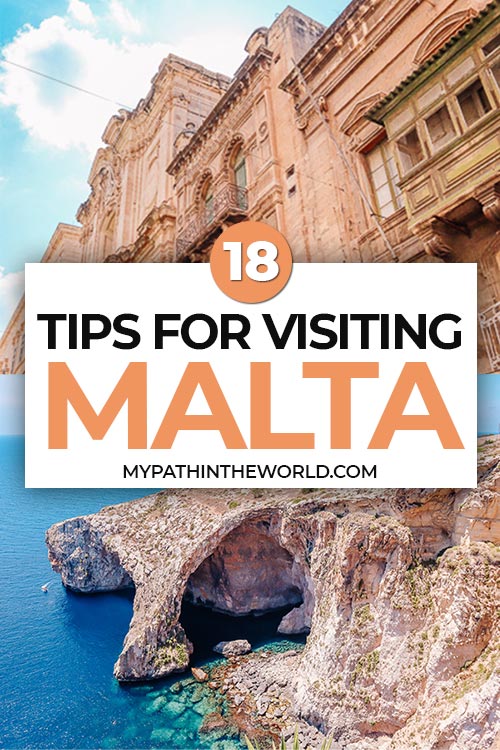
Table of Contents
A Few Things to Know about Malta
- Capital city: Valletta.
- Geographic size: 121 square miles, 316 km².
- Population: Over 440,000.
- Language: Maltese.
- Religion: Roman Catholic.
- Currency: Euro (bring some cash and your credit cards).
Essential Malta Travel Tips
Where to stay in malta.
When choosing where to stay on this island, it all comes down to what you’re planning to do on your vacation in Malta.
If all you seek is to relax and soak up some sun (which is totally legit) consider staying in a town like Mellieha in the northwest of the island (where Malta’s biggest sandy beach is).
If you want to travel around Malta (which I highly recommend), both Sliema and Valletta (the capital) are lively cities from which you can take day trips.
They are well-connected to other parts of the island by public transport, so many travelers base themselves in one of these two locations.
To see all of your options and understand the pros and cons of each area, you can also read my full Malta accommodation guide or my guide to where to stay without a car .
I stayed at Slimiza Suites in Sliema (unfortunately, its rating dropped recently) . Higher-rated options in Sliema include Marea Boutique Hotels , Seafront Duplex Penthouse , and Amery House .
If you prefer to base yourself in the landmark-packed capital, Valletta, check out hotels like Tano’s Boutique Guesthouse , Ursulino Valletta , or 66 Saint Paul’s & Spa .
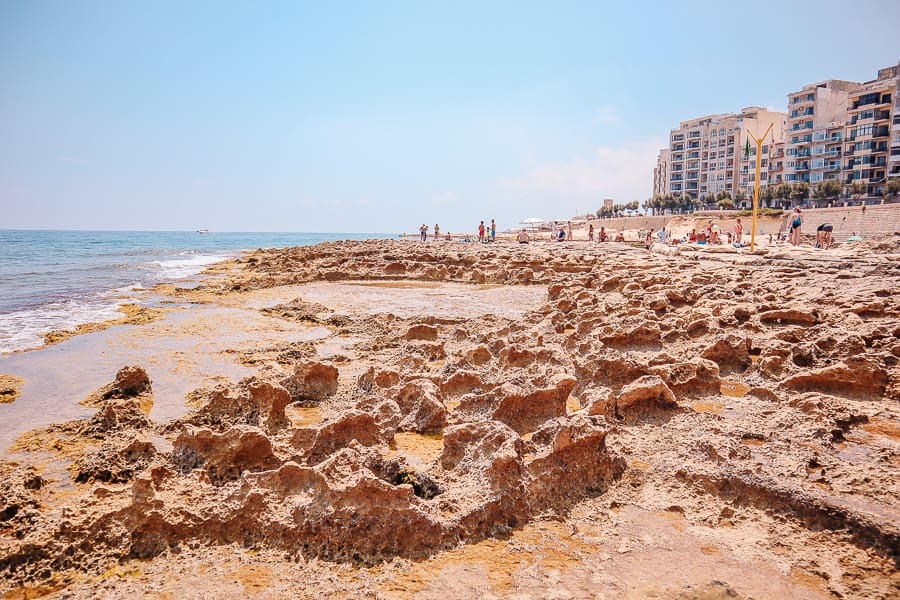
Visiting Gozo and Comino
We can’t talk about visiting Malta without mentioning its two other islands, Gozo and Comino.
While the uninhabited Comino is famous for the Blue Lagoon, some of Gozo’s popular attractions are the Citadel in Victoria, the salt pans, Dwerja Bay, and Ramla Bay.
There are a few ways to visit these islands:
– Cruises from Sliema – you’ll see plenty of signs in the ferry area promoting these cruises (and don’t forget to use these helpful cruise apps if you choose to take one) . You can also book tours like this one online.
– The Gozo Fast Ferry from Valletta.
– Full-day tours from Valletta, Sliema, and St. Julians.
– Boat tours and cruises from the northwestern part of Malta, usually from the area of Bugibba ( you can compare all itineraries and prices here ).
– Take a bus to Cirkewwa (bus 222 from Sliema or bus 41 from Valletta) and take the ferry from Cirkewwa to either Gozo or Comino. When getting to Gozo, you can explore it by car, taxi, bus, or sightseeing bus .
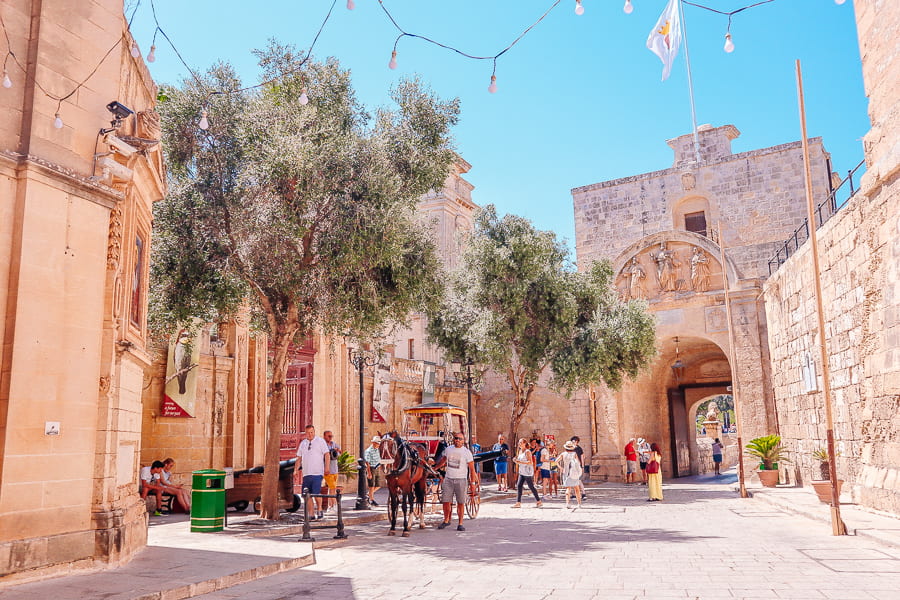
When to Visit Malta
Ideally, you’ll want to travel to Malta in mid or late spring, early summer, and early or mid-fall to enjoy the best weather and avoid the crowds of the summer months (though Malta is now a lot more popular not only in July and August).
If your only options are July and August, choose July when the temperatures are still quite bearable, but visiting Malta in April , May, June, September, and even October is better (but take some possibly cloudy and rainy days into consideration).
With the hot weather during these months, some of the most important things to pack for Malta and Gozo (and Comino) include sunscreen and a reusable water bottle that will actually keep your water cool (I love Corkcicle’s canteen ).
Keep in mind that though it has become safe to drink tap water in Malta, you might not like the taste or still want to use a bottle with a filter.
If you love chasing the winter sun in Europe , you should also consider Malta for an off-season trip. You will definitely see much fewer tourists and pay a lot less per day for accommodation.

Traffic Is an Issue
No matter how you choose to get around Malta, be prepared for a lot of traffic. And more traffic. And some more traffic. This is a known issue in Malta and one of the reasons I didn’t want to drive there.
Although you shouldn’t panic too much about it (because there’s nothing you can do to change it), it is something to think about when planning your Malta itinerary .
Getting from one point to another will take longer than it should, and you should just be aware of that.
Getting Around Malta by Car
Sometimes there’s nothing like a good old road trip. You have utter freedom and flexibility to go wherever and whenever you want. Yet in Malta, there are a few things to consider before deciding to get around the island by car.
Beyond the traffic issue, you need to be okay with driving on the left side of the road and driving alongside Maltese drivers (which requires some courage).
If you haven’t taken a Europe an road trip yet, I personally think you should save it for another country like Spain or Portugal .
If you do want to hire a car in Malta, you can compare different car rental deal prices here.
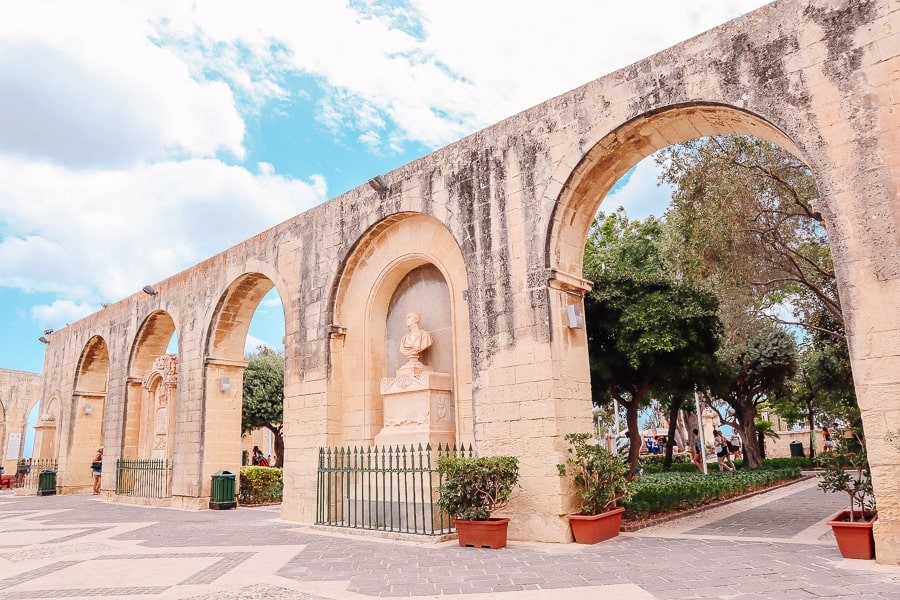
Getting Around Malta by Bus
Even though Malta’s bus system is not perfect, getting around by bus is one of your best options. Here are a few things you should know.
1. Good Things About Buses in Malta
– The buses themselves are clean and air-conditioned.
– You can buy your ticket directly from the driver (unlike many big European cities in which you need to buy it in advance and the bus driver won’t even look at you). This single-journey ticket is valid for 2 hours, including transfers.
– In both Sliema and Valletta, you can buy a 12-ride card at the ticket office or machines next to the bus terminal (see all sales points here ). If you want to save money, this is a great way.
2. Annoying Things About Buses in Malta
– There are too many people and not enough buses. It means that if you’re not one of the first people to go on the bus, you might have to wait for the next one.
– The most popular places to visit in Malta are not all directly connected by public transportation. Depending on your itinerary, there’s a chance you’ll need to switch buses and take a longer route to travel between two places that are fairly close to each other.
– Buses’ timetables can be unexpected, so be sure to consult them on the website of Malta’s public transportation .
Overall, I think everyone should use public transportation when visiting a new destination at least once. It lets you experience the everyday life of the locals and allows you to see things from a different angle.
It can also lead you to places you wouldn’t have seen otherwise, which is exactly why I enjoyed my bus rides in Malta so much. We went into towns and streets I probably wouldn’t have visited, and I got to enjoy some pretty charming views.
There’s also the option of getting around Malta by a hop-on-hop-off bus , but I haven’t tried it myself.
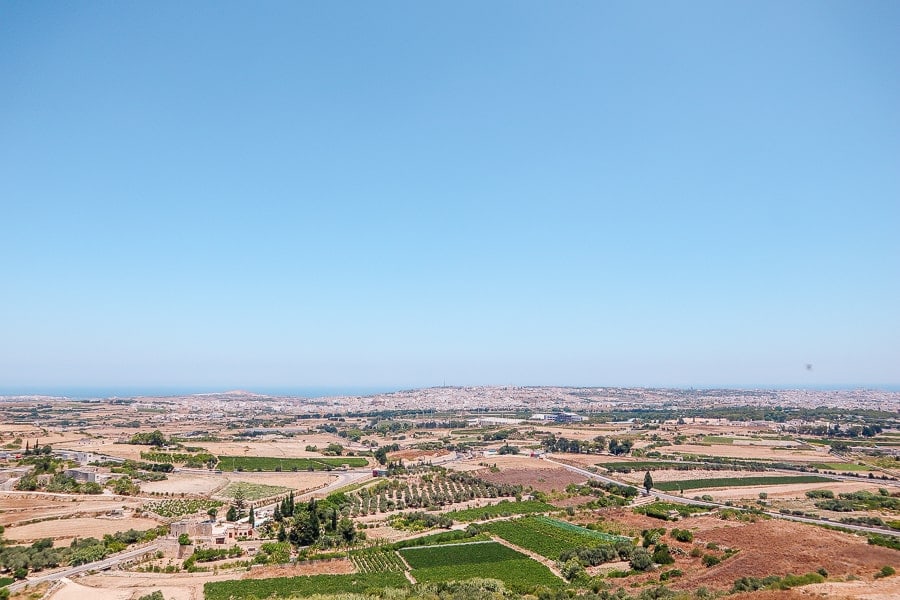
Getting Around Malta by Ferry
From Sliema to Valletta (and vice versa) and from Valletta to the Three Cities, you can (and should) take a ferry instead of a bus since it only takes about 5 minutes to get from one point to another.
The ferries leave once every half an hour, and you can buy a round-trip ticket which is slightly cheaper than two one-way tickets.
Getting Around Malta by Taxi
Sometimes saving time is more important to me than saving money on my travels.
While taxis in Malta are not nearly as cheap as buses, I have used them a few times when I didn’t want to take two or more buses (and travel for 90 minutes instead of 15) to get from one place to another.
If you don’t mind spending a bit more money to save a few hours on the road (and possibly a headache), taxis are a valid option.
Tip #1: You can negotiate the price and lower it by a few euros.
Tip #2: If possible, look for a taxi station instead of catching one on the street.
Tip #2: You can also use Uber or Malta’s eCabs app.

Get Ready for an Interesting Mix of Cultures
I was excited to visit Malta and get to know its culture because it seemed like such a unique European destination.
Throughout the years, Malta was ruled by the Romans, Arabs, Knights Hospitaller , and Brits, to name a few, and it’s located near Sicily and northern Africa, so you can feel the mix of cultures in everything and everywhere.
Maltese sounds like a combination of Italian and Arab, the food will remind you of Italy , the cities look Middle Eastern, the churches look Roman and Greek, they drive on the left side, and red phone booths are scattered around (mostly in Valletta).
Combine all of these cultural bits and pieces, and you’ve got yourself an explosion of uniqueness.
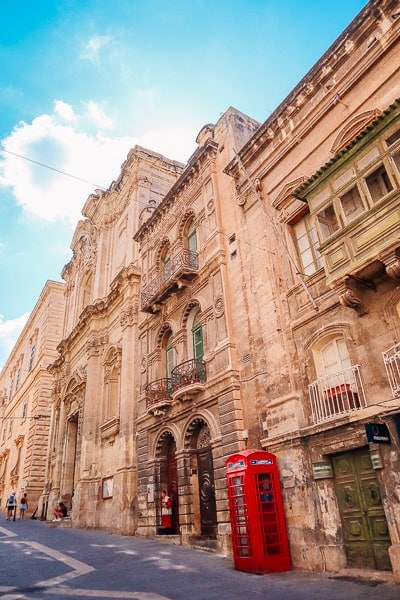
English Is the Second Official Language
Driving on the left side of the road is not the only influence of 150 years of British rule.
You’ll be happy to know that the majority of the locals speak decent English (especially in tourist areas like Valletta) since it is another official language in Malta.
A language barrier can be frustrating to deal with when traveling, so that’s one less thing to worry about in Malta.
The Atmosphere Is (Very) Laid Back
The Maltese lifestyle is relaxed and laid-back, which can be positively contagious if you want to learn how to take things easier (who doesn’t?).
On the other hand, it also means that some things like getting your food at a restaurant can take a little longer than what you’re used to, so be patient.
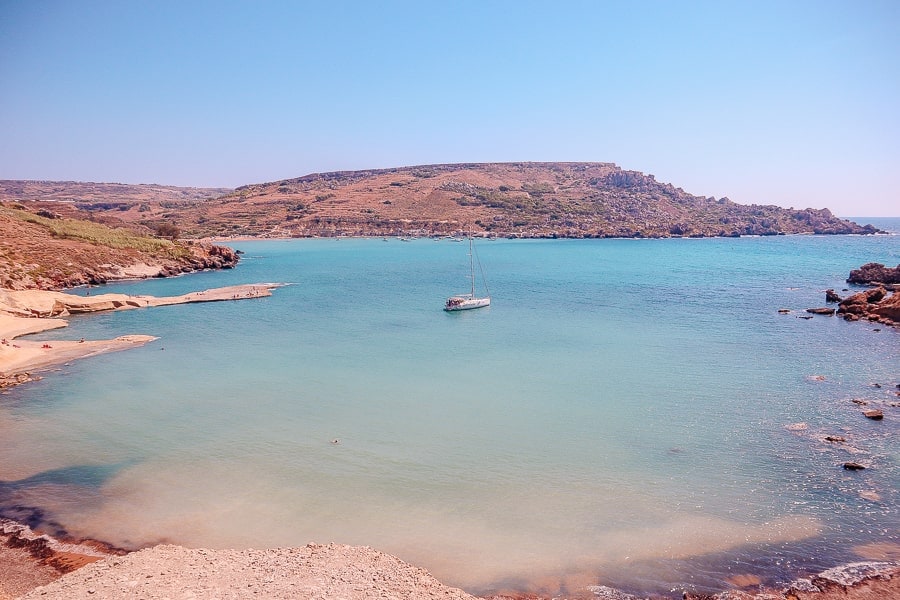
Plug Type Used in Malta
Malta uses plugs of type G (yet another British influence) and operates on a 230V supply voltage and 50Hz.
You can consult your country’s plug type and voltage here to see if you need to pack a power adapter and a voltage converter .
My hotel also provided power sockets that worked with plugs C, E, and F, but it’s best to have an adapter with you.
You Never Know Where You’ll Find a Place to Get in the Water
Some beaches in Malta are sandy, many are rocky, and others are not even beaches. In fact, one of my favorite things about Malta is that you might find a pool ladder to help you get into the beautiful water where you least expect it.
Whether it’s in Sliema’s Roman baths, near the famous Blue Grotto, or swimming areas like the natural St. Peter’s Pool , you should always have your bathing suit with you, and you should always be prepared to take a dip.
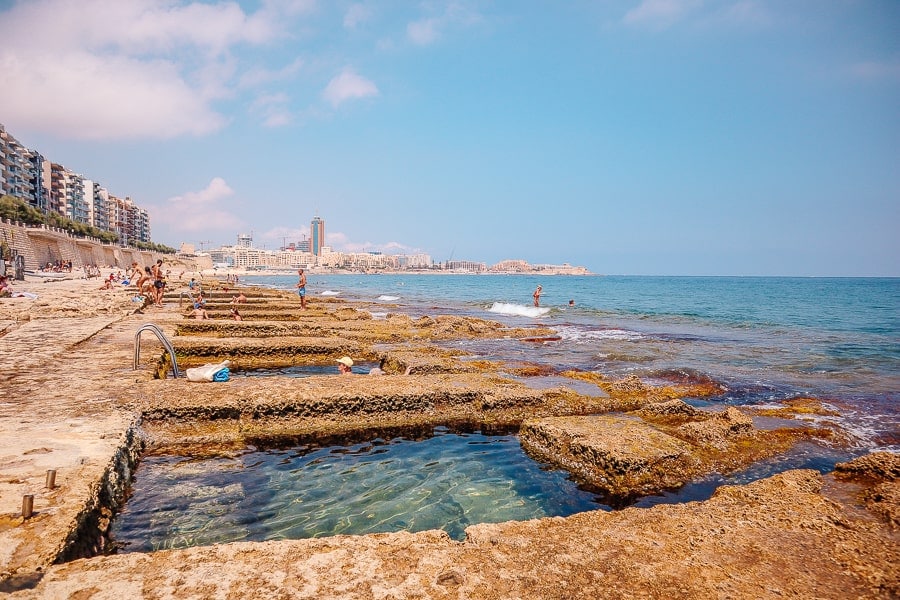
It’s Not Just About Beaches
I have much respect for Malta’s beaches because they are seriously gorgeous, but there’s SO much more to this island.
From fishing villages and UNESCO cities like Valletta and Mdina to archeological sites and cave boat tours to quirky attractions like the Popeye Village, Malta is a lot more diverse than people think.
Malta Is Small, but There’s a Lot to See
As I’ve just mentioned, there’s quite a lot to do and see in Malta, so even though the island is small, don’t let it fool you.
Malta deserves at least 4 to 5 whole days, and a week or 10 days would be even better to see its hidden nooks and crannies.
Taking into consideration the fact that getting around from one spot to another does take some time, you also don’t want to add too many places to your daily itinerary.
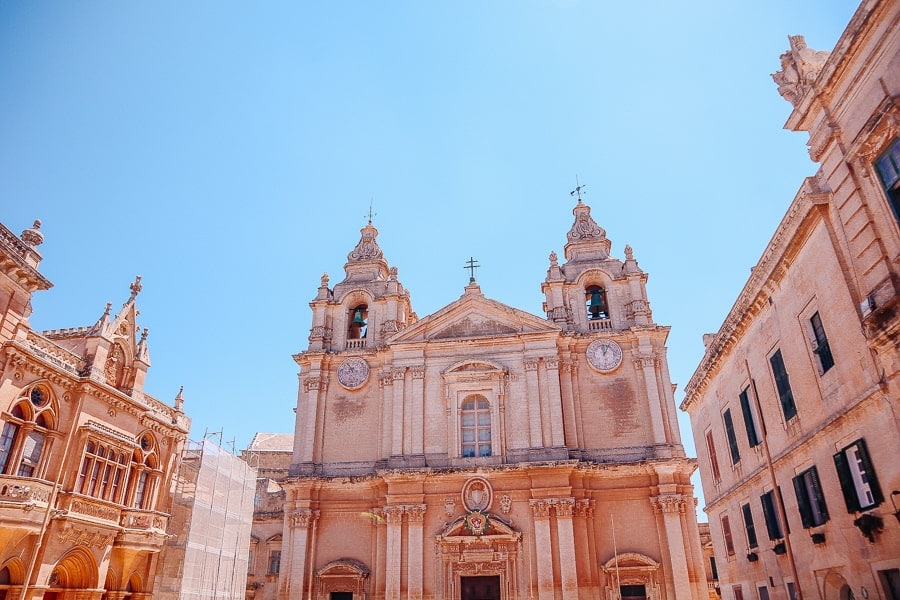
Attend Some Festas
Did you know that there are more than 350 churches in Malta? Each one is dedicated to a different saint, and each saint gets its own celebration!
Instead of having almost a full year of celebrations (which sounds awesome), many of these festivals take place during summer, and they include decorated streets, fireworks, band marches, and more.
For more information and tips for visiting Malta’s festas, read here .
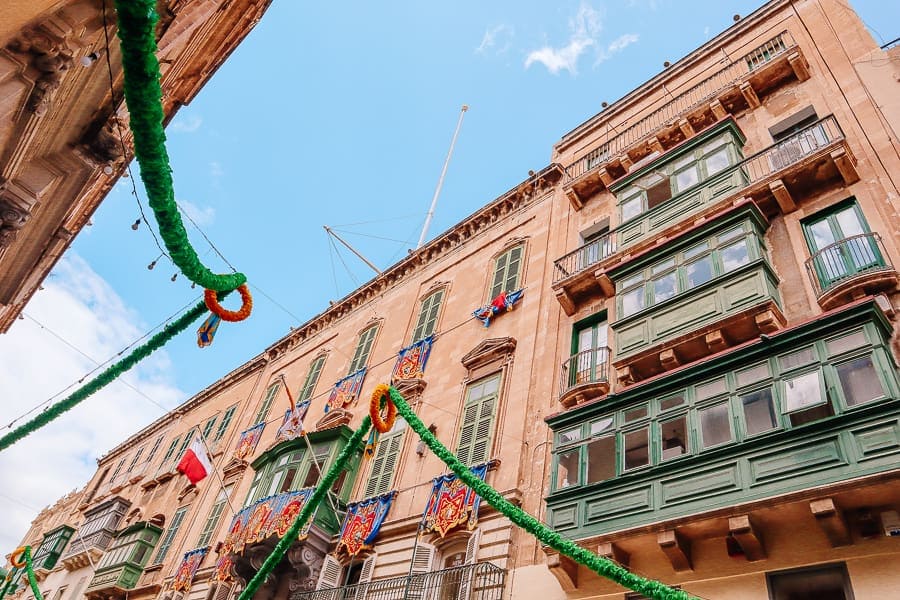
Pastizzi Are the Definition of Happiness
Oh, pastizzi , you wonderful flaky pastries.
If you want to experience true joy, one of my top Malta tips would be to try some pastizzi.
These phyllo-like pastries are usually filled with ricotta cheese or peas, but there are a few other fillings you can try, and some places even serve sweet pastizzi.
When they’re freshly baked and you bite into them while they’re still warm, you get a taste of what I can only describe as heaven.
You’ll see street vendors selling these drops of happiness or find them in special bakeries called pastizzerias or cafes around Malta.
All Three Islands Are a Paradise for Divers and Snorkelers
From diving in Gozo ‘s Blue Hole and Comino’s Crystal Lagoon to snorkeling in Malta’s St. Peter’s Pool, all three islands provide more than enough places to take an adventurous dip.
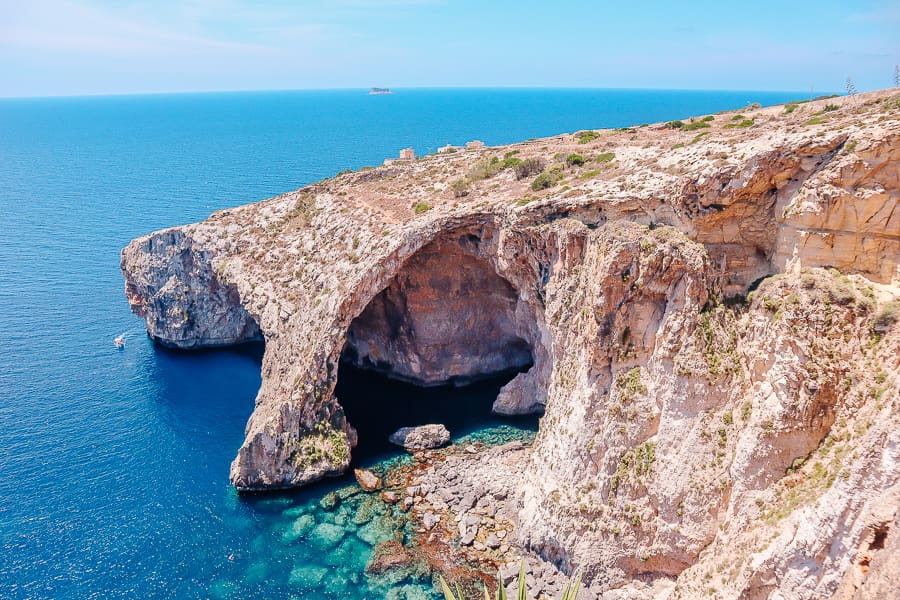
Consider Malta for your next girls’ trip in Europe !
Did you find my Malta travel guide helpful? Pin this post for later using the share icon on the right bottom corner!
About Or Amir
Hey, I'm Or! I'm a passionate traveler with a severe coffee, chocolate, and pastry addiction (or any other carb for that matter). I'm always planning my next trip to Spain, Italy, or any other country in Europe, and my goal is to help you make the most of each destination.
2 thoughts on “18 Must-Know Malta Travel Tips for First-Time Visitors”
I enjoyed reading this guide, thanks for sharing. I visited Malta a couple years back but I wish I spent more time on Gozo rather than just a day trip. I also found the waters around Malta had a lot of jellyfish, it might’ve been to do with the time of the year I was there (July).
Thank you! Slow travel is always better, so I also hope to go back to spend more time in Gozo. I also visited in July and didn’t come across any jellyfish, so I guess it depends on the area you explore.
*Your emil address will not be published. By using this form you agree with the storage and handling of your data by this website
Leave a Comment Cancel reply
Save my name, email, and website in this browser for the next time I comment.
Hi, I'm Or!
I'm a passionate traveler obsessed with traveling in Europe and discovering hidden gems in each place I visit. For me, it's not about ticking destinations off the bucket list but experiencing each one of them to the fullest. Read more about me and my story.

9 Key Things to Know Before Visiting Malta

Disclosure: This post (probably) contains affiliate links. If you click on one, I may make a small commission. Of course, this will come at no extra cost to you and helps keep this site running.
Adrift in the Mediterranean Sea , Malta is a small, one-of-a-kind European nation. Compared to your typical Mediterranean destinations, Malta is more than just a place to sit by the beach and party. It’s home to some remarkable history, beautiful scenery and a proud culture.
After two long trips visiting Malta, I don’t think I’m exaggerating when I say I know a little about the place. There’s no way I’m like a local or anything, but I’ve picked up a thing or two.
Malta is the kind of destination that anyone can visit, whether they’re a first-time traveller or veteran nomad. But it’s always good to be prepared before a trip and have all the information at your fingertips. In that spirit, here are some things to know about visiting Malta that should help with your trip.
Table of Contents
1. More than one island

If you’ve never been to Malta before, or haven’t read my other articles, chances are you don’t know much about Malta’s geography.
It’s possible you didn’t even know that Malta has more than one island, or that Malta is even an island at all! Yes, the country of Malta is an archipelago made up of several islands, the largest of which is also called Malta.
The other main islands of Malta are Gozo and Comino, although only Gozo is inhabited. Whereas Malta is quite thoroughly settled and has some major urban areas, Gozo is far more rural and rustic. Across its hilly landscape, villages are separated by fields and valleys.
Comino, which lies between Malta and Gozo, is more rugged and sparse. However, because it lacks cars and people, Comino is the most serene of the islands. Comino is also home to the Blue Lagoon , a popular swimming spot.
Finally, there are the really small islands like St Paul’s Island that rarely come into play. You’re going to want to include both Gozo and Comino in your Malta itinerary , the other islands not so much.
2. How to get to Malta
Visiting Malta is still incredibly straightforward even though it isn’t the most popular destination in Europe.
Malta is a member of the EU and part of the Schengen Zone, which means that the rules for entering Malta are much the same as other places in Europe. Immigration rules for entry are straightforward for most nationalities and your time in Malta will count toward your number of days within the Schengen Area .
Your options for getting to Malta, an island, are either to come by boat or plane. Most people come by plane, but you can take a ferry across from Sicily, with up to 15 ferry crossings a week .
Flying to Malta is more likely and you’ll fly into Malta’s Luqa Airport , the one international airport in the country. Finding flights from Europe isn’t too tough, with Italy a particularly easy and cheap choice. This is largely thanks to services by the national airline, Air Malta, as well as budget carriers like Ryanair.
3. Getting around Malta

Driving in Malta comes with challenges. Although the islands of Malta are relatively small, their road networks don’t seem to have been built with cars or buses in mind. Keep this in mind if you decide to rent a car for your visit.
This means that traffic in Malta is usually pretty rough and it can take much longer than you’d expect to get places. For instance, getting to and from the airport can take way longer than you’d imagine if the traffic is bad. It’s best to expect an unpredictable journey if you’re driving about or going by bus, especially before your flight home.
Your best option for getting around Malta is certainly by bus. Malta’s extensive bus network reaches nearly every corner of the country and tickets are quite reasonable. I highly recommend picking up a 12 single journey card at the airport on arrival to make matters easier.
Ferries in Malta don’t have to worry about traffic and are far more reliable. There are also island cruises for tourists that take in many of Malta’s sights. The most common ferry routes are between:
- Sliema and Valletta
- Cospicua and Valletta
- Cirkewwa (Malta) and Gozo
- Cirkewwa (Malta) and Comino
4. Working out where to stay
A priority for most people planning to visit Malta is deciding where to stay. While Malta is a small country, it’s not so small that you don’t have options to choose from.
Most visitors, especially first-time visitors, choose to stay in the area around the capital Valletta. This part of Malta includes tourist neighbourhoods such as Sliema and St Julian’s Bay. It’s a good pick to get used to the country and the area has great bus and ferry connections.
But there is much more to Malta to explore, including its other islands. You’ll want to think about whether staying in other parts of Malta, such as around Mellieha or Marsaxlokk , works with your plans. If you have an eye on Gozo, you’ll also need to think if you’ll go on a day trip or stay there.
Remember, there’s no wrong answer, this is just to get you thinking about your options. To learn more about where to stay in Malta, do check out my dedicated post on the different areas.
5. An affordable getaway
One of the great appeals of visiting Malta is how affordable it is as a destination.
Sure, like anywhere you can find ways to spend money on luxurious digs, but in general, Malta offers great value for money. Normally, island destinations like this come with a significant price hike in everything from transport to food and accommodation, but not really on Malta.
Relative to say Italy, food and accommodation are cheaper in Malta and its €2 bus fares are quite reasonable. Perhaps the only thing that’s not too cheap in Malta is the entrance to some of the attractions and museums.
I’d also say that it’s kind of ideal for digital nomads – affordable, decent Wi-Fi and an easy place to sightsee in your downtime. Due to the nature of the tourism market, serviced apartments are very common around Valletta and are a great choice for people looking to cook the odd meal.
My one gripe is that the only cafes around in places like Sliema, Gzira and St Julian’s are busy chains like Starbucks.
6. Understanding Malta’s history and culture

While the tourists you’ll meet in Malta are mostly British and Irish (to a mindboggling degree), Malta itself may be the most quintessentially Mediterranean country in the world.
Look for the middle of the Mediterranean Sea and there you’ll find Malta. This location, together with the country’s complex history, is why Malta has always had a balance of influences from throughout the region.
The Romans, Moors, Normans, Sicilians, Spanish, French and British have all controlled Malta at one time or another. For millennia it has been a crucial trading port for whoever controlled it, and these presences have left their influences across the islands.
How else do you explain a royal red mailbox next to Maltese houses that look like they’re from North Africa ? Inside those homes, you have the people that bear more in common with their neighbours in southern Europe. And then look around and you have fortresses across the island that were built by the Order of St John and likely inspired by the order’s time in the Holy Land.
This melting point of influences is a defining characteristic of Malta and one not to be ignored but cherished.
7. Basic phrases for Malta
Before visiting Malta, I had this naive expectation that everything would be very similar to Italy. There are indeed some similarities in things like language, but only to a certain extent. Just as Malta is a melting pot of influences, so too is Maltese a jumble of languages.
I think that Maltese is one of the rare cases where it is easier to understand it being spoken than it is written down. When you hear Maltese, the words can sound familiar.
That’s not the case when you try to read it. Maltese is heavy on unusual consonant combinations and letters like ‘Z’, ‘J’ and ‘X’. Attempting to read and sound out Maltese words can be a real challenge.
The country’s bus stops are the perfect example.
While tourists typically learn the English names of neighbourhoods and areas, the Maltese bus service only uses the Maltese place names. When the two are nowhere near alike, you’re in for a hard time. It may not be too hard to figure out San Giljan is also Saint Julian’s , but best of luck figuring out L’Isla is also Senglea .
8. What to eat in Malta

If you said you had no idea what Maltese food looks like I wouldn’t blame you. Again, this is something that’s been shaped by centuries of different influences.
In my experience, it’s also a bit harder to find genuine Maltese food than you might think. International cuisine is everywhere in Malta, especially in the areas where tourists stay. I mean, my favourite restaurant in Gzira was a Hungarian place, Rumour Bar & Kitchen . But there are loads of Italian restaurants, seafood restaurants, steakhouses etc.
But it’s not impossible to find Maltese restaurants in Malta. Ta’ Kris is a popular one in Sliema. I can happily recommend their bragioli , which is slow-cooked stuffed beef and quite delicious.
Another dish you can try when visiting Malta is ftira , a flatbread topped with potato, fresh tomato, onion, capers, olives and seafood like sardines. This popped up more when I was on Gozo and away from the Valletta area.
One of the easiest local foods though is pastizzi . These flaky savoury pastries, usually filled with either ricotta or curried peas, are found everywhere and are a good snack.
9. Escape the cold in winter
No surprises, but Europe gets cold in winter. Wanting to escape that cold makes perfect sense. And thanks to its Mediterranean climate and southern location, Malta is a smart choice for a winter sun getaway .
Now, there’s no guarantee that the weather will be perfect. You’re bound to have the odd rain shower and some wind, so I wouldn’t exactly call it beach weather. But compared to the frozen state of mainland Europe, Malta in winter will feel positively tropical.
The weather’s perfect for sightseeing or for going on hikes on Gozo . Average highs from January to March are 17°C which beats the 0°C highs which are all too common elsewhere. And when the sun is out, you’ll feel that seasonal affective disorder just fade away.
Resources for Visiting Malta

- Getting There: To find the cheapest and most convenient flights to Malta make sure to check Kayak .
- Accommodation: Here you can find hotels, apartments and guesthouses for both Malta and Gozo , plus don’t forget Airbnb.
- Tours: There are countless day trips, cruises, and sightseeing tours available on Malta.
- Car Hire: If you want to travel more independently, consider renting a car to drive yourself about.
- Guide Books: Lastly, if you’re after a physical guide to take with you then you can’t beat a Lonely Planet Guide.
What questions do you have about visiting Malta? Have you been before and think there are other things people should know before going? Please share your thoughts in the comments below.
David is the author behind the Travelsewhere travel blog and is always on the search for the quieter, less-visited corners of the world.
You may also like
11 things to do in the three cities, malta, explore the island with these 4 wonderful hikes on gozo, where to stay in malta for your visit, interesting tales, legends and folklore of malta, a guide of what to see in northern malta, best places to visit in malta beyond valletta.
Great post. Really liked about the Maltese language. Beside many Brits, there are many Italians. 🙂 Thanks for the article.
I wonder how it has changed by 2023.
Leave a Reply Cancel reply
This site uses Akismet to reduce spam. Learn how your comment data is processed .
Best Time to Visit
Weather & Climate
Malta International Airport Guide
Best Hotels
Top Things to Do in Malta
Top Things to Do in Valletta
Best Museums
Adventurous Things to Do in Malta
48-Hour Itinerary
Must-Try Food
Best Restaurants
Your Trip to Malta: The Complete Guide
:max_bytes(150000):strip_icc():format(webp)/ElizabethHeath-Headshot-horiz-e7525e97616245958bf3d94e8db7f119.png)
Malta, or the Republica of Malta, is an island nation in the central Mediterranean, located between Sicily and North Africa. It includes the main island of Malta (home to the capital city, Valletta), the smaller island of Gozo, and the tiny, barely populated island of Comino. Over the millennia, Malta's strategic position has made it a prized possession of civilizations, kingdoms, and regional powers seeking to control trade in the Mediterranean. As a result, Malta has a fascinating history, with influences of Roman, Arab, Norman, Spanish and British cultures, among others—seen especially in its historic cities.
Malta is also known for the waters that surround it—the Mediterranean Sea around Malta and its associated islands is clear, deep, and very popular with divers and snorkelers. For Europeans, Malta is a quick island getaway for warm weather, beaches, and history.
Planning Your Trip
Here are some basics for planning your trip to Malta.
Best Time to Visit: Summers in Malta are hot, dry, and crowded, as July to September is peak season. To avoid the crowds but still be relatively sure of warm but not hot weather, the best time to visit is in the late spring to early summer, from April to June. By May, the sea is warm enough for swimming.
Language: The official languages of Malta are Maltese and English. The former is a Semitic language with its roots in the Arab-Sicilian domination of Malta in the Middle Ages. Italian is also widely spoken on the island. Why most Maltese speak the Maltese language among themselves, you'll find that most also speak English, especially in hotels, shops, and restaurants.
Currency: Malta is part of the European Union and uses the Euro as its currency . No other currencies are accepted.
Getting Around: Malta has an efficient public bus system that connects to the airport, cruise port, and most cities, towns, and tourist sites, including on Gozo. If you decide to rent a car, keep in mind that Malta adheres to British driving rules, meaning cars have their steering wheels on the car's righthand side, and driving is on the lefthand side of the road. Taxis are numerous and easy to find. Motor scooter and bicycle rentals are popular ways to get around, and a water taxi service carries passengers across Valletta's Grand Harbour.
Travel Tip: Malta is small but densely populated and congested. In high season and at morning and evening rush hour, expect to spend some time sitting in traffic.
TripSavvy / Linda Strauta
Things to Do
Visitors to Malta mostly come for three reasons: history, the sea, and a fun, resort-like feel. You might pass a vacation here by visiting historical and archaeological sites one day, and beaches and swimming spots another. If you have the chance to get out on the water in a boat, whether it's a ferry, kayak, or chartered sailboat, don't miss it. In the evenings, the lively alleys of the capital city of Valletta are lined with open-air restaurants and bars.
Here are a few sights and activities not to be missed:
- Visit historic cities and sites. Valletta, the fortified capital city of Malta, dominates the Grand Harbour. The 16th-century city was built by the Knights of Malta in high Baroque style and has a well-preserved historic center. The fortress city of Mdina was built by the Arabs in the 11th century and served as Malta's capital until the 1500s. The Megalithic Temples of Malta, including Ħaġar Qim and four others, are the oldest free-standing stone structures globally and a combined UNESCO World Heritage Site. For some perspective: they predate the pyramids of Egypt, Stonehenge, and Ireland's New Grange.
- Get in the water. The islands of Malta, Gozo, and Comino are ringed by dramatic rocky coves with stunningly clear water and a few sandy beaches. Top sandy beaches include Golden Bay Beach and red-hued Ramla Bay on Gozo. For swimming and snorkeling, On tiny Comino, the aptly named Blue Lagoon is famous for its otherworldly turquoise waters. On Malta, St. Peter's Pool has huge rock slabs for sunning in-between jumping into blue-green waters. From the beautiful swimming cove at Għar Lapsi, you can catch a boat to the Blue Grotto, the most famous of the many sea caves carved into the shorelines of Malta and Gozo.
- Party into the night. Malta is a party destination, attracting young and old revelers to dine out, drink and socialize at top spots all over the island. In Valletta's Old Town, narrow, steep alleyways are lined with bars and restaurants that buzz with activity from early evening. In the combined area of Sliema, St. Julian's, and St. George's Bay, modern luxury hotels, beach resorts, and shopping, dining, and entertainment complexes draw revelers from across Europe and beyond.
For more on things to do in Malta, check our articles on the Most Adventurous Things to Do in Malta and the Top Things to Do in Malta .
What to Eat and Drink
As with Maltese history and culture, Malta's cuisine has been greatly influenced by the many cultures that ruled the islands over thousands of years. Most prevalent is the Italian influence—there are Italian restaurants and pizzerias all over Malta and Gozo. But the cuisine also has elements of French, Greek, Arabic, Spanish and British cooking. Rabbit is among the most popular dishes in the country, prepared any number of ways but most often in a stew, called stuffat tal-fenek . Pastizzi are savory pastries filled with peas or a ricotta mixture. Another only-in-Malta dish is ftira , a flatbread that is either stuffed with savory ingredients or served like a pizza, with cheese, vegetables and often, sausage or other meat. Lampuki pie is a local fish pie baked with potatoes, mint, and capers.
Both red and white wines are developed in Malta. White wines are crisp and dry, and include Chardonnay, Vermentino, Viognier and Sauvignon Blanc. Syrah and Merlot are two of the most commonly found reds on the island. Cisk is the local craft beer, and you'll find bartenders mixing up a range of international cocktails, including the ubiquitous Aperol Spritz.
Where to Stay
Where you base your stay in Malta depends largely on your interests. Keep in mind that the island is small and can be easily traversed by rental car or bus. Valletta, the capital city, has several important sights, is close to the airport, has a range of accommodation options, and is a good hub for exploring the rest of the country. Sliema, St. Julian's, and St. George's Bay have the largest concentration of luxury hotels, though there are less expensive options here as well. Families and couples come here for the beaches, and the younger crowd hits nearby Paceville for the nightlife. Quiet Mellieħa is favored by those who want to spend the majority of their time at the beach. Gozo is also much quieter and lower-key than the busiest parts of Malta and draws an older crowd looking for total relaxation and lots of time in the sun and sea.
Getting There
Small, easily navigable Malta International Airport (MLA) is the country's only airport. While there are no direct flights between Malta and the U.S., the airport is well-connected to Europe, the Middle East, and Russia. Air Malta, Alitalia, RyanAir, EasyJet, and Wizz Air are among the carriers with the most frequent flights in and out. The airport is about 10 kilometers from downtown Valletta and is connected to Valletta and the rest of the island by bus or taxi.
Gozo is only reachable by ferry or private boat, or charter. Ferries depart about every 30 minutes from the port at Ċirkewwa, on the northern tip of Malta, for the 25-minute ride to Gozo. Vehicle, foot, and bike passengers are welcomed on board.
Culture and Customs
Malta ranks only behind Romania as the most religious country in Europe. And despite its reputation as a European party destination, its population is devout, with a wide majority identifying as Roman Catholic and attending mass regularly. When entering any church, be sure that your shoulders and chest are covered and that your legs are covered from the knees up—this goes for all genders.
In restaurants, tip about 5-10 percent of the bill. If a service charge has been added, you don't need to tip, though a euro or two extra for good service is always appreciated.
Money-Saving Tips
In terms of vacation costs, Malta falls right about in the middle of the rest of Europe—cheaper than destinations like Paris and Venice, but more expensive than Eastern Europe, for example. Here are a few ways to save money on your vacation to Malta:
- Buy the Malta Pass. If you plan to do a lot of sightseeing in one day or a few days, the Malta Pass is a good investment. It includes admission to more than 35 top attractions, plus a sightseeing bus to get around on.
- For meals, go casual. The Maltese snacks of ftira and pastizzi are cheap, handheld meals in themselves. They're sold, along with tasty sandwiches and pizza, just about everywhere, especially near beaches and other destinations where tourists gather.
European Union, The euro as the official currency, 2020
UNESCO, Megalithic Temples of Malta
The Top 15 Things to Do in Malta
The Best Time to Visit Malta
The Top 13 Things to Do on Gozo
18 Most Beautiful Islands in the World
48 Hours in Malta: The Ultimate Itinerary
The 15 Top Things to Do in Valletta, Malta
The Top 10 Foods to Try in Malta
The 10 Best Restaurants in Malta
St. Bart’s Guide: Planning Your Trip
Planning a Honeymoon in Greece: The Complete Guide
Your Trip to the Bahamas: The Complete Guide
Trips to Sicily: The Complete Guide
Your Trip to St. Lucia: The Complete Guide
The Most Adventurous Things to Do in Malta
The World's Most Gay-Friendly Beach Cities and Resorts
- South Africa
- Afghanistan
- North Korea
- Adventure + Outdoors
- Amusement Parks
- Backpacking Trips
- Boating + Cruises
- Budget Travel
- Bus + Train Travel
- Coasts + Islands
- Country Trips
- Fall Vacations
- Family Vacations
- Green Travel
- Heritage + History
- Honeymoons + Romance
- Inspiration + Guide
- Landmarks + Attractions
- LGBT Travel
- Markets + Bazaars
- National Parks + Reserves
- Nature + Wildlife
- Parks + Gardens
- Pets + Animals
- Photography
- Airlines + Airports
- Budgeting + Currency
- Business Travel
- Celebrity Travel
- Customs + Immigration
- Deals + Rewards
- Family Travel
- Hotels + Resorts
- Luggage + Packing Tips
- Offbeat News
- Photography Tips
- Responsible Travel
- Solo Travel
- Tech + Gear
- Travel Etiquette
- Travel Warnings
- Bars + Clubs
- Celebrity Chefs
- Restaurants + Cafés
- Wine + Vineyards
- Beach Hotels
- Boutique Hotels
- Hotel Openings
- Hotel Reviews
- Luxury Hotels
- Mountain + Ski Resorts
- Spa Resorts
- Vacation Rentals
- Asia Cruises
- European Cruises
- Festivals + Events
- Museums + Galleries
- Style + Design
- Travel’s Best
- Hotel with Agoda.com
- Hotel with Booking.com

What to do & how to spend 4 days in Kuala…
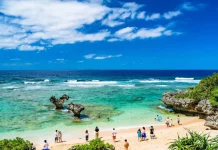
Okinawa itinerary 3 days. What to do in Okinawa for 3…
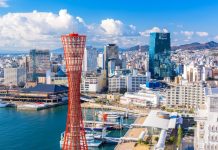
16+ best places to visit & top things to do in…

Where to shop in Tokyo? 15+ top shopping malls & best…

The complete Seoul subway guide: How to use, lines, fares for…

How much does it cost to travel to Korea? Tips on…

The ultimate guide to NETS FlashPay Card: What is it, how…

How much will it cost to go to Singapore? Tips on…

Must-eat in Bali. 25+ best street food in Bali

What to eat in Xinjiang? Enjoy 9 best Xinjiang street food

What and where to eat in Taipei? 20+ top restaurants &…

What, where to eat in Nha Trang? — 11+ best places…

11+ best homestays in Kuala Lumpur near famous tourist attractions

Mövenpick Resort Kuredhivaru Maldives reviews. The detailed review of my vacation…

Hyatt Regency Danang Resort and Spa reviews. The resort is highly…

+7 luxury resorts you must stay in Danang, Vietnam

10 must-know things for your best first time European river cruise

Top 3 best luxury cruises in Halong Bay, Vietnam

Cherry blossom festival Korea 2024 — Top 5 cherry blossom festivals…

Ghibli museum blog — The fullest Ghibli museum guide for first-timers

Kyoto festival — Top 10 best events & most famous festivals…

National Palace Museum Taipei blog — What to see in National…

Japanese waterfall — Top 10 most beautiful waterfalls in Japan in…

19+ most beautiful towns in Europe every tourist need to visit…

Georgia travel photos — 20+ captivating photos show Georgia is heaven…

Explore Damnoen Floating Market — The oldest floating market of Thailand

Visiting Fenghuang Ancient Town — One of the most charming ancient…

Mekong Delta travel blog — Beyond rivers of Southwestern Vietnam

14 reasons why you should travel when you are young

Shigaraki Tanuki – An animal symbol of good luck in Japan

Living in the charms of cave houses in Andalucia, Southern Spain

20+ jaw-dropping tiny homes around the world
Malta travel blog — the fullest malta travel guide for first-timers.
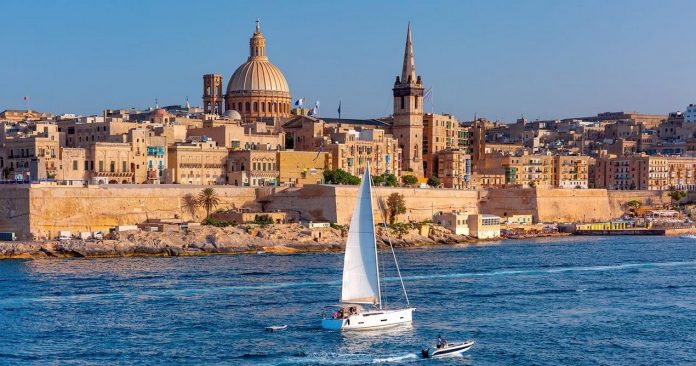
Malta is a small island nation in the middle of Mediterranean Sea and to the southern island of Sicily, Italy. The charming landscape, secluded beaches, warm climate, vibrant life, long-standing history, cultural diversity and especially it possesses massive fortresses, ancient temples that have made this place to be one of the most attractive destinations in Europe. This country once played a big role in shaping human history. There are temples dating back 5000 years old and are considered the oldest remaining independent structures on earth. So, what to do and how to plan a perfect budget trip to Malta for the first-time? Let’s check out our Malta travel blog (Malta blog) with the fullest Malta travel guide (Malta guide, Malta tourist guide) from how to get there, best time to come, where to stay, best places to visit and top things to do to find out the answer!
- 20+ beautiful photos show the beauty of Malta – The island nation filled with sunshine in the Mediterranean
- What to do in Maldives? — 10 best things to do in Maldives & Top things to do in Maldives
- Bajau laut — Explore the life of the last sea nomads
What to do in Langkawi? +14 must & best things to do in Langkawi on a budget
Langkawi travel blog — the fullest langkawi guide for first-timers.
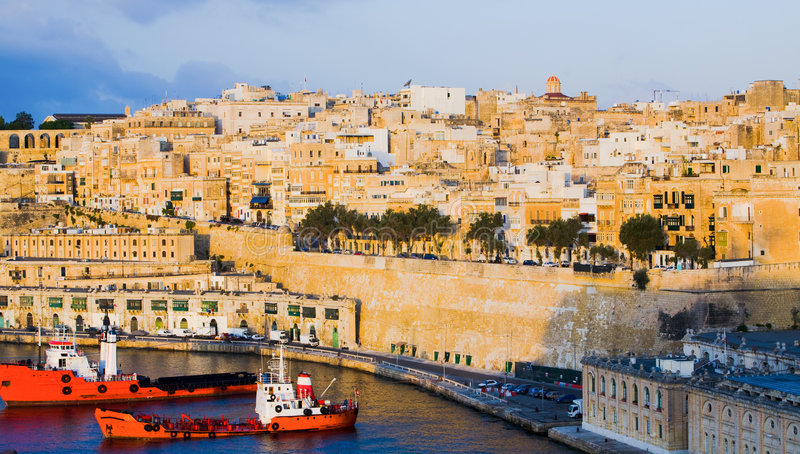
Having been annexed by many empires, Malta offers visitors an interesting mix of cultures. When traveling here, it’s easy to see the blending styles of Italian, British and North African in cuisine, language, culture and architecture. Thanks to its wonderfully warm climate and relatively cheap travel costs and friendly locals, it is a good place for those who love medieval cities and castles and cities decayed but still has its own charm.
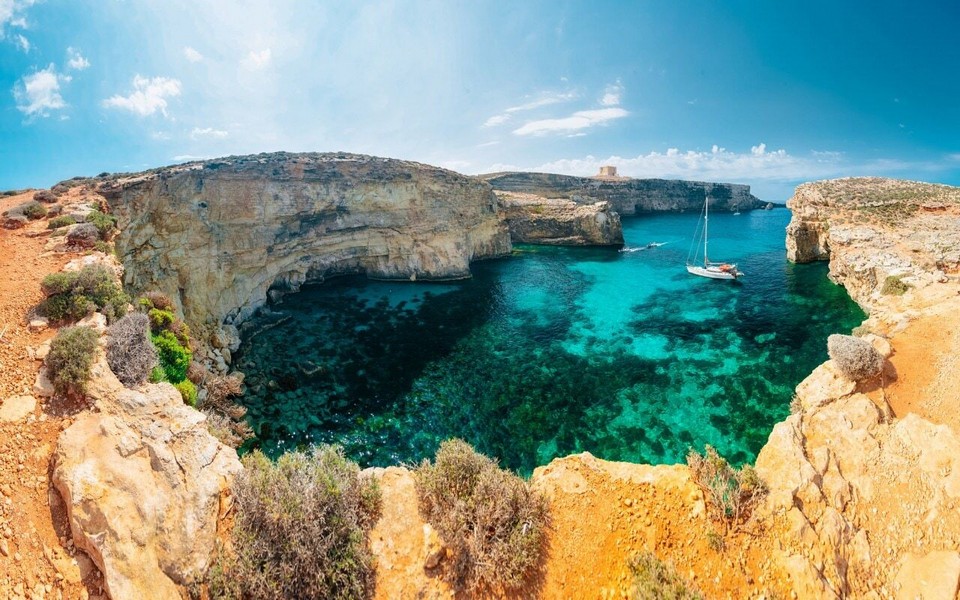
Malta travel guide: Overview of Malta
The Republic of Malta located away 80 km to the south of Italy, 284 km to the east of Tunisia and 333 km to the north of Libya. This country has only an area of 316km2 (square kilometer) with a population of about 450,000 people, Malta is one of the smallest countries and the highest population density across the globe. The capital of Malta, Valletta with an area of only 0.8 square kilometers is the smallest capital in the European Union. Malta consists of 9 large and small islands, but only 3 large islands, Malta, Gozo and Comino are inhabited.
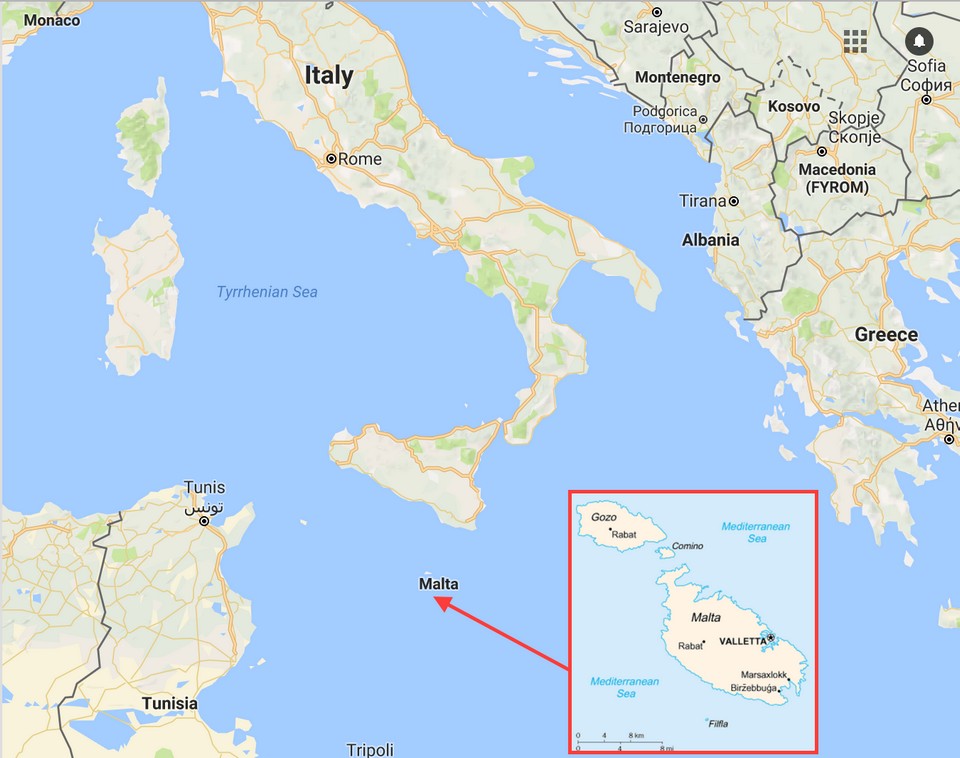
Malta has strategically located in the middle of Europe, North Africa and the Middle East, once occupied by the Phoenicians, the Aragonese, the Knights of Saint John, the French and the British. The country also played an important role in many of history’s most famous wars, such as between Catholic Europe and the Ottoman Empire, the success and failure of Napoleon, as well as World War II. That continuous change of control has given it a unique culture – a blending of architectural styles, culinary and cultures (in fact, Maltese is a blend of Arabic and Italian) that you can’t find anywhere outside of Southern Spain.
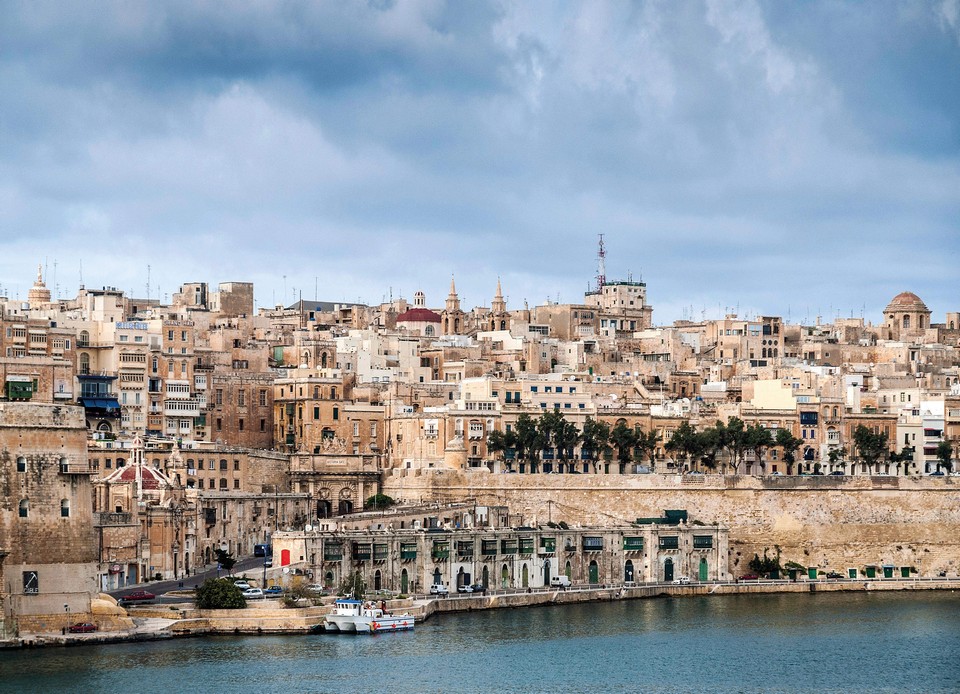
Malta is known as an international tourist and leisure destination, with nine UNESCO World Heritage Sites. The official languages of Malta include Maltese and English. Roman Catholic is the main religion of Malta, in addition to Orthodoxy, Protestantism and Islam.
Malta travel guide: When to come?
Malta has a subtropical Mediterranean climate with mild winters and warm summers. The average temperature from January to April during the day is 12 – 18 degrees Celsius and 7 – 12 degrees Celsius at night. From mid-April to November, the daytime temperature is 28 – 34 degrees Celsius and nighttime is 19 – 24 degrees Celsius.
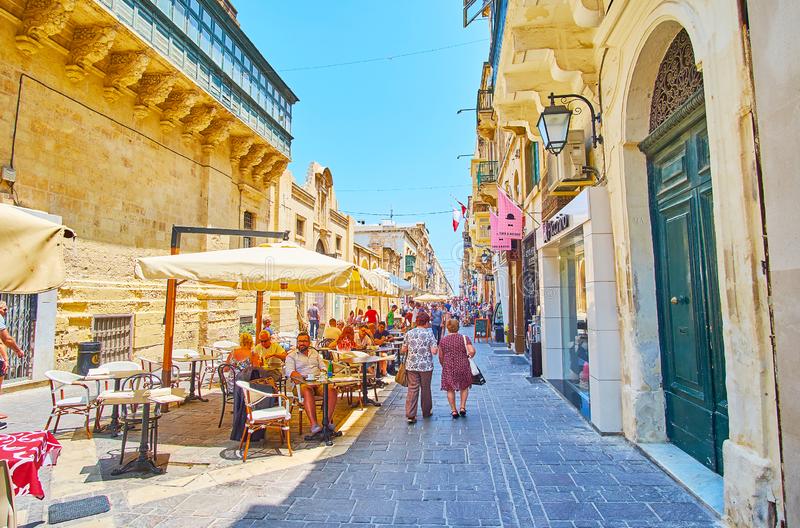
In summer from May to October is the best time to explore this island nation. If you want to explore Malta’s beaches, diving, water activities, then from July to September is an ideal time to come, the temperature is approximately 30 degrees Celsius.
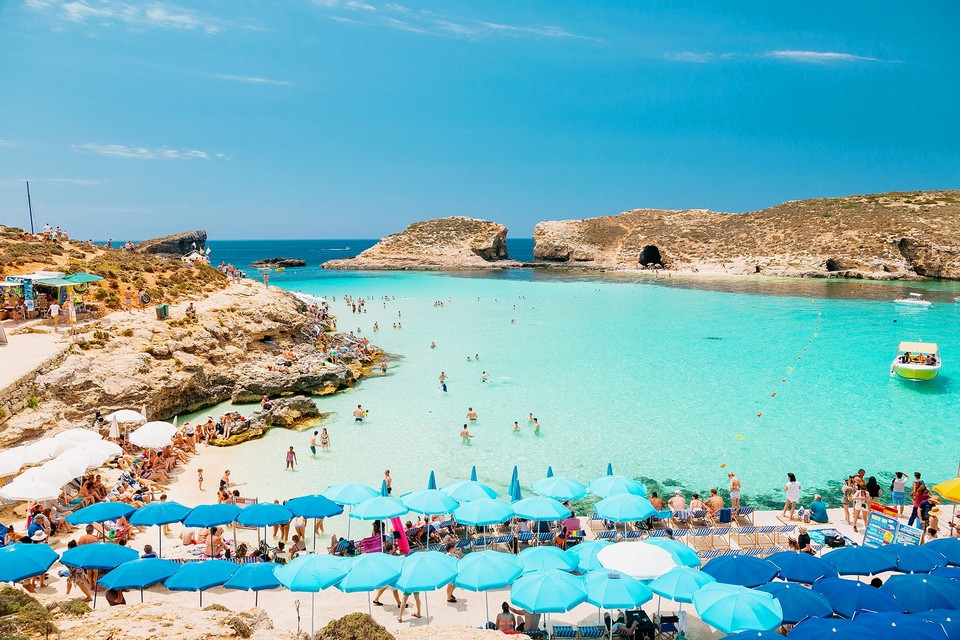
Malta travel guide: How to get to Malta?
While most European countries have seasonal flights, not many airlines operate routes to Malta year-round. But Ryanair, Air Malta, EasyJet and Lufthansa, Emirates are the largest airlines that offer services to Malta year-round. If you flying from London, it will take more than 3 hours by flight to reach Malta. Access Google Flights , Momondo , Skyscanner , Kayak to find your suitable flights.
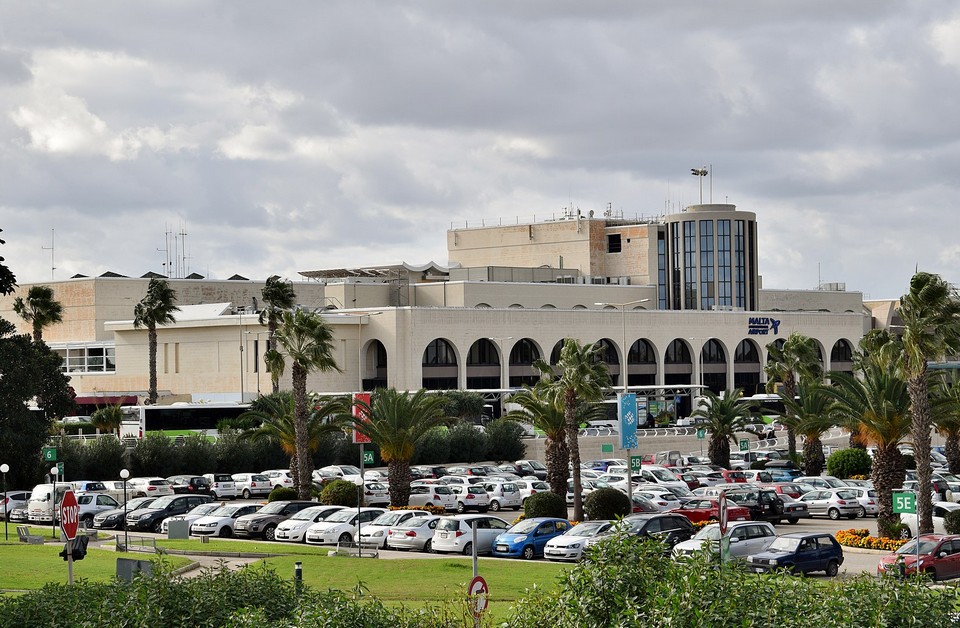
To getting from Malta Airport to city center you can take the bus: BUS X1, BUS X2, BUS X3, BUS X4 or Bus TD2, Bus TD3. In which TD buses stand for Tallinja Direct are direct buses running from airport to your destination and quicker than X buses which running to most localities in Malta and stop at every bus stop.
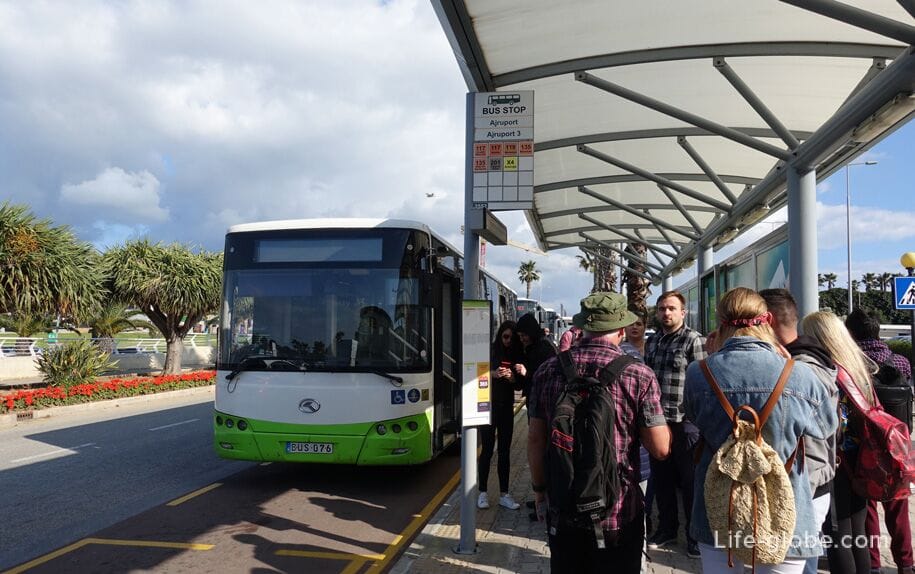
Alternatively you can reach Malta by waterways with ferries from the ports of Catania and Pozzallo in Sicily, Italy, which take about 2 and a half hours and cost about 61 – 127 euros ($63 – 135) / one-way (depending on each season). Ferry details here .
Malta guide: Getting around
There are 3 main ways to getting around Malta: Buses, taxis and self-drive.
Ticket price: The single ticket costs EUR2 in summer, EUR1.5 in winter and EUR3/night bus.
In addition, there are a 12 SINGLE DAY JOURNEYS for EUR15 for adults (Children up to 10 years old 15€) which can be used for groups, families, valid for 1 year from the first-time you validate it and with this ticket you can take 12 bus rides. Or 7-day ticket for EUR21 / adults and EUR15/children called EXPLORE CARD .
We stayed here for a week, so we chose to buy a 7-day ticket for EUR21, the ticket is made with a very good hard card and can be kept as a souvenir ^^.
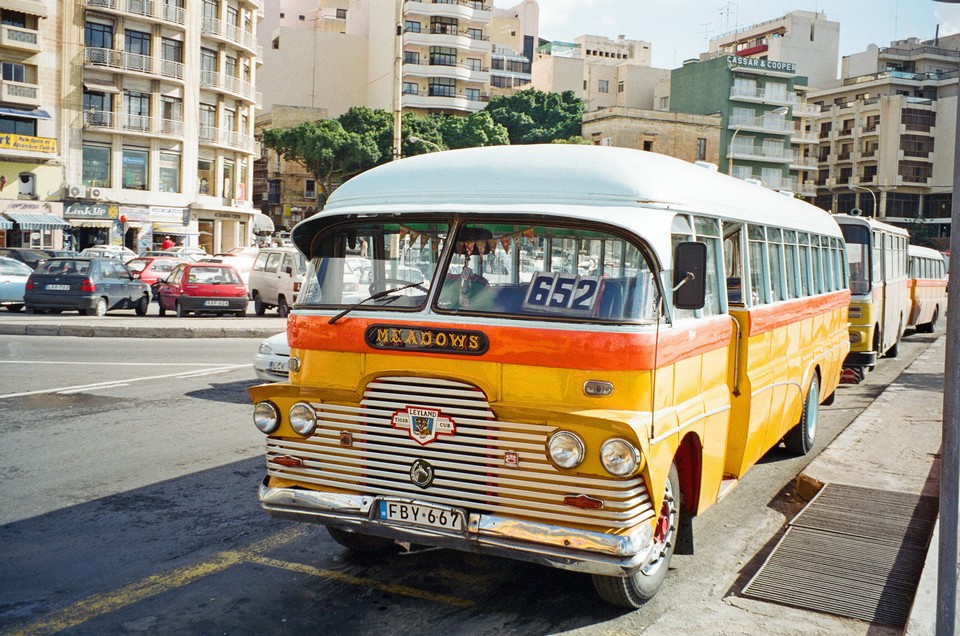
- Malta Hop-On Hop-Off Bus Tour
Where to buy tickets? There are places to buy tickets in each locality, usually in bookstores or souvenir shops, but note that all supermarkets and shops here close before 7pm. So, we planned to go to Valletta at night to strolling around streets and then buy tickets, but when we arrived, almost shops were closed, but luckily we were help by a local, he said there was a ticket vending machine located at the Valletta bus station , which still operating 24/24.
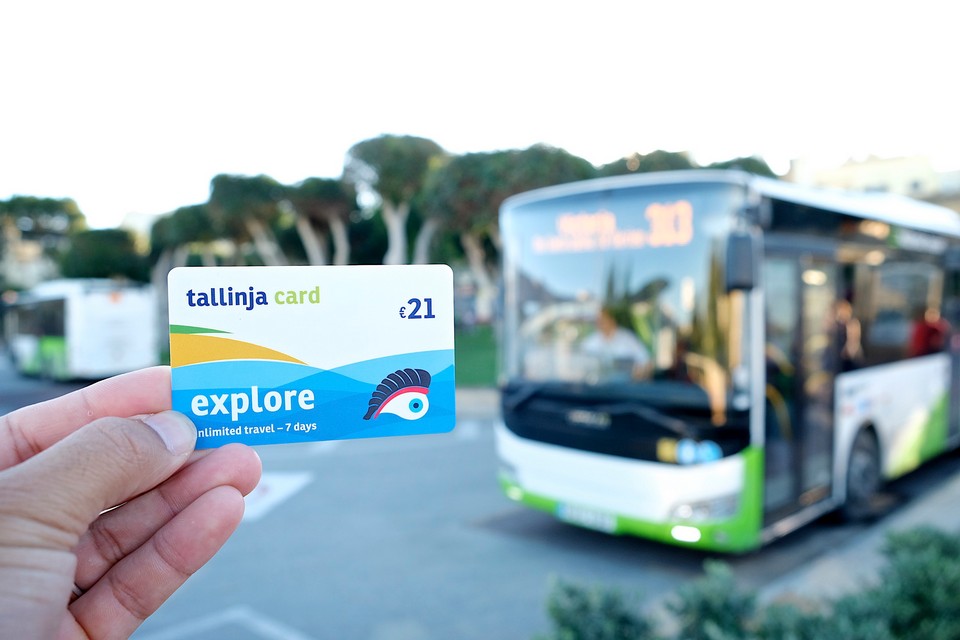
Bus and ferry times: Buses here are not as frequent as other major cities in Europe, you usually have to wait about half an hour to an hour with a trip, so you should remember to note the departure and return times, especially at night with very few trips, 10:30PM is the last trip.
Renting a car costs $41 / day (rental costs around $53 or higher in the summer). There are many local car rental companies, but I rent at Hertz because it’s close to my Airbnb. Many companies only accept cash payments. Rent a car from big companies to ensure your safety.
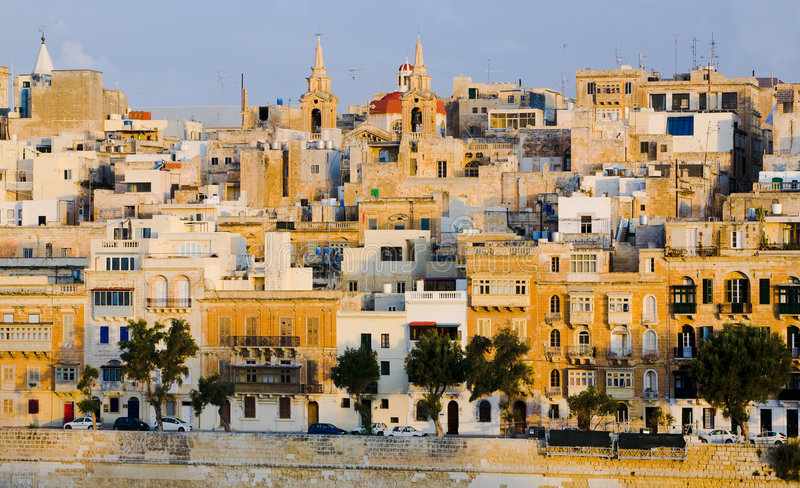
Taxi & Uber
Taxis cost EUR10-20, you can book a taxi via Whatsapp in advance and taxi may a good last minute option if you get stuck and can not take a bus. In addition, you also can use Uber rideshare service.
Ferry ticket to Comino island cost about EUR13 / round-trip, from the Cirkewwa wharf with the earliest trip departs at 9:10am and the last trip at 3:40pm, the return trips from 9:30am to 6:00pm daily.
The ferry to getting to Gozo is super big and beautiful, with no cost for departing trip, when return, you buy a ticket for EUR4.65 / person, the ferry running all day and night, and the best thing when we took the return trip at sunset, sitting on the ferry and watching Gozo island lights up against the pink sky of the sunset is really memorable moments (information about the ferry to Gozo here).
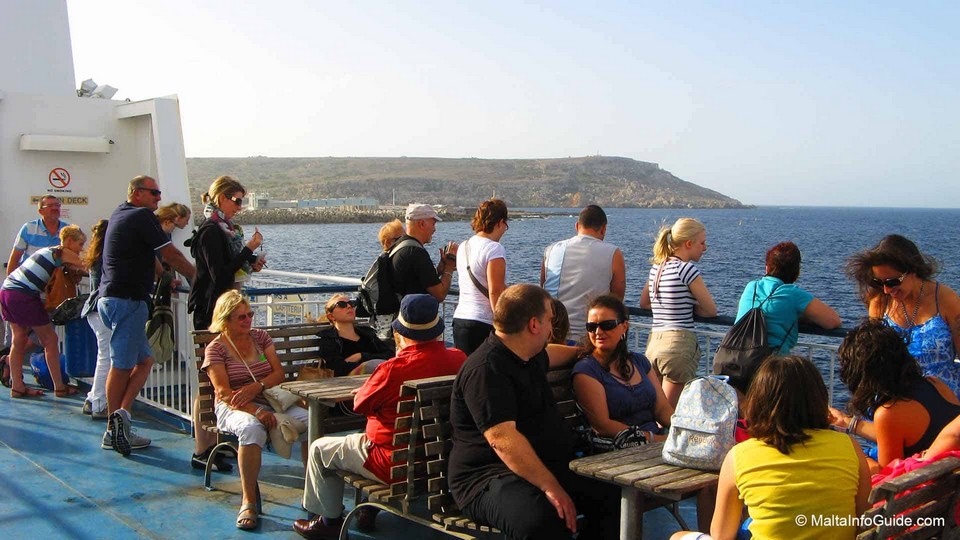
For convenient traveling and saving when exploring Malta you can buy in advance some PASS or CARD such as MALTA PASS which allows you free to visit more than 35 museums, architectural or historic, famous tourist attractions throughout the country, it also covering free sightseeing bus ride. Price: 1-day 49.95€ / 2-day 79.95€ / 3-day 99.95€. Website: www.maltapass.com.mt .
Or VALETTA CARD which allows you free to visit some famous attractions in the capital of Valleta as well as traveling from, to, and within Valletta plus 2 free ferry trips. Price: 24 hours 19€. Website: www.publictransport.com.mt/en/valletta-card
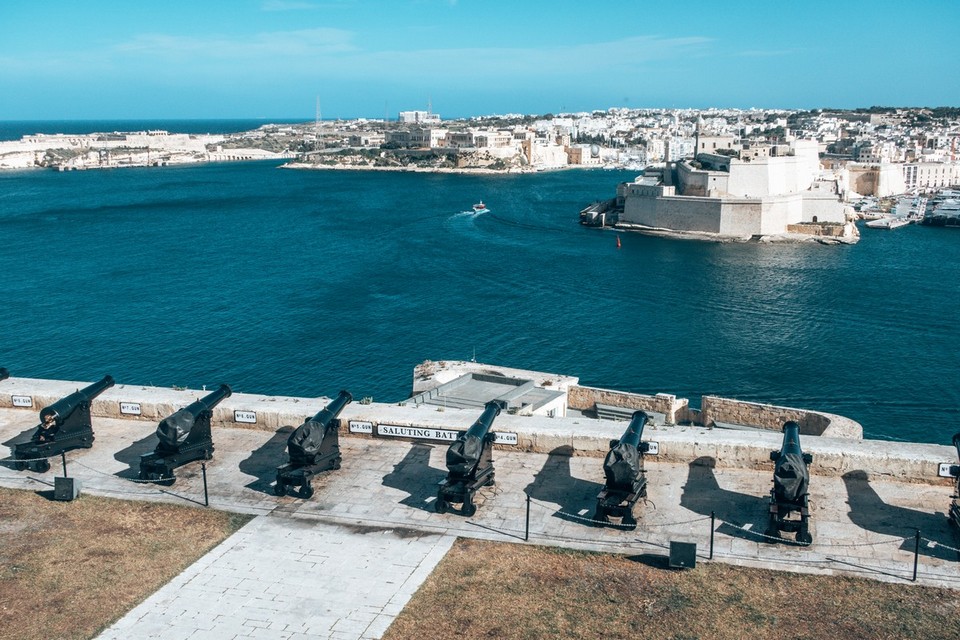
Malta travel guide: What to do and where to go?
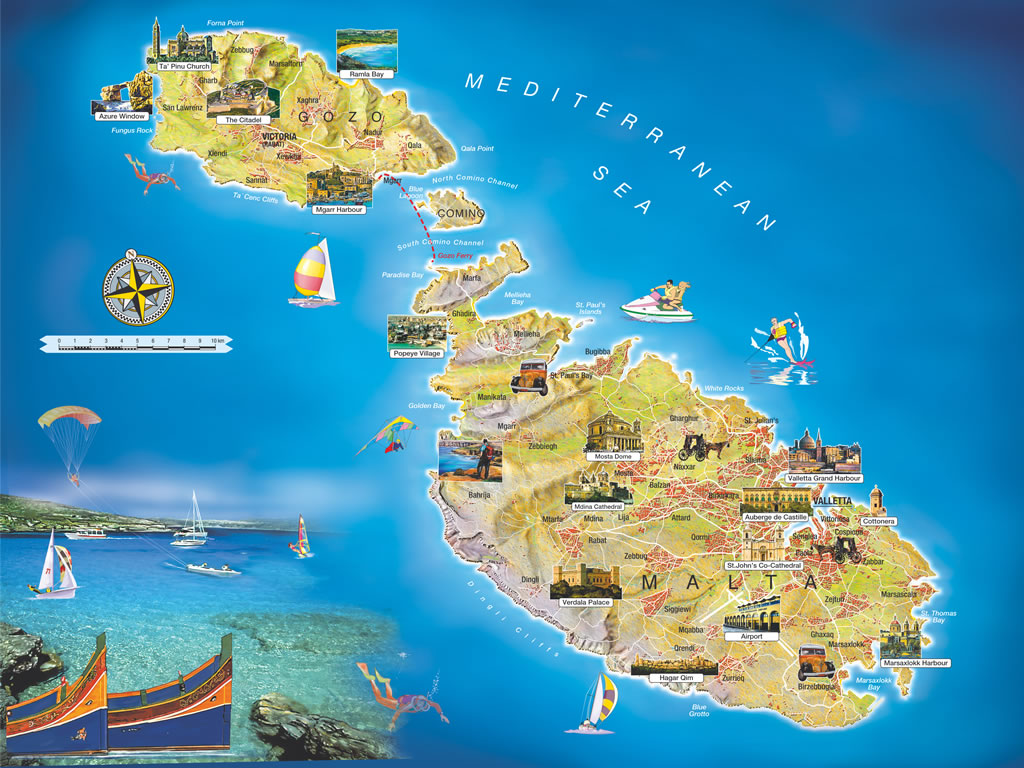
The capital of Valletta
With an enthralling history, amazing architecture and a bustling urban lifestyle, this city proudly received awards such as the European Cultural Capital of 2018 and a UNESCO World Heritage Site since 1980. Traveling to Valletta, visitors feel like stepping on a journey through many majestic, magnificent of ancient architectural buildings and structures such as: St. John’s Co-Cathedral, Grandmaster’s Palace, Grand Harbour, Manoel Theater, Regina Square (Republic Square)… Quaint, secluded Medieval architecture attracting and captivating all your eyes, bringing an atmosphere that makes visitors feel like they are immersed in endless stories. The narrow steep alleys, signature and colorful windows of hillhouses make Valletta more charming and romantic.
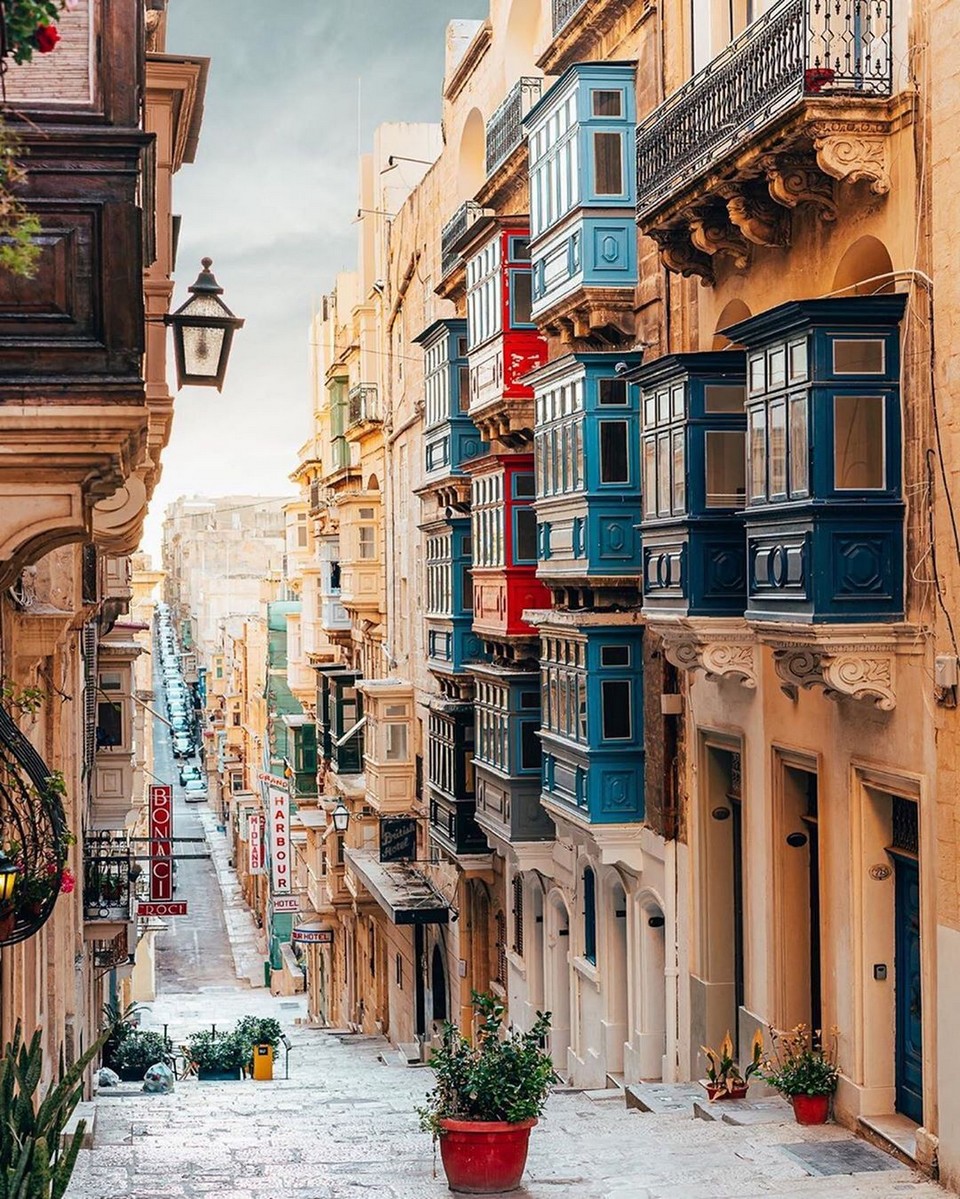
In particular, take time to strolling and enjoying the beauty of Valletta at night with a vibrant nightlife, you also easily see the world’s famous DJs in the splendid capital along with most luxurious brands in the world also garthering here.
Popeye Village (Film Set Village)
Built as a movie setting in 1979, the Popeye sailors’ village is still today a popular tourist attraction in Malta. “Popeye Village”, also known as “Sweethaven Village” is an amusement complex – an open-air museum, and one of the most popular tourist attractions around Anchor Bay on the Mediterranean coast. Popeye Village was originally built as a filming location for Robert Altman’s “Popeye” film, co-produced by Paramount Pictures and Walt Disney Productions.
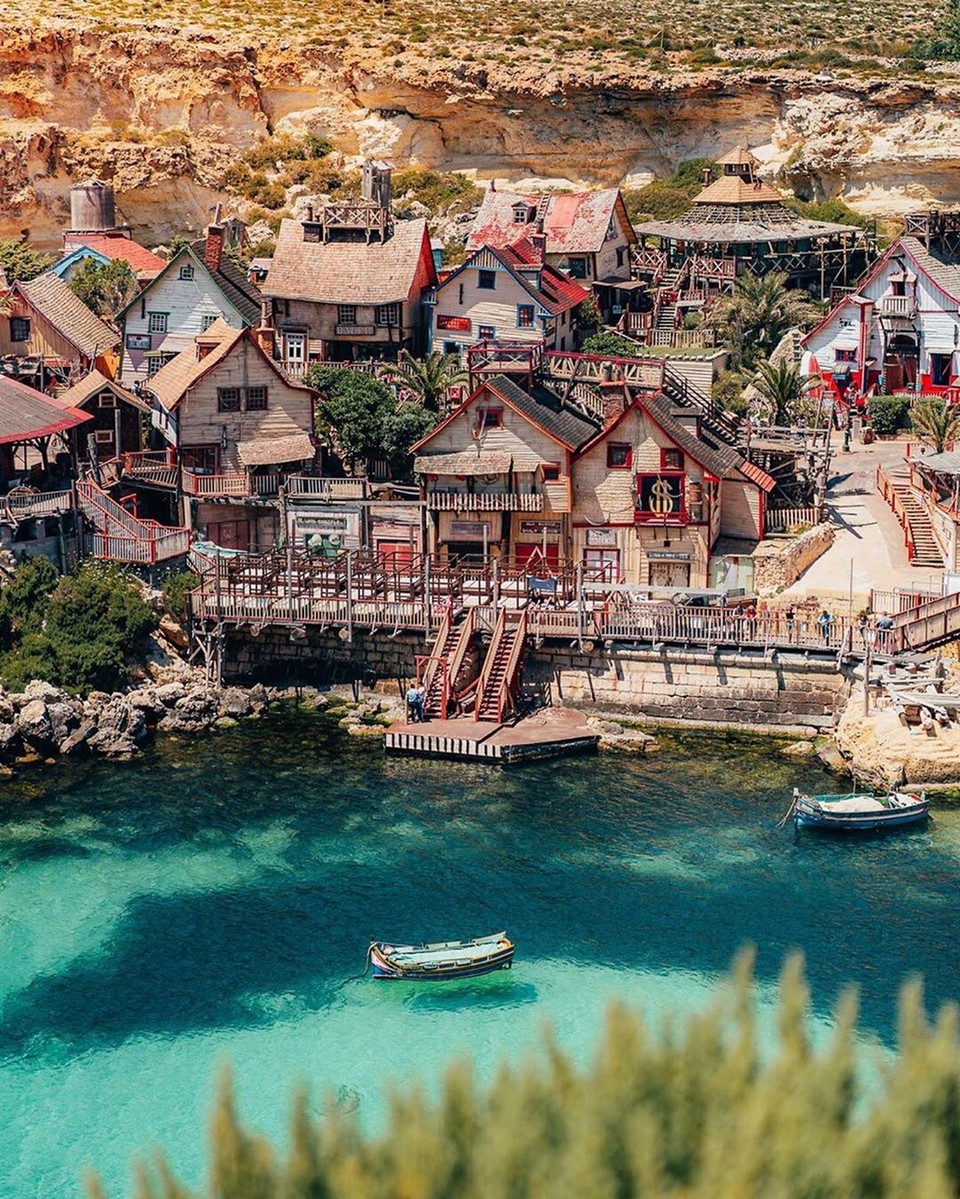
Throughout the years, many activities have been held in the village, but the most special and attracting the attention of visitors is Popeye and Olive’s wedding. There are also exhibitions of Popeye’s sailor comics, as well as more than 200 original comics and cartoons from the 60s, 70s and 80s. In good weather, visitors can take a tour to explore Anchor bay by boat and admiring the beautiful Popeye village from the sea.
Address: Triq Tal-Prajjet, Il-Mellieħa, Malta Hours: 10:30AM–5:30PM/Monday: Closed
The fishing village of Marsaxlokk
About 30 minutes by bus from the capital Valletta to the South Eastern of Malta, the fishing village of Marsaxlokk is considered a convergence of colors. From the Luzzu boats painted pure white to the gentle blue water reflecting the sunlight. All create a poetic picture bearing typical style of the Mediterranean Sea. Here, you can stroll along the coast, visit fishing village and enjoy specialties in harbor restaurants.
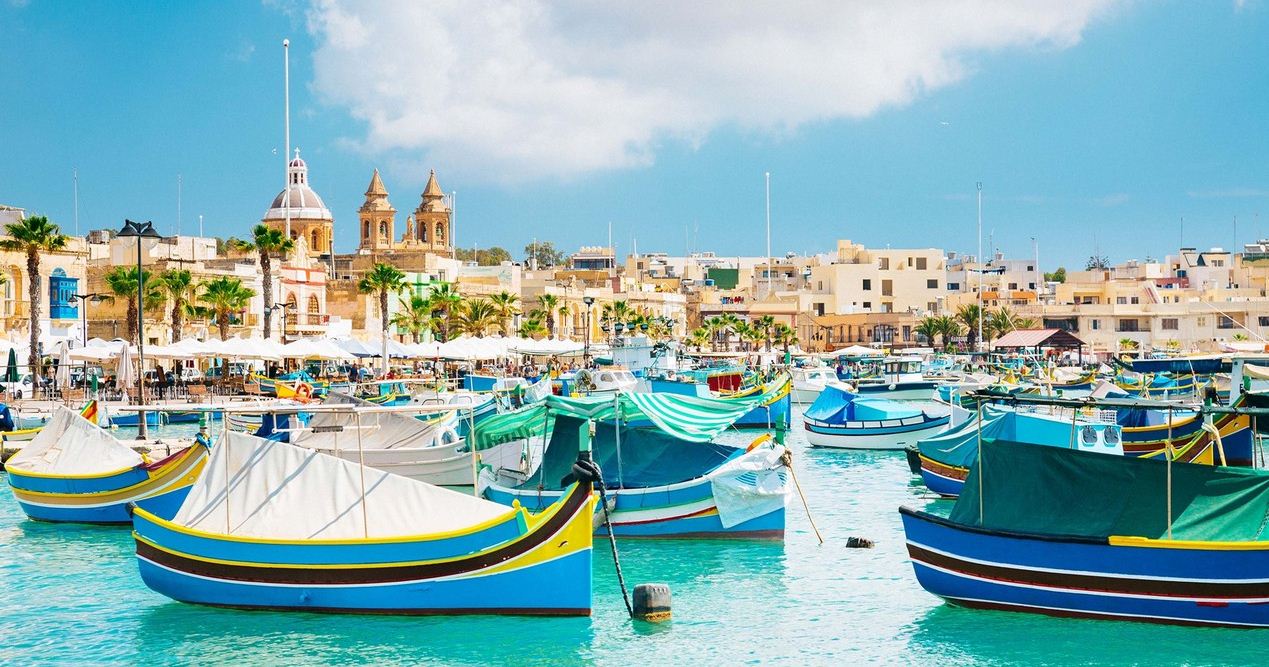
Love the beauty of nature, blue sea and golden sunshine? So, Gozo Island is the perfect destination for you. Gozo Island is one of the 3 largest islands in the island nation of Malta which attracts travelers with a wide coastline, majestic and magnificent Window Azure arch which was formed in a limestone rock in a unique shape lying quietly in space creating a spectacular scenery of nature. Not only that, visiting Gozo you also have the opportunity to visit the ancient and sacred temples of Ggantija. An early morning sunrise on the island of Gozo will be a great start for your journey. You can take a boat tour to visit the rock arch to feel the grandeur and wonder of nature, swimming or diving in the clear water in this sea are also interesting experiences.
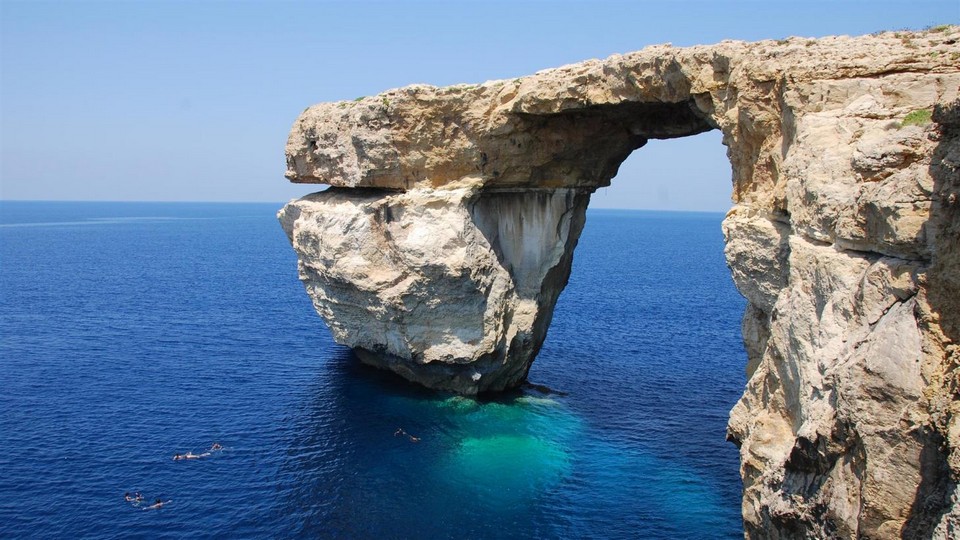
With 200km of coastline, Malta possesses beautiful hidden coves, bays, secluded beaches that intriguing visitors at firt sight. In Comino, an island has only an area of about 3.5 square kilometers but owns the most beautiful beach in this island nation. In particular, the Blue Lagoon on the island wears a sparkling turquoise blue with a white sand strip in a tranquil space between heaven and earth. Lying on the sand, enjoying the warm sunlight on the beautiful and romantic island of Comino will make you always in a peaceful and happy mood. Wandering around the island, watching the waves crashing on rocks or the magnificent scenes of sunrise and sunset will make you fall in love with this beautiful island more.
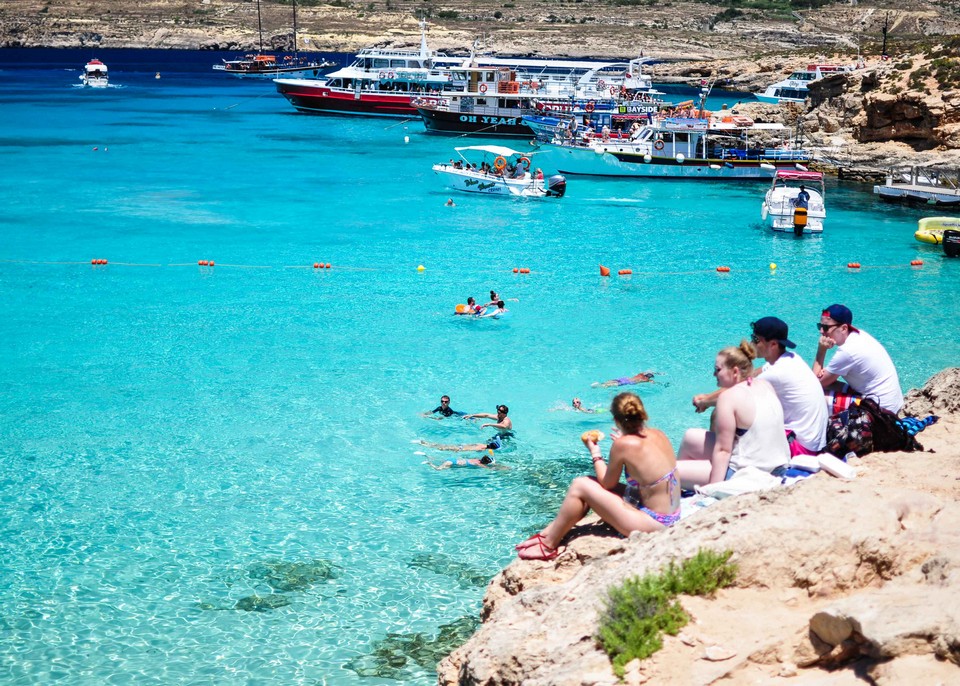
Mdina is a fortress town in the North, which served as the capital of Malta during the Middle Ages. The whole city was enclosed within the fortress wall with a total population of less than 300 people. The town is exactly an ancient fortress that has preserved its original structure and shape from ancient time. From the narrow roads surrounded by golden stone walls to the ancient street lamps along the alleys, corners, street signs… All of them still have the impression of medieval times.
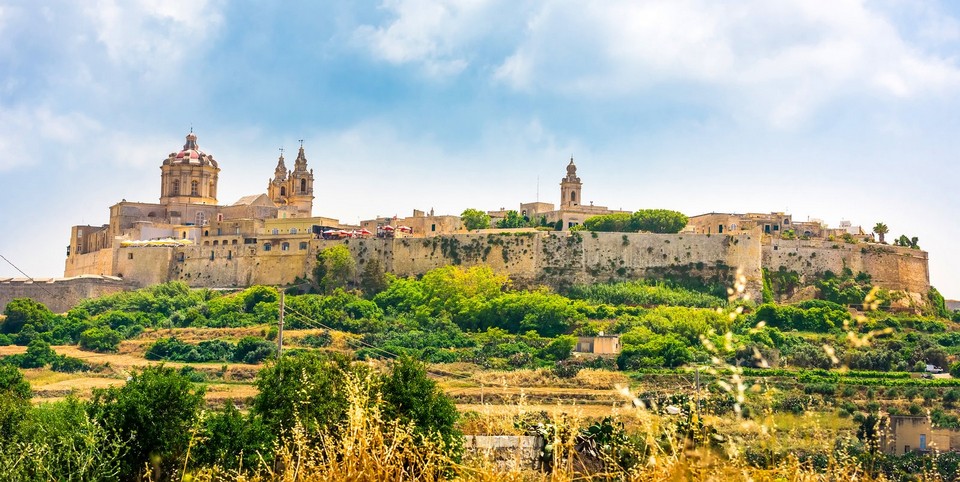
There is a wide range of activities to enjoy here such as strolling around the picturesque streets as well as visit many museums. This town is also known for its cute cafes and eateries, perfect for relaxing for hours.
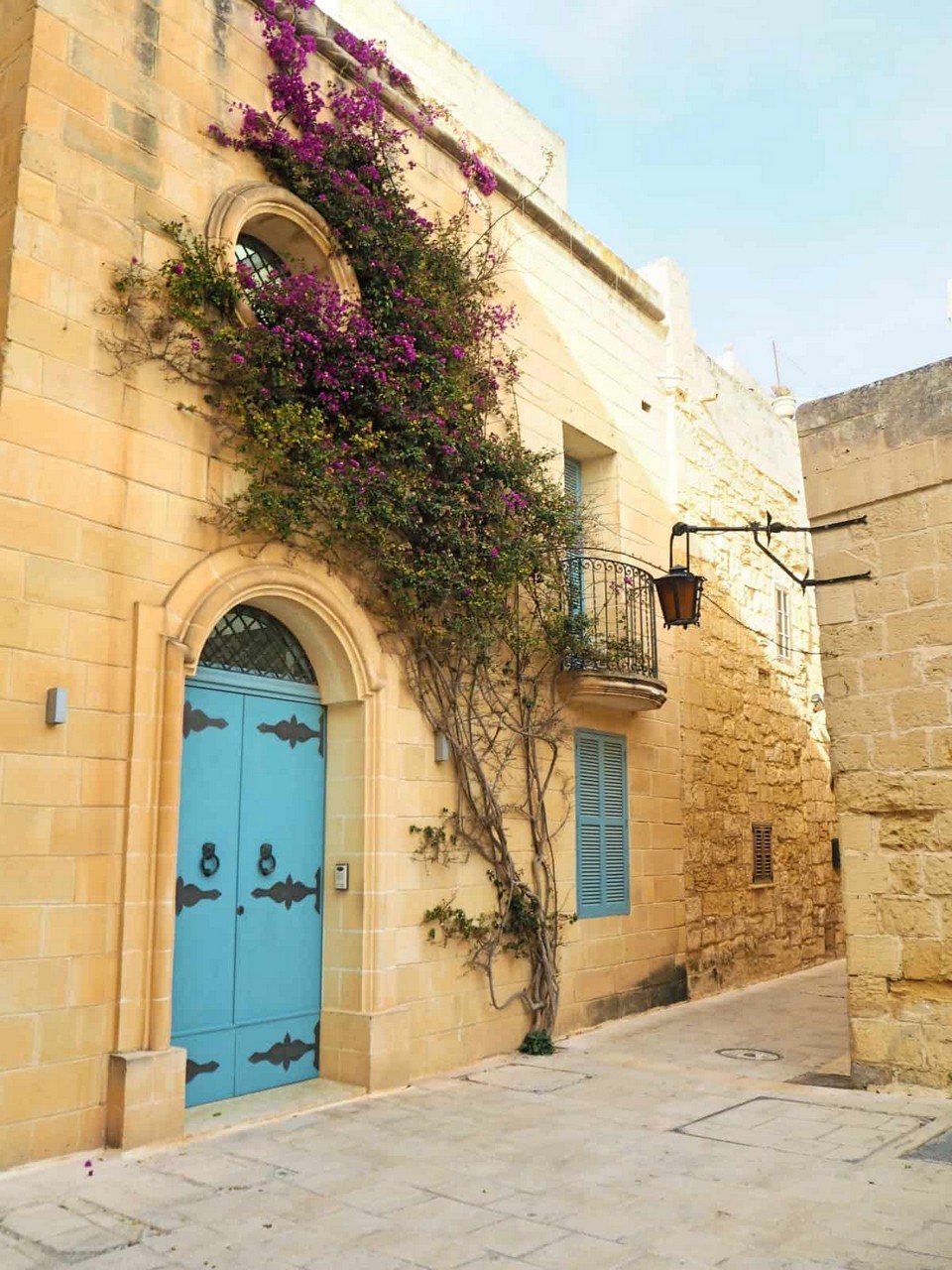
Located just outside the walls of Mdina fortress is the town of Rabat. Rabat means “suburban”, or in other words Rabat is the suburb of Mdina. The small town of Rabat with about 11,000 people, is not as magnificent as Mdina, but literally a more ordinary inhabited town. The road leading into the town center is filled with shops, houses, small cafes with red and blue windows that are very typical of Malta.
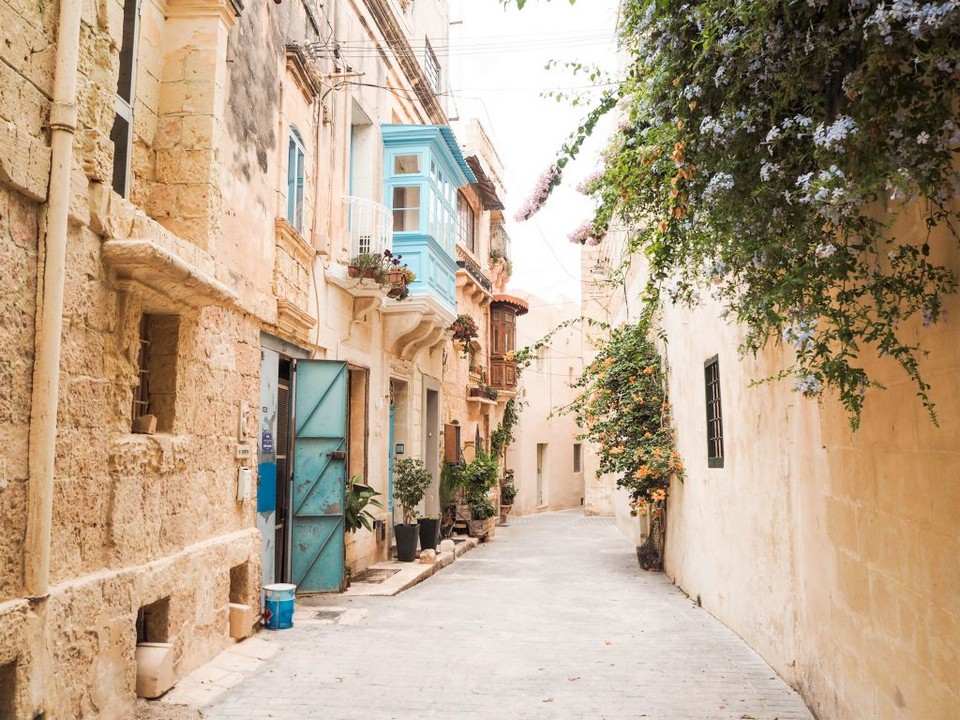
Visiting Rabat you will be surprised when green dominating everywhere. The green of the lawns adorning the foot of the ancient citadel, of the sparse forests interspersed and spreading, the town is full of old trees whose trunks are large enough for two people to embrace, with their elaborately trimmed foliage in round or square shape.
Sliema is a coastal town located in the northeast of Malta, bordering St. Julians. Once the home of the Maltese nobility, it has now become a major commercial area, very popular for shopping, bars, cafes, restaurants and hotels. Elegant villas and townhouses as well as many Victorian buildings built by the British lying along the promenade overlooking the rocky coastline. A unique experience that worth a try is Dinner in the Sky, where your dinner table will be lifted 40 meters above by a crane, and the panorama from above is something you’ll never forget.
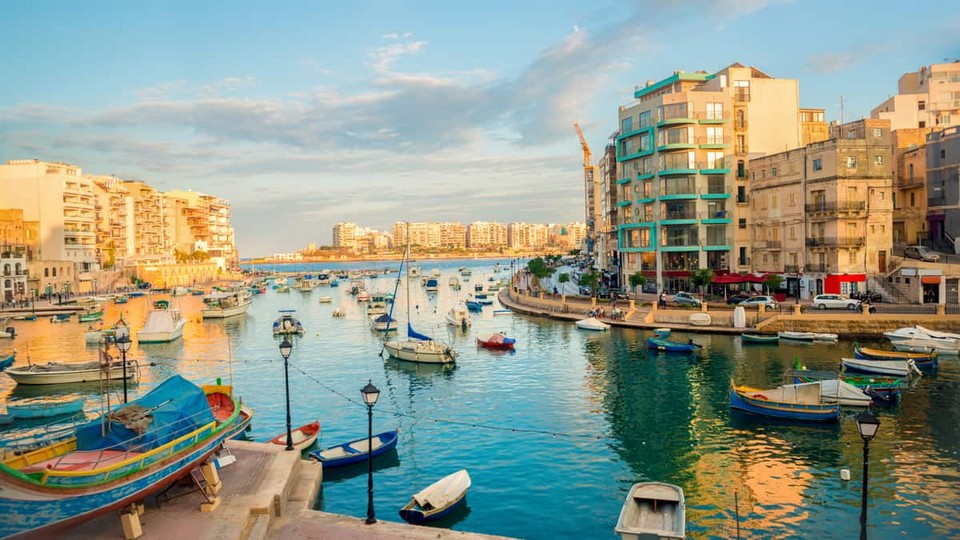
Qrendi is located in the South West of Malta near Mqabba and Zurrieq. The town is small, with a population of around 3,000 people, but it has two of the most important Neolithic temples in Malta, Mnajdra and aġar Qim. On the seaside, you can find the Maqluba, a massive sinkhole that was formed by a great storm in 1343. Qrendi also home to the spectacular Wied iz-Zurrieq harbour and the famous Blue Grotto. The village center is quiet, with many old buildings, however, the suburbs are quite modern and developed. There are no tourist facilities in the centre, making Qrendi a truly Maltese village.
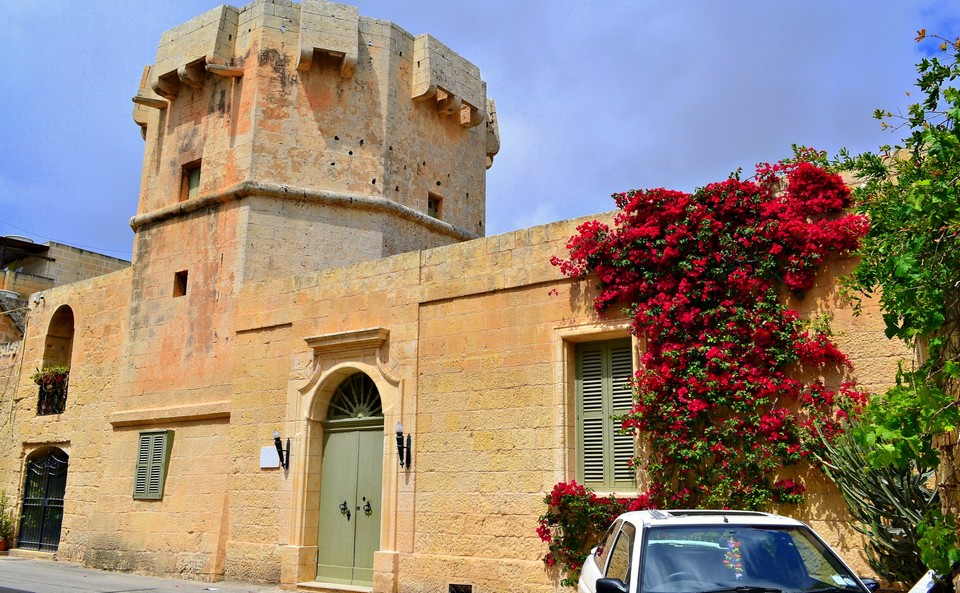
It is a megalithic temple complex, and one of the UNESCO cultural heritage sites in Hagar Qim area, Mnajdra temple is located 500 meters from Hagar Qim temple. This archaeological site is located in an isolated and rugged stretch of the south coast of Malta facing the sea. The complex consists of three buildings facing a common oval front yard and may be part of a larger complex.
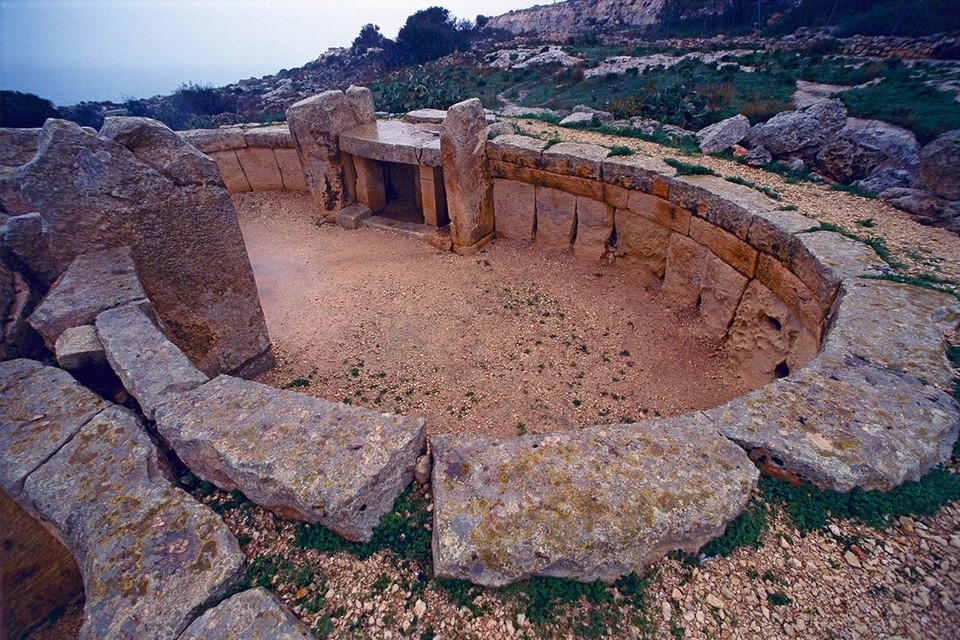
The oldest structure, the southern temple dates from around 3600 to 3200 BC. Two other temples were built between 3150 and 2200 BC. These three structures represent an important period in prehistoric human development known as the Ggantija Period (circa 3150 BC to 2500 BC), which was an important period of The Bronze Age period in Malta (2400 BC – 700 BC).
This rural village has a history dating back to 1436. The Grand Master de Rohan (Emmanuel de Rohan-Polduc) elevated Zeborms to a city, renamed it Citta Rohan and built the triumphal arch at the town’s entrance. The main square is decorated by the two-story Baroque Parish Church of Saint Philip with an ornate interior. The original design was created by Cassars, the architect of Saint-John Co-Cathedral in Valletta. Zeborms holds its annual religious festival, The Saint Philip’s Festival at the Parish Church in June.

Blue Lagoon
Great for swimming, water activities, or floating on a life jacket, Blue Lagoon with its emerald water, smooth white sands, the same length as Olympic-sized swimming pool. Good swimmers can cross the cove and small beach on the other side of the lagoon.
From May to October, tourists can stay at Comino Hotel (the only hotel on the island) to enjoy the Blue Lagoon without a tour and enjoy a peaceful vacation more easily. Things to do on Comino Island include walking, hiking, and water sports like snorkeling and scuba diving.
Blue Grotto
Not to be confused with the Blue Lagoon above, located in the Northwest of the archipelago, in Comino Island, the Blue Grotto is an ensemble of seven caves found along the island’s southern coast, directly across from the islet of Filfla and less than a kilometer from Wied iż-Żurrieq village to the west. It was given its name in the 1950s when a British soldier visited the area and compared it to the famous Grotta Azzurra of the island of Capri, which basically means “Blue Grotto”, because the water is so blue.

The breathtaking seaside setting and limestone caves here are a picture of pure serenity, the water surface shines a brilliant blue in the sun. According to mythology, the Blue Grotto was the home of mermaids and sea nymphs, who seduced sailors with their enchanting voices.
The village of Wied iz-Zurrieq (just 1 km from the Blue Grotto) has many souvenir shops, ice cream shops and cafes, as well as cliff restaurants with great views. You’ll enjoy a meal at one of the restaurant’s terraces overlooking the azure waters of the Mediterranean Sea.
The beach is extremely wide with soft golden sand, clean water, quiet because it is far from traffic, safe for swimming. Many visitors spend whole day here for sunbathing while listening to the soothing sound of the waves crashing against the shore. There are also cafes and restaurants with terraces overlooking the coast and gentle waves.
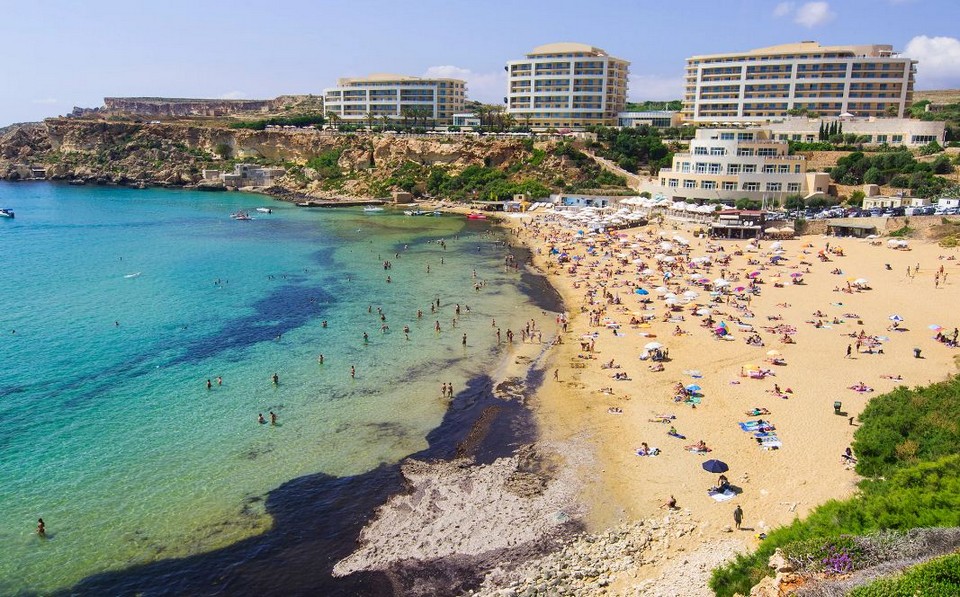
Ghajn Tuffieha Bay and the beaches of Gnejna Bay
For visitors exploring the area by car, it’s worth the two-kilometer drive from Golden Bay to the pristine beach at Ghajn Tuffieha Bay. Surrounded by cliffs and steep hillsides, the beach is accessed by climbing down 200 steps. Considered one of the top beaches in Malta, Ghajn Tuffieha is popular with locals.
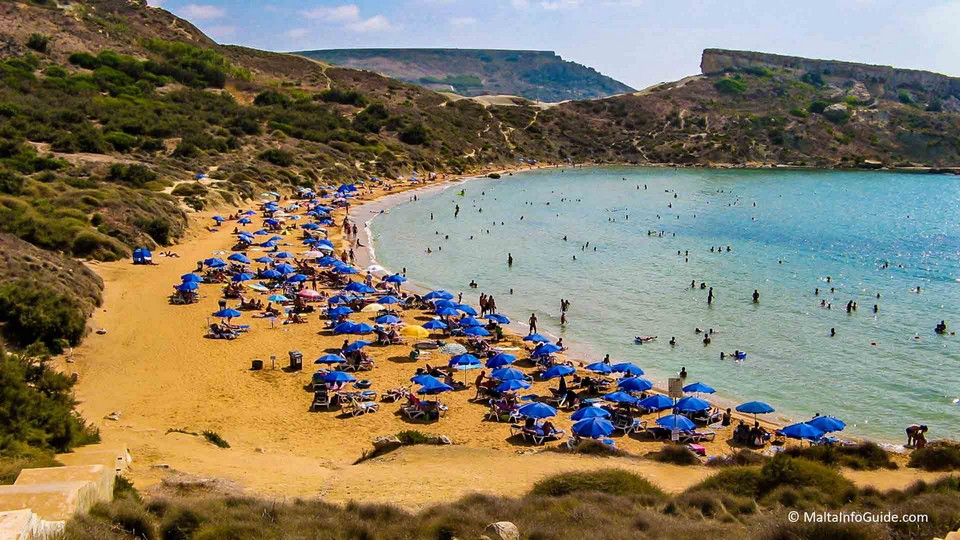
Continuing riding for another seven kilometers from Ghajn Tuffieha Bay is Gnejna Bay, a protected cove surrounded by steep limestone cliffs. Walk down the steep stairs you will reach the beautiful orange-sand beach, which is popular with swimmers and snorkelers. Water ski and canoe rentals are also available as well as public restrooms and food stalls.
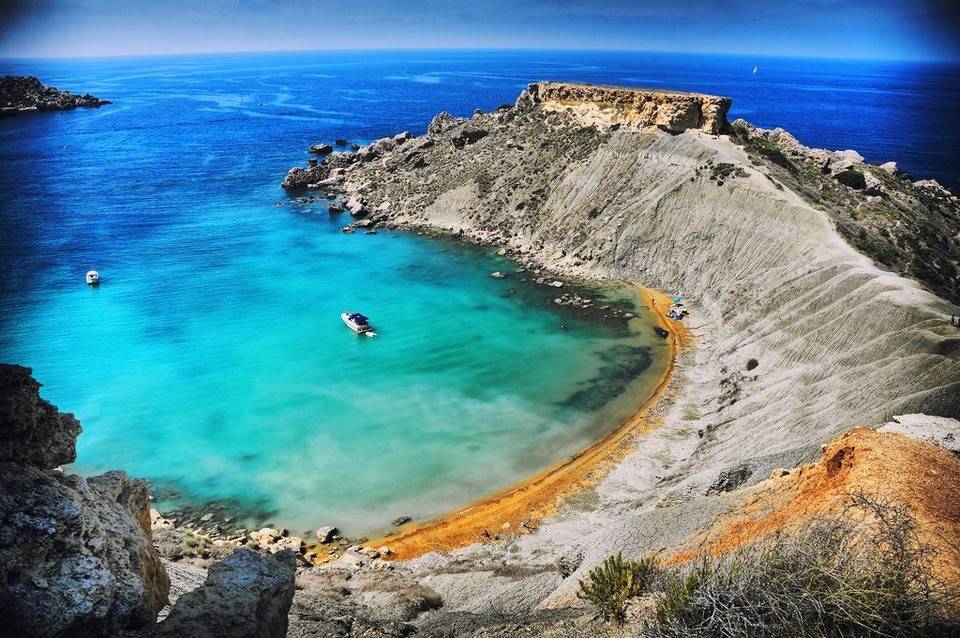
Between the bays of Ghajn Tuffieha and Gnejna is the rural village of Mgarr, a scenic spot of vine-covered hills and small farms. Outdoor lovers will enjoy beautiful hiking trails from Mgarr to the countryside and along the coast to Gnejna bay.
Mellieha Beach
Located in the scenic countryside of the Northwest, Mellieha is a family-friendly beachfront destination. The beach is located next to a busy road but does not lose its natural beauty. Mellieha Beach has the largest stretch of sand in the island nation of Malta with a 1.5 km long coastline with fine white sand.
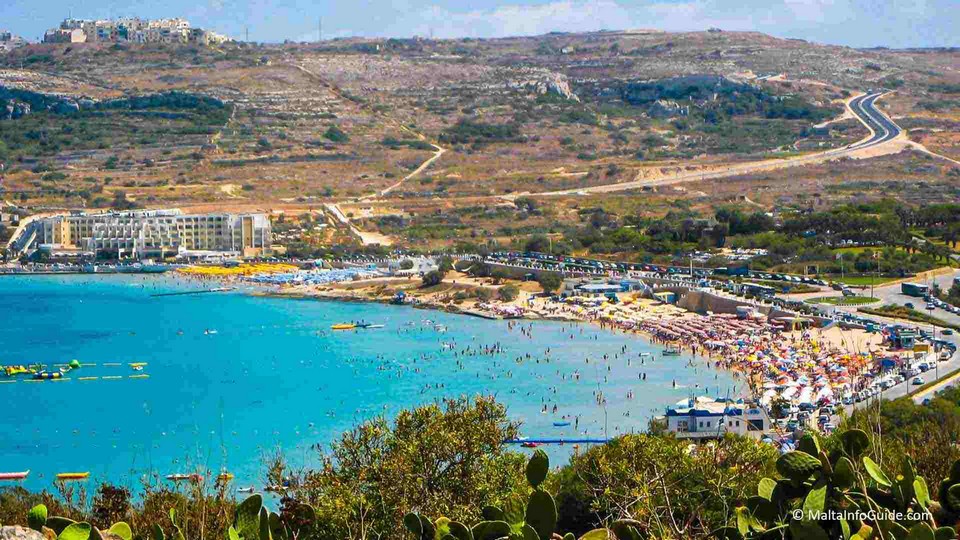
Hal Saflieni Hypogeum
At Hal Saflieni Hypogeum, visitors can explore the prehistoric world (circa 4000BC – 2500 BC). This UNESCO archaeological site is a Neolithic relic discovered in 1902. It is a complex of stone-carved catacombs. In this underground labyrinth, prehistoric humans performed religious burial rituals. The most fascinating thing of the site is that it represents an ancient cultural tradition that no longer exists but remains a mystery to archaeologists and scholars.
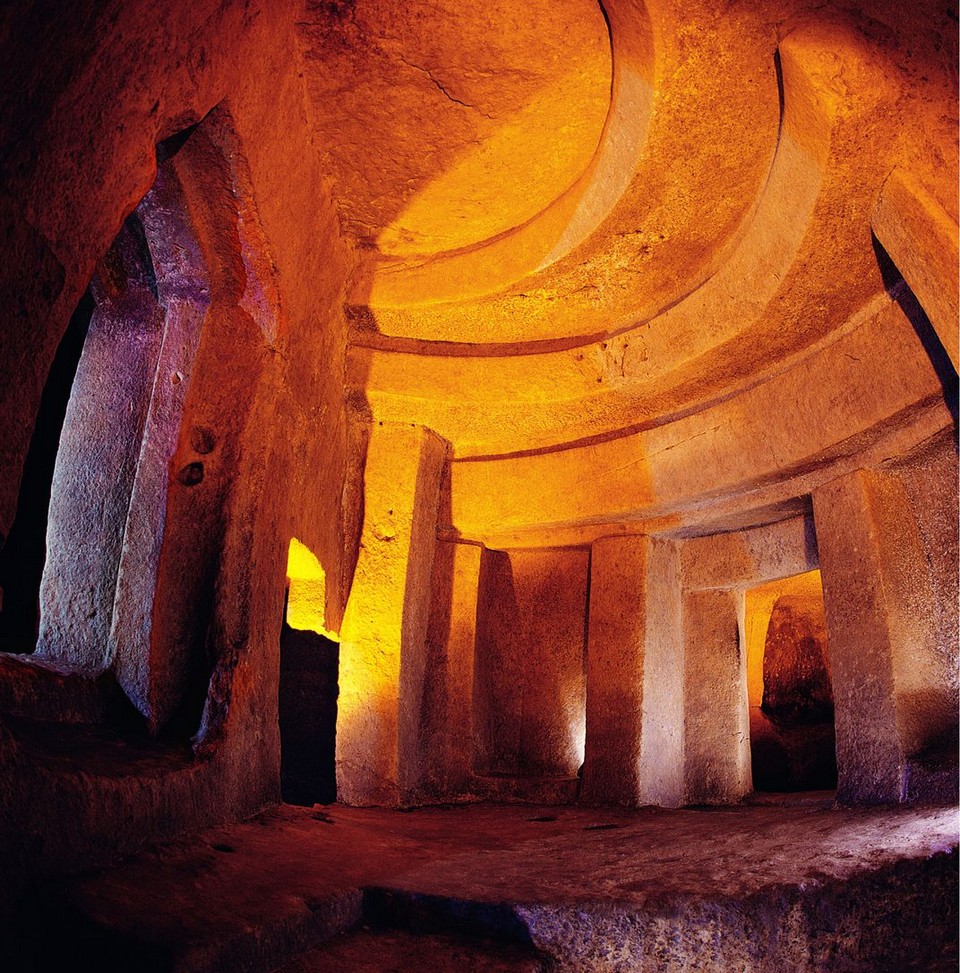
Diving at HMS Maori
Malta has a warm climate and is also blessed with azure seas, which means it is the perfect choice for those who love to swimming, snorkeling or scuba diving. There is an array of man-made reefs here as well as a number of military shipwrecks dating back to the Second World War.
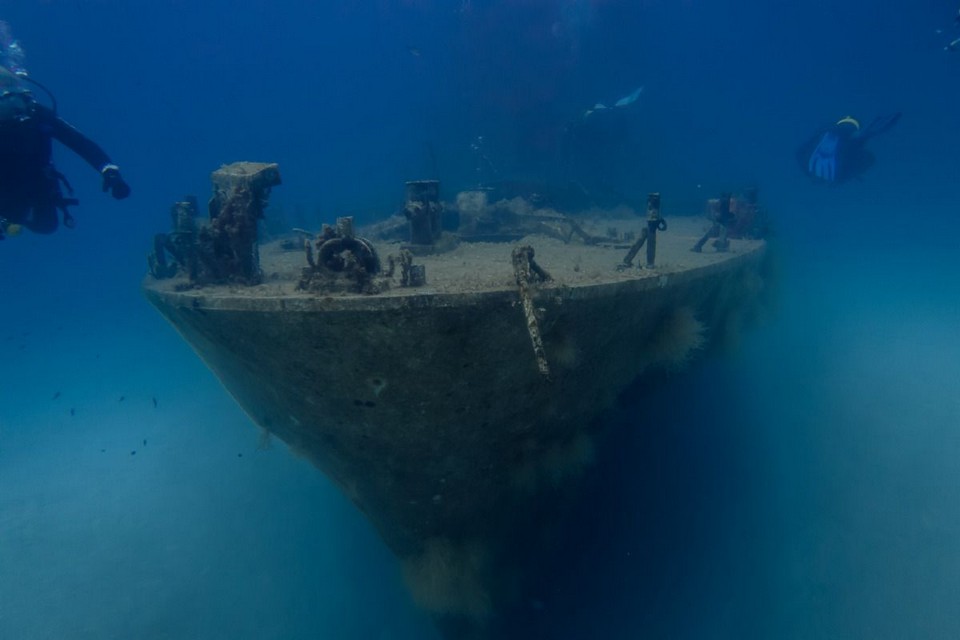
One of the most famous diving sites is called HMS Maori, a frigate that was sunk by the Germans and now lies on the seabed at a depth of 14 meters. This is a good diving spot for beginners due to easy access and relatively shallow depths, and if you want to get a diving certificate, some expert divers can support you.
Malta guide: Where to stay?
Hotels in Malta are also very diverse with wide-range choices and different prices, depending on the choice of travelers. Hotels are usually concentrated in St Julian’s , Sliema , St Paul’s Bay , St George’s Bay and Bugibba. In addition, there are many hostels, guesthouses and apartments in Malta for tourists to rent and relax. Campsite in Mellieha will also be an interesting experience if you want to try. Malta also has 2 tourist villages and villas suitable for families and large groups.
If you choose to stay in Valletta, it’s hard to find a cheap hotel (lowest rates are usually 70 euros/night), but one thing is for sure, you will get a room of the right value. Dozens of luxury hotels and apartments are offered in the city, with beautifully decorated authentic buildings, historic buildings and spacious, villa-like hotels. Hotel Phoenicia Malta ( Agoda.com or Booking.com ) , Hotel Palazzo Paolina ( Agoda.com or Booking.com ) , Palais Le Brun ( Agoda.com or Booking.com ) and Ursulino Valletta ( Agoda.com or Booking.com ) are just some of the best options if you want the ultimate in experience.

Check out more top rated and best hotels in Malta on Agoda.com or Booking.com .
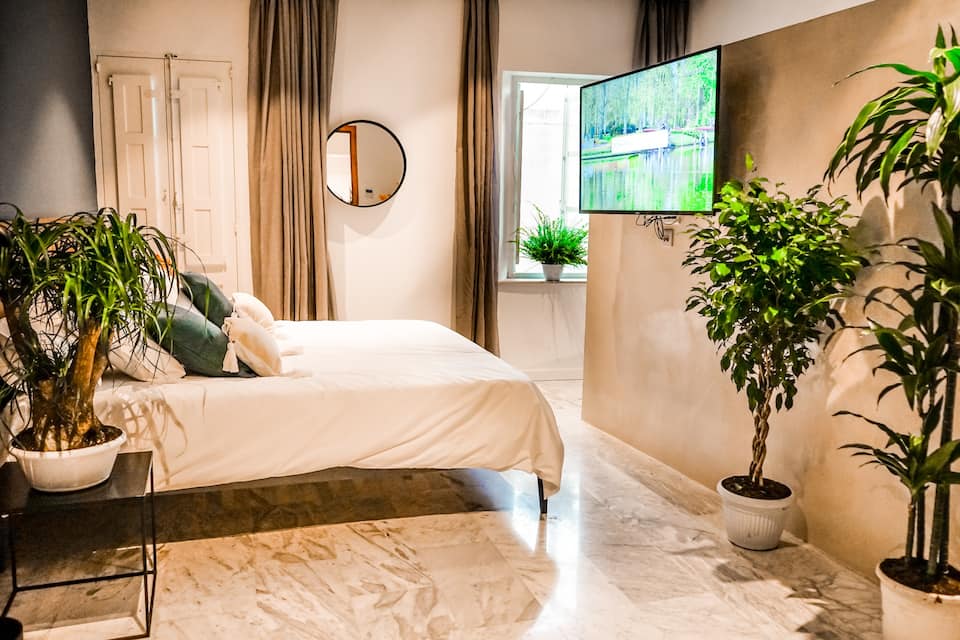
Malta blog: What to eat?
Local, fresh, simple and seasonal dishes are the essence of Maltese and Gozitan cuisine. Maltese cuisine is influenced by its proximity to Sicily and North Africa but it still holds its own flavor and uniqueness.
You can find a wide range of Mediterranean flavors with mains being seafood, vegetables, pasta, meat, bread, cheese and olive oil. To experience the most authentic dishes and a better understanding of Maltese cuisine, look to family-run restaurants in smaller towns.
Stuffat tal-Fenek (Stewed Rabbit)
Stewed rabbit is the national dish of Malta. Rabbit meat is usually prepared in one of two ways, stewed or fried. For stewing, this is a slow cooking process (more than 2 hours) that made the meat to become extremely tender. Stew dishes uasually add a rich tomato sauce and can include a variety of vegetables such as onions, garlic, carrots, and potatoes. It is also often served with spaghetti or some other pasta. You can find this dish at most restaurants in Malta.

Gbejniet (Maltese cheese)
Maltese love their own cheese, especially Gbejniet! Gbejniet is a typical cheese of Maltese people, made of goat or sheep’s milk, salt and rennet. It can be found in 3 forms: fresh, dried or processed and may have peppercorns added to enhance flavor or remain original. In addition to being eaten in original form, this cheese is also commonly served by deep-fried, sprinkled on salads, filling for ravioli (instead of ricotta), and sometimes, even in pies.
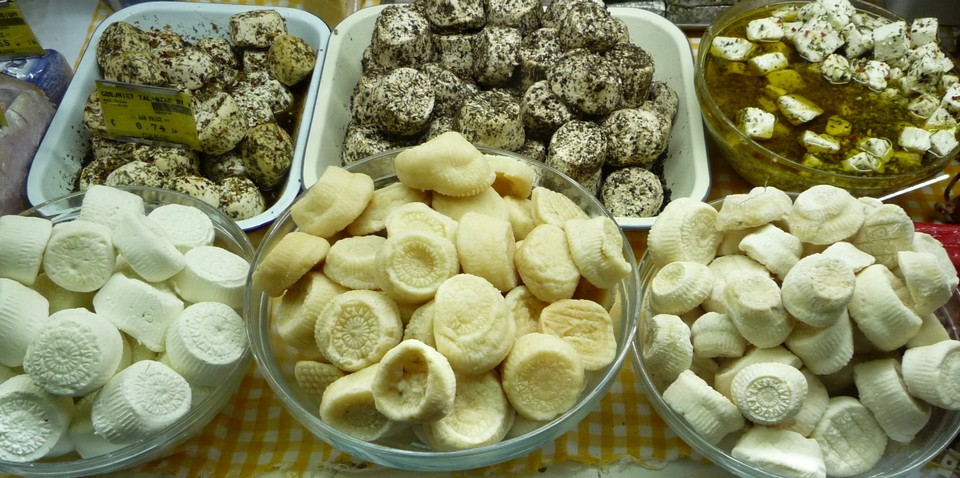
Don’t miss this pastizzi. This is one of those wonderfully creative dishes, this pastry is filled with a variety of ingredients, but the two traditional pastizzes contain ricotta cheese or peas. They’re incredibly greasy, delectable and full of calories, so it’s best to try them in the morning when they’re fresh out of the oven!

Aljotta (fish soup)
Aljotta is a soup that uses fish and herbs, has a light, fresh and delicious taste. The flavors stem from herbs, citrus, garlic and of course fresh seafood (mussels, octopus, shrimp, fish, typically kingfish). A hearty meal for any seafood lover!

Timpana (Grilled Macaroni)
These are great pasta pastries. This baked pasta dish is made with very simple ingredients – pasta and dough. Macaroni is cooked in a bolognese sauce with minced meat, bacon, tomatoes, garlic, onions and cheese and then baked in a puff pastry. This dish is quite filling, so make sure you are very hungry before enjoying this meal!

Torta tal-Lampuki (Lampuki Pie)
Always loved by Maltese people, Torta tal-Lampuki brings a sea flavor will surely make diners excited to enjoy. Torta tal-Lampuki is made with fresh sea fish as the main ingredient, cooked in a variety of ways, such as grilled or fried and then topped with tomato sauce, onions, olives and fresh herbs. The time from late August to November is the “season” of this dish.
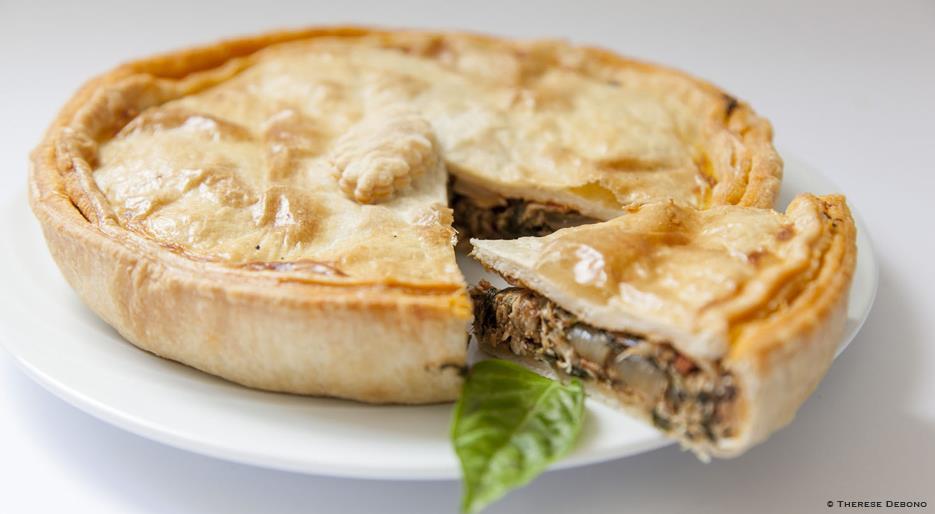
Imqaret (Doughnuts)
Imqaret is a deep-fried Maltese sweet that can be found at any street corner and on dessert menus at restaurants. The pastry is filled with dates then deep fried and covered with icing sugar and served with ice cream. If you want to get one for takeout, you’ll be missing out the delicious ice cream, so be sure to give it a try while sitting at the shop.
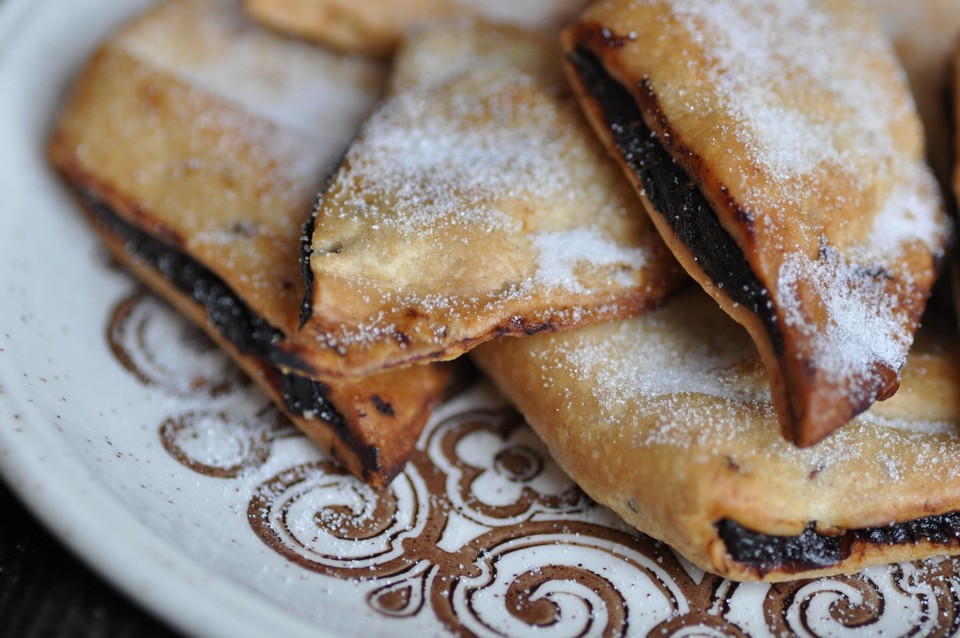
Zalzett tal-Malti (Maltese Sausage)
Maltese sausage is a homemade sausage mainly made of pork. The dish is influenced by British cuisine but prepared in the Portuguese tradition way. Fresh Maltese sausages are made from garlic, herbs, pepper, crushed coriander seeds and spices while the dried ones are made a bit simpler.

Pan-fried Lamb Chops
Maltese people love to eat well-done cooked meats, so it’s no surprise that you’ll find both lamb and pork on many menus. Because the meat is slow cooked and tender, it has more flavorful. The cuts of meat are tender and tastier, especially when covered in gravy and served with butter and potatoes, it’s amazing!

Maltese Platter
The best recommendation when you want to learn about Maltese cuisine is a Maltese appetizer plate. Most of them will have small portions of the most appreciated dishes by locals. In the example below, you’ll enjoy a spread with tuna, capers and dried tomatoes, Maltese sausage, stewed beans, and olives, and a salted cheese and pepper similar to feta cheese (gbejniet).
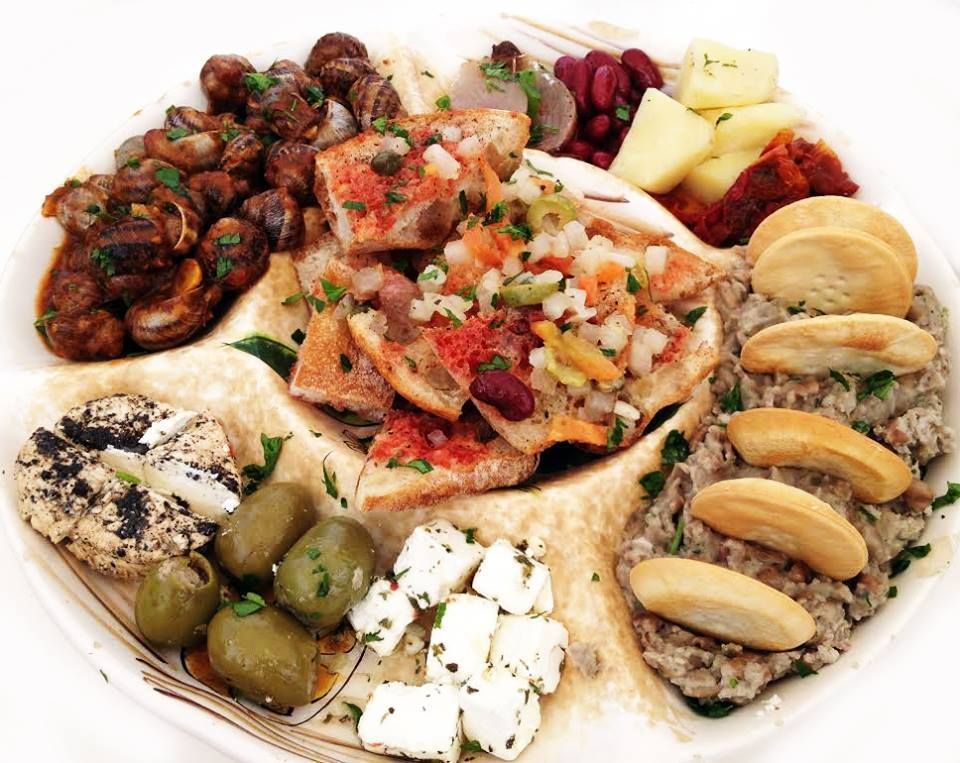
Recommended bars and restaurants:
Restaurants: Rising Sun (Marsaxlokk) , Loli (vegetarian restaurant), The Grassy Hopper (vegan), Marsaxlokk fish market, Suruchi, Ta Doni, Cuba, Rocksalt, Ta’ Rikardu (Gozo) , Electro Lobster Project.
Bars: Hole in the Wall (Sliema) , Native (and any bars on this street as it is the main hub for nightlife), Dubliner, Legligin, The Thirsty Barber.
Malta travel guide: Malta travel costs
Traveling to Malta is surprisingly cheap, the cheapest one among European countries. I came here in the middle of winter – there is no seasonal increase in accommodation, car rental and airfare and my friends tell me that most costs for food, activities and year-round public transport remains the same. Here is a list of common costs in this country:
- Ferry from Sliema to Valletta: One-way: 1.50 euros. Round-trip: 2.80 euros
- Ferry from Valletta to Gozo: 4.65 euros/person, Car and driver : 15 euros
- Pastizzi (cheap snacks): 1-2 euros
- Sandwiches for breakfast : 3-4 euros
- Full breakfast: 3-4 euros
- Lunch at the cafe: 8-10 euros
- McDonald’s: 5-6 euros
- Sandwiches: 6 euros
- Dinner with wine at a restaurant: 25 euros
- Main meal: 10-14 euros
- Pizza: 6-9 euros
- Bottled water: 1 euro
- Wine: 8-10 euros
- Beer: 3 euros
- Admission to the museum: 6 euros
- Car rental: 38-48 euros
- Taxi fare: 10-20 euros
- Bus ticket: 2 euros
On average, you can travel to Malta on a budget with 30-45 euros per day, but in the summer you’ll need around 50 euros per day. For that price, you will have to stay in a hostel or share an Airbnb with a friend, take public transport, most of the activities you take part in will be free activities, prepare your own breakfast and cheap eats at cafes.
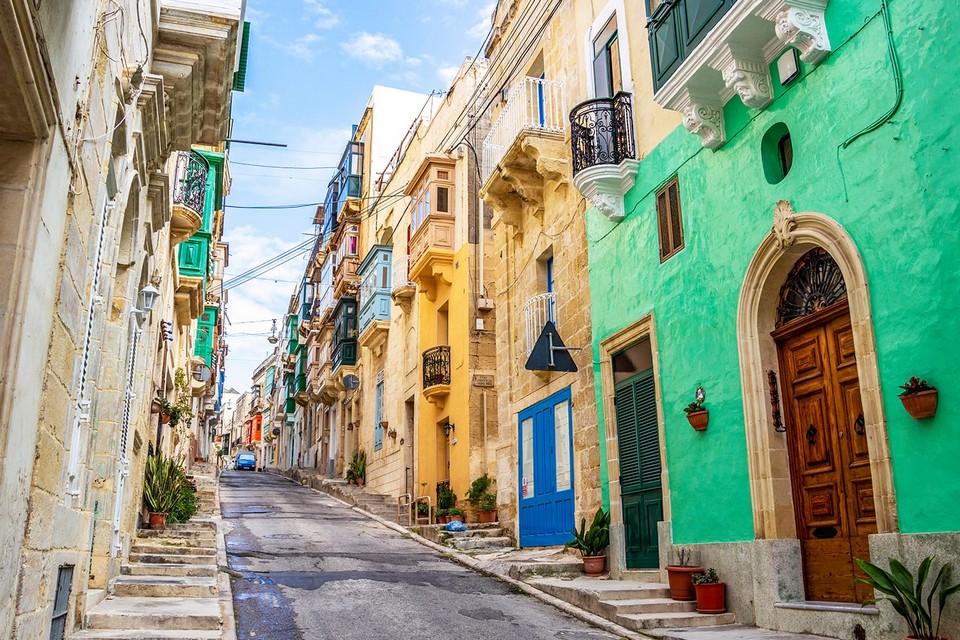
In addition, all churches are free admissions. You will find lots of companies that will take you around the island in a boat for EUR25. Most museums and attractions cost EUR5 entrance fee but you can choose to buy a Malta tourist card as suggested above (there is one for Mdina and another card for Valletta) which will save you around EUR10-20 depending on number of tourist attractions you will choose to visit.
Malta blog: Before you go
- Opening hours of restaurants, cafes and bars will be from 9AM to 1PM. The hotel bars will be open from 1PM to 4PM but will continue to serve guests from 6PM.
- Short-haul flights between Grand Harbour in Valletta and Mgarr Harbour in Gozo usually take about 20 minutes. You can also rent cars and bicycles for your convenience of traveling.
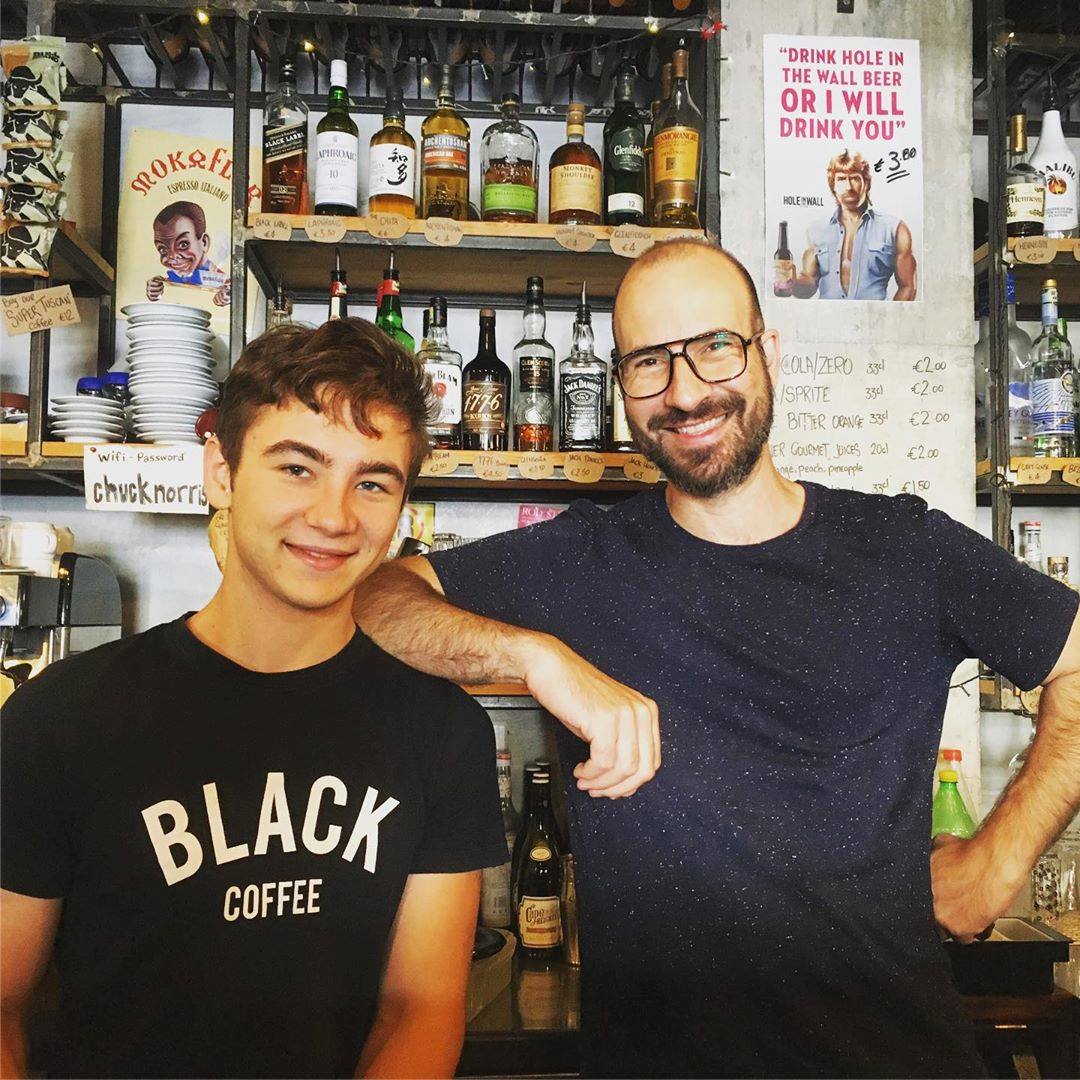
Some best day tours, trips, activities and transfer services, tickets in, from and to Malta you can refer to
- Valletta Traditional Two Harbours Day Cruise of Malta
- Malta Prehistoric Temples Tour
- Valletta Half Day Tour
- St Paul’s Bay: Blue Lagoon, Beaches & Bays Trip by Catamaran
- Bugibba: Gozo, Comino, and Blue Lagoon Sightseeing Cruise
- Malta: Comino, Blue Lagoon & Gozo – 2 Island Boat Cruise
- Malta: 5-Hour Lazy Pirate Boat Party with Drinks & Food
- Comino: Blue Lagoon, Crystal Lagoon, and Seacaves Tour
- Malta: Comino, Blue Lagoon & Caves Boat Cruise
- Gozo: Full-Day Jeep Tour with Lunch and Powerboat Ride
- Malta: Comino, Blue Lagoon, and Caves Day Trip
- Malta: Shuttle Transfer between Malta Airport and Hotels
- Malta: Malta Island Bus Tour and Boat Tour
- Malta: Full-Day Gozo and Blue Lagoon Cruise with Drinks
- Malta: Marsamxett Harbour and Grand Harbour Cruise by Night
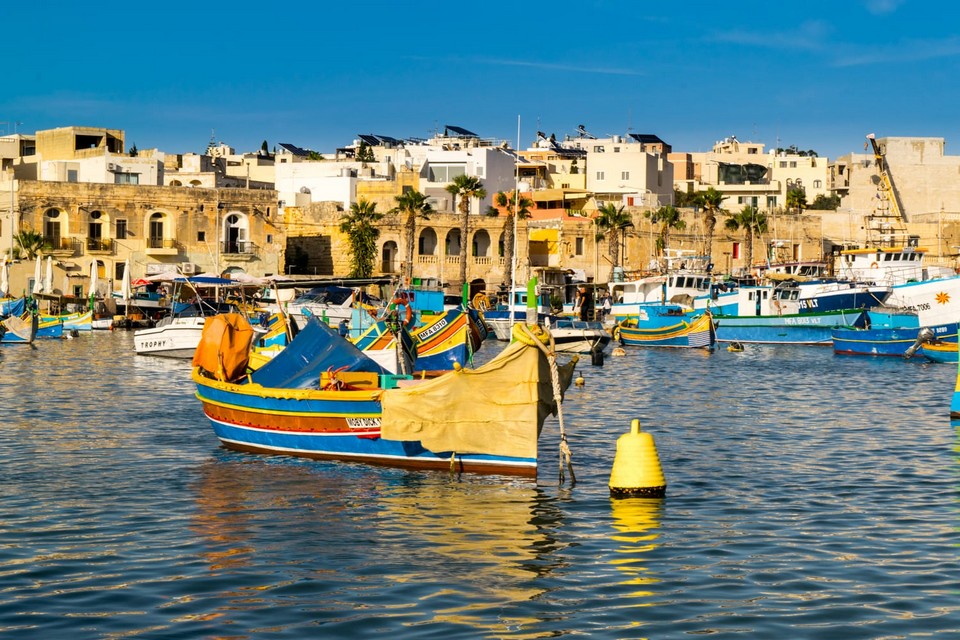
Are you looking for more top things to do in Malta: Tours, activities, attractions and other things? Let’s check it out here . And Malta travel guide here .
Related articles
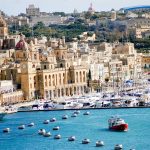
RELATED ARTICLES MORE FROM AUTHOR

7 reasons why Langkawi should be your next destination
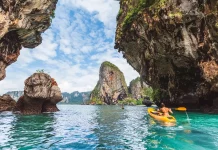
Krabi itinerary 4 days — What to do in Krabi for 4 days?
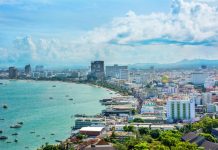
Pattaya travel blog — The fullest Pattaya guide for first-timers
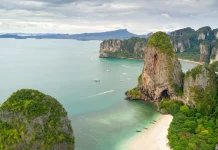
Krabi travel blog: The ultimate Krabi travel guide & suggested Krabi itinerary 4 days perfectly?
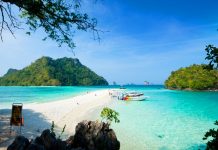
Krabi itinerary 3 days 2 nights — How to spend 3 days to fully explore the island paradise of Krabi Island, Thailand
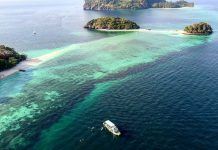
Bangkok Krabi itinerary 8 days. How to spend 8 days in Thailand to visit Krabi and Bangkok?
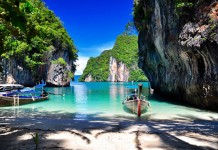
Krabi island blog — Amorous experiences in Krabi Island, Thailand
Editor picks.

What to do & how to spend 4 days in Kuala...

Okinawa itinerary 3 days. What to do in Okinawa for 3...

16+ best places to visit & top things to do in...
Popular posts.

What to buy in USA? — 17+ must buy in USA...

What to buy in Korea? — Top +23 cheap, famous &...

Must buy souvenir in Taiwan — Top 17+ most famous, cheap...
Popular category.
- Inspiration + Guide 1496
- Trip Inspiration 468
- Food + Drink 220
- Thailand 212
- Coasts + Islands 195
- South Korea 174
- Vietnam 172
- Travel Photos 144
- Work for Us
- Terms & Conditions
- Privacy Policy

Explore the beauty of Malta, Gozo and Comino
Malta Travel Info: All Your Questions Answered
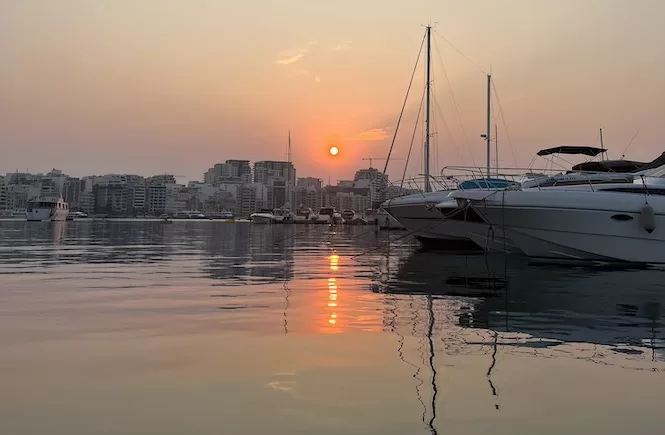
If you’re dreaming of an unforgettable island escape, you’ve come to the right place. This article includes all the Malta travel info you need.
From tips on saving time and money to navigating local customs, this guide unlocks Malta’s best. Want scenic bus routes or the best taxi app advice? Keep reading…
Table of Contents
Malta Travel Info: Transport
Is there an Uber in Malta?
Good news! Malta offers Uber, Bolt, and eCabs, a local taxi app. Prices can vary, so it’s smart to compare rates across these apps.
Do Malta drivers drive on the left or right side of the road?
Remember, in Malta, the left side is the right side like in the UK. If you’re renting a car, this is crucial to know.
What is public transportation like in Malta?
Malta’s public buses are reliable and budget-friendly. They cover most of the island, making it easy to reach central spots.
However, if you’re venturing to more remote areas, be prepared for a longer journey. But for the main attractions, buses are convenient. A bus ticket costs €2. It’s valid for two hours, including changes. You can find schedules and routes on this website or else just use Google Maps.
Does the city have a metro or train system?
Buses, taxis and ferries are your main public transport options. There is no metro in Malta.
What is the best way to get from the airport to the city?
You’ve got choices. If you want comfort, take a white taxi or use a ride-hailing app like Uber, Bolt or eCabs. They’re usually cheaper than white taxis. It’ll cost you around 12-14 euros to get to Valletta or Sliema . You’ll pay more in Bugibba or Mellieha .
Is it expensive to take a taxi?
Not really, but it depends on the distance. Short hops won’t cost much, but a trip across the island will add up. In high season. the prices tend to go up.
What is the best taxi app in Malta?
I prefer not to favour one taxi app over the others. I use Bolt, eCabs and Uber. It’s a good idea to compare their rates since they can differ. I typically compare all of them and pick the one that offers the best price or the quickest service.
If you are looking for the cheapest taxi service in Malta, check all the apps to choose the best rates. I usually find eCabs or Bolt cheaper.
Is walking an effective option?
I n cities like Valletta , Mdina , Sliema or St. Julians , walking is the most convenient way to explore. But for longer distances between towns, you’ll need to drive.
Do you need a car in Malta?
If you’re staying for a week or more, renting a car is better than travelling using public transport. It saves time and you can easily reach Malta’s hidden gems .
Check out my guide on renting a car in Malta . For the best car rental deals, check out Discover Cars . Besides hav ing a wide selection of cars, they offer free cancellations and a good review system so that you can choose the best rental car.
Is an international driver’s license needed to hire a car in Malta?
If you’re from the UK or an EU country, your local license will do. Travellers from other countries should check local regulations, but an International Driver’s License is often recommended. For more info, check our my guide to driving in Malta .
Is Malta a safe place to drive?
Absolutely, but take it slow. Roads can be narrow and winding.
Are there water taxis in Malta?
Yes, and they’re scenic treats! Here’s a quick rundown:
Sliema to Valletta: Glide across the water, soaking in views of Valletta and Manoel Island.
Valletta to Three Cities: This isn’t just a ride; it’s a mini-adventure through Grand Harbour.
Ferries to Gozo: Foot travellers can catch a ferry from Valletta, while car owners should head to the Cirkewwa ferry terminal.
Check o ut my transportation guide for more info.
Malta Travel Info: Money Matters
Can you pay with a credit card or do you need cash?
Leave the bulky wallet behind. Malta accepts credit cards at nearly all establishments. I rarely carry cash and never have an issue.
ATMs are easy to find?
Yes, ATMs are everywhere, especially in cities and tourist areas. Yellow Euronet ATMs charge high withdrawal rates, so avoid them. With a Revolut card, you can get 20 euros for free from the yellow ATM. If you want to withdraw 20 with another card, you have to pay a few euros commission.
Do you have to tip in Malta?
Tipping in Malta isn’t mandatory but is appreciated. A 10% tip at restaurants is an appropriate gesture if you’re happy with the service. It’s unusual to tip taxi drivers or other service providers.
Can I use mobile payment apps?
Yes, of course! Apple Pay and Google Pay are gaining traction and are accepted almost everywhere. Shop owners sometimes take payments via Revolut transfers in smaller shops where cards aren’t accepted.
Are there currency exchange offices?
Yes, you’ll find them at the airport, in tourist areas, and in banks. But for the best rates, consider using your credit card for purchases.
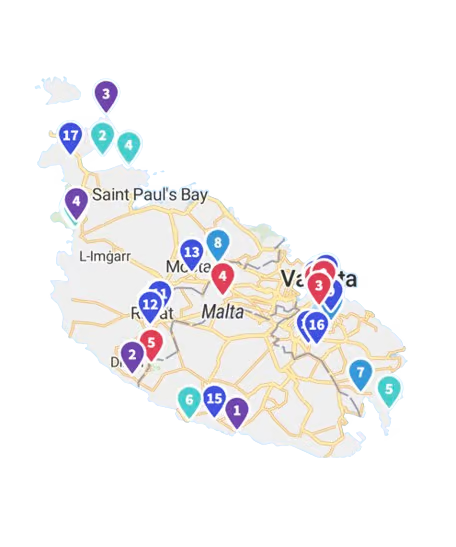
Get a FREE Attractions Map
Planning a trip to Malta, Gozo, or Comino? Get this free interactive map filled with insider tips, Google Maps links, and more.
Health and Safety
Can you drink tap water in Malta?
You can drink it, but it doesn’t taste good because it’s desalinated seawater. Bottled water is your best bet for quenching your thirst.
Is the food safe to eat?
Absolutely. Malta’s food safety standards are high. From street vendors to fine dining, you’re in good hands.
What about food allergies?
Most restaurants accommodate for people with food allergies. Just make sure to tell them before you order.
Are there vegan restaurants in Malta?
Veganism is becoming more and more popular. Check out this Facebook group . The re are plenty of recommendations by locals.
Are there public restrooms?
Yes, but they’re not on every corner. Malls, restaurants, and tourist sites usually have toilets.
Do I need vaccinations to visit Malta?
No special shots are needed. Make sure your routine vaccinations are up-to-date.
Is it safe to swim in the sea?
Malta’s waters are clean and safe for swimming. Just avoid harbour areas.
Is Malta a safe place to travel?
Malta scores high on safety. Just keep your wits about you, as you would anywhere else.
What’s the emergency number?
Dial 112 for any emergency—police, fire, or medical.
Malta Travel Info: Essentials
What plug does Malta use?
Don’t forget your Type G adapter. That’s the plug style in Malta, like in the UK.
Is Wi-Fi widely available?
Yes, Wi-Fi is in most hotels, cafes, and public spaces. Usually the signal is good.
Do I need a local SIM card?
No, but if you need data, an eSIM is an excellent option. It doesn’t require a physical SIM. Just scan a QR code. You keep your number for WhatsApp and calls. My favourite brand when travelling is MobiMatter . They have good rates and excellent customer support.
What’s the time zone?
Malta operates on Central European Time (CET), which is UTC+1.
Is English widely spoken?
Absolutely. You’ll have no trouble communicating in English across the island. Check out this guide to learn ab out the languages spoken in Malta .
Visa and Entry Requirements
Do I need a visa for Malta?
Malta is part of the EU, so the rules are the same. UK citizens can breathe easily; no visa is needed for short stays
For others, Malta offers Schengen Visas for up to 90 days and National Visas for longer stays. Just remember, having a visa doesn’t guarantee entry. You’ll need to meet specific conditions set by the Central Visa Unit and Malta’s Diplomatic Missions abroad. Learn mor e here .
Malta Travel Info: Lifestyle and Culture
Is Malta a party island?
Paceville says yes, but Malta is more than just a party hub. It’s a blend of history, nature, and nightlife.
Are there LGBTQ+-friendly clubs?
Malta is known for its progressive stance on LGBTQ+ rights, and its nightlife reflects that.
Is Malta good for families?
Absolutely. Think of family-friendly beaches and interactive history lessons at ancient sites.
Costs and Currency in Malta
What is the currency in Malta?
Malta’s official currency is Euro. Keep some cash handy, but most places accept cards.
Is Malta expensive to travel?
The cost of traveling to Malta varies based on what you like and how you travel. Malta is often a good choice for those looking to stick to a budget when compared to other European spots.
Staying at a hostel begins at €20-30 per night, while Airbnb options can range from €100 and up. Enjoying local eateries can save you money, with meals typically around €10-15. Public transportation is also budget-friendly, with bus rides starting at just €2.
How much should I budget for per day?
For a mid-range e xperience, think around €100 per day. That covers meals, attractions, and extras. I’ve got a guide on budget-friendly travel in Malta.
Was this Malta travel info guide helpful to you? If so, you’re set for Malta!
Want more? Check out our how-to guides on getting around , car rentals , solo travel , luxury stays and the best months to visit . Explore Valletta , the Three Cities , and get active with hikes , try water sports or visit beaches . Don’t forget our packing list guide . Questions? Leave them in the comments.
You may also like
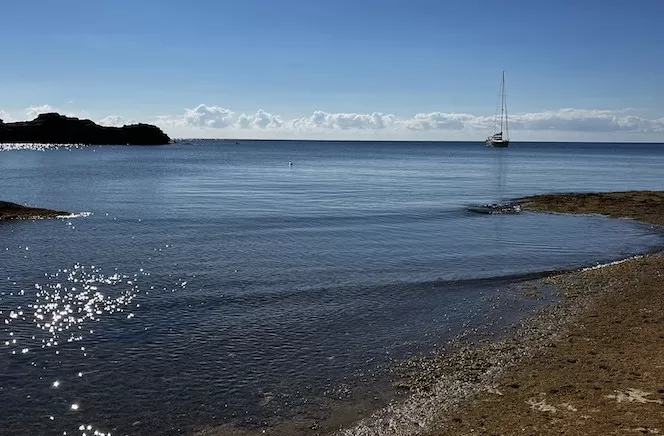
Weather in Malta in November: Travel Advice
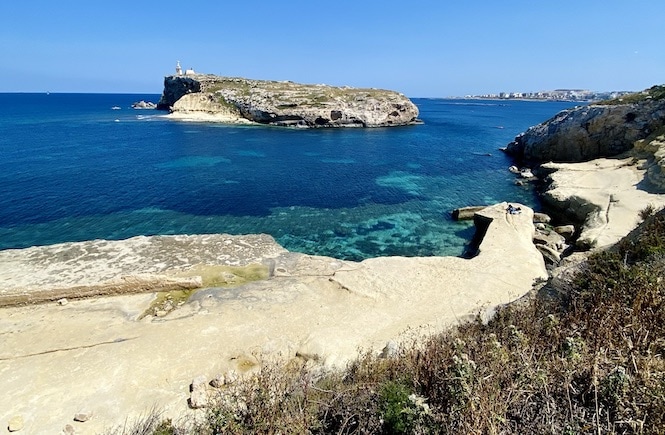
Why Should You Visit Malta Now and Experience the Mediterranean Magic
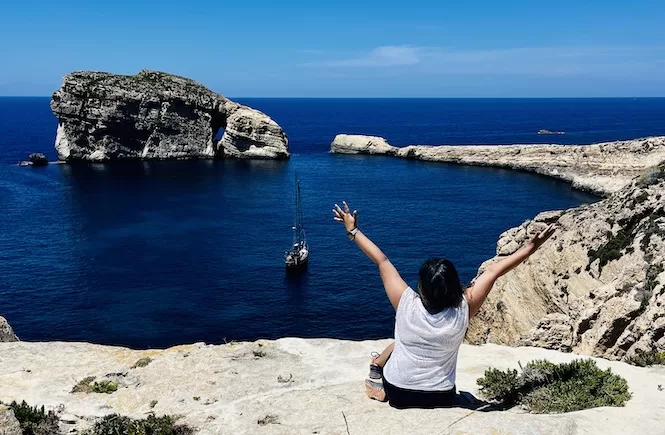
Malta Solo Travel: Safety and Local Advice
Leave a reply.
Your email address will not be published. Required fields are marked *
Tourism Malta : 21 things to Know Before Traveling
Considering a travel to Malta? Then, before you pack your bags, discover the essentials about this small island state. Useful and sometimes surprising information about the Mediterranean archipelago of Malta.
#1 Malta has two official languages, Maltese and English
Malta has two official languages : Maltese (Malti) and English .
Maltese (Malti) is the national language, spoken by nearly 83% of the population. English, on the other hand, is the language of business, commerce, and tourism, and is spoken by more than 90% of the population.
Malta was a part of the British Empire for 164 years ; hence, the English language has remained as one of the two official languages of the country.
Malta is thus one of the popular destinations for students wishing to learn English. Every year, nearly 52,000 students come to undertake an English language course in Malta .
#2 Malta is the smallest member state of the European Union
The total area of the Maltese islands is only 316 km² . The small Mediterranean archipelago, located just off Sicily, is therefore the smallest state in the European Union .
The largest of the islands, the main island, is also called Malta. It is only 27 km long and 15 km wide.
#3 Driving on the island is on the left
Another peculiarity inherited from the British occupation, cars drive on the left across all the islands of the archipelago. Therefore, the steering wheel is located on the right side of the cars.
Malta is also the second country in Europe in terms of the number of motor vehicles per inhabitant, after Luxembourg. The island is overloaded with more than 400,000 vehicles in circulation. Traffic in Malta is very dense, and drivers tend to drive fast. It is therefore necessary to be cautious when traveling by car, but also as a pedestrian when crossing the road.
#4 The capital of Malta is listed on the UNESCO World Heritage List
The capital of Malta, Valletta, has the distinction of being on the UNESCO World Heritage List since 1980.
Valletta is a fortified city named after the knight Jean de La Valette , Grand Master of the Order of Malta from 1557 to 1568 and hero of the Great Siege of Malta .
Jean de La Valette initiated the construction of the current capital of Malta on Mount Xiberras (now Valletta). He supervised the construction of monumental fortifications to protect the harbor from another Ottoman invasion.
Visiting Valletta is a must-do when traveling to Malta. Valletta is an open-air museum where every alley is steeped in history. Valletta has more than 320 monuments , including exceptional buildings like the St. John’s Co-Cathedral, the inns of the Order of Malta, Fort St. Elmo, the Manoel Theatre , etc.
Malta also has two other historical sites on the World Heritage List: the Ħal Saflieni Hypogeum and the seven Megalithic Temples of Malta .
#5 Malta is the least populous country in the European Union
With 542,051 inhabitants, Malta is the least populous country in the European Union . It is surpassed by Luxembourg with 640,000 inhabitants and Cyprus with 1.2 million inhabitants. However, Malta’s population has experienced a significant increase over the past ten years, growing by nearly 30%.
The population census in Malta should be taken with caution. Malta is both a highly touristy destination and popular with expatriates. Tourists in Malta for long stays, students enrolled in a language school , and many expatriates are not counted, which in reality significantly inflates the number of people actually present on the island.
#6 25% of Malta’s population is of foreign origin
Malta is one of the countries with the highest number of residents of foreign origin. In 2022, 25.3% of Malta’s residents are of foreign origin .
Among the nationalities of foreign nationals most present in Malta, there are residents of Italian origin (about 14,000 residents), residents of English origin (about 10,600 residents), residents of Indian origin (about 7,800 residents), and residents of Philippine origin (about 7,500 residents).
#7 The Euro is the official currency of the island
Malta joined the European Union on May 1, 2004 , and subsequently opted to join the Eurozone on January 1, 2008. The former Maltese lira was thus replaced by the Euro. The island state is part of the 19 member states of the eurozone, the common monetary area.
#8 Tap water in Malta is desalinated
The island’s natural water reserves are very low. The country contains no lakes, springs, or rivers within its territory, and the groundwater beneath the island is partly contaminated by seawater.
The only solution for the country to meet the growing needs of its residents and travelers is to desalinate seawater. Therefore, tap water comes from this desalination process. The tap water is potable but not very palatable because it is highly chlorinated. When traveling to Malta, it is strongly advised to only drink bottled water .
#9 Malta International Airport is not located in Valletta
Being an archipelago, the majority of travelers heading to Malta arrive by plane. However, contrary to popular belief, Malta’s airport is not located in Valletta. It is impossible to land an airplane in the middle of the fortified city’s walls.
The Malta Airport is located in the town of Luqa , in the center of the island and 8 km from the capital. So, when planning a trip to Malta, there’s no need to look for flights to Valletta.
#10 Malta has about 60 days of rain per year
The Mediterranean climate is one of the reasons for the success of trips to Malta. The weather in Malta is mild in winter and very warm in summer. Malta has less than 60 days of rain per year , compared to Paris, which has about 170 days of rain per year.
Summers in Malta are very hot and marked by the arrival of the Sirocco. This very dry Saharan wind causes the island’s temperatures to rise quickly from June. Rain is often absent throughout the summer on the archipelago. Winters, on the other hand, are relatively mild with a few rainy episodes. It is also possible to swim all year round in the archipelago, which pleases visitors traveling to Malta.
#11 Malta was occupied by the French
The small Mediterranean archipelago was for a long time a strategic point; the archipelago was the maritime lock of the Mediterranean, an archipelago that had to be conquered before any expansion.
Napoleon Bonaparte thus conquered Malta during a swift incursion en route to his Egyptian campaign. The island remained occupied by French troops from 1798 to 1800, before being handed over to the British Empire. The arrival of Napoleonic troops marked the exile and the end of the Knights of the Order of Malta .
While the British footprint is the most visible on the archipelago, French culture has long influenced the life of the island and is still very present. The two most emblematic masters who marked the Order of Malta and the country, Philippe de Villiers de L’Isle-Adam and Jean de Valette, were French .
#12 Catholicism is the state religion on the island
Malta is one of the most Catholic countries in the world , a legacy of the imprint of the Knights of the Order. The constitution of Malta allows for religious freedom; nevertheless, Catholicism has been enshrined as the state religion.
Currently, 82.6% of the Maltese population is Catholic . Islam, Orthodoxy, and other religions are practiced by about 12.3% of Malta’s inhabitants, while 5.1% are atheists. The percentage of Catholics has significantly dropped in recent years from previously 95%, a decline largely due to the massive immigration in recent years to the archipelago.
Churches have been erected in every corner of the archipelago. A popular saying goes that there are more churches in Malta than days in the year. Indeed, Malta has more than 365 churches and chapels, as well as four cathedrals (St. John’s Co-Cathedral, St. Paul’s Pro-Cathedral, St. Peter and St. Paul’s Cathedral in Mdina, and the Cathedral of the Assumption in Gozo).
This unique concentration of religious buildings was erected during the years of domination by the Order of Malta.
#13 St Paul’s Bay is the most populous city on the island
St Paul’s Bay, with over 32,000 residents, is the most populous city in Malta. It now surpasses the cities of Birkirkara, Mosta, Sliema, and even St Julian’s.
Valletta, with fewer than 6,000 residents, is far behind; the capital has been becoming more deserted year by year.
#14 Malta is the country with the highest population density in Europe
The island of Malta, with a population exceeding half a million inhabitants for an area of only 316 km², is one of the countries with the highest population density in the world.
With a density of 1,649 inhabitants per km² , Malta is among the top 10 most densely populated countries in the world.
#15 The Maltese archipelago consists of eight islands
The Maltese archipelago is officially made up of eight islands.
Four islands of Malta are inhabited
The four inhabited islands of Malta are: Malta (as the main island), Gozo, Comino, and Manoel Island. Comino and Manoel do not really have residents but rather keepers. Manoel Island can also be considered a peninsula, as it is connected to the town of Gżira by a bridge.
Four islands of Malta are uninhabited
The four uninhabited islands of Malta are: Cominotto (Kemmunett), Filfla, and the two St. Paul’s Islands. The two St. Paul’s Islands are separated by a narrow sea channel of only a few meters.
#16 The metric system is used in Malta
The influence of the former belonging to the British empire is still very much visible on the island, however, Malta adopted the standardized metric system as early as 1972 .
Distances are therefore expressed in meters (not yards) and kilometers (not miles). Speed is also expressed in kilometers per hour. Weight is expressed in grams or kilograms and liquids in liters.
#17 Malta is a prime destination for travelers interested in prehistory
The Maltese archipelago is a European benchmark for its prehistoric sites , an aspect often unknown to tourists who travel to Malta.
The island contains several exceptional megalithic sites. Seventeen sites are listed, comprising thirty-three megalithic temples built during the Neolithic period between 5200 and 2500 BC .
The temples of Ħaġar Qim, Ġgantija, and Tarxien are among the most visited archaeological sites.
#18 Each year, several million tourists make a trip to Malta
Malta has become a popular tourist destination in Europe. In the span of 10 years, tourism has doubled on the island. Each year, nearly 2.9 million visitors arrive in Malta , drawn by its seaside, landscapes, a few sandy beaches, and its history.
Tourist activity on the island is today both one of the primary economic resources and the main structural challenge for local authorities.
The arrival of mass tourism has radically changed life on the island and now opens many questions about resource management, as well as the ecological and environmental preservation of the island.
#19 Malta is the European country with the highest number of obese individuals
A sad record, Malta is the country in Europe with the highest obesity rate .
Obesity in Malta affects 28.7% of those over 18 and has become a serious public health problem. Obesity in Malta costs the state between 36 and 56 million euros each year, according to PwC.
#20 Abortion is prohibited in Malta
Malta is the most conservative country in the European Union on the subject of abortion. Abortion in Malta is strictly prohibited , even in cases of rape, fetal abnormality, or even if the mother’s life is at risk.
The law in Malta on abortion or voluntary termination of pregnancy (VTP) is the strictest in Europe. Abortion in Malta is illegal; it is a crime punishable by three years in prison. The inhabitants of Malta, still very attached to conservative Christian values, consider abortion a taboo subject.
#21 The motto of Malta is “Courage and Constancy”
The national motto of Malta is “Virtute et Constantia” , translated as “Courage and Constancy” . The Maltese flag, meanwhile, bears the inscription “For Gallantry”, which means “for bravery”.
Frequently Asked Questions by Visitors Traveling to Malta (FAQ)
What is the spoken language in malta.
English and Maltese are the two spoken languages in Malta . English is the most widely used language in everyday life on the island (shops, hotels, restaurants, etc.).
How many visitors travel to Malta each year?
Every year, the archipelago of Malta welcomes close to 2.9 million tourists. However, the year 2020 saw a decline due to the global Coronavirus (Covid-19) pandemic.
What is the motto of Malta?
Malta has retained from its chivalric past the motto “Virtute et Constantia” , which translates to “Courage and Constancy”.
Are there any do’s and don’ts when traveling to Malta?
Certain precautions should be taken before traveling to Malta. The archipelago has its customs, and Maltese people are also very attached to Christian traditions, so some behaviors should be avoided. Check the dedicated article 11 tips before traveling to Malta , for a trip to Malta.
Why is abortion prohibited in Malta?
82.6% of the Maltese population is Christian, and nearly 85% of native Maltese are practitioners. Due to religious and cultural heritage, abortion is still prohibited in Malta. Voluntary termination of pregnancy is illegal and punishable by 3 years of imprisonment.
What is the currency used in Malta?
Malta is one of the 19 countries of the eurozone. Therefore, the euro is the currency used throughout the archipelago.
Find Your Way Around

How to get there
Send by e-mail, latest news.

What to see
Caravaggio's masterpiece.
The Beheading of St. John the Baptist is considered by many as Caravaggio’s masterpiece.
From the Outside Looking in
Somebody once said that an island can only be called such when viewed from the sea. A cruise will show you Malta from a different angle.
Secrets of the Manoel Theatre
The Manoel Theatre is an architectural gem. Discover its history by taking a guided tour of the auditorium, backstage and museum.

Gozo - Island of Legends
Gozo, meaning 'joy' in Castilian, is the second largest Island of the Maltese archipelago. With its relaxed pace of life, Gozo is the ideal getaway.

Malta - Sunny and Safe
Malta, Gozo and Comino have been preparing to ensure that your next stay on the islands is pleasant, rewarding and safe.

Where to go
Marsaxlokk - catch of the day.
Marsaxlokk Bay is Malta's second largest natural harbour. It is the best place to see the colourful, traditional Maltese fishing boats - the Luzzus.
The Mysterious Hypogeum
The Hypogeum is a unique monument recognised with an individual listing on the UNESCO list of World Heritage Sites.
Some Place Different
Discover the EDEN Destinations in Malta and Gozo
Calendar of Events

MAN UTD & MALTA
More than a partnership, visitmalta+, your holiday mobile app, quality assured, the mark of quality, did you know..., the maltese cross, social media.
Visit Malta
Welcome to VisitMalta dot com.
In this website you will find everything you need to know about the Maltese Islands . What to see, what to do, where to go, and many other things that make Malta, Gozo and Comino the ideal holiday destination.
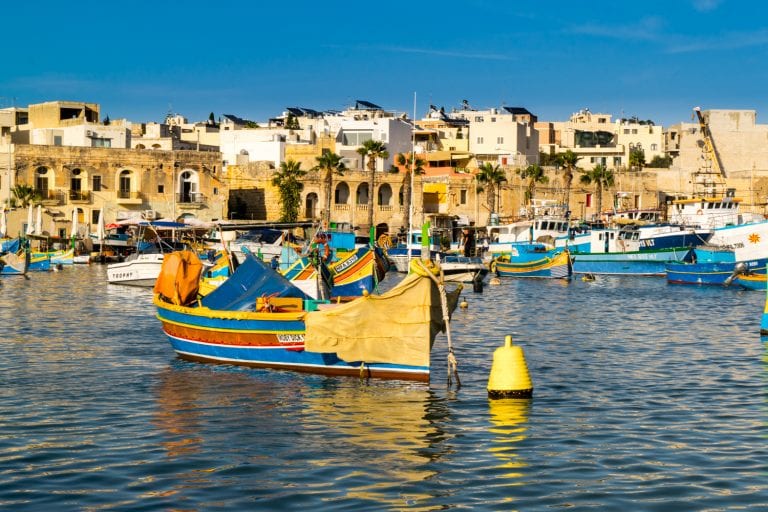
Your Quick Malta Travel Guide (What to Do, Where to Stay + Tips!)
As Europe’s smallest island nation, Malta doesn’t traditionally get a lot of tourist attention from visitors outside of Europe–but that is changing, and this quick Malta travel guide will help you discover this unique Meditteranean country.
… and hopefully, convince you that planning a trip to Malta is a great idea!
Though it is regularly overshadowed by heavy hitters like popular Italy, Spain, Greece, and Croatia , there is no doubt that Malta has a charm all its own.
Boasting warm temperatures and sunshine well into autumn, Malta is one of the best fall destinations in Europe –which is why we chose to visit in September!
Regardless of what time of year you visit, though, you’re bound to find something to love about Malta.
Thinking about planning a trip to Malta soon?
This quick Malta travel guide will get your plans started!
Table of Contents
Essential Things to Know About Malta
Fun things to do in malta, where to stay when visiting malta, getting around malta, what to pack for malta, read more about visiting malta + southern europe.
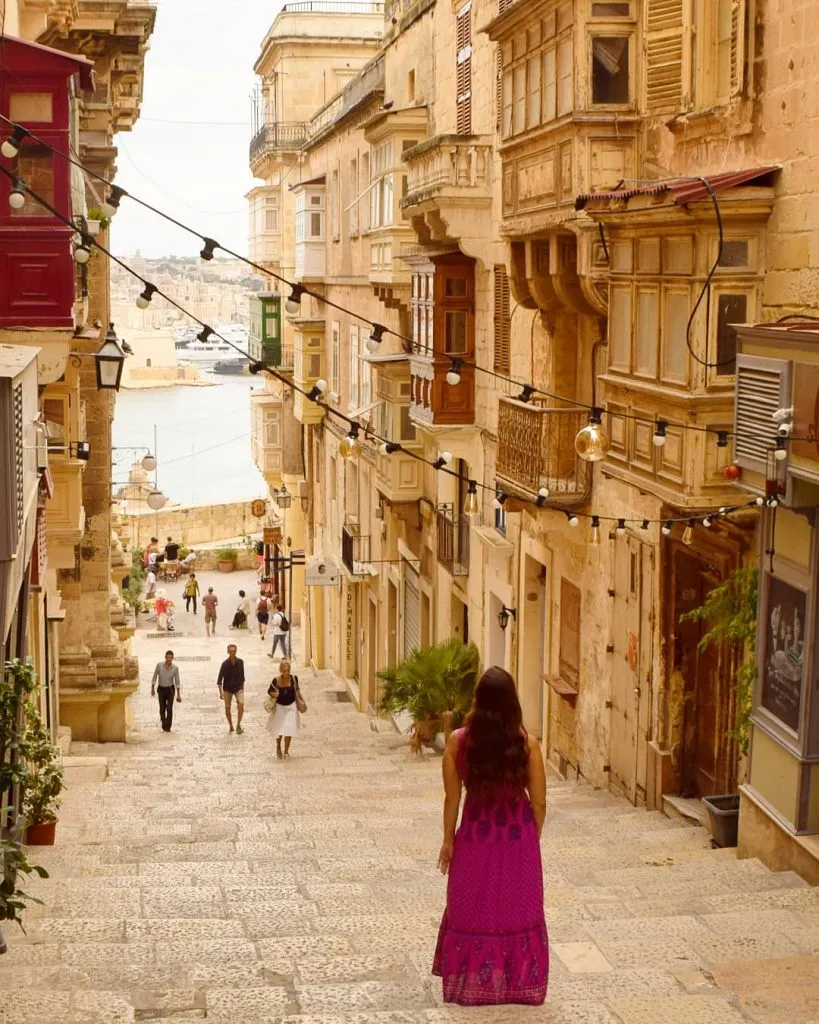
Some links in this post may be affiliate links. If you make a purchase through one of these links, we may earn a small commission at no extra cost to you. Please see our disclosure policy for more detail.
Before you arrive, make sure you know a few things about Malta !
Malta uses the Euro.
We also found credit cards to be widely accepted, and ATMs were easy to locate.
You may not want to drink the water.
While online sources say that the water is technically safe to drink, we did not like the way it tasted (in fact, we’d say it’s probably to worst tasting water we’ve come across in our travels).
We drank it anyway for the first couple of days, but after several locals emphatically told us not to drink it (they seemed a bit horrified that we were drinking it in the first place) and my stomach started to protest a bit, we switched to bottled.
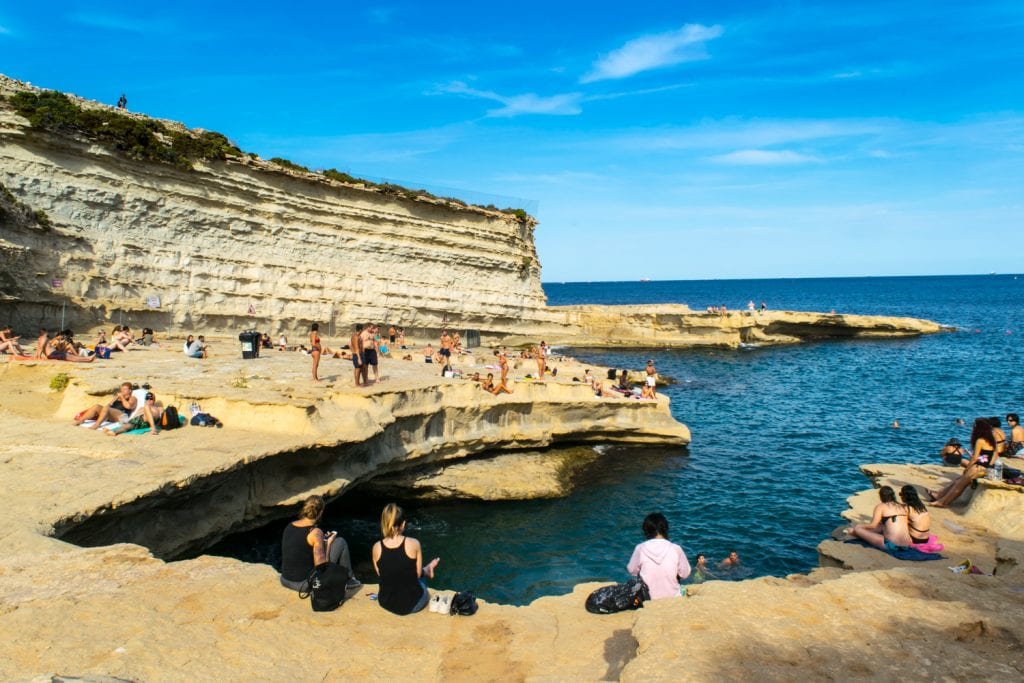
In Malta, you drive on the left.
… And not only on the left, but they also drove in a way that felt quite reckless to us.
Malta has an enormous amount of traffic jams considering its size and watching the cars weave quickly in between lanes and the aggression of the drivers, we were glad we opted not to drive.
If you’re planning to rent a car in Malta , be sure to come prepared for a driving experience that will require all of your concentration!
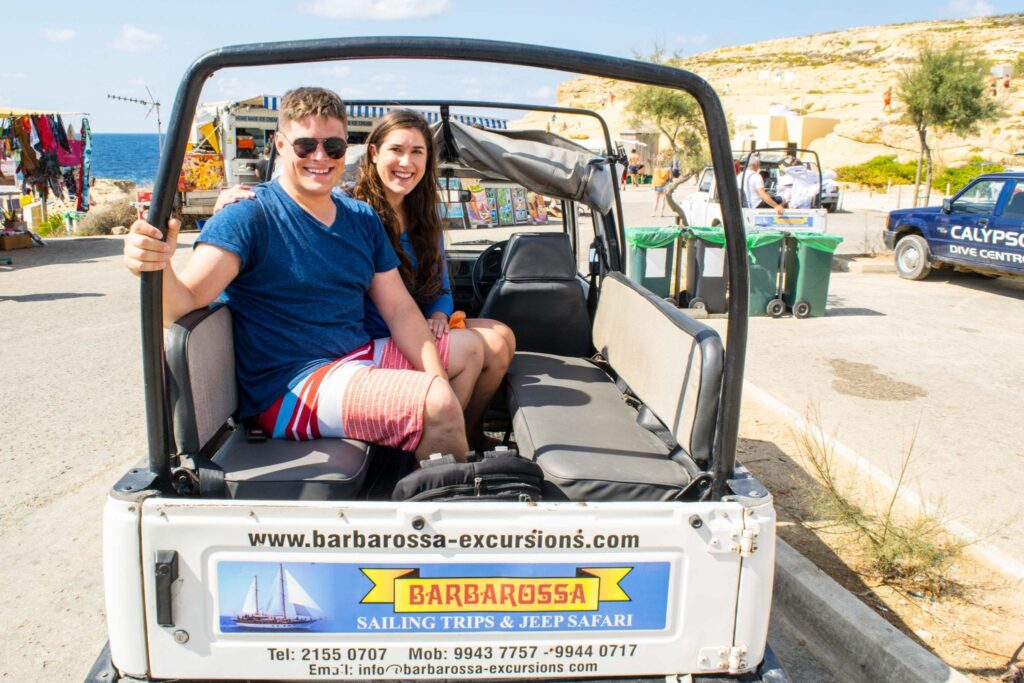
English is one of the official languages of Malta.
The other one is Maltese, though no one expects visitors to speak it.
Italian is also widely spoken, especially among the older generation.
Malta is a former British colony.
This is no surprise to Brits, of course, but Americans like us may be taken by surprise–if they haven’t watched The Crown , anyway.
Malta gained independence in 1964 from the United Kingdom in 1964.
The British weren’t Malta’s first colonizers, though: as a small island conveniently located between northern Africa and southern Europe, Malta has been visited by (and ruled over) by just about everyone over the centuries, including the Romans and Byzantines.
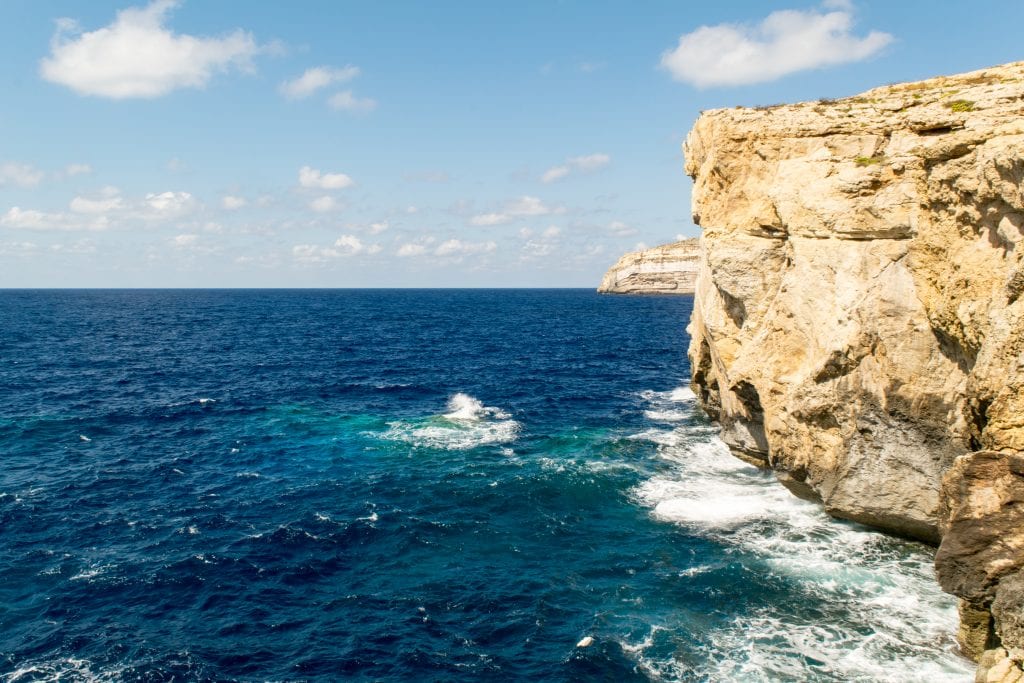
Malta is the name of both an island and a country.
Malta is both the name of the largest island in the country, as well as the country itself.
Malta the country, though, is actually an archipelago.
Gozo (home to some villages and sites, and once the famous Azure Window), and Comino (home to three people and the famous Blue Lagoon) are the other two islands that make up the country of Malta.
Comino is fairly small and the Blue Lagoon is essentially its only claim to fame, but there are lots of cool things to do on Gozo, starting with visiting the Citadel, admiring the Wied il-Mielah Sea Arch, stopping by the Marsalforn Salt Pans, and of course, relaxing on the gorgeous Ramla Beach.
We visited several of the best places to visit on Comino and Gozo (including the Blue Lagoon!) on this memorable day trip .
Book your cruise around Gozo and Comino today!
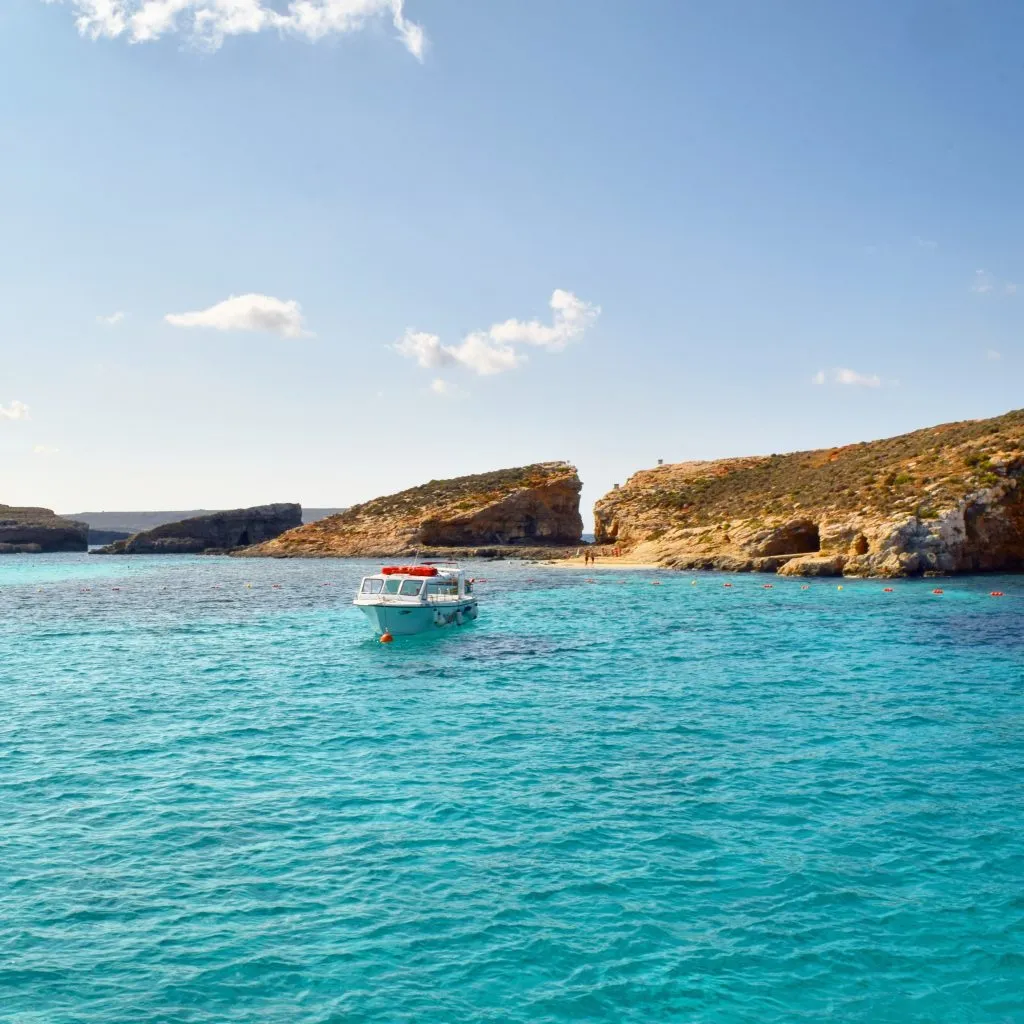
If you’re looking for ideas on what to do in Malta, consider scuba diving , sailing, swimming in the famous Blue Lagoon, visiting the Hagar Qim Temples that date back to 3600 — 3200 BCE, touring the nearby island of Gozo, visiting the beautiful Blue Grotto caves, strolling through the “silent city” of Mdina , and enjoying the beautiful beaches. .. just to start with!
No trip to Malta is complete without spending time in the capital city of Valletta, admiring the views from the Upper Barrakka Gardens, a cruise over to the Three Cities for views, and a visit to the colorful Marsaxlokk fishing village!
Even a full week in Malta won’t cover everything there is to do, but it will be sure to give you an excellent taste of the country.
We’ve rounded up the best things to do in Malta here !
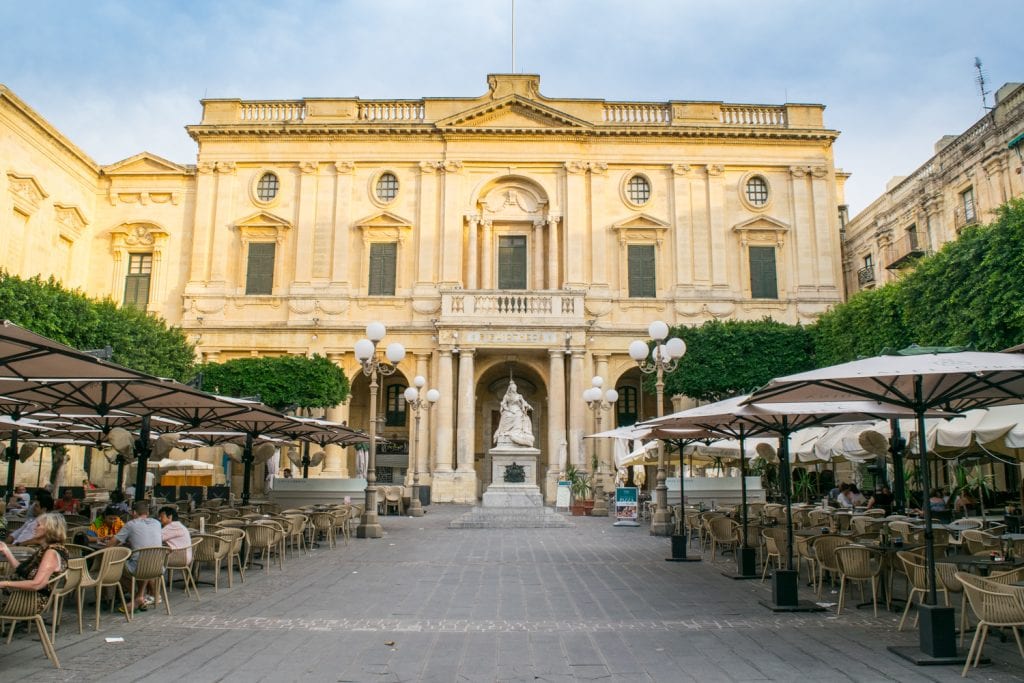
While on Malta, we stayed at Central Suites in the town of Bugibba near St. Paul’s Bay, which is semi-conveniently located for accessing Gozo and Comino (the island that the Blue Lagoon is next to), but not convenient for much else.
We enjoyed the neighborhood we were in, but wouldn’t stay there again because it is so far out of the way!
If we return to Malta, we will stay in Valletta , which is not only the capital (and home to a central bus station that makes it simple to get everywhere you want to visit in Malta ), but was also our favorite city that we saw in Malta–it was home to lovely sites, lots of restaurant options, and, in our totally biased opinion, it was the prettiest!
Checking into a property like the well-reviewed Melior Boutique Hotel or Hotel Pjazza Merkanti would be at the top of our list.
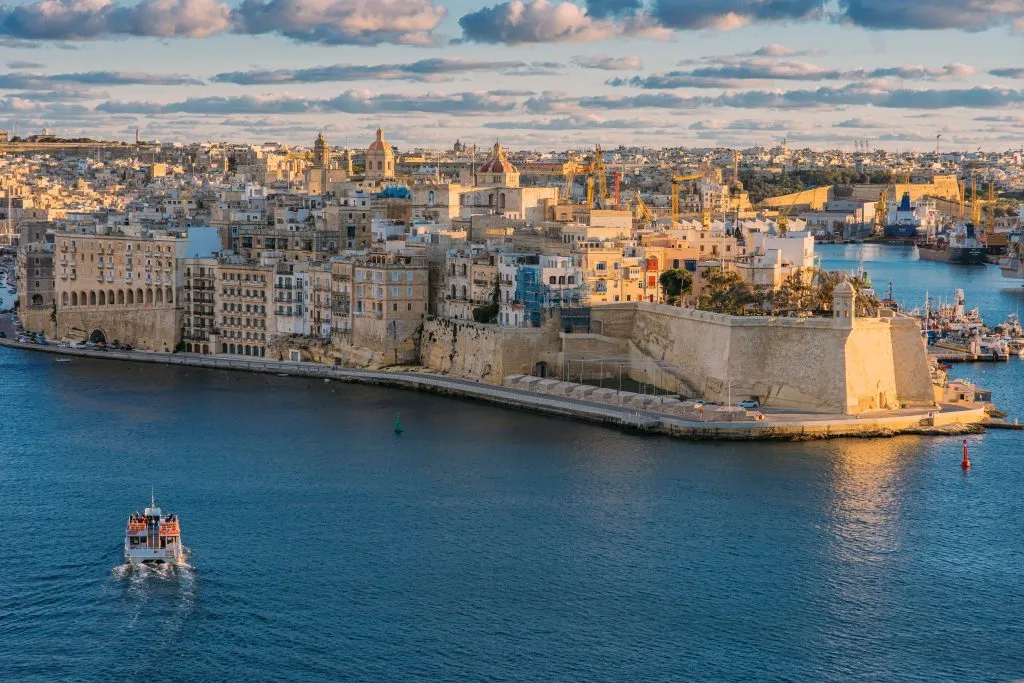
… Or, if we felt like a splurge, perhaps the gorgeous Embassy Valletta Hotel –those views are incredibly tempting!
Sliema is very close to Valletta (there’s a short water taxi that goes between them) and is another option worth considering.
St. Julian’s Bay is near Valletta and Sliema as well and is popular with travelers looking for nightlife.
We would not recommend staying in Marsaxlokk .
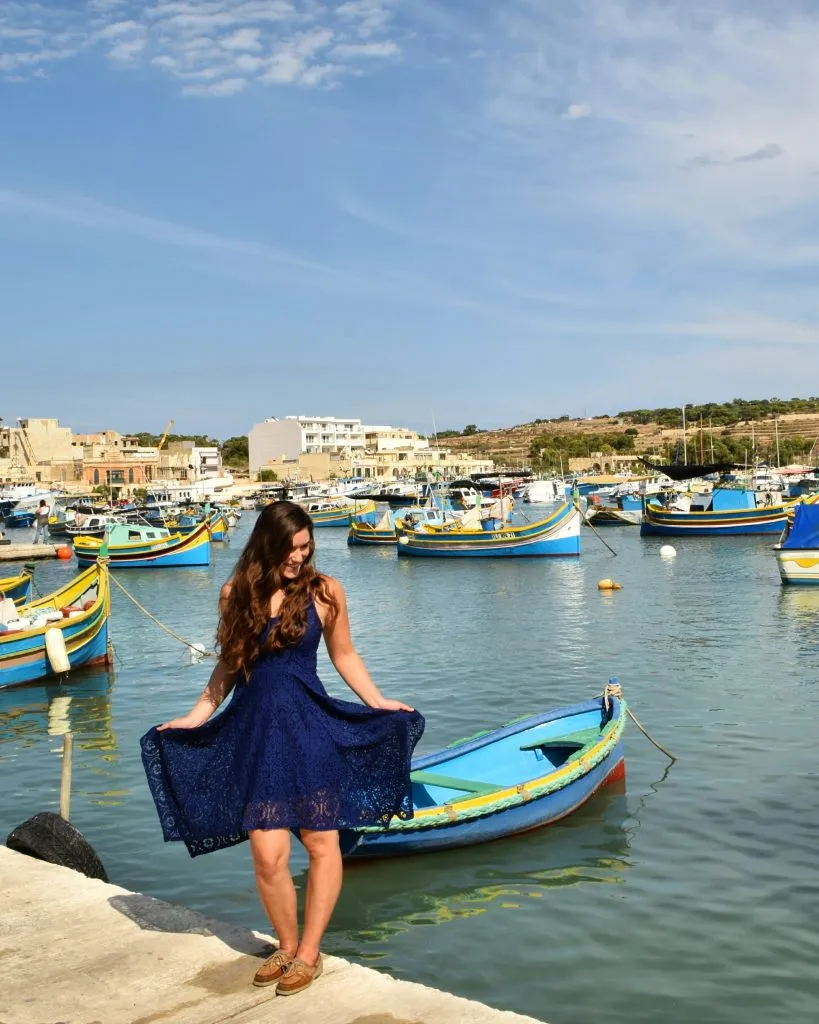
T he fishing village is adorable and cute to visit for a day , but it is small and remotely placed from the rest of the island –you’ll eat up way too much time in transportation by staying there!
If you’d like a different, quiet experience in Malta, consider staying on the island of Gozo or eve n Comino (there are only three full-time residents on Comino, and they run a hotel during the summer!).
Keep in mind that this plan isn’t for people who want to easily access Malta’s most famous attractions, but it can be great for travelers who are looking to step off the beaten path and/or spend lots of time on the water.
Check rates & book your stay in Malta today!
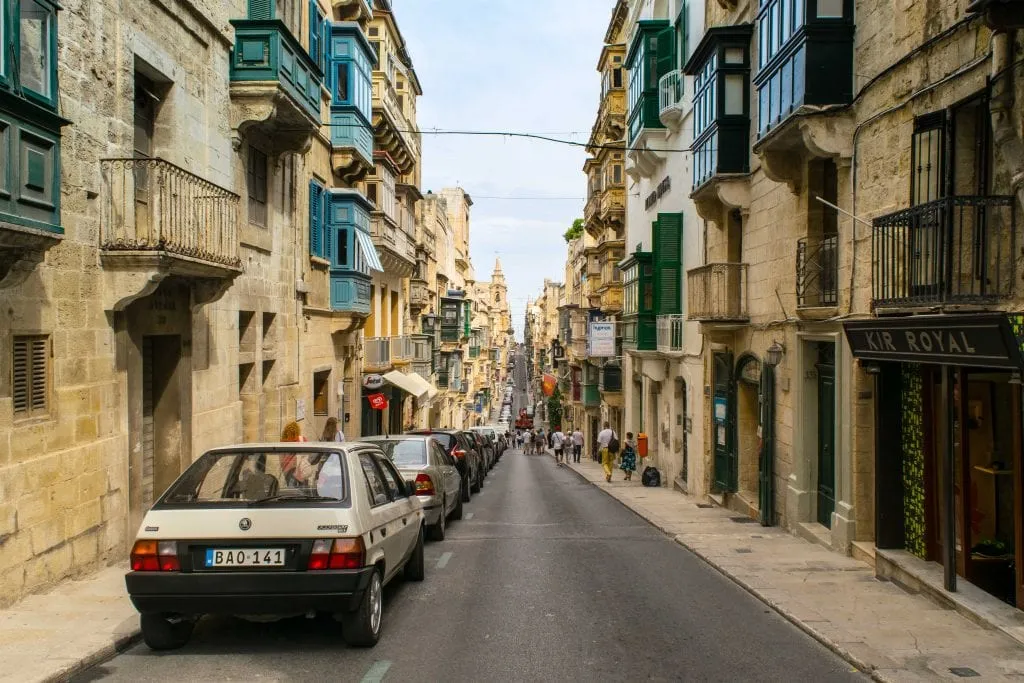
Don’t be fooled by Malta’s small size!
N o matter where you stay in Malta, you’re going to be faced with some significant time on the road to get between major destinations–often more than an hour each way.
Though you can rent a car , if you’re not a confident driver in heavy traffic and/or on the left side of the road, we would recommend using Malta’s incredibly extensive bus system to save money, stress, and fossil fuels!
The bus will get you virtually anywhere you need to go on the island of Malta.
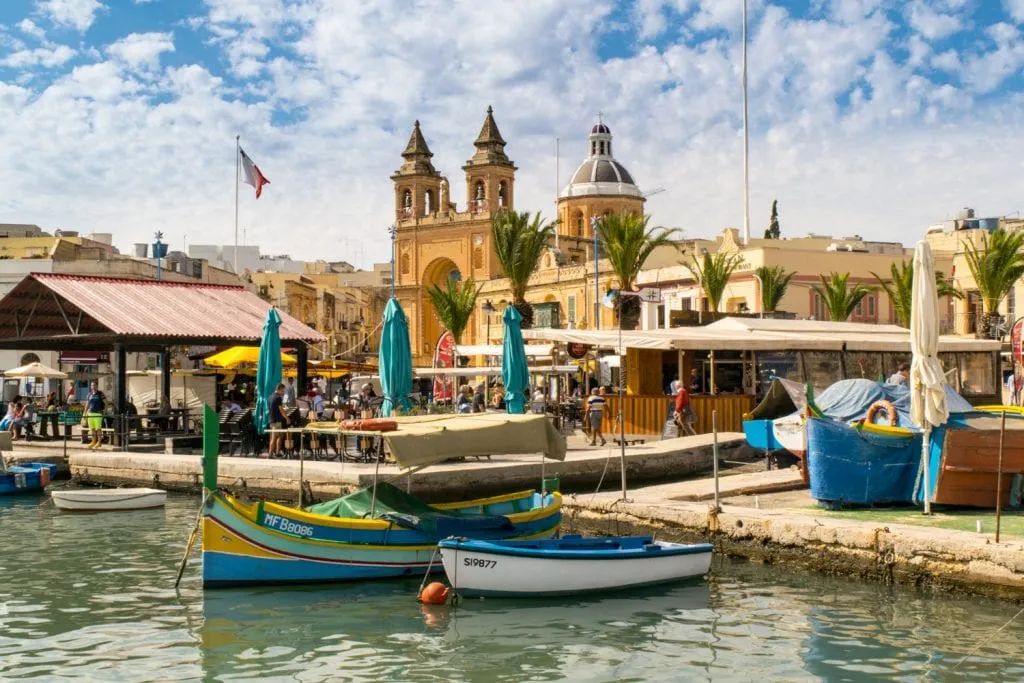
For 21 Euros, you can buy a seven-day unlimited travel pass for Malta’s bus system.
Standalone, one-way tickets are 2 Euros in the summer, 1.50 Euros in the winter, and 3.00 Euros for night journeys and express buses.
You can check bus schedules and keep up with routes on Malta’s free transportation app, the Tallinja App .
We used the app some but actually found Google Maps to be more useful for getting around Malta.
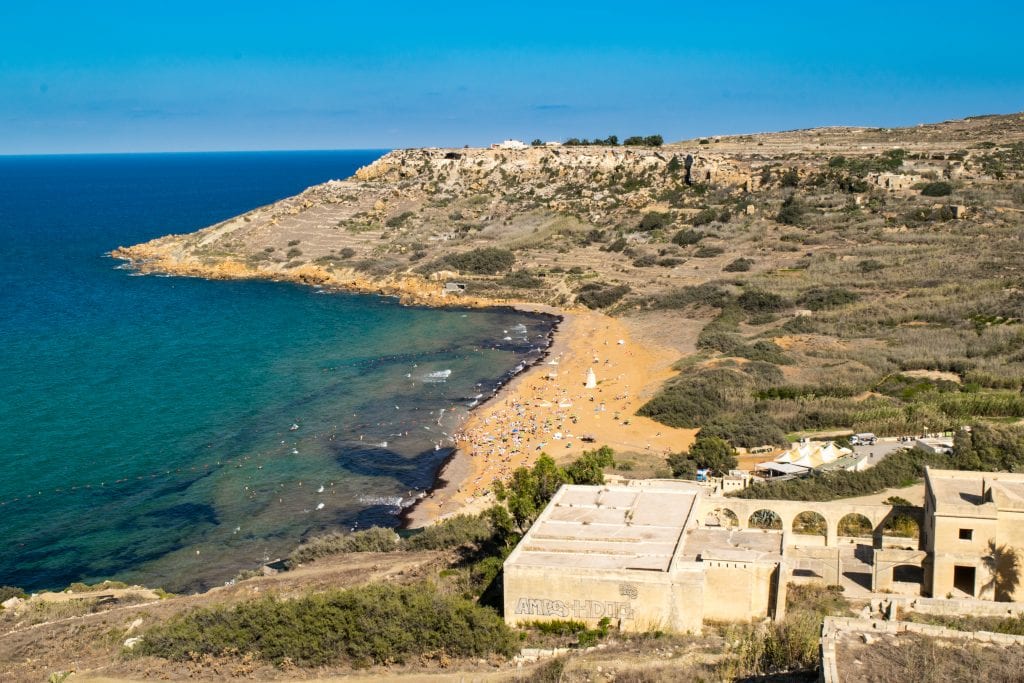
An EU SIM Card : Having access to Google Maps in real-time was a must when dealing with managing bus schedules across the island.
You can pick these up when you arrive in the country–we used the one we had picked up in Prague .
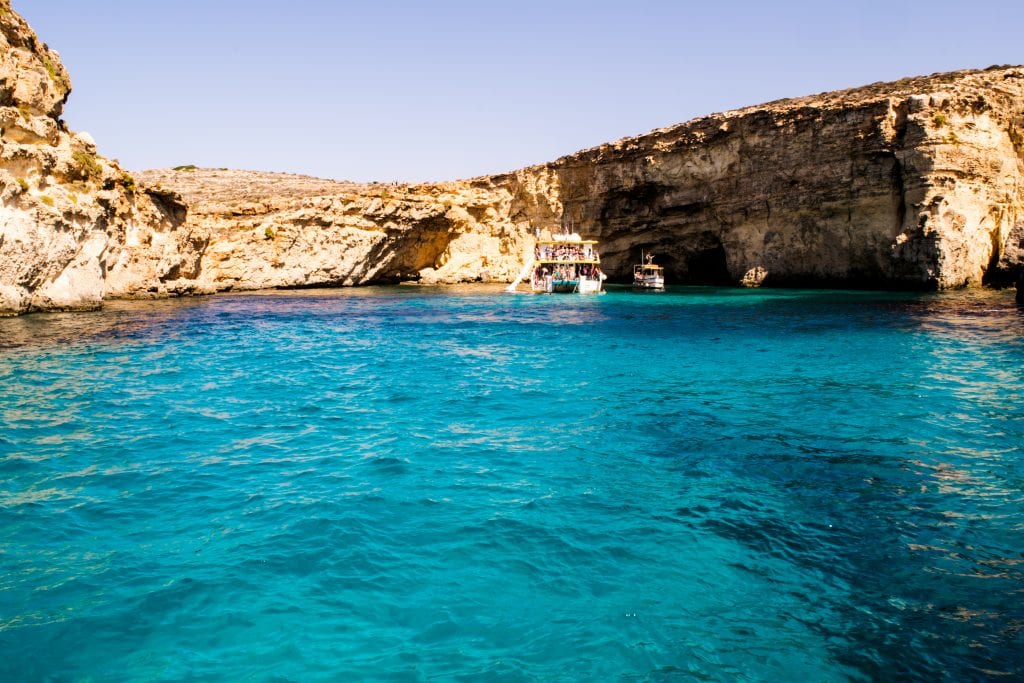
Malta may be a small country, but this Mediterranean island nation definitely doesn’t deserve to be overlooked.
Plan a trip to Malta and you’ll be rewarded with beautiful views, a chance to learn about some incredible history, and a great excuse for some fun in the sun!
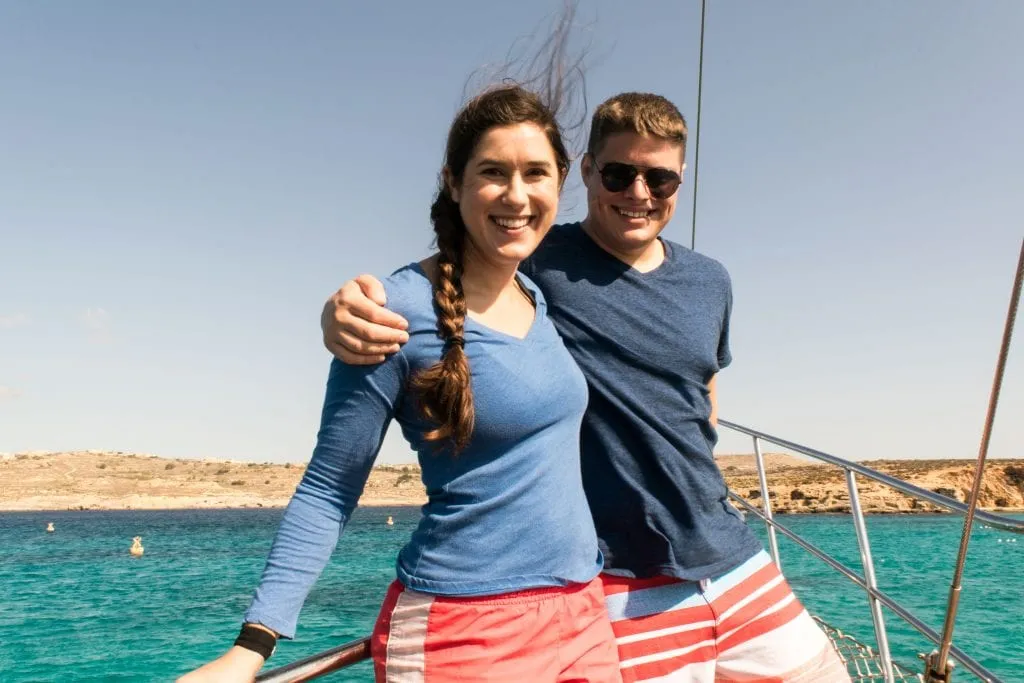
Ready to plan a trip to Europe… and maybe several other sunny destinations?
If so, be sure to check out these guides, too!
- 11 Marvelous Things to Do in Malta in September
- The Perfect 7 Day Puglia Road Trip Itinerary
- 33 Fun Things to Do in Dubrovnik, Croatia
- The Perfect 2 Week Spain and Portugal Itinerary (+ Essential Tips!)
- The Ultimate 3 Days in Santorini Itinerary
[convertkit form=3127238]
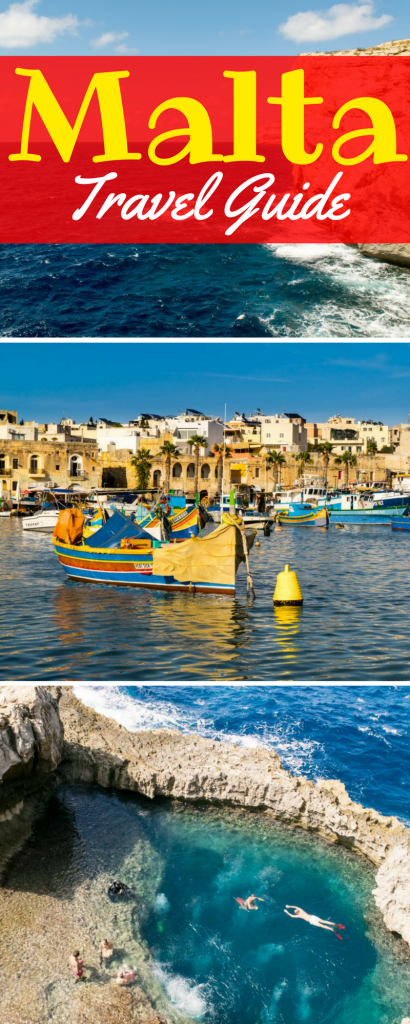
About Kate Storm

In May 2016, I left my suburban life in the USA and became a full-time traveler. Since then, I have visited 50+ countries on 5 continents and lived in Portugal, developing a special love of traveling in Europe (especially Italy) along the way. Today, along with my husband Jeremy and dog Ranger, I’m working toward my eventual goal of splitting my life between Europe and the USA.
29 thoughts on “Your Quick Malta Travel Guide (What to Do, Where to Stay + Tips!)”
Love these tips! I’ve been wanting to visit Malta for quite some time! I had no idea they drive on the left, that’s interesting to note. Looks like a really fun place for a long weekend getaway!
Thanks! Definitely a great getaway, especially if you are craving sunshine as much as we were! 🙂
Malta hasn’t been on our radar, but your photos are lovely! And good to know that English is one of their national languages and that they use the Euro!
Thanks! Malta is definitely in the process of trying to raise its tourism profile–and for good reason, in our opinion!
I’d love to visit Malta, especially as I’m in Sicily quite often. Gozo sounds like my kind of place, just the island life. You were brave to drink the tap water there; I always stick to bottled!
Brave, reckless… tomato, tomato, right? 😉
I had no idea that Malta was technically an archipelago. It’s such a beautiful place and where I’d love to snorkel and scuba dive. I love how rich a history that is in Malta. I’d love to discover it’s hidden stories!
I didn’t either! Truthfully, we knew very little about it at all–made for a memorable trip that way, though!
Malta and the architecture of the buildings there is simply astonishing. I am definitely adding this awesome travel destination to my bucket list! How many days would be enough to see all the highlights there?
The architecture is incredible! I love all the enclosed balconies. I think you could probably see all the highlights in 5-7 days if you move fast… we were there for 5 full days and got through about 70% of them, though we tend to check things off rather slowly these days. The biggest thing is planning out your schedule well to limit transportation time!
I LOVE this post!! I have been seeing Malta all over Instagram and have been interested in going but most of this was new to me. They drive on the left side? English is the official language? It’s an archipelago? So interesting!! This made me want to visit even more, so thanks for sharing! It’s officially on my list.
Thanks, Christie! Hope you get a chance to go. Malta has definitely been popping up more and more on Instagram et al. this year–it’s easy to see why, it is quite photogenic along the coasts!
Bookmarked!!! One of the places I’m dying to visit is Malta. Stunning pictures and I loved it.
Thanks, Jaypee!
I am surprised to know the water of Malta is not good to be consumed by an outsider ! Also, it is good to know English is one of the official languages, that saves a lot of stress in communicating. The 21 Euro seven day unlimited travel pass sounds like a budget way to travel within the country!
We were, too–it didn’t even occur to us not to drink it at first! A couple of locals we talked to were mildly horrified when they heard we were drinking it.
Malta has been making all the right news off late. I love traveling to offbeat places like this one. Despite the small size, there is so much to se/do/eat in Malta. One of my facebook friend lives in Malta. Hope to visit her soon. You shared some really useful tips since not much is known about Malta.
It definitely has been! Malta is still a bit offbeat for now, but I’m not sure how long it will stay that way. Hope you get a chance to go!
What a great guide of Malta! The water fact definitely surprised me, I thought this was only a rule for places like India or countries in Africa. Good to know! Also, the architecture is something to die for. You captured the true essence of this paradise! Thank you for sharing. All best, Mariella
Thanks, Mariella! Hope you get a chance to visit soon! 🙂
Ahh I loved Malta so much! Such an absolutely beautiful country! I want to go back so bad next year if I have time
Hope to get to go back, Dave!! 🙂
Fantastic tips, everything i needed to know before hand, and now 100% convinced that i have to go! Thank you so much!
Thanks, Ericka! Hope you have an amazing trip!
Hi Jeremy and Kate,
I’m glad you chose to visit our gem of a country! Malta has a lot to offer, hospitality is in the genes of most people… and lots to offer in terms of history and attractions. Every where we dig here underground temples and very important discoveries are made :0
Take care and hope to see you soon in Malta.
Thanks a lot, Kate Storm for an amazing presentation of a real jewel !!!
Most certainly, I will be there in coming October.
Your Briefing is quite Decent and Comprehensive !!!!
Thank you, Ateeque!
A reminder to make a booking first for some of the temples. Also the ferry from Gozo and Valetta is limited in the off season January and February. A return ticket is essential. Valletta is definitely the place to stay. 5 unesco sites and one of the best archaeological museums I have seen. I have to say it’s not inexpensive. Meals are pricey accommodation even in the low season. bus trips are plentiful and buying a travel pass is the way to go.
Thanks for sharing, Jenny!
Leave a Comment Cancel reply

Malta Travel Tips (Complete Guide To Planning Your Holiday)
By: Author Tracy Collins
Posted on Last updated: August 21, 2023
Considering a trip to the beautiful island of Malta? Read on for our top Malta tips and everything you need to know to plan your perfect sunshine break in the Med.
Malta. A Mediterranean island archipelago that I guarantee will both charm and delight you.
After visiting Malta 5 times over the past 17 years I have come to know the island (and its smaller neighbouring islands of Gozo and Comino) well.
When I first visited Malta in 2002 it was relatively unknown as a tourist destination. As a popular holiday and retirement destination for the British population it seemed to have slipped under the international tourist radar.
Over the last 10 years however the number of visitors to Malta has nearly doubled from 1.2 to 2.3 million. Not bad for an island with a population of just over 460 thousand and indicative of its growing popularity as a top Mediterranean holiday destination.
Valletta, Malta’s capital and European Capital of Culture in 2018 is a city full of character and history. Due to its the magnificent harbour and central location it is a favourite port for the many cruise ships that sail the Mediterranean. It is also growing in popularity amongst Europeans seeking winter sun or an easily accessible weekend getaway.
If you are one of the millions of visitors planning to visit Malta soon this post will give you some travel tips worth knowing before you arrive.
After 5 visits my top Malta travel tips and advice to ensure you have a fantastic holiday.
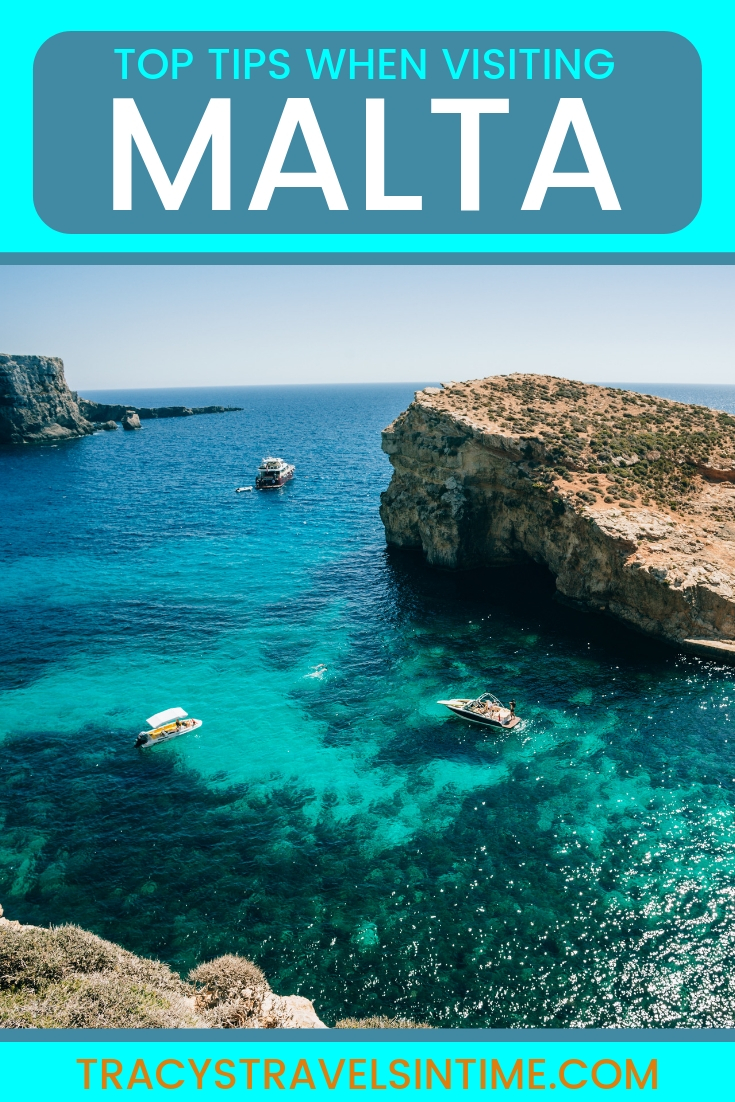
Some basic facts to know about the Maltese Islands
By hop-on and hop-off bus, best tours and day trips to do in malta, what are the traditional foods on malta and gozo, where are the best beaches on the maltese islands, what are festas and when are they held, the south of the island – marsaskala or marsaxlokk, resort area north of valletta – sliema, st julians and paceville, the north of the island – bugibba, qawra and st pauls and mellieha, where are the best markets to visit in malta, what souvenirs should i buy on malta.
- There are actually 21 islands that make up the Maltese archipelago. Malta is the largest of the 3 main islands. At only 27 kms long and 14.5 kms wide it is the smallest country in the European Union and tenth smallest in the world.
- Do not assume however that Malta is an island you can drive around quickly. The roads are congested and many are in quite a poor condition.
- As well as being one of the world’s smallest countries Malta is also one of the most densely populated (and add a few million visitors to that mix and it can get rather busy!)
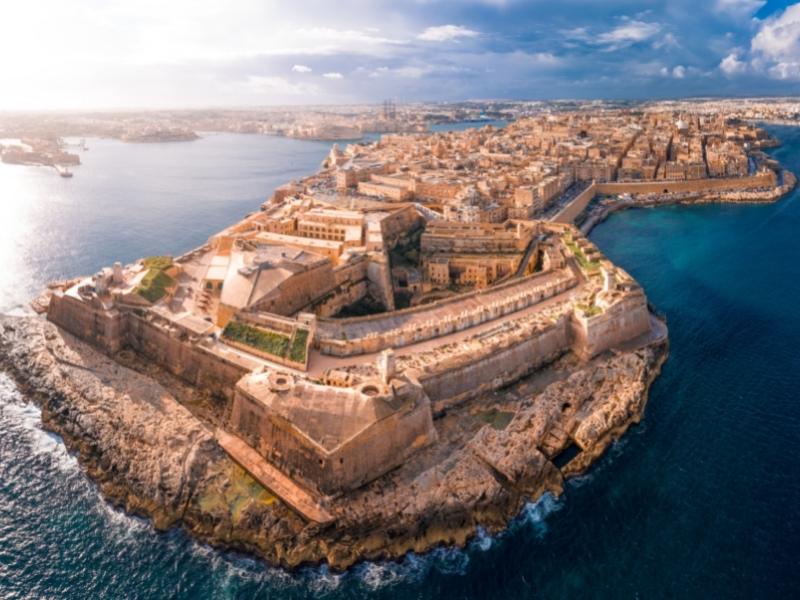
- The name ‘Malta’ is believed to derive from the Greek word for honey.
- Malta was part of the British Empire for 150 years and gained independence on September 21st 1964.
- The entire population of Malta were awarded the George Cross by King George V for their bravery during World War II.
- Gozo is Malta’s smaller sister though only 20 minutes away by ferry.
- Comino is the tiny island sandwiched between the 2! Comino has only 4 residents and is also the location of the fabled Blue Lagoon and lesser-known Crystal Lagoon.
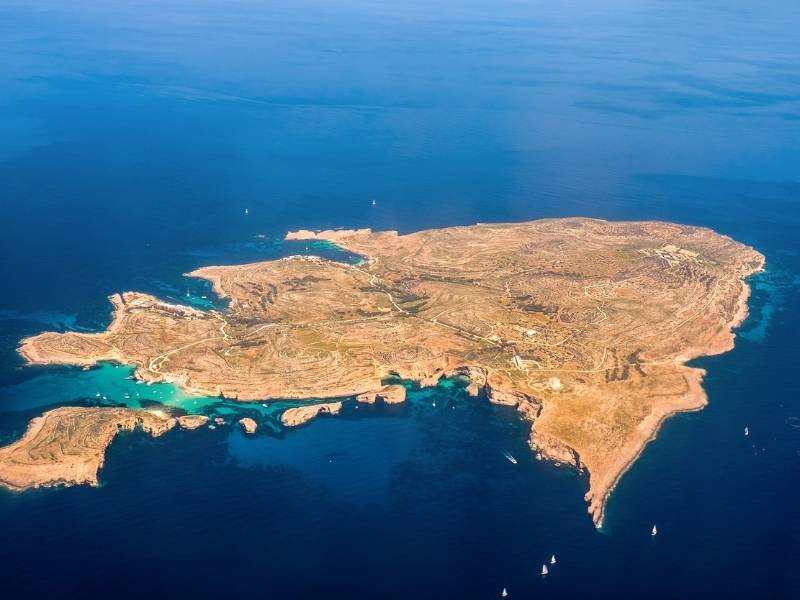
- The main languages spoken on the islands are Maltese and English.
- The Euro is the unit of currency.
- The main airline is Air Malta.
- Victoria, the capital of Gozo, is also known as Rabat.
- There are 3 UNESCO World Heritage Sites on the Maltese Islands.
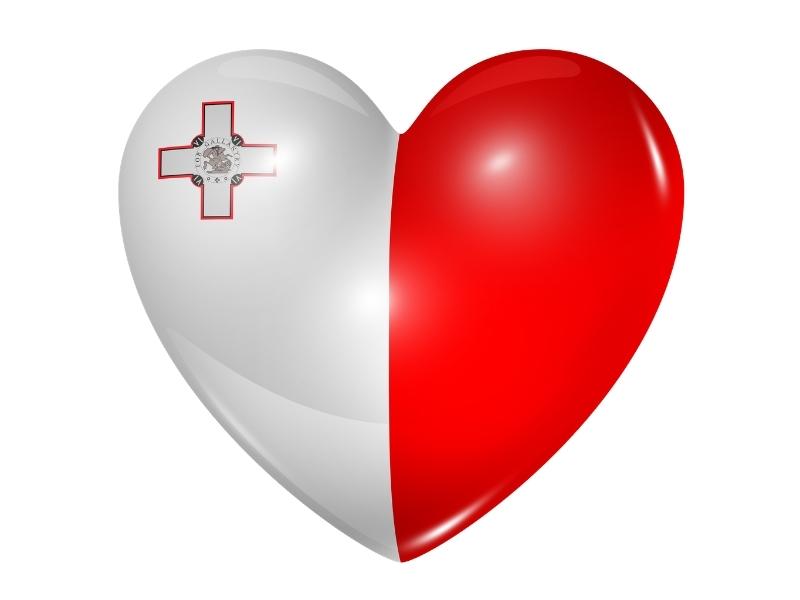
What is the best way to travel around the islands of Malta, Gozo and Comino?
I have never hired a car when on holiday in Malta but rather prefer to use public transport. The roads are narrow and and can be quite congested around Valletta and popular resort areas (and quite frankly I didn’t fancy sharing the road with Maltese drivers who seem to ignore any speed restrictions and overtake wherever they want)
The bus service is generally reliable and an inexpensive way to travel. Tickets can be purchased on the bus from the driver and cost €1.50 in winter €2 in summer and €3 for night buses. Summer rates are in place from mid-June to mid-October.
There are also a range of bus cards offering added value and reduced fares:
The ExplorePlus travel card gets you 7 days of unlimited travel on public transport around Malta. The card also includes 2 trips on the Valletta ferry. The card also includes a full-day tour on the hop-on hop-off buses OR a boat trip to Comino. What an absolute bargain! ExplorePlus Card (€39)
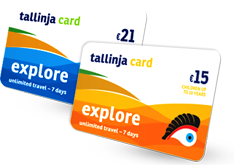
The 7-day Explore Card entitles you to unlimited use of buses on both Malta and Gozo. It is valid for both day and night services. Child prices are valid up to 10 years of age. Click here for information on where to buy your Explore Card. Explore (Adult €21 / Child €15) – Unlimited travel for 7 days
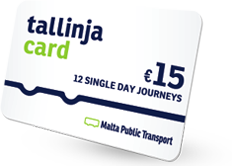
The 12 Journey card is another easy and cost-effective way of travelling around Malta and Gozo. If you are only planning a few excursions this is the perfect option. Click here for information on where to buy a 12 Single Day Journeys Card.
12 Single Day Journeys (€15)
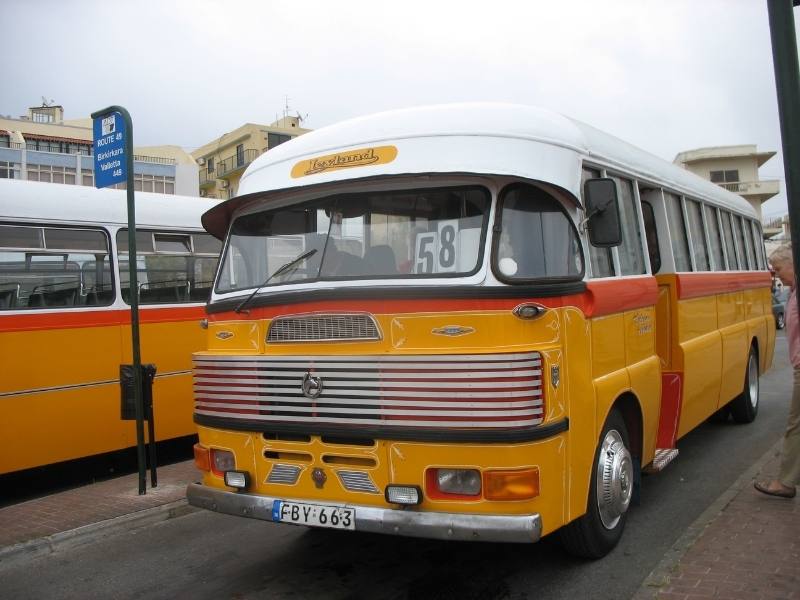
If you want to enjoy Malta’s sights at your own pace consider purchasing a ticket on the hop-on, hop-off double-decker bus tour. The buses depart every 30 minutes and stop at top sites within the Malta North and South Routes.
Click here to purchase your hop-on and off bus tickets for Malta
If you do decide to hire a car and drive around the island do remember that the Maltese drive on the left (well they should). Although there has been some serious investment from the EU some of the roads are still less than perfect with ruts, potholes and poor surfaces common.
Other key points to remember are to park in the direction of travel.
I would recommend renting a small car as parking can be quite difficult in some areas. Don’t assume that people will indicate either.
To be honest I would catch the bus….
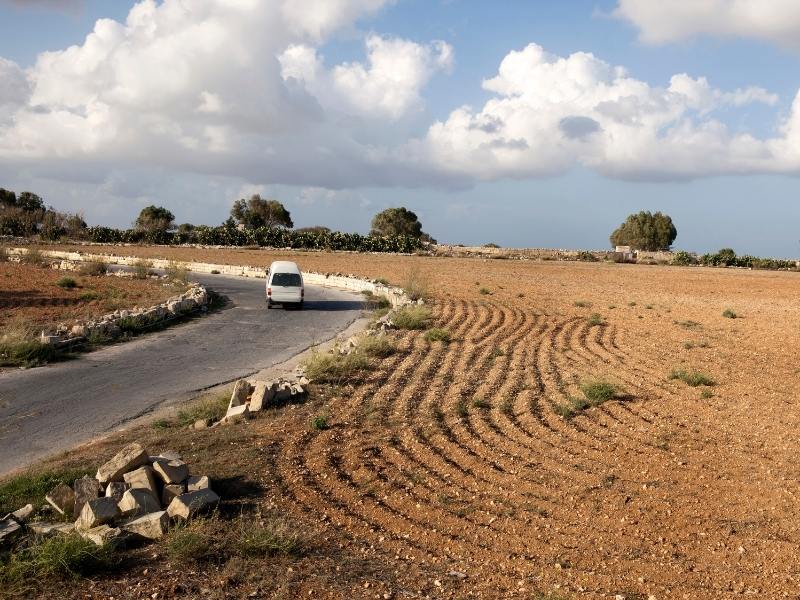
The best way to travel in Malta is by boat and you really should not spend any time there without setting foot on a boat! There are loads of Malta boat trips to choose from too.
Just don’t do the one that takes you all the way around the island. It takes all day and on the trip, we went on about 85% of the passengers were seasick.
If you only take 2 Malta boat trips I would highly recommend one to Comino and the Blue Lagoon and the other around the harbour in Valletta.
You will find there are numerous companies offering tours to Comino. If you can (and are in the north of the island) I would highly recommend a trip with English Rose Cruises.
The boat is smaller, the captain is the very handsome Sandro and you will have the BEST time. Not only can you jump straight from the boat into the beautiful blue waters of the Mediterranean but he will take you to the lesser-known (and quieter) Crystal Lagoon.
We stay in Mellieha just so we can take 3 or 4 trips with Sandro. It really is that good.
Alternatively (if you are staying on another part of the island) these boat trips are also available
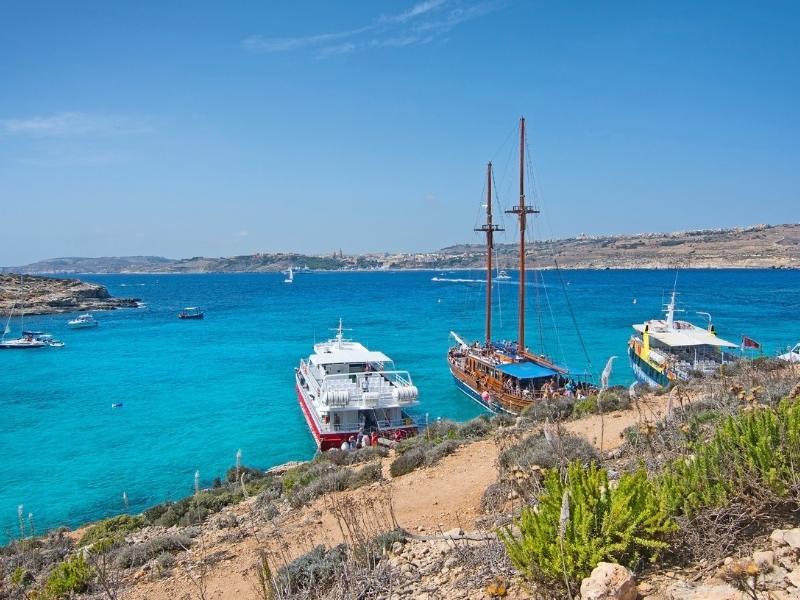
If you want to see Gozo you will need to catch the ferry across. The journey takes about 30 minutes and leaves from Cirkewwa in Malta and arrives in the port of Mgarr on Gozo.
The ferry leaves every 45 minutes and costs €4.65 return for adults, €1.15 for kids aged 3-12 and free for under 3’s. If you are driving over it costs €15.70.
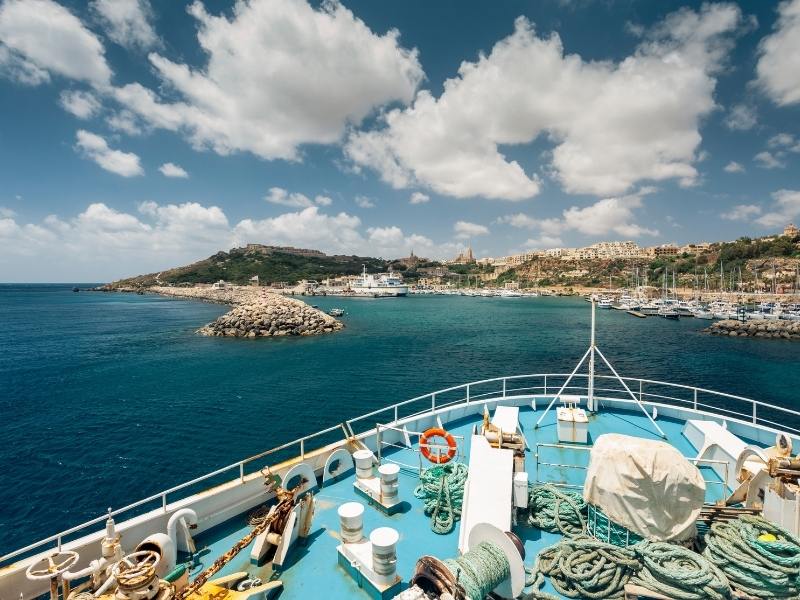
There are loads of activities available in Malta to keep you busy – these are a selection of the best from Get Your Guide
Tip – Save money and enjoy discounts of up to 50% at more than 150 establishments in Malta with a 10-day Malta Discount Card. Enjoy access to some of the island’s top tours, museums, and activities, including restaurants, water sports and much more.
Click here for more information about the Malta Discount Card
Try the food when you are visiting Malta. There are many tasty local dishes to eat and if you enjoy olives and capers you will find them in abundance!
- The Italian and English influences are very evident in the traditional Maltese foods.
- Pizza and pasta can be found in abundance.
- Seafood is also extremely popular with Lampuki pie a staple of the Maltese diet. Lampuki is a common fish caught around the islands. Baked in a pie with capers, spinach and potatoes it is delicious.
- The national dish of Malta is Stuffat tal-fenek which is a rabbit stew.
- The most popular Maltese snack is the pastizzi. This is a savoury pastry filled with ricotta or mushy peas. I have to say I wasn’t keen on these.
- Kinnie is a soft drink made with bitter oranges.
- Cisk i s the local beer.
- You will see prickly pears all over Malta and they feature in one of my favourite Maltese drinks -Bajtra. It is a beautiful (though very sweet) liquor made from the cactus fruit. You can also buy prickly pear conserve and jam.
- Try a plate of tomatoes, goat’s cheese, capers and olives in Gozo. Delicious!
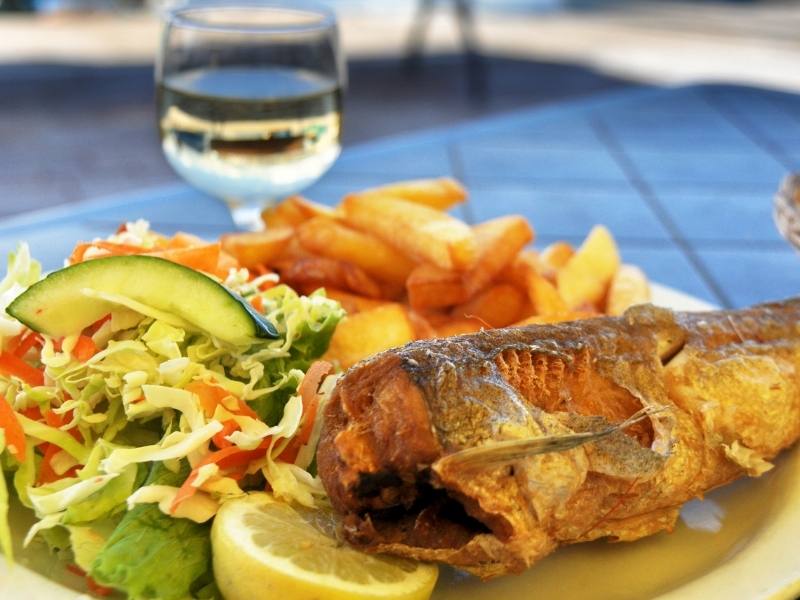
READ MORE – YOUR COMPLETE GUIDE TO VISITING MALTA
Ok lets be blunt here but Malta is not known for its miles of stunning beaches. The islands are rocky and beaches are few and far between.
The best beaches are in the north of Malta so if a beach is really what you want head to Mellieha.
In Mellieha you will find Malta’s largest sandy beach. Further north there are Golden Bay and Paradise Bays. Do be careful though as I believe the sea can be a little rougher in these areas.
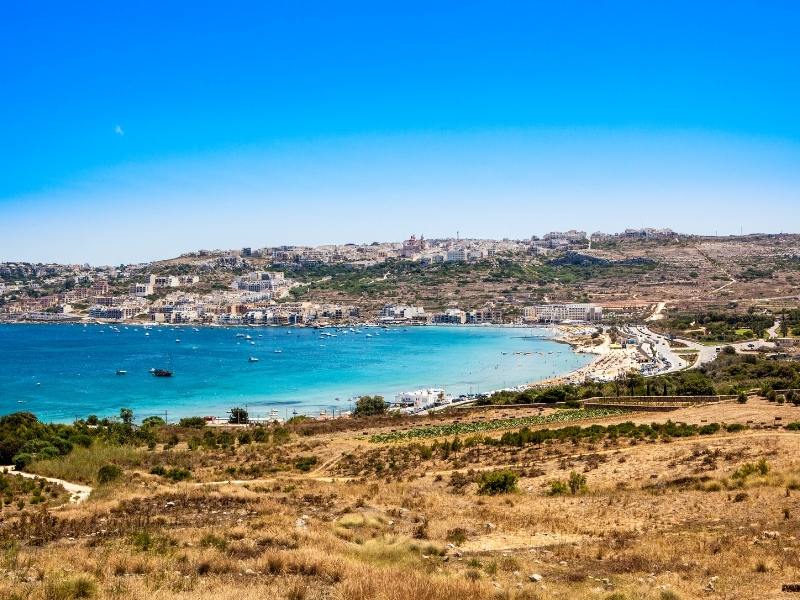
There is a beach at the Blue Lagoon on Comino. The teeny tiniest beach in the universe. No problem. Take a boat trip and spend the day jumping into the clear blue waters from the deck! Far more fun than struggling for a space on the actual beach.
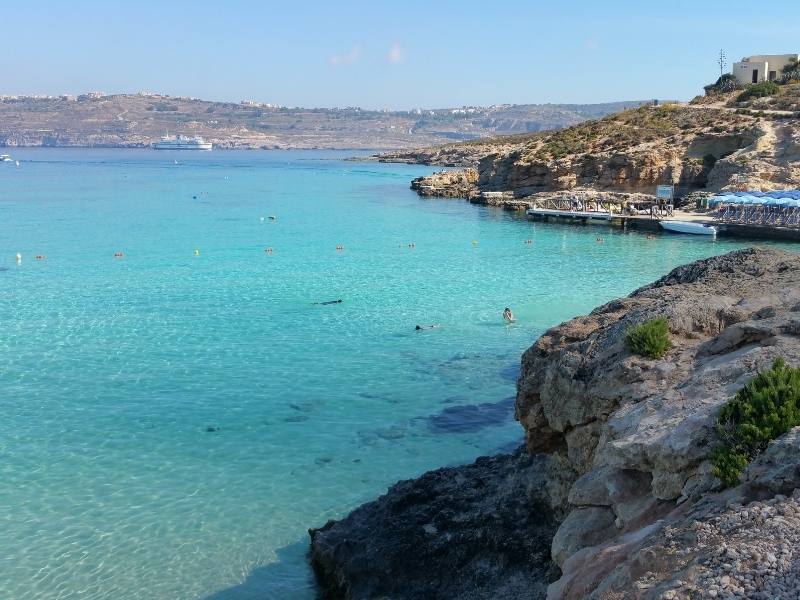
Malta is a predominantly Roman Catholic Island. Every village and city has a church at its heart and every church is named after a saint. So when it is the saint’s day the village or town or city go crazy with parties, celebrations and generally have a bloody good time!
I LOVE being in Malta when there are festas. The atmosphere is amazing and everyone has a great time. The best festas are in the hot summer months when warm evenings are perfect to enjoy the open air celebrations.
Expect plenty of food, drinks, music and fireworks. If you want to experience a festa (and you really should!) you can book a tour with Get Your Guide ( my preferred tour group company) below:
An evening of Colorful Festa Fireworks in Malta
One of our top Malta tips is to make sure to experience the spectacular Maltese Festa tradition, for which fireworks are a must. Enjoy the special sweets made for these parish feasts, as well as the beautifully lit-up streets and church, while the parish brass band fills the air with music.
→ CLICK HERE TO BOOK YOUR FUN FESTA EVENING IN MALTA
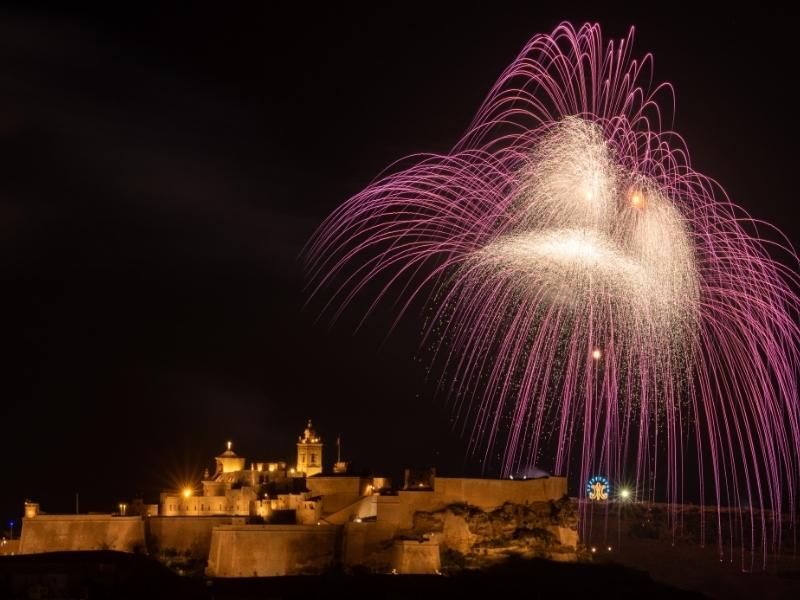
Where is the best place to stay in Malta?
To answer this question I would say that it really depends on what you want from your holiday in Malta. There are so many options to choose from that it is worth considering which part of the island would suit you best.
Read – Malta area and accommodation guide
For those seeking a quieter holiday away from the action. This is where we stayed on our first visit but subsequently, we have moved progressively up to the top of the island.
The south will give you a chance to experience Maltese life. Pop to Marsaxlokk for the market on Sunday. Definitely go to a local village Festa!
£ – Marsaskala Luxury Apartment & Penthouse
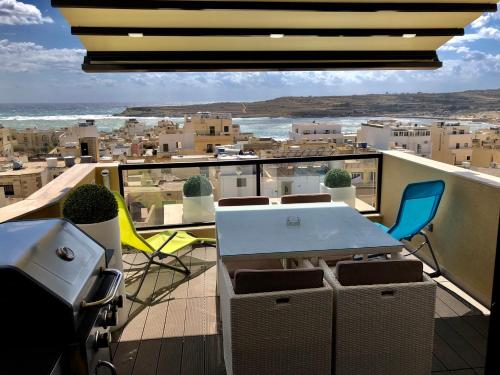
£ – Cerviola Hotel
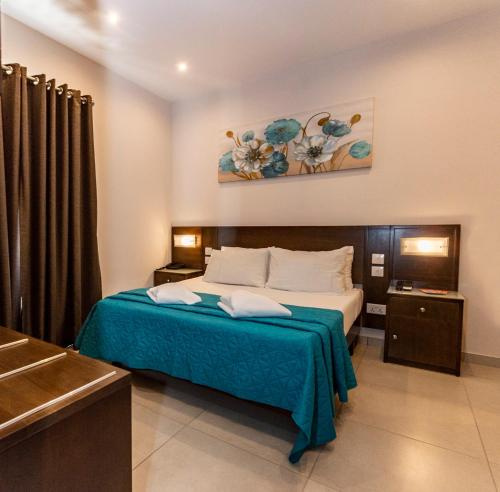
£ – Port View Guesthouse
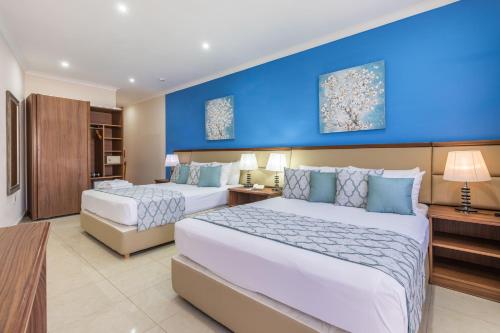
If you enjoy history Valletta is the place to stay. It is central and possible to catch a bus just about anywhere.
£££ – The Phoenicia Malta
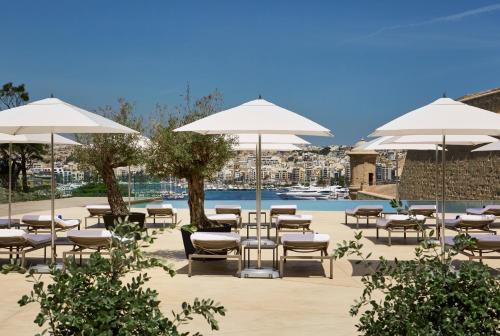
££ – 66 Saint Paul’s & Spa
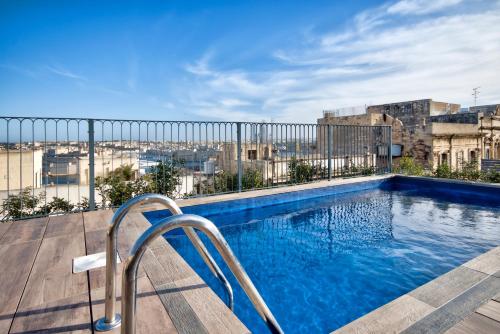
££ – The Embassy Valletta Hotel
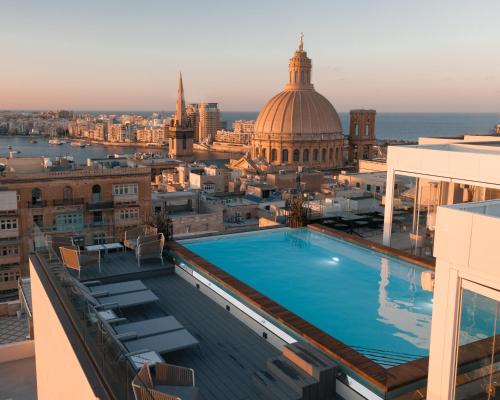
The main resort areas on Malta centre around Sliema and St Julian’s. If you enjoy shopping and some lively nightlife this is the area to head for.
££ – Palazzo Violetta Boutique
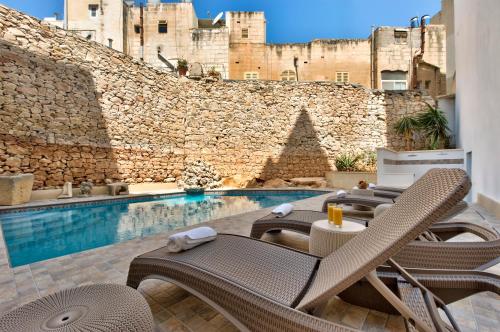
£££ – Corinthia Hotel St. George’s Bay
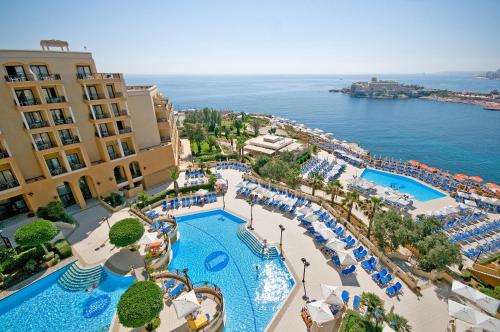
This is my personal favourite area of Malta to visit. The north is a little more rugged than the south but offers great views across to Comino and Gozo.
The three resorts of Bugibba, Qawra and St Pauls meld into one long coastal strip. I would given them a skip and head to Mellieha which is exactly what we have done on the last 3 visits!
£ – Luna Holiday Complex

£££ – Radisson Blu Resort & Spa, Malta Golden Sands
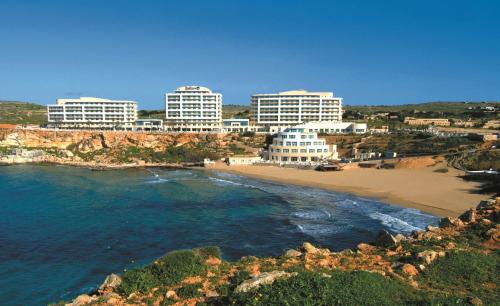
Gozo really deserves a post of its own. Although we always visit Gozo I have yet to stay on the island. Gozo is Malta’s greener more lush smaller sister and offers a quieter alternative to its big sister.
There are some fantastic accommodation options on Gozo including old farmhouses, cottages and secluded hotels.
£ – Il-Bàrraġ B&B Hosting Family

££ – The Duke Boutique Hotel
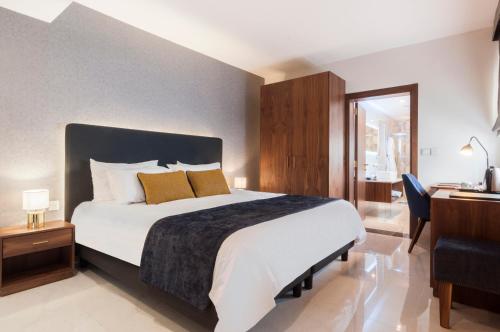
⇒ Click here for more accommodation options on Malta and Gozo
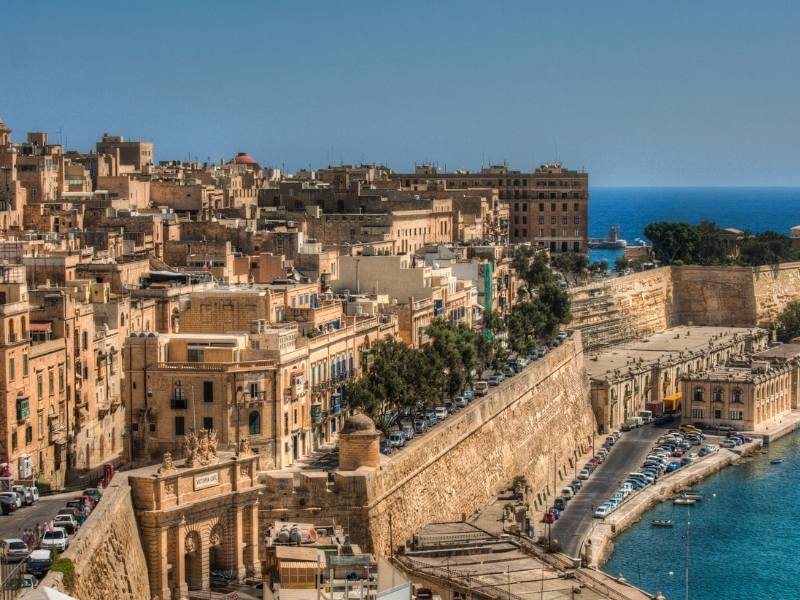
There are number of excellent markets in Malta to peruse! My favourite is in Marsaxlokk. This is also a great village to visit if you want to see the beautiful and very colourful traditional Maltese boats.
- Marsaxlokk Open Market – held every day but Sunday is the day to go to see the fish on sale. It does get very busy on Sundays as the locals also head to the market.
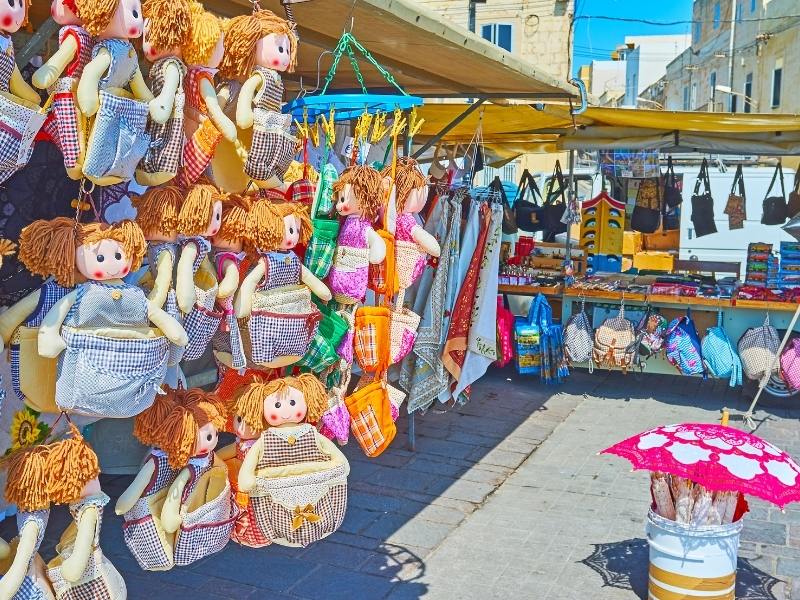
- Victoria Open Air It-Tokk Market – this market on Gozo takes place daily in Independence Square in Victoria. There are loads of restaurants and cafes around the square as well as some great artisan shops.
- Il-Monti Valletta – this is the largest market on the island and is held in Valletta every Sunday morning. Head there early to avoid the crowds!
- Rabat Market (near Mdina) – great market for fresh produce and traditional Maltese foods.
- Ta’Qali Farmers Market – this market only sells Maltese produce so stock up on honey, bread, goat’s cheese and other delicacies. This market is open Tuesdays 16:00-19:00, Saturdays 09:00-17:00 and is situated next to the Ta Qali Crafts Village.
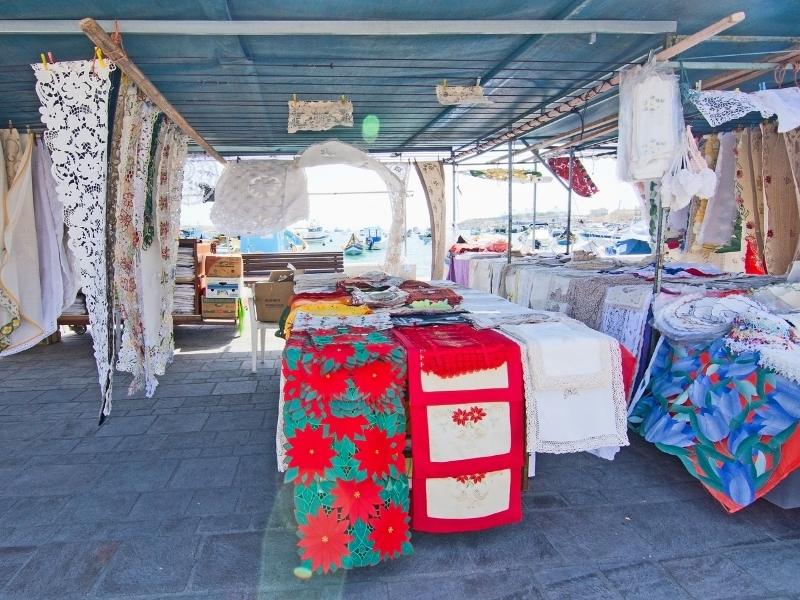
When you visit Malta make sure to take home some of the fantastic products for which the islands are famous. As a fan of prickly pears, I always purchase the local liquor made from the fruit. If you are visiting some of the markets you will easily be able to pick up some of these souvenirs!
- Bajtra – Prickly Pear liqueur
- Prickly Pear jam/conserve
- Lace – Bizzilla Maltese Lace can be purchased in all the markets. The lace is a traditional craft that flourished in Malta over 400 years ago. The traditions have been passed from mother to daughter over the centuries. Much of the lace features the Maltese cross.
- Nougat – If you attend a festa you have to try some traditional Maltese nougat!
- Maltese Filigree – I bought a beautiful filigree ring on my first visit to Malta. The jewellery is very pretty and created using fine threads of gold or silver to produce ornate pieces.
- Blown glass from Mdina – visit the workshop and showroom in Mdina and watch beautiful glass creations made before your eyes!

I am confident these tips will help you plan a fabulous holiday to Malta. It really is one of our favourite destinations to visit in Europe.
- Where to stay in Malta
- Where to stay in Athens
- Where to stay in Venice
- Azamara Mediterranean Cruise review
- 11 Things To Know Before...
11 Things To Know Before Visiting Malta

Choosing Malta as a destination to visit is certainly a wise choice, glorious weather for most of the year, idyllic scenery, beautiful beaches and marvelous cuisine. What more could you ask for? However, there may be a few things to know about before visiting the island which may help your stay run more smoothly – there are some things you should never do as a tourist in Malta . Here are 11 handy tips to help you out along the way.
2017 saw four heatwaves over the summer months. With temperatures reaching well into the 40s, it’s wise to drink plenty of water, wear a hat and plenty of sun protection. Perhaps not advisable to take too much notice of the temperature signs around the island, as many are not too accurate and those that do work display the temperature taken in the shade. The beautiful Mediterranean breezes on the beach make the sun a lot more bearable, but remember the same damage can still be done.

The Maltese speak English, too
English is the second official language of Malta with a staggering 76% of the population speaking English, 36% Italian and 10% French. Although speaking Maltese would be greatly admired by the locals, it is quite difficult to both speak and understand. Being a Semitic language it is no mean feat combining its origins of Arabic, Spanish, Italian and Norman French. Although beautiful to listen to, rest assured conversing in English is quite the norm.

Everybody knows everybody
With Malta having a mere population of 431,453 as of the end of 2017, it tends to be a case of ‘it’s not what you know, but who you know’ island-wide. With a tight-knit community in each village, if you’re after any advice (about anything!) just ask one of the locals who, if unable to help, will know someone who can. A great way to get any queries solved quickly and efficiently, but on the negative side, if you have any bad Maltese experiences, be careful who you tell as it will more than likely get back to the person in question and often embellished.
Drivers drive in the shade
Perhaps a slight exaggeration and linked to the Maltese heat, but driving can be a little erratic. Have your wits about you and be prepared that nothing should come as a surprise. Waiting on the kerb at a designated crossing does not automatically mean cars will stop to let you cross. Roundabouts are a law unto themselves, and it can be very much a case of everyone for themselves. Don’t be offended if someone beeps their horn at you; it could mean you are in the wrong, in the way, you need to speed up, you need to slow down, to let you know they are there or just a general friendly greeting. The list is endless.

Leave plenty of time to go shopping
Whether you’re queuing to pay for a pint of milk or an array of shopping, be prepared to wait. If the cashier decides to have a chat to the person they are serving, they will do so regardless of how long the queue is. No amount of huffing and puffing will make them go any quicker, as the Maltese are extremely friendly, and often you’ll find yourself chatting away and holding up the queue when it’s your turn. Very endearing, if you are not in a hurry.

Free hospital care for the British
If you are feeling a little unwell while in Malta, most pharmacies have their own doctors. Appointments can only be made on the day and in all cases, each consultation is paid for at approximately €10 per visit in addition to any prescriptions. If you are British and need hospital treatment, if you show your passport at some point during your stay, care is free. This is due to the reciprocal agreement between Malta and Britain.

Become a Culture Tripper!
Sign up to our newsletter to save up to $1,665 on our unique trips..
See privacy policy .

The tap water is safe
Contrary to common belief, the tap water is safe to drink . Albeit it has a rather strange taste, but it won’t do you any harm. Tap water goes through a desalination process, but remains rather salty, so bottled water is preferable for a refreshing cold drink purely due to the taste. Using tap water, however, for cooking and for hot drinks will save time and money spent on bottled water.

What goes up, must come down
With more and more people choosing to live in Malta and tourism on the increase, construction work seems to be endless. With hotels adding additional floors, the building of new apartments and old buildings coming down, there’s always work going on somewhere. Luckily, much of the work tends to take place in the winter months when the weather is cooler and there are less visitors to the island, but if you witness any building work, you may want to look away. The ‘health and safety’ factors are perhaps not as strict as other European countries. It’s not too unusual to see precariously built scaffoldings holding workers not wearing hard hats or dangling from the edge to do some painting.
Stray cats are well looked after
Unfortunately, the number of stray cats in Malta is vast. They hide in derelict buildings, in the undergrowth or roaming the quieter roads. A small number of dedicated charities rescue as many as possible, but there simply aren’t the resources for them all. A lot of them are feral and know no different, but nonetheless, they are looked after by the locals. You’ll often see bowls of cat food and fresh water left on doorsteps or walls outside properties, and even some cat beds ensuring the strays are as happy as possible.

Bus travel is cheap
If travelling by car around the island is not for you, bus is the alternative way to travel. It may be that during the height of the summer months you may have to let a couple of full buses drive by, but for €2, you can travel anywhere on the island. The tickets are valid for two hours, so should you need to change buses or go elsewhere in that time frame, just scan your ticket by the driver. On such a small island, nowhere is too difficult to get to ; however, any formal queuing for buses tend to go out of the window once the bus arrives.

Be prepared for the mosquitoes
As the warmer evenings draw in, the mosquitoes come out. Although Malta’s mosquitoes do not carry any diseases, their bites can cause horrendous itching. Get rid of, or keep clear of, they stagnant water to which they are attracted, and cover yourself in repellent if you are prone to bites. Also common in Malta is the Asian tiger mosquito , although larger and striped, these are silent in their movements and are more likely to hunt their prey during the day. With prevention being better than cure, keep those mosquito window nets closed and pop on a fan or some air conditioning to create a gentle draft, which pests cannot fly against.
Culture Trips launched in 2011 with a simple yet passionate mission: to inspire people to go beyond their boundaries and experience what makes a place, its people and its culture special and meaningful. We are proud that, for more than a decade, millions like you have trusted our award-winning recommendations by people who deeply understand what makes places and communities so special.
Our immersive trips , led by Local Insiders, are once-in-a-lifetime experiences and an invitation to travel the world with like-minded explorers. Our Travel Experts are on hand to help you make perfect memories. All our Trips are suitable for both solo travelers, couples and friends who want to explore the world together.
All our travel guides are curated by the Culture Trip team working in tandem with local experts. From unique experiences to essential tips on how to make the most of your future travels, we’ve got you covered.

Food & Drink
A foodie's guide to malta: what to eat and where you should eat it.

Places to Stay
The best hostels to stay at in malta.

See & Do
Embrace your wild side with these adventurous activities in malta.

Where to Stay in Malta for a Local Experience

The Most Budget-Friendly Hotels in Malta

Amazing Day Trips to Take Around Malta by Boat

The Best Resorts to Stay at in Malta

Film & TV
Why dinosaurs and hollywood are invading malta.

Fascinating Historical Places to Visit on a Memorable Trip to Malta

Hip Apartments in Malta You'll Want to Call Home

The Best Spa Hotels in Malta

Guides & Tips
Somewhere wonderful in malta is waiting.
- Post ID: 1762985
- Sponsored? No
- View Payload
The Perfect 7-Day Itinerary For Malta (2024 GUIDE)
Searching for the perfect 7-day itinerary for Malta? This is the only guide you’ll need!
This stunning archipelago in the central Mediterranean is brimming with history, culture, and phenomenal landscapes.
From its ancient walled cities and vibrant harbors to its pristine beaches and mouthwatering cuisine, Malta offers an unforgettable experience for every traveler.
In this 7 day Malta itinerary, we’ll guide you through the must-see sights, hidden gems, and local favorites that will make your Maltese adventure truly exceptional.
Read on to discover everything you need to know for spending a week in Malta including a day-by-day itinerary, unmissable attractions to see, the best guided tours, and much more!
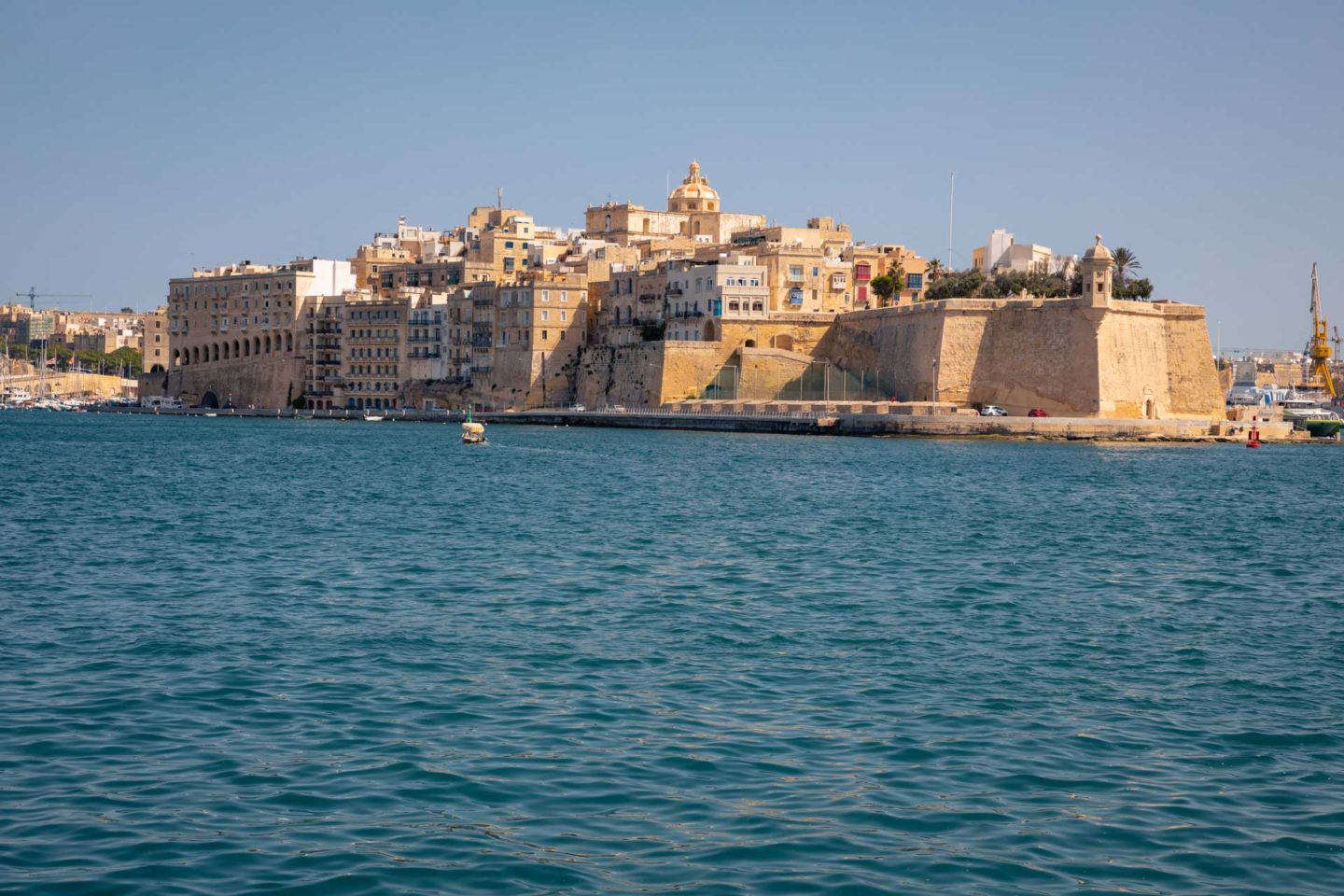
Table of Contents
OVERVIEW: 7-DAY ITINERARY FOR MALTA
Let’s start this guide with the essentials for planning your Malta trip itinerary, such as how to get here, getting around Malta, where to stay, and the best time to visit.
WHERE IS MALTA?
Malta is a small archipelago located in the central Mediterranean Sea, south of Sicily and north of Africa. It consists of three main islands: Malta, Gozo, and Comino.
Malta has a rich history influenced by various cultures including the Phoenicians, Romans, Moors, Knights of Saint John, French, and British. For this reason, it’s one of the most interesting places to visit in Europe.
Click here for an interactive map of Malta.
HOW TO GET TO MALTA?
Getting to Malta is straightforward, primarily through Malta International Airport (MLA) located near the capital, Valletta .
The airport is well-connected with direct flights from major European cities and some North African and Middle Eastern destinations. Airlines like Air Malta, Ryanair, and EasyJet offer frequent services.
HOW TO GET AROUND MALTA?
Want to know how to get around Malta? Conveniently, there are several transportation options such as rental cars, public buses, taxis, and guided tours.
RENTAL CAR:
Firstly, renting a car at Malta Airport gives you the flexibility to explore at your own pace.
This is the option we went for, and it was indeed convenient and affordable, but just be prepared for narrow roads and limited parking in some areas.
The public bus system is efficient and covers most tourist spots around the country costing just €2 – €3 per ride.
Another great option is the Hop-On-Hop-Off Bus which is an excellent and affordable way to visit key tourist spots.
Taxis and rideshare companies like Uber are readily available throughout Malta.
Bear in mind that a 30-minute taxi ride can cost anywhere between €30 – €50 for a one-way trip, sometimes even more in the summertime, so if the budget is tight, plan to rent a car or use public transport instead.
GUIDED TOURS:
For specific destinations like the Three Cities, Mdina, Gozo, and Comino, guided tours are pretty cheap in Malta and they’re all great!
We’ve listed all the best tours throughout this 7 days in Malta itinerary.
IS IT WORTH RENTING A CAR IN MALTA?
Yes, when planning your itinerary for Malta, renting a car is worth it if you prefer more flexibility as opposed to relying on public transport or taxis during your time here.
If driving isn’t an option, guided tours to key spots such as Mdina, Gozo, and Comino offer a hassle-free alternative.
Car Rental – Search, Compare & Save!
Discover Cars are one of the world’s largest online car rental platforms with vehicles in 10,000+ locations.
Find the right car, in the right place, for the best price guaranteed!
BEST TIME TO VISIT MALTA?
The best time to visit Malta is during the spring (March to May) or fall (September to November) when you’ll find pleasant weather and fewer crowds.
These months offer ideal conditions for exploring the outdoor attractions and enjoying the beaches without the intense heat of summer.
On the other hand, visiting during the summertime (June to August) is also a great time if you love the heat and don’t mind crowds.
However, be aware that June, July, and August are pretty busy periods so expect to pay more for hotels and car rentals.
The wintertime offers cooler weather, fewer crowds, and cheaper hotel deals, which is always a bonus.
WHERE TO STAY – ITINERARY FOR MALTA
Malta has countless places to stay, with the popular pick being in the capital city of Valletta.
Below is a list of recommended properties in Valletta suitable for luxury travelers, budget backpackers, and everyone in between.
For boutique stays, check out this post on the 15 Best Boutique Hotels in Valletta.
LUXURY: Rosselli AX Privilege
MID RANGE: The Londoner Hotel Sliema
BUDGET: Citizen Suites Aparthotel
FOR MORE OPTIONS, READ THIS GUIDE ON WHERE TO STAY IN MALTA – THE BEST AREAS
The ultimate 7 day malta itinerary.
Now that we’ve covered the logistics and where to stay, let’s jump into the main topic – What to see in Malta in 7 days and a day-by-day Malta itinerary.
We’ll start this Malta trip itinerary in Valletta, the capital city, and I suggest staying here as a base and going on day outings throughout your 1 week in Malta.
Alternatively, if you have more time available, you can spend one or two nights on Gozo Island, which has plenty of nice spots to see.
DAY 1: EXPLORE VALLETTA CITY
Start your day in Valletta, Malta’s capital city, by visiting the Upper and Lower Barrakka Gardens.
These beautifully landscaped gardens offer panoramic views of the Grand Harbour and the Three Cities (which we’ll discuss on day 2), making them perfect for a relaxing morning stroll.
Next, head to St. John’s Co-Cathedral, one of the most impressive and unique pieces of Baroque architecture, where I’m sure you’ll take gorgeous photos.
The cathedral is renowned for its opulent interior and Caravaggio’s famous painting, “The Beheading of Saint John the Baptist,” making it not only photogenic but also unique and meaningful.
After that, take a leisurely walk along Republic Street and Merchants Street, where you can shop for unique Maltese crafts, souvenirs, and high-quality fashion.
Another great activity is a walking tour around Valletta with an experienced guide. It includes all the spots mentioned above and more. Be sure to book in advance as spots sell out fast.
For lunch, you can either taste some local Maltese food or have a more diverse meal. Check out Kingsway Bar & Restaurant for healthy dishes or Galea’s Kitchen , which serves delicious Maltese treats.
Continue your exploration with a visit to Teatru Manoel , one of the oldest working theaters in Europe. This architectural gem hosts a variety of performances and offers guided tours.
The entrance fee is only €5 and you can spend anywhere between 30 minutes to one hour.
Afterward, head to the National Museum of Archaeology, located in the Auberge de Provence.
The museum houses a rich collection of artifacts from Malta’s prehistoric periods, and that’s great to see on the first of your 7 days in Malta.
Conclude your afternoon with dinner at a waterfront restaurant in Valletta. Browns Kitchen Valletta Waterfront is a great place to enjoy fresh seafood or other Maltese specialties with views over the marina.
After dinner, take a leisurely stroll along the Valletta waterfront, which is the perfect way to end day one on your itinerary for Malta.
If you’re up for a drink, then make sure to visit Carcass with great drinks, wine, and a superb location on Strait Street.
OTHER THINGS TO DO IN VALLETTA
As you expect, there are plenty of things to do in Malta’s capital.
We recommend staying in Valletta for this Malta itinerary 7 days, which means you’ll spend a lot of time here. So not to miss the best tourist spots, make sure to read this guide below.
READ MORE: 20 BEST THINGS TO DO IN VALLETTA, MALTA
DAY 2: THREE CITIES & NORTHERN BEACHES
Day 2 of this itinerary for Malta is all about the famous Three Cities of Malta .
Ferries frequently operate from Valletta to Vittoriosa (also known as Birgu), Senglea (also called Isla), and Cospicua (locally known as Bormla).
These historic cities offer a glimpse into Malta’s rich maritime past and you’ll love visiting for a few hours.
The best way to visit is on a 2-hour guided tour which is enough to see the main spots in the Three Cities. Not only is it affordable but your tour guide will teach you about the area’s history, which is just as important as exploring around.
Start with Vittoriosa, where you can visit Fort St. Angelo, a key stronghold during the Great Siege of 1565, as well as The Inquisitor’s Palace, where you can learn about the history of justice in Malta.
Apart from that, walk through Senglea (don’t miss the Gardjola Gardens!) and Cospicua, soaking in the authentic Maltese atmosphere and admiring the impressive fortifications.
If you’re into history, the Bir Mula Heritage Museum in Cospicua is a great place to stop and learn.
After spending 2 or 3 hours around the cities, you can either stay in Vittoriosa and have lunch around the waterfront or head back to Valletta.
After lunch, head to the northern beaches of Armier Bay and the nearby Coral Lagoon . Armier Bay is known for its incredible waters and relaxed atmosphere, and that’s a perfect spot to unwind and soak up the sun.
Next, visit the Coral Lagoon, a hidden gem near Armier Bay. You can either walk there or rent a kayak at Little Armier Beach, which costs only €20 per hour.
The Coral Lagoon and its Blue Hole are surrounded by rugged cliffs and offer a unique and picturesque setting.
It’s an excellent spot for photographing, swimming, and snorkeling in a more remote, secluded area of Malta.
READ MORE: CORAL LAGOON IN MALTA
End your day driving back to Valletta with a solid tan and a smile from the gorgeous beaches in Malta.
If there were one place we recommend for dinner it would be Sally Port Pizzeria , one of the best pizza places in Malta! It’s right on St Elmo’s Bay, so you can take a walk around after that or have a drink in one of the many bars around the city.
DAY 3: MARSAXLOKK, BLUE GROTTO & ST PETER’S POOL
The next places you can’t miss on this 7 day itinerary Malta are Marsaxlokk, the Blue Grotto, and St Peter’s Pool.
MARSAXLOKK:
Marsaxlokk is an authentic fishing village in Malta and it’s mostly known for its fish market, traditional fishing boats (called “luzzus”), and traditional vibes that you won’t find in Valletta.
You have three ways to get to Marsaxlokk including joining a guided tour , taking public transportation, or in a rental car.
Arrive early to explore the fish market and the surrounding area, where you can see the fresh catches of the day and purchase local goods and souvenirs.
Take a leisurely stroll along Marsaxlokk Harbour, soaking in the vibrant atmosphere and admiring the beautiful scenery.
Of course, you can’t skip the iconic Church of Our Lady of Pompei, which is right next to the harbor, and it’s one of the most popular and unique tourist spots in the area.
BEST SEAFOOD RESTAURANTS IN MARSAXLOKK
Before heading to the Blue Grotto, you may want to have lunch during your time in Marsaxlokk, and these are the best seafood restaurants where you’re guaranteed a fabulous meal;
- Liska Restaurant
- Roots Restaurant
- Tartarun Restaurant
- La Nostra Padrona Restaurant
BLUE GROTTO:
The Blue Grotto is a series of sea caves located on the southern coast of Malta. The best way to visit the Blue Grotto is by taking a boat tour which departs regularly from the nearby village of Wied iż-Żurrieq.
If you join a tour to Marsaxlokk, the boat tour of Blue Grotto is included, but if not, head to the boat service point in Wied lż-Žurrieq village where you can buy the tickets for just €10 per person for a 20-minute ride.
The boat ride offers stunning views of the dramatic cliffs, and you’ll get to see the vibrant blue hues inside the caves, which is simply incredible!
Also, make sure to visit the Blue Grotto viewpoint where you can take photos and marvel at the landscape from a different perspective.
ST PETER’S POOL:
To finish off day three on this 7 day Malta itinerary, don’t miss out on St Peter’s Pool , another incredible attraction located just seven minutes drive from Marsaxlokk.
This secluded natural pool is renowned for its striking rocky surroundings and upon arriving, you’ll be greeted by the breathtaking sights framed by naturally sculpted limestone.
It’s a nice addition to your one week Malta itinerary, where you can spend an hour or two snorkeling, swimming, jumping into the sea, or just relaxing on the rocks.
READ MORE: ST PETER’S POOL, MALTA
DAY 4: TAKE A DAY TRIP TO GOZO
Gozo is Malta’s sister island, located in the northern part of the country. Spending a day in Gozo is a must on your one week in Malta itinerary!
If you have a rental car, one of the ways to get there is by taking the car ferry to Gozo Island from Ċirkewwa in the north of Malta.
Without a rental car, taking the ferry from Valletta is much more convenient as you don’t have to drive to Ċirkewwa (which costs about €30 one way by taxi).
Alternatively, other ways to get to and around Gozo include the Hop On Hop Off bus, or better yet, joining a tour from Valletta which includes transportation by tuk-tuk.
BEST GOZO DAY TOUR
The best way to visit is by joining a Gozo Day Trip Tour by Tuk Tuk !
It includes popular spots in Gozo like Sanap Cliffs, Calypso Cave, and Ramla Bay, as well as hotel transfers, and an experienced guide!
Once you get to Gozo, there are many things to do and we recommend starting with Victoria (also called Rabat), the main city on the island.
Victoria is famous for its market squares, authentic shops selling crafts and local goods, and the majestic Citadel that looms over the cityscape.
The Citadel itself is a historic fortress that has been beautifully restored, offering visitors a glimpse into Gozo’s past.
Visit the Gran Castello Historic House, Citadel Ruins with gorgeous views of Gozo, and the Gozo Museum of Archaeology, all within the Citadel complex.
There’s more! Don’t miss St George Basilica known for its opulent interior decorated with fine marble, gold leaf decorations, and art pieces.
The Basilica houses a rich collection of art from prominent artists such as Mattia Preti and Giovanni Battista Conti, and you’ll see their work on both the ceiling and dome.
After having lunch in one of the restaurants in town (we recommend Roza Restaurant !) make your way to the Ggantija Temples, one of the oldest religious sites in the world, older than the Egyptian pyramids !
On top of that, you’ll want to visit Xerri’s Grotto & Ninu’s Cave, Calypso’s Cave Viewpoint, as well as the famous Ramla Beach.
Xerri’s Grotto and Ninu’s Cave are remarkable underground sites with stalactites and stalagmites all around, and both were discovered in the early 20th century.
Nearby, Calypso’s Cave Viewpoint provides breathtaking views of Ramla Bay and is linked to Homer’s “The Odyssey.” Although the cave itself is inaccessible, the scenic overlook is a must-visit.
Lastly, Ramla Beach is famous for its unique red sand, and it’s perfect for swimming and sunbathing.
At the end of the day, either head back to Valletta or stay on Gozo for the night. In both cases, you can easily explore Comino on day 5 of this 1 week in Malta itinerary as there’s a ferry from Gozo to Comino.
RELATED GUIDE: 30 BEST Things To Do In Gozo
WHERE TO STAY IN GOZO?
Gozo has countless hotels to choose from, so we’ve narrowed it down to a few of the best places to stay during your visit.
Below you’ll find properties suitable for luxury travelers, budget backpackers, and everyone in between.
LUXURY: KEMPINSKI HOTEL SAN LAWRENZ
MID RANGE: SAN PAWL B&B FARMHOUSE
BUDGET: SPLENDID HOUSE VICTORIA
FOR MORE OPTIONS, SEE THIS GUIDE ON WHERE TO STAY IN GOZO – THE BEST AREAS
Day 5: comino & blue lagoon.
Start your day by taking a tour from Valletta to Comino, which is the most convenient and hassle-free option.
Tours typically include transportation to Ċirkewwa Passenger Terminal , from where you’ll board a ferry to Comino.
As mentioned above, you can stay in Gozo for the night and take the ferry to Comino from there. That said, in order to get back to Valletta from Comino, you need to take a ferry to Ċirkewwa, and then head back to Valletta from there.
In short, joining a day trip from Valletta to Comino is the most convenient way to visit.
BEST TOUR TO COMINO ISLAND
The best way to visit is by joining this Tour of Comino Island and Gozo !
It includes transportation from Valletta, an experienced guide, and a full-day tour of Comino and Gozo.
When arriving in Comino, head straight to the Blue Lagoon, the most famous tourist spot on the island, perfect for swimming and snorkeling.
Spend the morning exploring the lagoon, enjoying water activities, or lounging on the rocky shores. It’s worth noting that the Blue Lagoon is usually crowded, so keep that in mind.
Enjoy a packed lunch or buy food from the kiosks available on the island.
Continue exploring Comino by hiking to Santa Marija Tower, which offers panoramic views of the island. You can also visit other smaller beaches and coves on the island for a more secluded experience.
If you don’t join a tour and decide to come on your own, make sure to read the ultimate guide about Comino and the attractions on the island.
READ NOW: The BEST Things To Do In Comino
Return to the mainland by ferry and head back to Valletta. If booking a tour, transportation will be arranged for you.
Note that Comino has no hotels, so you’ll have to come back to the mainland of Malta to spend the night (unless you want to sleep at the Camping Site – Tal Ful, which isn’t the most comfortable).
Once back in Valletta, relax and enjoy dinner at one of the local restaurants and then get some rest before day 6, which is yet another great day of adventure on this 7 days Malta itinerary!
DAY 6: MDINA & DINGLI CLIFFS
Mdina, also known as the Silent City, and Dingli Cliffs are two fantastic places you can’t skip on this 1-week itinerary Malta!
Just like the other places we’ve mentioned on this itinerary for Malta, you can either book a tour of both Mdina and Dingli Cliffs , rent a car or take public transportation. From Valletta, buses 50, 51, 52, or 53 operate directly to Mdina.
There are many great things to see in Mdina, and it’s more than the ancient architecture. Visit St. Paul’s Cathedral, wander around Howard Gardens, and visit the Palazzo Falson Museum .
Take your time roaming around, exploring the ancient buildings and palazzos that give Mdina its unique character.
If you don’t join a tour, you’ll have more time to spend in Mdina, so be sure to read this complete guide with all the best attractions.
RELATED GUIDE: 15 BEST Things To Do In Mdina, Malta
DINGLI CLIFFS:
After experiencing all that Mdina has to offer, head to the Dingli Cliffs , the highest point in Malta, just a short 10-minute drive away.
The cliffs offer stunning views of the Mediterranean Sea and the rugged coastline. Spend the afternoon walking along the cliff tops, taking in the fresh sea breeze and the beautiful scenery.
It’s a perfect spot for a leisurely hike and some amazing photos. Stay at the Dingli Cliffs until sunset to catch one of the most beautiful views on the island!
DAY 7: VALLETTA & SUNSET AT GOLDEN BAY
Start your final day of this itinerary for Malta by exploring more of Valletta. That’s right, while you’ve seen most of the country, visiting a little more of the capital is a great idea!
Visit some of the sites you may have missed earlier, such as the Grandmaster’s Palace, Casa Rocca Piccola , and the Lascaris War Rooms.
Take a walk around the city and maybe pick up some souvenirs along Republic Street and Merchant Street.
RELATED GUIDE: 20 BEST Things To Do In Valletta
Head to the nearby town of Floriana for lunch. This area is often overlooked, but it has some great spots to eat.
Try a local café or restaurant and enjoy some Maltese specialties while exploring the beautiful gardens and historic sites in Floriana. Samizu Restaurant offers delicious dishes and great views over the marina.
After lunch, take some time to relax or do some last-minute shopping in Valletta at the Point Shopping Mall.
GOLDEN BAY:
And finally, in the afternoon, head to Golden Bay on the northwest coast of Malta, about 35 minutes drive from Valletta.
This popular beach is known for its stunning golden sand, and it’s a great spot to relax, swim, or take a walk along the shoreline.
Plus, you guessed it, it’s an unbelievable place to watch the sunset! We simply can’t think of a better place to end your 7 days in Malta.
RELATED GUIDE: GOLDEN BAY BEACH, MALTA
MALTA ITINERARY – FAQ
That was a long Malta trip itinerary, but we’re confident by following this guide, you’ll get to see most of the tourist attractions in Malta!
When planning your 1 week itinerary Malta, we’ve included these frequently asked questions from first-time visitors.
WHAT ARE THE BEST THINGS TO DO IN MALTA?
Malta is one of the most beautiful countries in Europe , and there are plenty of things to see and do during your visit.
We spent one week in Malta, and here below is our complete guide to all the must-see attractions.
READ NOW: 21 TOP THINGS TO DO IN MALTA
HOW MANY DAYS IN MALTA?
One week in Malta is ideal for a well-rounded experience. This allows you to explore the main islands of Malta and Gozo, and enjoy the historic sites in Valletta and Mdina.
Apart from that, you’ll get to relax on beautiful beaches like Golden Bay and Ramla Beach and take day trips to unique spots such as the Blue Lagoon on Comino.
IS 1 WEEK IN MALTA ENOUGH?
Yes, one week in Malta is enough to visit the highlights of Malta without rushing around.
This duration also allows you to enjoy Malta’s rich culture, delicious cuisine, and vibrant nightlife for a memorable trip.
More Malta Travel Guides
Click the button below to view all articles related to Malta!
FINAL THOUGHTS – ITINERARY FOR MALTA 7 DAYS
If you have any questions at all about this Malta itinerary 7 days, please leave a comment below this post and we’ll get back to you as soon as we can.
For a quicker response, be sure to join Jonny Melon’s Travel Tribe on Facebook and post your questions or recommendations to our awesome community.
TRAVEL RESOURCES FOR YOUR NEXT TRIP
Whether you’re a seasoned traveler or it’s your first trip overseas, here are some useful travel resources to help you kick-start your next adventure!
Search and book accommodation worldwide.
Compare and book cheap flights to anywhere.
Find tickets, tours, and experiences around the world.
Book buses, trains, and transfers online in advance.
Search all rental cars in your next destination.
Need travel insurance for your next trip?
THANKS FOR READING
Hey friend, thanks for reading this guide!
Please know this post may contain affiliate links. When making a purchase through one of my links, I earn a small kickback at no extra cost to you and it’s a big help to keep the site up and running. Rest assured, I only promote products and services that I personally use and recommend.
Click here to find out how you can support the site organically .
Many thanks!
Leave a comment Cancel reply
Notify me of follow-up comments via e-mail.
Plan Your Trip
Travel Guides
Destinations
Hotel Guides
Find Best Tours
Travel Gear
Travel Resources
How To Start A Blog
Photography Guides
Support the site
Follow On Socials
© 2024 Jonny Melon Adventure Travel Blog. All rights reserved.
Privacy Policy | Terms | Sitemap

Home » Malta Itinerary
Malta Itinerary: A Travel Guide’s Pro Plan for up to 7 Days
Are you considering a trip to Malta? Or have you already decided to go and wondering how to spend your time there with an organised itinerary?
You’ve come to the right place!
Seven days in Malta is more or less the perfect amount of time to spend in this small island nation. When you have a full week in Malta you’ll have enough time to explore the major highlights at an easygoing pace. Malta has a rich history, natural beauty, and local culture and village life, so there’s plenty to see and do.
In this guide, I’ll help you with the ultimate Malta itinerary for one week. I’ve perfected it after having helped thousands of travellers plan their trips.
As part of my advice, you can also slot in a few optional day plans. That way you can personalise your itinerary and still enjoy a great trip.
Let’s get started!

How to spend one week in Malta
For one week in Malta, I’ve found that this carefully crafted itinerary is the best way to spend your time.
You can find the locations covered on this handy map.
Day 1: Valletta (blue) Day 2: Comino & Blue Lagoon (yellow) Day 3: Exploring Gozo Island (orange) Day 4: Mdina, Rabat and surroundings (green) Day 5: Floriana and The Three Cities (red) Day 6: Blue Grotto, Marsaxlokk and Megalithic Temples (purple) Day 7: Mellieħa and surroundings. (khaki)
A full week in Malta allows you to find a good balance between:
- Discovering its rich, unique history
- Enjoying the country’s natural beauty by the sea, in the quieter West side of Malta, as well as in Gozo
- Getting a taste for local culture and villages in Malta, away from tourist hotspots.
I’ve combined these three elements in the plan below and paced them in a way that makes sense to most.
About this Malta itinerary
Hi! My name is Edward, and I’m a tourist-turned-local with Maltese roots. I’ve experienced Malta as a tourist and know the country inside out now that I’ve lived here for a number of years now.
On Malta Uncovered I help travellers like yourself make their trip to Malta a memorable one.
Last year, I helped over a million readers of this site (and my guidebooks) plan their trip. Based on their feedback, I’ve carefully crafted a few itineraries for visiting Malta:
- 7 Days or one week in Malta (this guide)
- How to spend 4 or 5 days in Malta
- How to spend 3 days in Malta .
In this particular guide I’ll help you determine the best travel plan for you and your loved one(s). However, at the end of this page you can find references to other guides on my site. They cover topics like where to stay, whether to rent a car or not, and more. So when you’re ready, there’s a lot more you can learn here before you visit Malta.
In the section Practical advice for planning your Malta trip (click/tap to jump there), you’ll find guides on:
- Where to Stay
How to get around in Malta and Gozo
- The best time to visit Malta
- … and more.
You’ll find a few links to recommended tours and services within this guide. I will earn a small commission if you book via these links, but:
- It makes no difference to the price you pay
- It never affects my recommendations. I genuinely want you to have a memorable trip to Malta.
If that’s all fine with you, I greatly appreciate your support!
My Malta Itinerary for 7 days
Day 1: valletta.
Valletta is Mallta’s capital city and a UNESCO World Heritage Site.
That’s right, the whole city is on the list of UNESCO World Heritage Sites. In my opinion, it’s a must to include on any Malta itinerary.
This majestic fortified city is more or less an open-air museum full of age-old buildings. Built in the Baroque style, it has many churches, museums, squares, gardens, and more. Founded by the Knights of Malta in the 17th century, it’s surrounded by fortifications. Steeped in history, Malta’s capital has a lot of stories to tell.
Even though it’s one of the tiniest capital cities in Europe (just 0.8 km2 or 80 ha.), you can easily spend three full days there. In fact, in my Valletta guidebook , you can find walking routes and itineraries for 1, 2 and 3 days in the city.
For most people visiting Malta for the first time, though, one full day is enough to get a good feel for the city.

Valletta – quick facts
- Everything is easy to reach on foot. Some streets have a lot of shallow steps, though, so that can be challenging for some people.
- The centre is pedestrianised, so don’t expect busy, traffic-filled roads
- Inhabited by less than 6,000 people. It’s a place of work for many locals and a popular destination for tourists. Still, not as crowded as you might expect from a capital. The busiest parts are Republic Street and Merchants Street.
- The city has streets laid out with a grid of long streets. There’s also an intricate system of underground tunnels and reservoirs.
- Valletta was heavily bombed during World War II, and several scars still show today.
Valletta in 1 Day: My DIY walking route
- The city of Valletta is surrounded by tall bastions and has a few key entry points. Start at City Gate , which is a stone’s throw away from the main bus terminus and the large MCP parking garage. Valletta’s City Gate is the main entry point to the city and leads you into Republic Street.
- At the site of the former Royal Opera Theatre (to your right), head up the road towards Castille Place and its Auberge de Castille . Built by the Knights, it’s the Office of the Prime Minister nowadays.
- Next, visit the Upper Barrakka Gardens. This is a great little spot to grab a coffee and a snack while enjoying the tranquillity of the gardens. You can take in the views of Grand Harbour behind the arches but don’t get a fright if you’re there at noon or 4 pm. The historic guns of the Saluting Battery fire at those times!
- Visit Saint John’s Co-Cathedral as your next stop. This is the jewel of Valletta, arguably of Malta as a whole. Despite its sober exterior, the interior is absolutely stunning. You can get there by heading into Zachary Street (a much better option than the busy Merchants Street). You can find the visitors’ entrance to the cathedral around the corner on Republic Street.
- The next stop is the Grandmaster’s Palace, its State Rooms and Armory. This beautiful palace in the heart of the city was the seat of power for the Knights. It used to house the Parliament of Malta more recently. It’s used for ceremonial purposes nowadays. The halls and stately rooms are beautifully designed, and its Armoury gives you a glimpse of armour and weapons from the period of the Knights.
- Make your way to another historical beauty next: La Sacra Infermeria (also referred to as Knights Hospitaller). This was the Knights’ Hospital and medical education centre for centuries. Its impressive long ward hall is the main centre of attraction. You’re offered a tour in combination with a short history show at The Malta Experience. To save time, I recommend going for the “ Reliving La Sacra Infermeria ” option. That’s a self-guided Augmented Reality tour using a mobile/tablet app. An entertaining option for families with kids as well.
- Right across the road, your next stop is Fort St. Elmo and the National War Museum . The restored fort at the tip of Valletta’s peninsula was of major importance in the Great Siege of Malta in 1565. The museum displays several interesting and historically significant items, including the George Cross. King George VI awarded this medal to the people of Malta towards the end of WWII. During the war, the brave locals endured and resisted years of relentless bombing.
- Walking South, visit the Siege Bell War Memorial next. This monument commemorates the fallen during WWII and rings at noon daily.. You can then enjoy a break at the Lower Barrakka Gardens , which is nearby.
- Finish the day by walking down the colourful balcony-lined Lvant Street , followed by a view of Victoria Gate . Consider having dinner at one of my recommended restaurants in Valletta to finish your day.
Tips for Day 1
- You’ll need comfortable walking shoes for this day. Everything is within short walking distance in this small capital city, but you’ll be on your feet most of the time.
- Have lunch at Nenu the Artisan Baker (143 St Domnic Street) to get a taste of local food.
- Many guides suggest combining The Three Cities with Valletta on a single day. From my experience (and that of my readers), that’s a lot of distance to cover, and you won’t get the most out of your day. Valletta deserves a full day of its own because there’s so much of interest to see there alone.
- John’s Co-Cathedral can get crowded. Go early in the day to get the best experience here.

Sightseeing recommendations
If you plan on visiting multiple museums on your trip, consider getting a Heritage Pass from iSeeMalta . You can save on multiple entrance fees with this combo pass.
Prefer taking a guided tour? These are a few great options to consider:
- Join a 3-hour Valletta: Street Food and Culture Walking Tour and have a local guide take you past several highlights of the city. On the way you can enjoy several samples of traditional Maltese food from the best eateries in town.
- Take this half-day Valletta walking tour (group) with a knowledgeable and friendly tour guide. It covers some of the key stops covered in my route above.
Day 2: Comino & Blue Lagoon
The Blue Lagoon is a small bay on the island of Comino and is known for its crystal clear azure-coloured shallow water. It’s probably the #1 summer destination for tourists as a result and a must-visit on a trip to Malta for most visitors.
However, be warned: It can get _very_ busy here in summer.
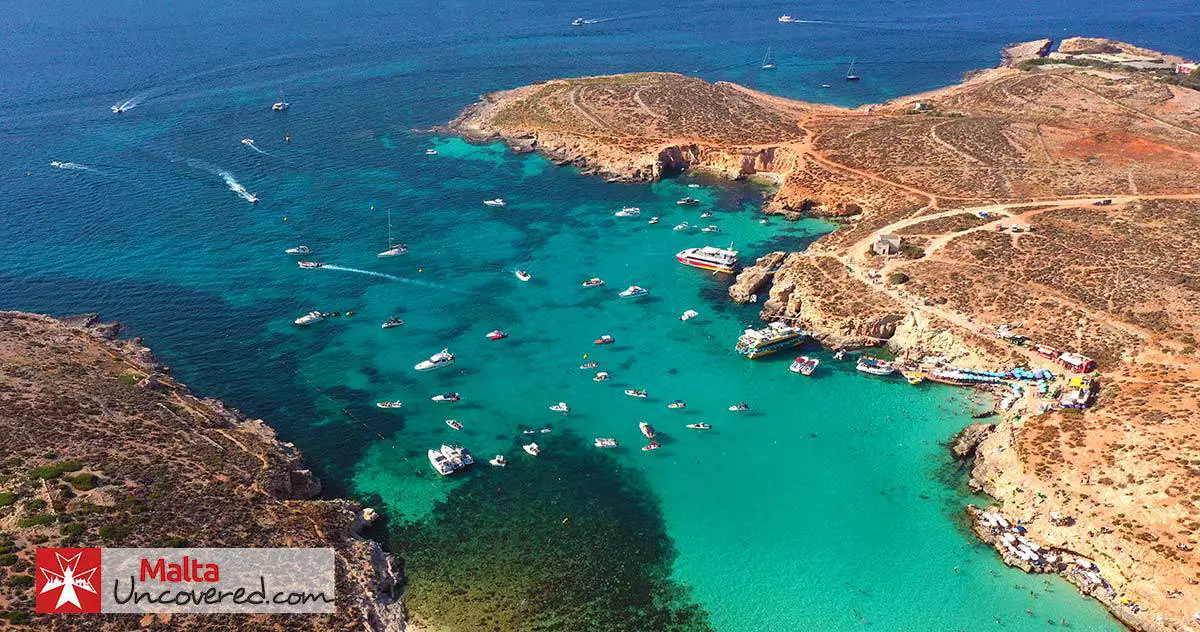
How to get to the Blue Lagoon
- Go DIY , take a long bus ride and a ferry to get there (lots of time wasted, not recommended, especially in summer)
- Book a private boat tour to avoid the crowded shoreline in summer. I highly recommend this provider .
- Take a standard boat tour to the Blue Lagoon (options below), which often combines other sites at Comino, like the Crystal Lagoon and Comino’s Sea Caves.
- The Beaches and Bays catamaran is a great option from Buġibba
- This private boat tour operator gives you a lot of flexibility with custom routes. (Highly recommended!)
- Summer: Blue Lagoon and Quad Bike tour of Gozo OR Blue Lagoon and Tuk Tuk tour of Gozo (Highly recommended!)
- Winter: Quad bike Tour of Gozo OR Tuk Tuk Tour of Gozo , both with pass-by of Comino/Blue Lagoon (weather permitting).
Recommended standard Blue Lagoon tours
- The Spirit of Malta catamaran is by far the best option – Lunch is included and the catamaran is spacious
- Standard tour , great for families with kids
- Sunset tour by catamaran at a quieter time of day (recommended!)
Visiting Comino
Comino Island itself is small but has some charming places to visit on foot. However, I’d only advise exploring the island from October to April/May, as there aren’t many trees to find shade under during the year’s hottest months.
You’ll also need to wear a pair of sturdy walking shoes.
Although you can take the ferry, most day trips and boat tours that stop at the Blue Lagoon allow you to get off and wander around. You will have to be back at a specific time for the return journey.
Some of the highlights on Comino are:
- The beautiful Crystal Lagoon Bay is around the corner from its more famous sibling
- Santa Marija Bay and its cave
- Santa Marija watchtower , built by the Knights.
Day 3: Exploring Gozo Island
Gozo is Malta’s smaller sister island that can be reached easily with a short ferry ride from Ċirkewwa (North of Malta) or Valletta (fast ferries).
Unlike the main island of Malta, this little Mediterranean island is quieter, and life there is still a little more easygoing. Gozo is less of a tourist hotspot but very popular to visit among the Maltese for long weekends or summer breaks.
If you’re spending just a week in Malta, you should at least spend one day there as part of your itinerary. It’s a really unique experience and a combination of raw nature at its best, paired with local culture and interesting places to visit.
Highlights of Gozo
These are some of the best points of interest to visit Gozo on your third day:
- The centrally located “capital” of Victoria (also referred to as Rabat by the locals) and its Cittadella or Citadel on top of the hill.
- Dwejra and its beautiful natural surroundings, including the Inland Sea and Fungus Rock . It’s also the site of the former Azure Window (an iconic rock formation that collapsed into the sea in 2017). For Game of Thrones series fans: This was a filming location for the first season.
- The Xwejni salt pans on the northern coastline, between Żebbuġ and Marsalforn. These salt pans were hewn into the rock in a pattern of shallow basins and are still used to mine salt from the sea.
- The stunning Ramla Bay , with its red sandy beach and raw natural surroundings. You can get great views of the bay from Tal Mixta Cave , which offers wide-open views of the bay.
- Ta’ Pinu Basilica and Shrine is an iconic landmark and one of the most sacred places of worship in Gozo
- The seaside resorts of Marsalforn Bay and Qbajjar , with a variety of seafood restaurants and peaceful sea views.
- Xlendi Bay in the South, with its commanding cliffside, watchtower and rocky bathing area in a quiet part of the island.
Tips for Day 3
- Seasonality: Gozo is an all-year-round destination. Whether you travel to Malta in January or July, it still makes sense to put it on your trip plan. In rare cases in winter, ferry services may be suspended, but any booked tours offer free cancellation.
- Wied il-Mielaħ is a window-shaped rock formation at the seaside to the North of the village of Għarb. It’s a great example of natural beauty, and makes for a great hike, drive or ride to get to.
- Sanap Cliffs on the South of Gozo are at a higher altitude and are worth visiting on a hike, to admire this scenic area.
- Daħlet Qorrot is a small bay to the North of the village of Qala and is a local’s favourite. This pebbly beach is home to a few fishermen but makes for a great spot to swim and snorkel.
Recommended tour options
If you’re interested in visiting most of the above highlights of Gozo, I highly recommend the following (tried-and-tested!) tours, operated by the same provider that gets glowing reviews.
These tours are all-inclusive , with transport to/from your place of stay as well as lunch included.
- Tour Gozo by Tuk Tuk – Explore Gozo on a guided tour on brightly coloured Tuk Tuks that seat up to 6 passengers and are driven by local experts.
- Tour Gozo by Quad Bike – This is a more adventurous option, with high-powered Quad Bikes that seat a driver and passenger. You’ll be following a lead driver who will guide you on a tour of Gozo.

Day 4: Mdina, Rabat and surroundings
Mdina and Rabat are neighbouring towns in the Southwest of Malta. They are popular destinations on most visitors’ itineraries, and for good reason.
This location has deep roots in history, from early settlers to the Romans and, eventually, the Knights of Malta.
Rather than just visiting Mdina, I recommend spending time in Rabat. That way, you can balance the touristic side with local village life and culture to explore.
Mdina: Exploring The Silent City
Nicknamed The Silent City, this small (tiny) town is surrounded by tall bastions and a moat. Visiting this town really takes you back in time. It’s full of ages-old buildings, narrow winding alleys and a few interesting museums, chapels and churches to visit.
St. Paul’s Cathedral is located at the heart of Mdina, and its bell tower can be seen from miles away – an iconic feature of the skyline at night.
Did you know? Mdina’s main gate featured in the first season of Game of Thrones
These are the highlights of Mdina to visit on your fourth day:
- St. Paul’s Cathedral is located in the heart of the town, with its square Pjazza San Pawl in front. Visit the cathedral and consider its museum if you’re interested in exhibits of religious art and objects.
- Palazzo Falson (The Norman House) is one of the best preserved Medieval-era buildings in Mdina. It was built (in its current form) in 1495 and occupied by the first Grand Master of the Knights of Malta, Philippe Villiers de L’Isle-Adam. It’s a museum that showcases all sorts of collections, including paintings, furniture, timepieces, weapons and more.
- Visit the National Museum of Natural History if you’d like to learn more about the history of local flora and fauna. The 18th-century palace itself is also worth admiring, for the modest €5 entrance fee.
- Head to the observation deck to get commanding views of Malta from the bastions.
Rabat and the surrounding area
Situated right on the doorstep of Mdina, Rabat is a small town that offers a good opportunity to get a taste of local life. Once you’ve finished exploring Mdina, head to Triq San Pawl at the nearby roundabout to enter Rabat.
These are a few recommended places of interest to explore:
- Visit St. Paul’s Catacombs and its museum to explore some of the underground catacombs (burial places) that date back to Roman times.
- As in many villages, most local life centres around the Parish Church of Saint Paul .
- Next door, you can find the Wignacourt Museum , named after Grand Master Alof de Wignacourt. It houses a collection of art and religious artefacts as well as an underground grotto . St. Paul’s Grotto is said to have been the temporary home of St Paul while he was shipwrecked in Malta. St. Paul is said to have introduced Christianity to Malta in around A.D. 60.
- Beyond Rabat, there are a few outdoor places to explore on foot, though you’ll need a car or cab ride to get there. The first is Buskett Gardens , one of the few woodland areas in Malta planted by the Knights to serve as a hunting ground. The second is Dingli Cliffs , which lies just beyond the small village of Dingli. Here, you’re at the highest point of the Maltese islands at around 253 metres above sea level. It’s a great spot to walk in nature and take in the panoramic views, but only if you’re going around by car. If not, it’s not worth catching a bus for.
Tips for Day 4
- There are two side gates through which you can enter Mdina: The Greeks Gate and Gharreqin Gate . You can find them by entering the moat around Mdina from near the Domus Romana museum. The moat itself is nowadays a garden in recent years, and you can walk towards the East to explore the garden and views.
- Visit a hidden gem – St. Roque’s Chapel . This little unassuming chapel is beautiful from the inside, especially its painted dome.
- Grab a bite to eat at Xara Trattoria AD1530 (great location, good food) and visit Fontanella for dessert if you have a sweet tooth! Curious about trying typical local snacks? Head over to is-Serkin (Triq San Pawl, as you enter Rabat) to sample a few fresh pastizzi . Choose between these ricotta cheese or pea-filled pastries (or try them both).
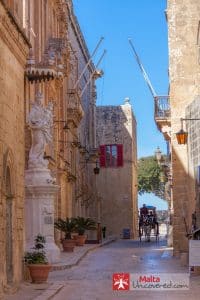
- Take a 2.5-hour walking tour of Mdina and Rabat that will take you past the highlights of both places, led by an experienced local guide.
- The Mdina & Malta highlights tour is a great option for a group tour to the Silent City and some of its surrounding areas, including Dingli Cliffs, the St. Paul’s Catacombs, San Anton Gardens and more.
Day 5: Floriana and The Three Cities
Floriana and The Three Cities offer a combination of history/heritage as well as local village life and culture. Each can be covered on foot for roughly half a day. This part of your itinerary is estimated to take 3 hours in Floriana and another 3-5 hours in the Three Cities.
Floriana is located on the doorstep of Valletta and is a bit of a hidden gem with the right walking route. It’s the best place to start your day since it’s a short walk away from Valletta’s bus terminus.
- Floriana is home to several landscaped gardens, and one of my favourites is the Msida Bastion Historic Garden. It’s a great spot to enjoy morning views of the surrounding areas. You’ll need to walk down the road past the Grand Hotel Excelsior to get there. Head to Sa Maison Garden next, heading towards the South.
- Walking past several fortifications make your way to Port des Bombes . This landmark formed part of the Floriana Lines, an outer defensive perimeter for Valletta. It was one of few entryways as a gate but is nowadays an arch on a major arterial road.
- Walk in the direction of Valletta and follow a turn to your left towards Knisja ta’ Sarria (small church). Next, follow Triq Sarria until you reach Piazza San Publiju (square), also referred to by the locals as il-Fosos. The large circular stones on this square cover gigantic storage silos built by the Knights to preserve food and other precious goods. The imposing Parish Church of Saint Publius is also definitely worth a visit.
Cross the road of St. Anne Street (carefully – use the zebra crossing!) and make your way down the Valletta Waterfront . At the harbourside, former storage facilities for sea trade are now used by restaurants and shops. It’s a great place to grab lunch on one of the (shaded) outdoor terraces.
The Three Cities
This cluster of harbourside villages is made up of three neighbouring harbour towns. Senglea ( Isla ), Cospicua ( Bormla ) and Vittoriosa ( Birgu ) are together called The Three Cities. They’re located just a stone’s throw away from Valletta, across Grand Harbour. The latter was the first location for the Knights of Malta to settle before Valletta even existed.
You can easily reach the Three Cities by taking a short (7 minutes – I timed it!) ferry ride from Valletta. Reach the ferry by following the seafront from Valletta Waterfront and getting to Fort Lascaris. The departure point is indicated as Valletta – 3 Cities Ferry on Google Maps.
You’ll arrive at Bormla to start your walk around the area.
This is my suggested route:
- Start your tour at Senglea by crossing the small bay over the bridge and heading up the seafront following Xatt Juan B. Azopardo . That way, you can enjoy the harbour views and get a glimpse of the sea-facing side of town. You can then head to the end of the small peninsula to reach the Gardjola Gardens and its iconic Gardjola “sentry box” (small watch tower).
- Follow Portu Salvu, then Triq il-Vitorja, to head down the fortified entrance to Senglea. Stop at the La Vincitrice Band Club for a quick drink, view the Knisja Maria Bambina (church) and view the old city gate, that forms part of St. Michael’s Bastion.
- Walk down Triq San Pawl and take a left turn onto ix-Xatt Ta Bormla to head back into Bormla. View the local church, steps and little squares while you follow the road Fuq San L-inkurunazzjoni to take you to Birgu. While Bormla offers a few places of interest they take quite a bit of time to explore. Consider visiting Bir Mula Heritage Museum (local history) and old fortifications, they take quite a bit of time to explore.
- Instead, head to the main gate of Birgu, straight into the narrow streets of this small fortified town, referred to as il-Colacchio . Head to the Inquisitor’s Palace or Maritime Museum for some local history. Then make your way to the West-facing waterfront to reach Fort St. Angelo. This is one of the original fortifications that existed before the Knights landed in Malta.
- Finish your day with dinner at Tal-Petut (local cuisine) or Don Berto (at the waterfront).
Tips for day 5
- Bring water and snacks with you. There will be stops to eat along the way, but especially Floriana doesn’t offer a lot of food options for on-the-go.
- Part of the fun of this day is to wander around and take everything in at your own pace. You can follow each location, but finding your own way around can be very rewarding . It’s hard to get lost, especially with Google Maps in your pocket.
- For Kids: The Esplora Interactive Science Center is located close to Bormla, roughly 20-minute walk away or a quick 5-minute cab ride.

- Join this well-reviewed 2-hour Three Cities walking tour and have Chris, an experienced local guide, show you around its narrow streets, harbourside views and historical landmarks and enjoy a short boat trip on a traditional boat.
- You can also take this guided tour of The Three Cities to get a deeper understanding of the area. It’s a half-day morning tour, which you can follow by visiting Floriana afterwards.
Day 6: Blue Grotto, Marsaxlokk and Megalithic Temples
Southern Malta is often less explored since most of the tourist destinations are located in the North. Nevertheless, exploring this part of the country on a 7-day trip to Malta is a great idea.
The Blue Grotto
The Blue Grotto is a sea cave South of the village of Żurrieq, which has been a popular tourist destination for a very long time. The reason is its magical beauty caused by sun rays reflecting off the white sandy sea bottom inside the dark cave, creating bright blue hues.
You can reach the spot by bus (routes 74 and 201), and walk down to the sea to hop on to one of the small boats that take you inside the cave on a short boat ride. It’s very much worth it, but only if you can combine it with another outing (i.e. one of the below).
The town of Marsaxlokk, located on the southeast coast of Malta, is known as one of the few remaining traditional fishing villages. It has a small harbour lined with various brightly-coloured fishing boats (called the luzzu with its iconic painted eyes at the front.
Although it’s quite touristy, the fisherman’s character is still alive, and the seafront is lined with good seafood restaurants to dine at. On Sundays, it’s a popular destination for a Sunday lunch out, while the Sunday market attracts bargain hunters.
The Megalithic Temples
Malta’s Megalithic Temples are some of the oldest freestanding man-made structures worldwide. They’ve taught us a lot about early civilisations in the Maltese islands, their practices, values and religion.
Even though more temples exist in Malta, seven of them are part of the UNESCO World Heritage Sites.
If you’ve visited the National Museum of Archaeology in Valletta, the temples themselves add a lot of context to what you would’ve seen there.
The two temples of Mnajdra and Ħaġar Qim are the most convenient options on a 7-day trip. They offer a great visitors’ centre full of insightful information.
A visit here is easy to combine with the Blue Grotto, being located only a short drive (or bus ride – same routes) away.
Tips for Day 6
- The Għar Dalam cave is a prehistoric cave in the South of Malta where various archaeological discoveries were made. Most notably, bone fragments from several extinct species of animal, including dwarf elephants, hippos and giant swans. It’s not a destination big enough to deserve a spot on this itinerary but makes for an enjoyable outing with kids.
- One of Malta’s Megalithic Temples is located underground and is listed as a UNESCO World Heritage Site in its own right: The Ħal Saflieni Hypogeum in Tarxien . If you plan on renting a car on your visit to Malta, this is a great alternative to Mnajdra and Ħaġar Qim. However, buy tickets online well in advance!
- When you visit the Blue Grotto, it’s worth taking a short walk up the road to where the bus stop is. You can get off the main road there and snap a picture of the cave entrance from above .
- Beaches: In the area to the East of Marsaxlokk, you can find St. Peter’s Pool and Kalanka Bay . Two hidden gems are rocky beaches frequently visited by the locals. Don’t expect polished sandy beaches; they’re for people who are comfortable in raw nature.

There aren’t many options for tours to this part of the island. Consider these options but keep in mind that these tours are organised on separate days.
- The Full-day Temple tour (Fri mornings) covers all three of the above destinations. It takes you to the Blue Grotto, Marsaxlokk, as well as the Ħaġar Qim and Għar Dalam cave (more info below)
- The Blue Grotto and Marsaxlokk combo tour (half-day – mornings) is organised on Sundays only. It takes you to both spots with enough time to explore each at your own pace.
- If you’d like to visit the Megalithic Temples on a separate morning, have a look at this half-day Temple tour (Sat mornings). You’ll visit the Mnajdra and Ħaġar Qim Temples, as well as the Għar Dalam cave.
Day 7: Mellieħa and surroundings
Mellieħa is a village in the North of Malta, in a fairly quiet part of the island, surrounded by nature and beaches.
Although it’s a popular tourist resort, it has a unique character and still has a traditional Maltese community and strong local culture. I highly recommend adding it to your Malta itinerary on your final day, as it’s a fairly quiet spot to relax before heading back home.
In Mellieħa, visit:
- The Parish Church at the main square, as well as the chapel to the side of the church. This is the Sanctuary of Our Lady of Mellieħa , with its beautiful courtyard and arches.
- Cross the road and make your way to the Our Lady Of The Grotto shrine , which is a small underground religious site. Pass through the small gate on the side of the road and follow the steps down to the cave.
- A bit further up the road, you can visit the local Air Raid Shelter . Used regularly during World War II, it gives you a glimpse of what those dark days were like for the local population.
Apart from the village itself, there are a few places in the surrounding area I recommend:
- Beaches: Golden Bay Beach and Għajn Tuffieħa (to the West), Anchor Bay, with its film set and theme park of Popeye Village, Mellieħa Bay (the largest sandy beach in Malta) and Armier Bay Beach and White Tower Beach (up North from Mellieħa Bay).
- Hike down to Slugs Bay (on the opposite side to Armier Bay) for a swim. Explore the Coral Lagoon (a large opening in the rock at the northernmost tip of the main island of Malta).
- Visit the St Agatha’s Tower (also known as the red tower) overlooking Mellieħa Bay. Discover part of the local fortifications and enjoy the wide-open views.
Explore some raw nature starting from Selmun Palace (to the southeast of Mellieħa) all the way down to Imġiebaħ Bay – a secluded sandy beach.
Swap Day (Option 1): Malta and Gozo at Sea (Summer)
To add some flexibility to your trip, these are a few swap-day options you can consider.
One of the most beautiful features of the Maltese islands is the sea. In spring/summer, taking a boat trip to discover the islands on the sea is a popular pastime. You can take a day trip from places like Sliema and Buġibba.

These are a few options I highly recommend:
- If you don’t mind the higher price, you can get a lot of value from taking this private boat trip around Gozo and Comino , which is fully customisable. You can enjoy the sights and swimming spots at some of the most beautiful bays at your own pace, and in peace. The Blue Lagoon and/or Crystal Lagoon at Comino are popular spots to visit on such trips.
- Departing from Sliema, this boat trip is a popular option: the Round Malta Day Cruise . As the name suggests, you’ll spend the day 8+ hours exploring the coastline of Malta. Lunch and drinks are included, and it really is an awesome day out, getting good reviews consistently.
- Setting sail from Bugibba, taking the Beaches and Bays catamaran is a similar day trip, but with a twist. It’s focused on bays to the West of Malta Island and at Comino. The boat is spacious, and the optional BBQ lunch is well worth it.
Swap Day (Option 2): Winter hike
If you’re planning a trip to Malta in the off-season, why not enjoy the greener countryside on (mostly) sunny days?
There are several areas that are worth exploring on foot, for example:
- The area around Selmun Palace and Mistra Bay , up North, has a large number of unpaved roads and paths to follow, past pretty bays and landscapes.
- Head over to Xemxija (outskirts of St. Paul’s Bay) and discover the Xemxija Heritage Trail , which leads you to a small woodland area called Miżieb. You’ll find remains of a Roman road, an ages-old Carob tree and several old apiaries for beekeeping. The views and tranquillity are very enjoyable indeed.
- In the vicinity (close to the village of Manikata), you can visit the Il-Majjistral Nature & History Park . This is a protected area with untouched nature and beautiful hidden bays to discover along the way. You can walk towards the North and head to Anchor Bay and its Popeye Village for a great photo opp at sunset too! If you prefer taking a dip in the sea, Golden Bay Beach is nearby and easy to walk to as well.
Itinerary Tips
- The time of year (and weather conditions) can impact your trip plan , especially when it comes to activities by the/at sea. Whenever you need to change plans on specific days consider one of the alternative options I provide in this guide. The summer season usually starts in May and often continues well into October, while November through to April is considered to be winter. Both spring and autumn are usually short-lived.
- This itinerary assumes that you’ll have a full week in Malta, not including arrival/departure days. If you’re booking flights for 7 days (where the first and last days are usually dedicated to travel), have a look at my 4/5-day itinerary instead. You can also mix and match days from the itinerary above. Remember to pace yourself, however : Three long days of walking won’t be ideal for most.
Practical advice for your week in Malta
Everyone has their personal requirements for planning a trip. The same goes for accommodation, timing, whether to book a rental car or not and more.
In this section, I give you the basics and refer you to my full guides on each topic to learn more.
Do you have any questions? Feel free to leave a comment below or contact me , and I’ll be happy to help!
What’s the best time of year to visit Malta?
The best time of year to visit Malta for sightseeing is generally around April-June and October/November. At this time of year the weather is warm but not swelteringly hot. The downside is that weather conditions can sometimes be unpredictable.
If I had to narrow it down to two ideal months, it’s usually June and October that win : Warm enough to swim, not too hot to go sightseeing.
Between July and September, it’s full-on summer in Malta, and heatwaves are common. Humidity usually comes into play around mid-August and lasts well into September.
Where to stay in Malta for 7 days?
Where to stay in Malta for 7 days depends on a few factors. How much sightseeing do you want to do? At what time of year do you want to go? Are you looking to rent a car while there?
If you want to spend a week in Malta for sightseeing, Valletta and Sliema are good options, although the former can be pretty expensive to stay.
For a more balanced stay between sightseeing and enjoying the beaches, staying in St. Paul’s Bay , Buġibba , or Qawra can be a good option. Public transport connections are good, and accommodation is reasonably priced in the area.
If you don’t plan on doing a lot of sightseeing, Mellieħa and Gozo Island are more peaceful places to stay.
What are the best hotels in Malta? Where should I stay?
In these guides, I’ve listed the best options for various locations, and I offer recommendations on where in Malta to stay here .
- The 25 Best Malta Hotels reviewed
- Best Luxury Hotels in Malta and Gozo
- Best Valletta hotels
- Best Mellieħa Hotels
- Best St. Paul’s Bay Hotels
- Best Buġibba hotels
- Best Qawra hotels
- Best St. Julian’s Malta Hotels
- Best Sliema Hotels
- Best Gozo Hotels
These are the main options to get around in Malta and Gozo to consider while planning your holiday:
- The main mode of public transport is the bus , which is cheap and can take you all over the Maltese islands. It isn’t always reliable though, and sometimes overcrowded and slow.
- Renting a car gives you the most flexibility. However, the busy centre of Malta (outwards of Valletta) is notorious for traffic congestion. Vacant public parking spots can also be hard to find. I would only recommend against a car rental if you’re looking to stay in St. Julian’s or Sliema. The only exception is if your accommodation of choice offers private parking.
- Using an on-demand taxi service like Uber, Bolt, or eCabs can be very convenient but can get pricey quickly. €10-20 Trips are common (depending on distance and demand).
- Hop-on/hop-off buses are available both in Malta and Gozo, but they don’t offer a great experience.
- Bike rental , either from dedicated shops or Tallinja bike, is an option. Just keep in mind that most of Malta’s roads are not designed with cyclists in mind. It can be outright dangerous to cycle on certain roads.
How many days do I need in Malta?
The number of days you need in Malta depends on how much sightseeing you’d like to do. For most people, 5-7 full days or a short week in Malta is enough for a first visit.
There’s a lot to see and do, so it’s pretty easy to plan a Malta itinerary with 5-7 days’ worth of exploring and day trips. Some people prefer balancing out sightseeing with a few lazy days at the beach or pool and book 10 or 14 days in Malta.
Are 7 days in Malta enough?
7 Days in Malta are enough for most people on their first visit to the Maltese islands. A week in Malta will allow you to see the main highlights and have a few chill days at the beach or on a boat trip for the day.
Are 2 weeks in Malta too long?
Two weeks in Malta may be too long if it’s your first visit. Many people choose to return and spend more time, but not everyone falls in love with Malta and may find that two weeks is too much time to spend visiting Malta for the first time.
Do you have any questions?
Leave a comment at the end of this page or contact me , and I’ll help you as best I can!

Edward is the Founder and Editor of Malta Uncovered and author of two guidebooks on Malta and Valletta.
As a tourist-turned-expat with Maltese roots, he knows the islands inside out and helps thousands of visitors enjoy a memorable trip every year.
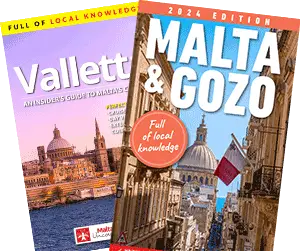
Check out my two guidebooks full of local knowledge and my best recommendations for your trip, and up-to-date for 2024 !
Malta & Gozo guide book Valletta : An Insider’s Guide to Malta’s Capital
Take the hassle out of planning your trip to Malta and be an informed traveller!
Get the best travel tips from Malta Uncovered delivered to you in bite-sized chunks by email. (Unsubscribe at any time!)
Was this article helpful? Share it with your friends!
Leave a Reply Cancel reply
Your email address will not be published. Required fields are marked *
Yes, I would like to receive emails from you with Malta travel tips.
Get the most out of your visit to Malta with Malta Uncovered guidebooks – full of local knowledge and up-to-date for 2024 !
© 2006-2024 Malta Uncovered. All Rights Reserved.


The Perfect 7-Day Malta Itinerary
Last Updated on January 15, 2024
by Maggie Turansky
Disclaimer: This article contains affiliate links. That means if you click a link and make a purchase, we may make a small commission. As an Amazon Associate we earn from qualifying purchases. For more information, see our privacy policy.

Though the island nation is incredibly small in size, planning out the perfect Malta itinerary can be a bit of a difficult task when considering all of the amazing things to do in this beautiful Mediterranean country.
While Malta may seem small (it is!), that doesn’t mean that it lacks amazing things to do and see and travellers could easily fill over two weeks on the Maltese archipelago and not get bored. If you don’t have an endless amount of time to devote to your trip, however, you can do and see quite a bit in just one week.
If you’re wondering where to go in Malta in one week, make sure to follow this itinerary in order to have the best trip to Malta possible!
Table of Contents
How Many Days in Malta?
It’s true, Malta is small, but don’t let this fool you into thinking that there isn’t much to see or do. The truth of it is actually quite the contrary and it is why many potential visitors wonder how many days to spend in Malta.
While you can cover a lot of ground in a short stretch of time, I wouldn’t recommend spending less than one week if you genuinely want to get the most out of your Malta trip.
Spending a full 7 days in Malta will allow you to explore its lovely cities and visit the myriad historical and UNESCO World Heritage Sites while also giving you enough time to relax in the Mediterranean sunshine and experience the stunning coastline with its crystal clear waters.

Getting To & Around Malta
As a Mediterranean island nation, the most likely (and straightforward) way to get to Malta is by plane. The Malta airport is located about 20 minutes from the capital of Malta, Valletta, and they serve a number of airlines across countless destinations both in Europe and internationally. It is possible to book a private airport transfer here.
You can also reach Malta by ferry from nearby Sicily with regular routes from cities like Catania or Palermo .
Once in the country, it’s easy enough to get around Malta using the extensive bus and ferry system, however, it may be tricky to organise if you happen to be staying on Gozo or outside of Sliema or Valletta on the main island of Malta where there are fewer connections. There are lots of areas to stay in Malta where it may be more practical to have your own vehicle.
If you want a lot of flexibility and ease of getting around, then consider renting a car. There are lots of car hire options in Malta and it’s a great way to see the country! You can browse car hire options here.
For those who do not want to bother with getting around independently, you can easily get to many places in Malta via organised day tours such as to Gozo. This, however, will end up being the most expensive option out there.
7 Days in Malta Itinerary
Day 1 – sliema.
Malta’s largest city of Sliema is the perfect place to base yourself on the island. A stone’s throw away from the historical capital of Malta, Valletta, Sliema is also incredibly well connected in terms of public transport with most buses passing through the city.
But while it seems like more and more people are basing themselves here, fewer people are really taking the time to get to know it. That is why I recommend spending the first day of your seven-day Malta itinerary in Sliema.
There are a number of things to do in Sliema and it’s a great place to get your bearings and really start enjoying your Malta holiday. Begin by having breakfast and a coffee at one of the trendy cafes that the city boasts. Take a couple of hours to have a leisurely stroll along Sliema’s seafront promenade, maybe taking the time to swim in the harbour.
As the sun begins to set, take advantage of a happy hour deal and enjoy a drink at a seaside cafe. End your day with a great local meal at Ta’Kris , one of the best restaurants in Sliema.
Where to Stay in Sliema
Mr Todd Hotel – This small hotel is located in the heart of Sliema and only a stone’s throw from the swimming areas that line the promenade. They have a number of clean and comfortable rooms on offer, 24-hour check-in, and a free breakfast included in the room rate.
Quisisana Apartments – If you’re looking for a different sort of accommodation, then these centrally located apartments can be a great choice. Centrally located in Sliema, they have a range of flats on offer that are all fully furnished with everything you may need.
Two Pillows Hostel — If you’re travelling solo or on a budget, then you can’t go wrong with this boutique hostel. The first hostel in Malta, this place offers clean and comfortable rooms (both dorm and private), a great location in Sliema, and a friendly and helpful staff.
Not quite what you’re looking for? Click here to browse other hotels in Sliema!

Day 2 – Valletta and the Three Cities
On the second day of your one week in Malta trip, it’s time to explore the lovely Maltese capital city of Valletta . A UNESCO World Heritage Site, this diminutive city is very much on the up and up as tourism goes and is one of the places to visit in Malta that you cannot miss.
I’d recommend trying to get an early ferry (they leave every thirty minutes from the Sliema terminal) to beat the crowds and the heat that can accumulate later in the day.
Walk along the city walls to the Upper and Lower Barrakka Gardens and enjoy the stunning views of the Mediterranean Sea, the Grand Harbour and the Three Cities and take the time to visit St. John’s Co-Cathedral and marvel at its impressive facades and collection of paintings by Caravaggio.
Pop in for lunch at Submarine, where you can get a fresh, made-to-order sandwich for a good price before catching the ferry to the Three Cities.
Spend your afternoon exploring the three small adjacent cities of Cospicua (Bormla), Vittoriosa (Birgu), and Senglea (L’Isla). Honestly, the best thing to do in all of the Three Cities is to get lost in their beautiful winding alleyways and enjoy the lovely traditional Maltese architecture.
Catch the ferry back to Valletta in the evening and enjoy a nice cocktail at Cafe Society before enjoying a delicious meal on the rooftop terrace at Rampila .
Valletta is very small and therefore doesn’t have a lot on offer when it comes to accommodation. A far better solution would be to base yourself in Sliema and visit Valletta from there, it’s easily accessible within a few minutes by ferry or bus.

Where to Stay in Valletta
Domus Zamittello Hotel – Located in the middle of lovely Valletta, this hotel is the perfect base for exploring this compact city. Situated within easy reach of the top sites and the ferries, there are several great rooms and breakfast available daily.
The Saint John – This hotel is excellent for those after a luxury stay in Valletta. Boasting countless opulent rooms to choose from, it’s perfectly located for exploring the town and the island and has a number of plush amenities for guests to enjoy.
Not quite what you’re looking for? Click here to browse other hotels in Valletta!

Day 3 – Marsaxlokk and Southern Malta
On the third day of your seven days in Malta, it’s time to venture further out on the island and explore the fishing village of Marsaxlokk (pronounced Mar-SASH-lock) and the highlights of Southern Malta.
Start your day the way the Maltese do — with a swim in the harbour! After you’ve had a shower and a pastizzi for breakfast, catch the bus and head to Marsaxlokk! While it may not look far on the map, the bus can take close to an hour if you factor in traffic.
This small fishing village has a great street market and a famous fish market that runs on Sundays (try to get there early if you’re visiting on that day!) that can be fun to browse, but it also has some of the best seafood on the island.

Next, head to the nearby St. Peter’s Pool. It is a bit of a hike to reach it, but the views are lovely and it can be a good way to work off all of that food! If it’s too hot you’re not up for a hike, many taxis will take you there for about €10-15.
This is an awesome place for cliff jumping if you’re looking for an adrenaline rush, but keep in mind that it can get quite busy at weekends so you might not find the perfect spot to bask in the sun if you don’t get there early.
This is also a great day to book a tour of the UNESCO-listed Ħal-Saflieni Hypogeum, as it’s en route to this area. Just keep in mind that they only allow a finite number of people in per day so it’s necessary to book months in advance .

Day 4 – Gozo
After spending three days on Malta, it’s time for a change of scene. This is why the fourth day sees you heading to the second-largest island in the Maltese archipelago — Gozo!
While Gozo is often considered a day trip there are quite a few things to do on the island and it offers a refreshing change of pace from the busy island of Malta.
To get to Gozo, hop on the bus to Cirkewwa and catch the ferry to the island. You can also drive – it is a car ferry.
They leave roughly every 45 minutes and the journey only takes about half an hour. Gozo is quite small, so it doesn’t matter too much where you might want to stay, but I would suggest basing yourself in its capital of Victoria.
Located in the centre of the island, it has the best bus connections to everywhere else you might want to go.

Spend your first day in Gozo exploring Victoria (Rabat) and its wonderful walled Citadella. After you’ve admired the views and maybe visited a couple of beautiful churches, it’s time to get to know a little bit more about Gozo’s up-and-coming wine scene.
There are a couple of vineyards to choose from, but I would especially recommend going for a tour and tasting at Tal Massar Winery. For such a small vineyard, the wines they produce are truly exquisite.
End your day back in Victoria with a wonderful dinner at the wonderful Maldonado Bistro , where their delicious meals and great atmosphere are impossible to disappoint.
Where to Stay in Gozo
The Duke Boutique Hotel – Located in Victoria, the biggest city on Gozo, this boutique hotel is an excellent place to base yourself on the island. They have a range of rooms available (all with air conditioning) and a free breakfast is included in the nightly rate.
Private Rental – Gozo has a range of fantastic private rentals such as this historic farmhouse with a pool and this beautiful sea view apartment .
Not quite what you’re looking for? Click here to browse other hotels in Gozo!

Day 5 – Gozo
On your second day on Gozo, it’s time to get out on the water! There are many options available to do this and it just depends on your own personal preferences! If you just want to spend a lazy day at the beach, I would recommend spending a few hours on the beautiful golden sands at Ramla Bay.
If you want to see as much of the archipelago as possible during your Malta itinerary, however, it is well worth going on a boat tour . We spent a wonderful day sailing between all three islands, stopping at countless swimming and snorkelling spots along the way.
No trip is complete without spending time on the islands of Gozo and Comino and this is one of the best things to do in Malta, so of course it is included in this itinerary.
If a full-day sailing trip isn’t quite your cup of tea, Gozo is also quite well-served for quick boat rides to the Blue Lagoon on the island of Comino. If you intend to go here, however, it is worth noting that it gets very busy later in the day so it’s best to get there early.
Alternatively, you can spend this day exploring more of what the island of Gozo has to offer. Head to Xwenji Salt Pans to see how natural Gozitan sea salt is made or enjoy some of the beautiful beaches on the island while basking on the golden sands of Ramla or the quiet beach at Xlendi.
You could also take in some of the oldest Neolithic structures standing today (they’re older than the Pyramids of Giza!) at the Ġgantija Temple.

Day 6 – Mdina and Rabat
On day six of this itinerary for 7 days, it’s time to head back to the main island of Malta and explore the beautiful medieval walled city of Mdina and its adjacent town of Rabat!
Catch the ferry back from Gozo and spend your afternoon discovering the wonderful city of Rabat. The town is small and walkable, but the back alleys and architecture are lovely. It is also well worth taking the time to explore the catacombs of St. Paul’s Cathedral — they are just as bizarre and eerie as they sound!
Spend your evening in gorgeous Mdina, which actually served as a filming location for the first season of HBO’s Game of Thrones .
Pop in for a glass of wine and a sharing platter from Fontanella Wine Bar while watching the sunset from their roof terrace. After the sun has set, take some time to wander around Mdina. After the day-trippers leave, the city retains a peaceful elegance and it will be clear why it is nicknamed “The Silent City.”
Where to Stay in Rabat/Mdina
Adelphi Boutique Hotel – Located in the centre of Rabat and only a five-minute walk from the walled city of Mdina, this small hotel is a great place to stay. They have a few clean and comfortable rooms available and a free breakfast included.
Point de Vue – If you want to stay in the charming walled city of Mdina, you can go wrong with this hotel. Ideal for those with a higher budget looking for a bit of luxury, this hotel has a number of clean, spacious, and air-conditioned rooms available, a full hotel bar, and an excellent free breakfast each morning.
Not quite what you’re looking for? Click here to browse other hotels in Rabat!

Day 7 – Northern Malta
Spend the final day leisurely exploring the north of the island. While this is where the majority of Malta’s resorts lie, it is also where the most beautiful sandy beaches are. So why not spend your last day on Malta lazily soaking up the rays on Golden Bay beach?
If you want to do something a bit more active to let your seven days in Malta go out with a bang, then go for a long walk along the stunning Dingli cliffs! And if you’re dying to get back out on the water still, it can be well worth taking a boat trip to explore the beautiful Blue Grotto and stare in awe at Malta’s amazing geology.
End your day back in Mdina with a casual dinner at one of the many great restaurants and maybe a gelato from the delicious Fior Di Latte.
Malta is an incredible destination with a number of things to do. While seven days is a great amount of time to spend on this wonderful archipelago, one could easily spend more and not get bored. Take your time to get to know this island nation and I assure you that you will not be disappointed.
Are you planning to visit Malta? Have any questions about this itinerary? Let us know in the comments!

Related Posts:

A Guide To Mdina & Rabat, Malta

10 Tips For Planning a Trip to Malta

Malta or Cyprus: Which Island Nation to Visit?

About Maggie Turansky
Maggie is a co-founder and writer for The World Was Here First. Originally from the US, she has lived in five different countries and has travelled to dozens more, both solo and with her partner, Michael. She particularly loves exploring Spain and spending time in the Caucasus and the Baltics. Read more about Maggie
Hi Maggie, Thank you for giving out such a detailed description of your experience. I am planning a 7 day trip to Malta from the Netherlands . I had a couple of questions and would appreciate it if you could answer and help me out. 1. Do you suggest starting the trip from Valletta or ending it there ? 2. Would you suggest staying at just Valletta and cover the entire island by renting a car or would you suggest we can spend 3 night In Valletta and 2 In Gozo ?
Hi Gayathri, the itinerary written above is a great outline on how I would suggest spending 7 days in Malta 🙂
Thank you so much for your informative article. We are visiting Malta this week and will be using your suggestions. Luckily, we have a hotel booked in Sliema. Also, we now know that we need to take some warm clothes with us! Maggie
Happy you found the article helpful! Hope you have a great trip 🙂
Hi Maggie Many thanks for your tips and experience. I’ ve read from other blogs, there are a lot of transportation issues with buses, and despite short distances, you can waist a hell of a lot of time for only a few km. Is it the case at the end of March? I’m currently planning a 11 days in Malta, from 28th of March, 2021. Many thanks for your advise. Rgds. Mike
Hi Mike, thanks for your comment! It’s true that in the busier months, buses can get full in Malta quite quickly and the drivers won’t stop to pick up other passengers. I’m not sure if this will be as big of a problem in March (my gut says no), but it is definitely something to be aware of. Regardless, we’ve really had only pleasant experiences with the Maltese bus system.
Hi Maggie Thanks for interesting tips – very useful. We plan a holiday in Malta from Australia. What time of year would you recommend ?
Hi Chris, thanks for your comment! Personally, I think that mid-late September is the best time to visit Malta — the majority of the tourist crowds have dissipated, the weather is perfect and the water is at its warmest of the year. However, there really isn’t a bad time to visit Malta 🙂 Hope you have a great trip!
Hi Maggie, Thank you for your article. I’m thinking about 1 week in Malta in the second half of February. We want to see as much as possible. Do you think this term is suitable because of the weather? Thank you.
Hi Divan, I think 1 week in Malta in February sounds like a great idea! The weather will be warmer than anywhere else in Europe, however, the water will still probably be too cold for swimming, so be aware of that! Hope you have a great time 🙂
Dear Maggie, I really liked this page and your description. Thank you fo rmaking such a nice page. I live in Zurich. Because of some last min changes, I am now planning to visit Malta from 24th dec to 2nd Jan. I have few questions : a. Do you recommend to stay at different places? I thought to have the hotel at one place, and then, then go around. b. Is it worth staying 1 night at Gozo. ? c. Is Malta closed during christmas time , 24th, 25th , 26th dec? d. Any new year party venue suggestions?
Best Regards, Abhishek
Hi Abhishek, to answer your questions: a. I recommend finding 1 or 2 places to stay throughout your time there. Malta is small so it’s easy enough to get around from just one base. b. I think that Gozo is worth a night, however, you can see a lot of it if you only want to visit for a day trip, as well. c,d. I’ve never been to Malta over Christmas and NYE so I can’t speak on these issues, unfortunately. Hope you have a great trip!
I’m planning to stay 10-14 days to get a good look at the Knights Templar architecture, the other medieval historically significant forts. A sail around the island and to Gozo seems like a very nice way to get a sailors view as in ancient days. I’ve been reading about the history class of Malta and now reading about a travelers experience I’m eager to go. Late March because I think it will be very nice. Thank you for the vivid descriptions.
Hope you have a great trip, Maribeth!
Thanks Maggie for this very informative article. We have planned a seven day trip to Malta and would be following most of your itinerary. How are charges for public transport? Or renting a car would be a better option? We are also planning to skip three cities near Valletta and have more time at north Malta. How does this sound?
Hey Vivek, glad you found the itinerary useful! Public transport in Malta is frequent and affordable and you can use it to get most anywhere you need to go on both Malta and Gozo. We relied solely on the bus network while there and never felt as if we needed to hire a car. As for the Three Cities, they are beautiful and worth a visit, however, if you’re more interested in spending time by the beaches in the north of Malta, go ahead and do that! Hope you have a great trip!
Do you suggest moving around cities each day or staying in one city and doing day-trip using public transport?
Hey Angus, depending on how long you are planning on staying in Malta, I would generally recommend limiting your stay to one or two towns on the island and a couple of nights on Gozo. Malta is small and it’s easy to get around. The easiest place to base yourself on Malta would be in Sliema, which is close to all the transport links. You can get to most places on the main island within an hour on public transport. Hope this answers your question!
Thank you so much for this Maggie; we’re off to Malta for a week at the end of June so I’ll be following this itinerary closely!
So glad I could help! Hope you have a great trip 🙂 We absolutely loved Malta and can’t wait to go back!
Hello Maggies, I wish you see this question before end of the day, if I am going to follow the exact above travel itinray , how many hotels do I have to book ? can I book the whole 7 days in Sliema and move around between these cities, or do I have to book in Gozo starting from day 4 till end of the trip, please help as I can’t visualise it properly
Generally, I would recommend to book 3 different hotels for this trip. 1 in the Sliema/Valletta area, 1 on Gozo and 1 in the Mdina/Rabat area
Leave a Comment Cancel reply

17 Top-Rated Tourist Attractions in Malta
Written by Lisa Alexander Updated May 11, 2023 We may earn a commission from affiliate links ( )
In the Mediterranean Sea south of Sicily, the Maltese Islands (Malta, Gozo, and Comino) have a fascinating heritage. Being close to Tunisia, there is a distinct North African influence. The Maltese language is derived from Arabic mixed with Italian.
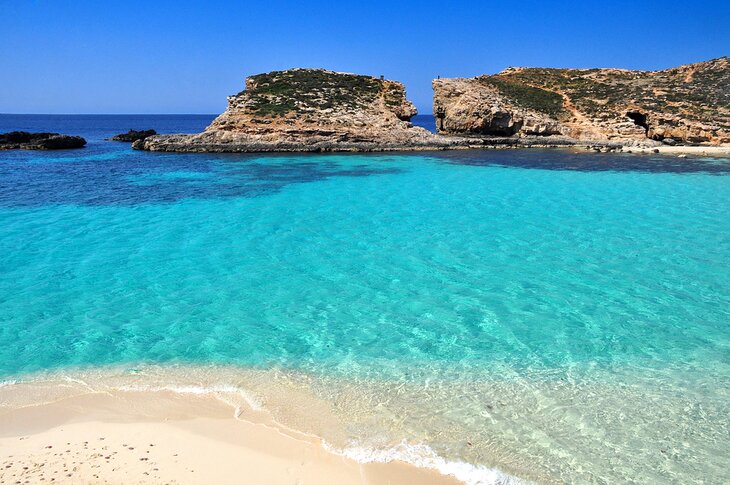
The country is also fiercely proud of the legendary Knights of Malta, who fought off the Turks and launched the Crusades.
Under the scorching sunshine, Malta's palm-tree-fringed landscape is dotted with beautiful places to visit, including picturesque hilltop towns, peaceful seaports, and colorful fishing villages.
Packed with cultural attractions, the capital city of Valletta is an ideal base to explore the Island of Malta. As a traveler, you will appreciate Valletta's array of hotels, restaurants, historical sites, and cultural events.
Across the harbor, Sliema has less culture but more entertainment options and caters to 20-something travelers and students on school breaks. The Island of Gozo is the best choice for relaxing beach vacations.
Malta's weather is perfect in spring and autumn. During the hot summer months, villages come to life with religious festivals and outdoor concerts.
Plan your visit to these enchanting islands with our list of the top things to do and tourist attractions in Malta.
1. Valletta: Malta's Elegant Capital
2. the idyllic island of gozo, 3. the medieval hilltop town of mdina, island of malta, 4. historical attractions in rabat, island of malta, 5. ħal saflieni hypogeum, island of malta: a neolithic cult site, 6. prehistoric tarxien temples, island of malta, 7. blue lagoon, island of comino: nature's perfect swimming pool, 8. the blue grotto, island of malta, 9. breathtaking views at dingli cliffs, island of malta, 10. golden bay beach, island of malta, 11. ghajn tuffieha bay and gnejna bay beaches, island of malta, 12. the seaside charm of mellieha, island of malta, 13. ħaġar qim temples, island of malta: a prehistoric megalithic site, 14. mnajdra temples of the maltese bronze age, island of malta, 15. siggiewi, island of malta: a traditional maltese village, 16. the country village of zebbug, island of malta, 17. family fun times at popeye village, island of malta, map of tourist attractions in malta.
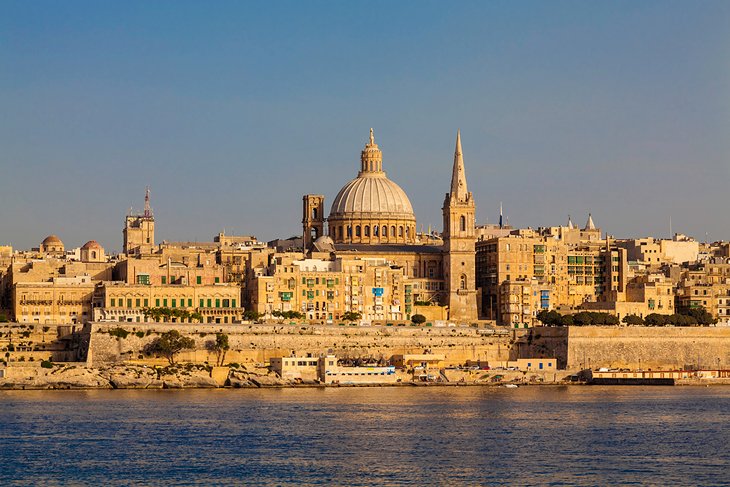
Valletta is the elegant capital of the Republic of Malta. The entire city is testimony to the grandeur of the Knights of Malta, the European noblemen who were granted the Maltese Islands by the King of Spain in 1530.
The Knights created a capital worthy of their aristocratic stature, on par with other great European capitals. Valletta's regular grid plan and orderly public squares reveal the Knights' logical 16th-century urban planning.
You can easily navigate this small city that is bounded by two harbors: the Grand Harbor and Marsamxett Harbor. It takes less than an hour to walk across the entire city.
The heart of the city is St. John's Co-Cathedral , a 16th-century church built by the different Orders of the Knights, hailing from various countries such as France, Spain, and Italy. The moment you step into this magnificent sanctuary, you are awestruck by the lavish interior with its opulent gilded decor.
Nearby is the immense Grandmaster's Palace , once the residence of the Knights of Malta. This palace boasts splendid paintings, as well as an armory, that tell the story of the Knights' military victories.
If you appreciate culture and historic monuments, Valletta is one of the best places to visit on the Maltese Islands. Malta's most modernized city, Valletta is packed with tourist attractions and is a convenient base for exploring the Island of Malta without a car. The island has an efficient bus system with Valletta as its hub.
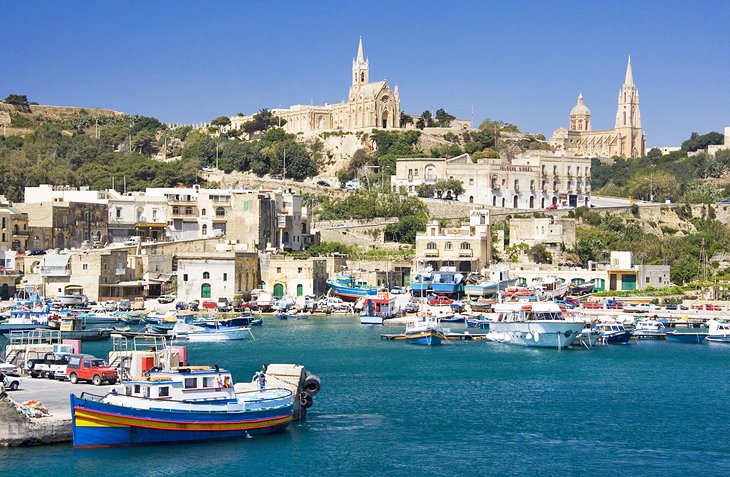
The Island of Gozo is the most idyllic destination of the Maltese Islands. With its quiet towns and pristine beaches , this little island is the perfect place to enjoy a relaxing vacation for several days or even a weeklong stay.
Although Gozo is less developed than Malta, the island has plenty of cultural attractions: a fortified medieval city, Victoria ; a bustling seaside resort, Marsalforn ; and the most important archaeological site of the Maltese Islands, Ġgantija Temples , dating back to around 3500 BCE.
The countryside of Gozo offers a delightful retreat from the modern world. A patchwork of small farms covers the island's valleys and rolling hills. Traditional villages perch above the landscape, while the hillsides lead down to protected beaches and quaint old fishing ports. Even the tiniest towns have grandiose Baroque churches.
A favorite beach is at Ramla Bay with a wide, sandy shore and gentle waters that are safe for swimming. This well-equipped beach welcomes visitors with excellent facilities: lounge chair and umbrella rentals, showers, restrooms, changing areas, and snack bars.
The Island of Gozo is a short ferry ride from Cirkewwa on the Island of Malta.
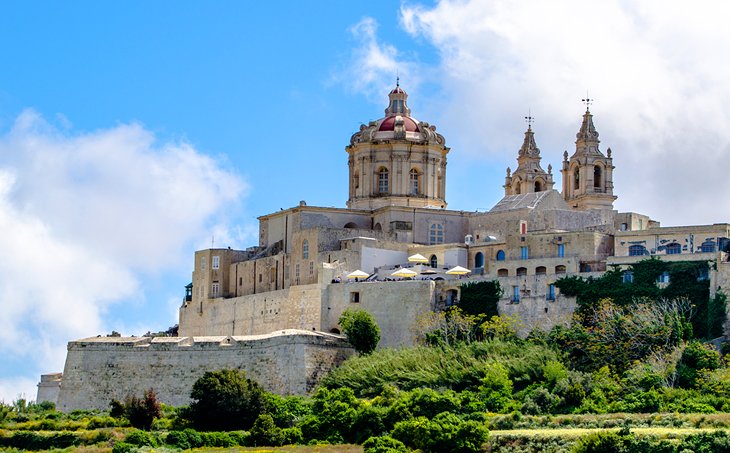
Step back in time and experience the allure of a walled medieval town. You must pass through the dramatic Main Gate to enter Mdina. Within the city's immense, ancient ramparts is a delightful world of car-free streets and beautiful, old sandstone buildings.
The entire town is a UNESCO World Heritage Site , brimming with historic monuments and cultural attractions such as its glorious Baroque cathedral, the 17th-century Carmelite Priory, and several old aristocratic palaces.
The Palazzo Falson Historic House Museum (Villegaignon Street) offers the chance to see an authentic medieval palace, decorated in the original style. The Palazzo Falson also displays exquisite art, antiques, and Oriental carpets, as well as a collection of ancient coins.
The Palazzo Vilhena (Saint Publius Square) is a stately 18th-century Magisterial Palace that now houses Malta's National Museum of Natural History .
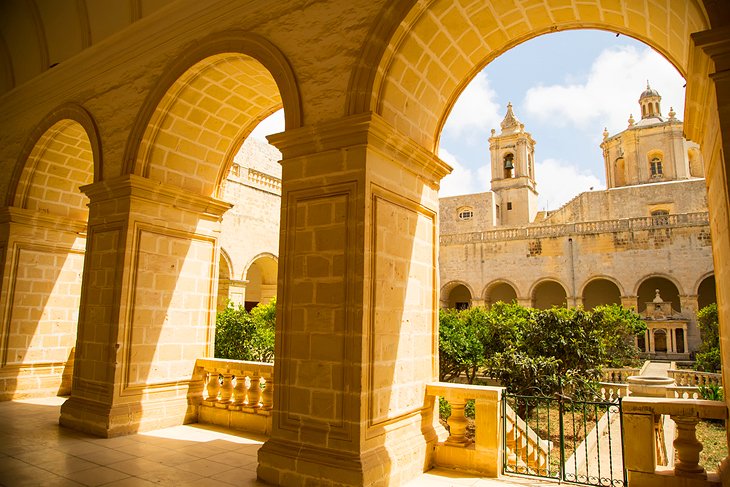
Just outside the Mdina ramparts is the neighboring town of Rabat. You can see both cities in the same day; Mdina and Rabat are sometimes considered to be one unified urban area.
In Maltese, the word "Rabat" means "suburb." Rabat is less touristy and more modern than Mdina, but there are noteworthy historical attractions.
One of the hidden gems is the Casa Bernard , a grand 16th-century house that is still a private residence but is open to the public for guided tours. The house is decorated with antique furniture, masterpieces of painting, and noteworthy objets d'art.
The Domvs Romana provides a glimpse of everyday life during the ancient Roman era, with exhibits about fashion, entertainment, and cuisine. The museum stands on the ruins of a Roman aristocratic townhouse and contains some of the finest 1st-century BCE Roman mosaics in the world.
The 17th-century Parish Church of St. Paul's stands above St. Paul's Grotto , where it is said that Saint Paul found refuge during his stay in Malta. Next to the church, the Wignacourt Museum displays ancient Roman artifacts and paintings by Mattia Preti as well as other European artists.
Dating back to the 15th and 16th centuries, St. Dominic's Convent is an important pilgrimage destination because it contains a marble statue of the Virgin Mary that is considered miraculous. The convent's courtyard garden was used in the filming of Game of Thrones .
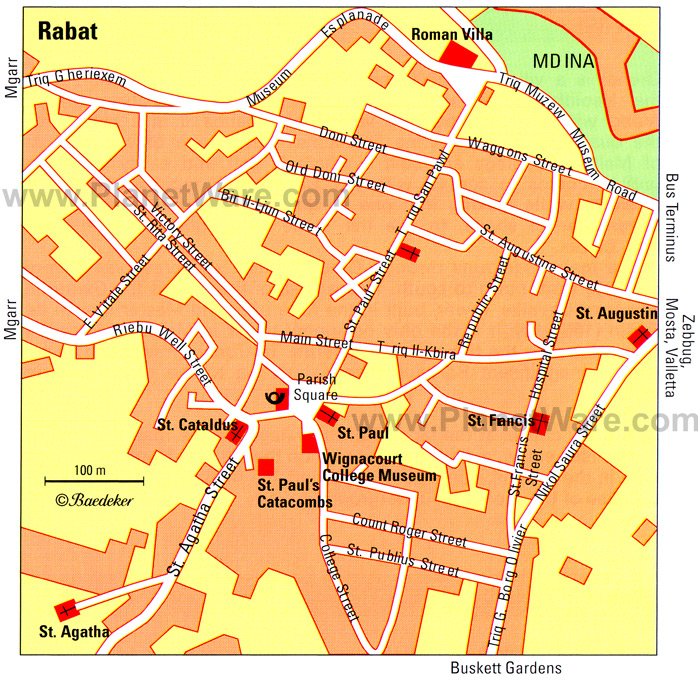
The massive dimensions and sheer mystery of Ħal Saflieni Hypogeum takes your breath away. This Neolithic-era underground cemetery is designated on the UNESCO World Heritage List because of its cultural value.
Ħal Saflieni Hypogeum has provided archaeologists and scholars with intriguing clues about the Neolithic mindset and culture. The complex stands as a rare testimony to a vanished civilization.
Visiting this site offers a beguiling experience. On a guided tour, you enter the site at ground level. Then, you will walk through underground passages and stairways to descend down into three levels of superimposed chambers. The lowest two levels are man-made caves, entirely carved out of limestone rock.
Natural light reaches the middle level of the complex, but not the lowest level. Archaeologists speculate that Neolithic-era people used some form of artificial illumination such as torches.
The lowest level is the chamber known as the " Holy of Holies ," which is over 10 meters below the entrance to the first level at the top. Using your imagination, you might try to envision how this chamber was used by prehistoric man to perform burial rituals and ceremonies.
The site is remarkable for how old it is (4000 BCE to 1500 BCE) and for the excellent state of preservation, complete with beautiful sculpted details and paintings in red ochre. It is also fascinating the way structural elements of Ħal Saflieni Hypogeum mirror the architecture of contemporaneous (prehistoric-era) megalithic sites such as the Tarxien Temples.
Some of the artifacts found in Ħal Saflieni Hypogeum are now displayed at the National Museum of Archeology in Valletta, including clay sculptures; stone figures of birds; and The Sleeping Lady , a rare prehistoric object that depicts a woman lying on a couch.
Tip for Tourists : Book ahead! The site is open to the public for 50-minute guided tours. It is recommended to reserve your Hypogeum tickets online in advance for a specific day and time. For reasons of conservation, Ħal Saflieni Hypogeum has a limit of 10 visitors every hour.
Address: Burial Street, Paola, Island of Malta
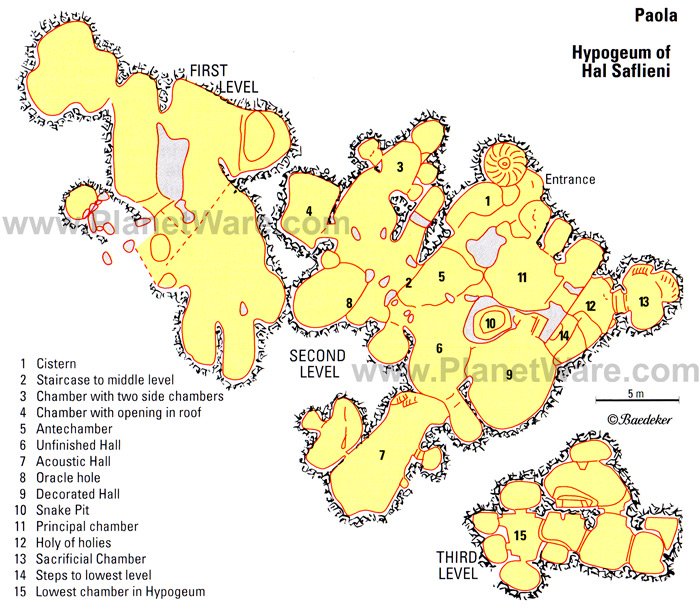
The UNESCO-listed Tarxien Temples is the largest and best-preserved prehistoric cult site in Malta, consisting of four megalithic structures. Excavated in 1914, the site covers an area of 5,400 square meters and displays the artistic achievements of Malta's mysterious prehistoric culture during the " Temple Period " (Late Neolithic Period) between 3,600 BCE and 2,500 BCE.
Stone reliefs and sculptures that were found here are represented on the site by excellent reproductions; the originals are displayed in the National Museum of Archeology in Valletta.
The stone walls of the four adjoining temples are decorated with surprisingly intricate spiral patterns and animal figures. The decorative South Temple contains the largest collection of art, including reliefs that depict goats, pigs, bulls, and a ram.
You will also find the remnant of a statue depicting a fertility goddess with robust legs, small dainty feet, and a pleated skirt. (Unfortunately, the top portion of the statue was missing when it was uncovered by archaeologists.)
The East Temple is made of sturdy slab walls with recognizable oracle holes. The Central Temple features a six-apse architectural plan and has an arched roof that reveals technically advanced construction techniques.
Tip for Tourists : The Tarxien Temples archaeological site is within easy walking distance of Ħal Saflieni Hypogeum . Both sites could easily be visited on the same day.
Address: Neolithic Temples Street, Tarxien, Island of Malta
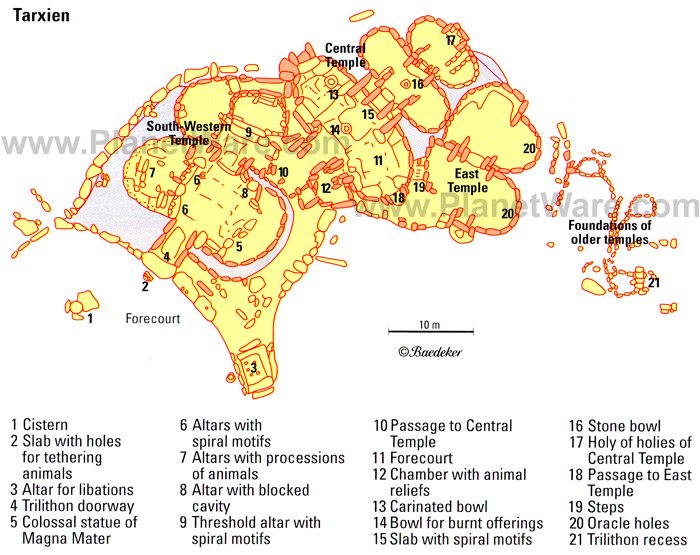
The Blue Lagoon is a mesmerizing scene of crystal-clear turquoise waters lapping over a white-sand seabed. This expansive lagoon gives the impression of being a giant swimming pool because the water is temperate, there are no waves, and the shallow end is safe enough for children.
Wonderful for swimming, splashing around, or floating on inflatable tubes, the core of the lagoon is roped off to boats. The lagoon is equivalent in length to several Olympic-size swimming pools. Good swimmers can cross to the cove on the other side.
The lagoon has a small beach with umbrellas and lounge chairs available for rent. The other option is sunbathing on the scorching-hot rocky hillside. At least, you can count on refreshment stands set up around the lagoon.
Things to do on Comino Island include nature walks, hiking, and water sports such as snorkeling and scuba diving.
Tips for Tourists : During high season, this beach is often crowded by 10:30am, so it is best to arrive early. The lagoon is less crowded after 4pm, however the returning ferries stop running around 5pm.
The ferry ride from Mgarr on the island of Gozo takes about 15 minutes to arrive at the Blue Lagoon on the Island of Comino. From the Island of Malta (departing from the port of Marfa or Cirkewwa), the ferry ride to the Blue Lagoon takes about 30 minutes.
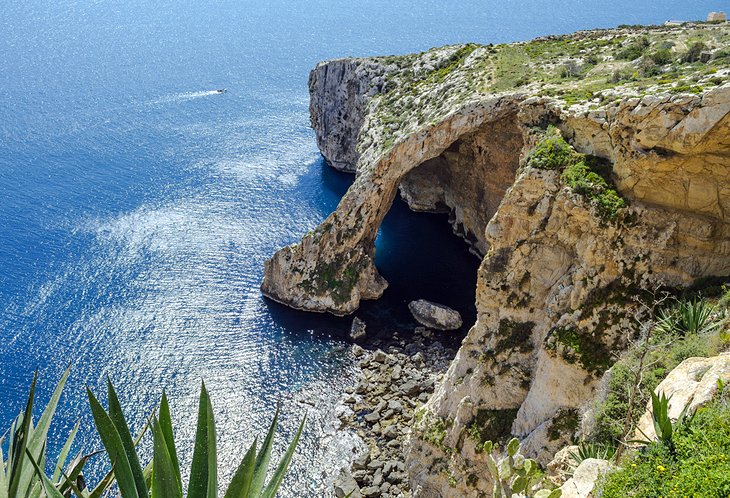
The breathtaking coastal vistas on the approach to the Blue Grotto provide an exciting introduction to this spectacular nature site. You arrive here by taking a scenic route along a winding cliffside road high above the Mediterranean Sea.
The scenery has a serene, mesmerizing quality with brilliant blue waters sparkling in limestone caves. It explains why according to mythology, the Blue Grotto was home to the sirens (sea nymphs), who captivated sailors with their charms.
You can take a guided boat tour in one of the brightly painted Maltese fishing boats called luzzus . Boats leave frequently year-round, when the sea is calm. The 20-minute joyride speeds through the sea past six caves, including the Blue Grotto, a 30-meter-high cave with a luminous pool of cobalt-hued waters.
Tip for Tourists: The best time to visit is early in the day, ideally before 2pm, when the sunlight best illuminates the water.
The village of Wied iz-Zurrieq (just one kilometer away from the Blue Grotto) has many souvenir stores, ice-cream shops, and cafés, as well as cliffside restaurants with marvelous views. You will enjoy a meal at one of the restaurant terraces overlooking the gorgeous expanse of azure sea.
The Blue Grotto is also a popular scuba diving destination because of its bountiful marine life.
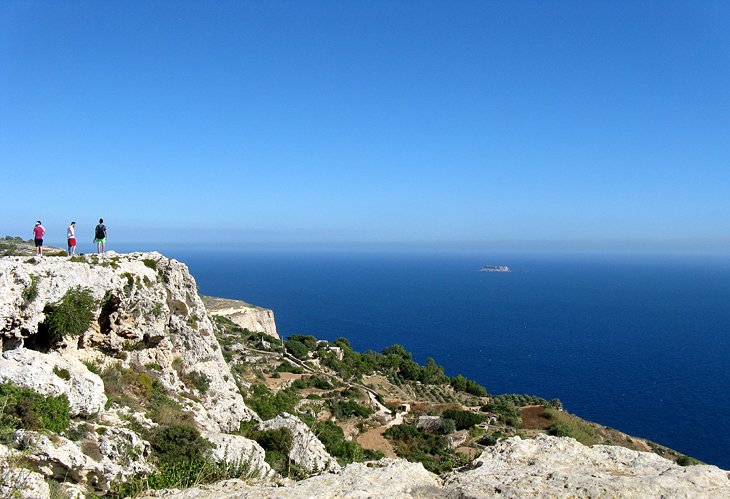
For awe-inspiring coastal scenery, take a short drive or bus ride from the Blue Grotto in Wied iz-Zurrieq to the Dingli Cliffs. The appeal (and the drawback) of this location is its remoteness.
The sheer 250-meter Dingli Cliffs plunge dramatically into the Mediterranean Sea, and the sloping hillsides are fertile land used by small farms.
The highlight of Dingli Cliffs is the viewpoint that offers stunning seaside panoramas.
Besides a short walking trail, there is nothing at Dingli Cliffs except a tiny hilltop chapel (closed to the public), which is devoted to Saint Mary Magdalene.
Tips for Tourists : Keep in mind that there are no restrooms or cafés. Sometimes you might find a pop-up souvenir and refreshment stand. Dingli Cliffs does not have a visible bus stop (ask the bus driver where to get out), and buses run infrequently, but the sensational photo-ops make it worth the trek.
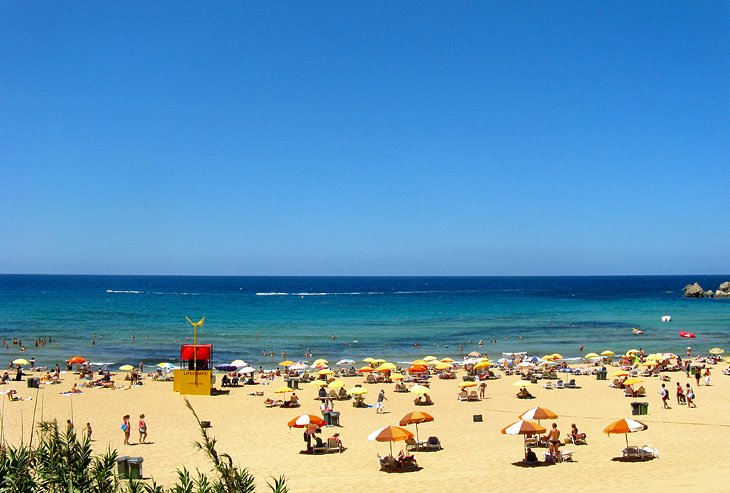
Golden Bay in Northwest Malta is one of the island's prettiest beaches. This picturesque and well-maintained beach features sheltered sandy shores tucked away behind a mountainous coastline and sloping cliffs.
The beach has an extremely wide shoreline with soft golden sands. The clean, calm waters are safe for swimming. You could spend the day here sunbathing, while listening to the soothing sound of waves lapping against the shore.
Lounge chairs and beach umbrellas are available for rent, and the site has well-maintained facilities including public toilets and changing rooms. There are also cafés and restaurants with terraces overlooking the shoreline.
The beach is found next to a luxurious five-star hotel, the Radisson Blu Resort & Spa, Malta Golden Sands , which has three restaurants, a café, snack bar, swimming pool, and fitness center.
Unlike other beaches in Malta, Golden Bay Beach is far away from street traffic, which makes it a perfect get-away-from-it-all seaside escape. At the same time, Golden Bay Beach is easily accessible by car or bus; the bus stop is only a five-minute walk away from the beach.
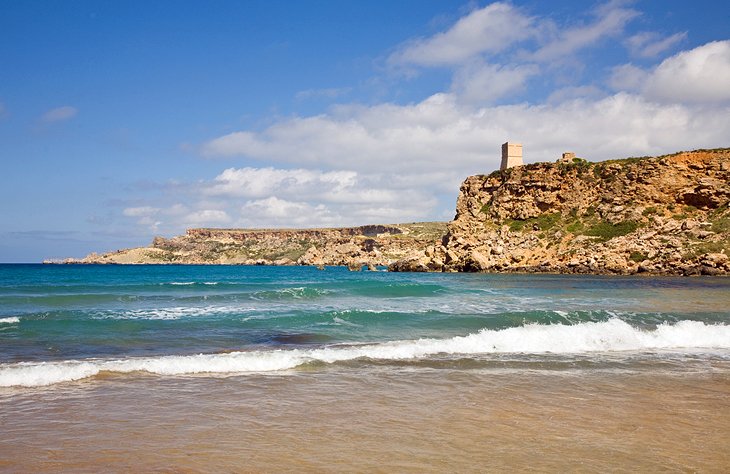
If you are exploring the area by car, it's worth driving two kilometers from Golden Bay to the unspoiled beach at Ghajn Tuffieha Bay. The beach is surrounded by cliffs and sloping hillsides. You get here by climbing down 200 steps.
Ghajn Tuffieha Bay Beach feels secluded in nature, except for the umbrellas and lounge chairs for rent, public restrooms, and a snack bar. Considered one of Malta's top beaches, Ghajn Tuffieha is favored by locals who appreciate the quiet, peaceful environment. The waters are safe for swimming except when the red flag is up (indicating strong currents).
Continuing seven more kilometers from Ghajn Tuffieha Bay is Gnejna Bay , a small protected bay surrounded by steep limestone cliffs. You must hike down a flight of steep steps to reach the gorgeous orange-sand beach, which is popular with swimmers and snorkelers. Water ski and canoe rentals are also available, as well as public restrooms and food stands.
Between Ghajn Tuffieha Bay and Gnejna Bay is the rural village of Mgarr in a bucolic landscape of vine-covered hills and small farms. Outdoorsy types will enjoy the scenic hiking trails from Mgarr into the countryside and along the coast to Gnejna Bay.
Nearby are ruins of Roman baths and ancient cart ruts (grooves in the limestone plateau), which intrigue scholars and visitors alike.
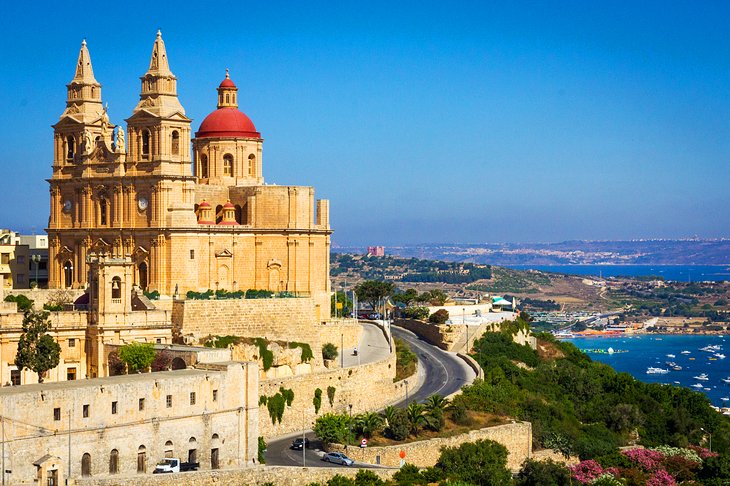
Mellieha is a family-friendly seaside destination in the scenic countryside of Northwest Malta. The beach is next to a busy road, which detracts from the natural beauty. However, the Mellieha Beach has the largest stretch of sandy shore on the Maltese Islands with a one-and-a-half kilometer shoreline of fine white sand.
Mellieha Bay has very gentle shelving, which makes it shallow enough to stand even quite far away from the shore. The calm waters with no undercurrents are safe for children to wade or swim.
The picturesque village of Mellieha stands on a craggy hilltop overlooking the pastoral landscape of rocky outcrops, vine-covered hills, and small farms.
At the highest point in the village, the lovely 19th-century Baroque Parish Church of Our Lady of Victory (Parish Square) contains the Shipwreck of Saint Paul painting by renowned artist Giuseppe Cali and a statue of the Virgin Mary.
The church's Virgin Mary statue is venerated during the annual Mellieha Village Festa . This nine-day festival begins on August 30th and features snack kiosks, traditional Maltese desserts, marching bands and fireworks.
Opposite the steps that lead down from the Parish Square is a mystical cave-shrine dedicated to the Madonna. An underground spring running through the cave is said to have miraculous healing powers.
Mellieha also has a protected habitat for migrating birds in the Ghadira Nature Reserve .
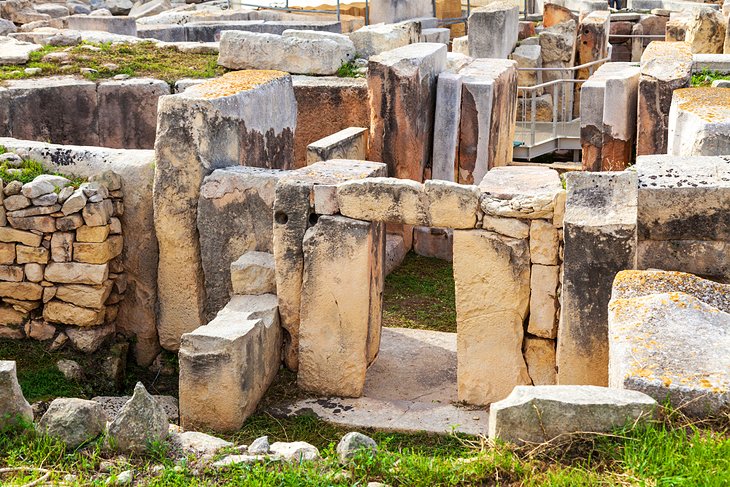
The UNESCO-listed Ħaġar Qim Temples appeal to travelers who are fascinated by Malta's megalithic sites. Perched on a rocky hilltop plateau, this archaeological park on Malta's rugged southern coast overlooks the Mediterranean Sea and the Island of Filfla in the distance.
Dating between 3600 BCE to 3200 BCE, the ancient site was buried under mounds of earth until its discovery in 1839. The facade, made up of two upright stones supporting one stone lintel, has a striking entrance.
The builders of these remarkable prehistoric temples did not use a symmetrical layout of the three chambers. Instead, the chambers and apses connect with one another but not in a uniform plan. Each temple was built as an individual place of worship.
The largest megalith of this 5,000-year-old site is more than seven meters long and weighs approximately 20 tons. The little boulders, the size of bowling balls, strewn about the site were used like castors to move the massive megaliths into place.
Artifacts found on the site, including the Fat deities, believed to be symbols of fertility, and the nude Venus of Malta , are on display at the National Museum of Archeology in Valletta.
Address: Triq Hagar Qim, Qrendi QRD 2501
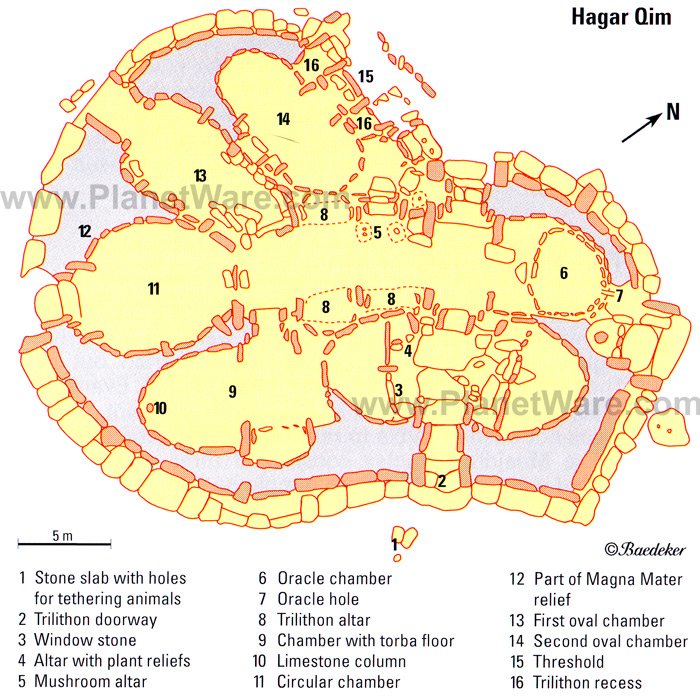
Another UNESCO World Heritage Site , the Mnajdra Temples are found 500 meters away from the Ħaġar Qim Temples in an isolated stretch with stunning sea views. This archaeological complex includes three different structures.
The oldest structure, the South Temple, dates to around 3600 to 3200 BCE. The other two temples were built between 3150 BCE and 2500 BCE. These three structures represent a significant stage in prehistoric human development known as the Ġg antija Phase (circa 3000 BCE to 2200 BCE), which was an important period of the Maltese Bronze Age.
The most intriguing feature of Mnajdra Temples is the doorway of the South Temple. The doorway is flanked by two immense blocks with small holes that mark the position of the rising sun on the Equinoxes (first day of spring and autumn) and the Solstices (the first day of summer and winter).
Address: Triq Hagar Qim, Qrendi QRD 2502
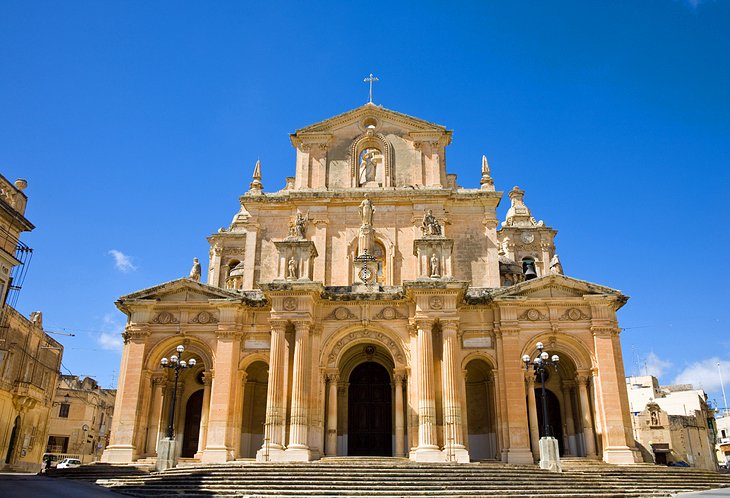
This traditional Maltese village is in southwestern Malta between Rabat and Marsaxlokk in the fertile Girgenti Valley , which begins near the Dingli Cliffs .
At the center of the village, the Parish Church of Saint Nicholas features an impressive Baroque facade created by Lorenzo Gafà in 1693. The church is usually closed except during the annual festival.
The Siggiewi Festa (Feast Days), honoring Saint Nicholas, is held at the end of June. The church is illuminated with multicolored lights, and its relics are paraded around the town. The four-day festival includes fireworks, brass band music, and authentic Maltese treats (such as pastry stuffed with dates and nougat made with almonds or peanuts).
From May through October, Siggiewi hosts the Maltese Summer Folklore Nights at the Limestone Heritage Park and Gardens. This lively event showcases Maltese culture with folkloric dance and music performances, as well as a buffet featuring delicious Maltese dishes. The Limestone Heritage Park and Gardens is also a popular venue for outdoor weddings.
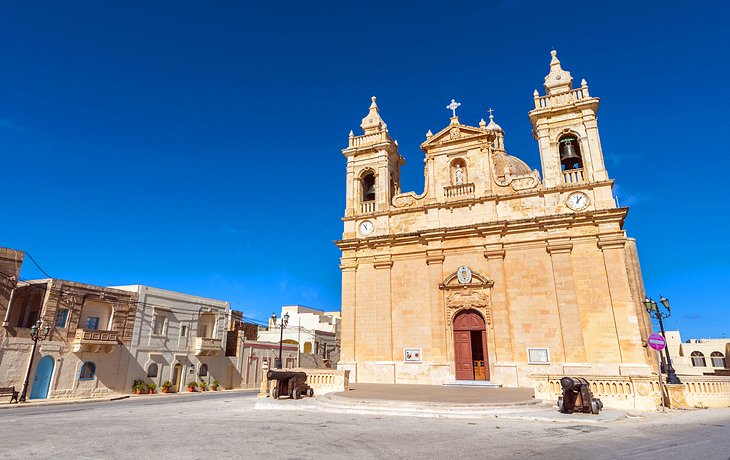
This country village has a history dating back to 1436. The Grand Master de Rohan elevated Zebbug to a city, renaming it Citta Rohan, and built the triumphal arch at the entrance of the town.
The main square is graced by the twin-towered Baroque Parish Church of Saint Philip with an ornately decorated interior. The initial design was created by Cassars, the architect of Saint-John's Co-Cathedral in Valletta.
Zebbug celebrates its annual religious festival, the Festa of Saint Philip , at the Parish Church in June. The celebrations include marching band processions, fireworks, and colorful decorations. A highlight of the festival is when the silver statue of Saint Philip is paraded through the village.
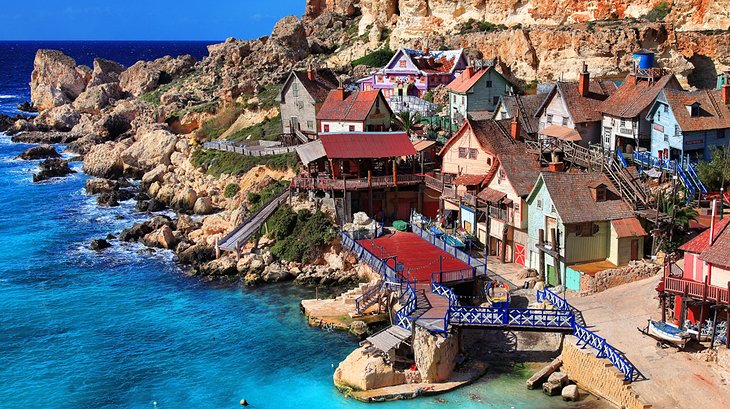
For families with young kids, the Popeye Village in Mellieha offers an entertaining place to spend the day. This charming tourist attraction was originally a film set for the 1980s movie Popeye starring Robin Williams and has become one of the top tourist attractions of Malta.
The film set is a quaint seaside village made of 20 wooden structures. You are greeted by Popeye the sailor and then can take a tour of the village to find the post office, bakery, firehouse, and other buildings. Popeye Village also has a beach, sunbathing decks, and a souvenir shop.
The village celebrates holidays, such as Carnival, Easter, and Halloween, with festive decorations and amusing activities.
Address: Popeye Village, Anchor Bay, Triq Tal-Prajjet, Mellieha, Malta

More on Malta
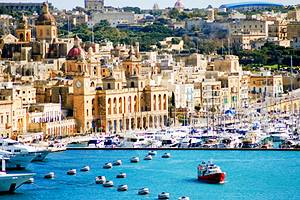

- Short Breaks
- Gozo & Comino
- Swimming Spots
- Activities & Sports
- For the Family
- Sustainable Holidays
- Studying in Malta
- What’s On
- Book your trip
- Accessibility
- Transportation
- Who Can Help
- Live Malta Cams
- Essential Information
- Maps & Guides
- Tourist Info Centres
Practical Info
What currency is used in Malta? What is the weather like in April? How easy is it to buy property in Gozo? Answers to these and many other questions can be found in this section, together with useful tips, bank information and much more. All those little details that put your mind at rest before you travel, as well as information you may need while you’re here.
More info can be found in the Facts & Tips section and on the FAQ page .
If you still can’t find the answer to your questions, just go ahead and Contact Us .

Travel Blog
Is Malta Worth Visiting in 2024? Honest Review
Are you wondering if Malta is worth visiting? I have got the answer for you, and it is a wholehearted YES – Malta is worth visiting in 2024!
Slow travelers, couples, and adventure travelers will find themselves drawn to Malta for many different reasons. Even families love Malta – for several reasons. I have just returned from Malta and totally loved it.
The small island is located between Sicily and North Africa- and has an interesting mix of cultures to show for it. It offers not only the most stunning turquoise water in all of Europe but we also know it for its high density of cultural sights.
Many people know Malta for being the backdrop of the famous TV show Game of Thrones. Apart from that, many other movies, such as Popeye, Gladiator, and World War Z play in Malta. Not convinced yet?
I have created a list with 17 reasons why I loved traveling to Malta, and the things I did not like as much.
Let’s get to it!

Table of Contents
Why malta is worth visiting, upsides of visiting malta, downsides of visiting malta, how to get to malta, where to stay in malta, summary: is malta worth visiting in 2024, frequently asked questions, about the author.
This post may contain affiliate links. As an Amazon Associate, I earn a small commission from qualifying purchases at no additional cost to you. Read my disclaimer for further information.
If you just want my quick opinion on Malta, you are in the right spot. I wholeheartedly loved my trip to Malta, and the upsides totally made up for the very few downsides of the island. Malta is for me a 9/10, and here is why!
There were a couple of things that bugged me a little in Malta for sure. The weather in August was pretty unbearable . Traffic and driving were also a bit of a mess sometimes. But that’s as far as the downsides of visiting Malta go.
Stunningly blue waters, amazing landscapes , and a super interesting history totally made up for the very minor downsides. The Maltese food is great, the island is super cheap and people are friendly.
You get to feel some Arabian charm and culture, while still enjoying European safety standards . I never felt unsafe and we had a blast exploring by ourselves (two young girls) without a guide.
Try to avoid going during peak tourist season, and I guarantee you’ll have the vacation of a lifetime. I would definitely rate Malta as one of the best holiday destinations in Europe (actually my second favorite, after Santorini ).

1. Thousands of Years of Interesting History
In Malta and Gozo, you can find prehistoric temples that have existed for thousands of years.
Some of the oldest, man-made structures in the world can be found in Malta. The Megalithic Temples (some of them are more than 5500 years old) are listed as a UNESCO World Heritage Site.
Make sure to visit the old capital of Mdina, the silent city . Mdina is a small, picturesque town nestled on a hill overlooking the island. It was one of the excursions I enjoyed the most.
The town is famous for its historically significant buildings, museums, and cute cafes. It was built in the Middle Ages, and visiting Mdina feels like taking a time machine. Also, Game of Thrones was filmed there.
2. Amazing Weather Year Round
Malta is an extremely good destination for a summer vacation – almost no raindrops in sight.
Malta has a Mediterranean climate with hot, dry summers and mild winters. I would not recommend going in August (as we did), it was soaring hot.
Summers last from June to September. They are typically sunny and hot with temperatures reaching up to 35°C (95°F). It is a great time for beach activities and swimming in the crystal-clear waters. However, it can get a bit uncomfortable in the middle of the day in summer.
Winters, from December to February, are mild, with temperatures averaging around 15°C (59°F). An amazing time to travel to Malta on a budget.
Spring and autumn are great times for going as well. Less heat, fewer crowds, and cheaper prices.
Malta is also an amazing stop for a cruise – read what to do in one day in Malta.

3. See the Location of Your Favorite TV Series
It will come as no surprise to you that the picturesque structures of Malta have been featured in many movies and series.
Many spots in Malta and Gozo became especially famous with the TV series Game of Thrones. Just like Dubrovnik , Malta is one of the main filming spots for the series.
It is so much fun seeing the magnificent backdrop that we all know from TV in real life!
Other big productions, like World War Z, Gladiator, and Midnight Express have also been filmed in Malta.
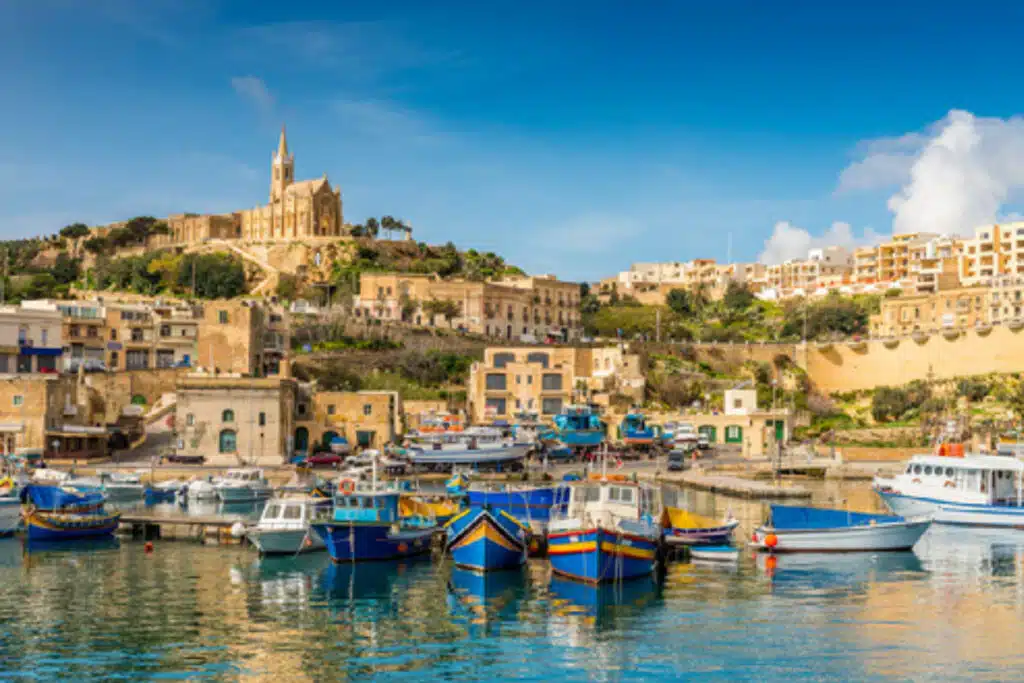
4. Huge Cultural Diversity
In history Malta was ruled by the Romans, the Arabs as well as the Brits, therefore you may encounter a great mix of cultural influences around the island.
Due to all of these influences, the food, the architecture, and the mentality of people are extremely diverse. The Arab presence is today still very strong since it left a distinct mark on the Maltese language. I mainly saw it in the Arab languages on street signs.
All of these influences make Malta so interesting – and I definitely think Malta is worth it in 2024.
5. Historic Cities
Mdina, the silent city is not the only historically significant place in Malta.
Make sure to also take a ferry to Gozo: the small sister city of Malta is only a 20-minute ferry ride away. The town offers you a journey back in history – as well as a great choice of sandy white beaches. You can even stay in Gozo for a couple of days.
Valletta itself is of course always worth a visit. In Valletta , you can find the Upper Barrakka Gardens , a total highlight for me.
Other cultural and architectural highlights of the island are Fort St. Elmo, Casa Rocca Piccola, Mosta Dome, Palazzo Parisio, Ggantija Temples, Auberge de Castille, and many more. Don’t forget about the Azure Window.

6. Stunningly Clear Blue Water
The water off the coast of Malta is stunningly clear, you could almost think you landed in the Caribbean. This is one of the main reasons why Malta is worth visiting – especially in summer!
84 out of a total of 87 beaches across Malta and Gozo have been classified as having excellent bathing water quality in the season .
Very few places in the world receive such perfect scores. I spend a lot of time in the Caribbean, and I promise that the Maltese waters are just as fine.

7. Cute Little Islands Close By
There are quite a few small islands located right next to Malta. Only three of the islands, Malta, Gozo, and Comino are actually inhabited.
You can book a boat trip to Comino, the Blue Lagoon, and the Crystal Lagoon of Malta! This was by far one of my favorite things to do in Malta.
The boat tour took us to stunning caves and beautiful turquoise waters and gave us a chance to work on our tan while being served ice-cold drinks.
These little islands alone definitely make Malta worth visiting.

8. Interesting Landmarks
Apart from all the historical landmarks I have mentioned, there are also quite a few places that are quirky and interesting.
One of these interesting landmarks is Popeye Village. It used to be a film set but has been turned into an amusement park later on.
The Gozo Salt Pans are another interesting landmark that makes Malta worth a visit.

9. Beaches, Lagoons and Natural Pools
Beaches, lagoons, and natural pools are some of my favorite features of Malta.
Malta does not only have fabulous beaches, such as Ghajn Tuffieha (Riviera Bay) and Għadira Bay but is also known for amazingly blue Lagoons and Natural Pools.
You can see stunning Natural Pools at St. Peter’s Pool and Għar Lapsi.

10. Delicious Food
The food in Malta is extremely delicious. As mentioned before, the many different cultural influences also left their mark on the cuisine of the island.
One of the biggest influences on Maltese cuisine was made by the Italians. There are lots of pasta dishes and other Italian favorites served in Malta (I am obsessed with Italian food, so that was a big upside).
Apart from Italian food, traditional Maltese food is rustic and very seasonal. Make sure to try traditional Lampuki Pie (fish pie), Bragioli (beef olives), or Kapunata, the Maltese version of ratatouille.
Do you need travel insurance in Malta? Yes, travel insurance in Malta is highly recommended. Avoid nasty surprises and travel worry-free with EKTA. EKTA offers worldwide travel insurance with 24/7 service and no hidden fees or restrictions.
11. Fun Festivals
Malta is home to almost 300 different churches. Each and every single church is dedicated to a different saint.
In summer, many of these saints are celebrated with some so-called “ festas “.
This means lots of decorations in the streets and a fun party around the island. Sometimes you can even see some pretty spectacular fireworks.
12. Friendly People
The Maltese are very laid back, friendly, and outgoing . This makes exploring the island a total joy.
The crowds traveling to Malta are usually consisting of young people since it is a popular destination for these ages.
So not only will you meet super nice locals but probably also meet many interesting, young people traveling to Malta on your trip.
13. Easy to Explore
Malta is extremely easy to explore because the island is not very big. Traffic can be lagging sometimes, so you need a little bit of patience.
We have rented an ATV for our entire stay and we had an amazing time driving around the island. It just took us some getting used to driving on the “ wrong ” side of the streets.
I love visiting smaller islands, such as Malta, exactly for that reason. You can drive around without much planning and just see where you end up.
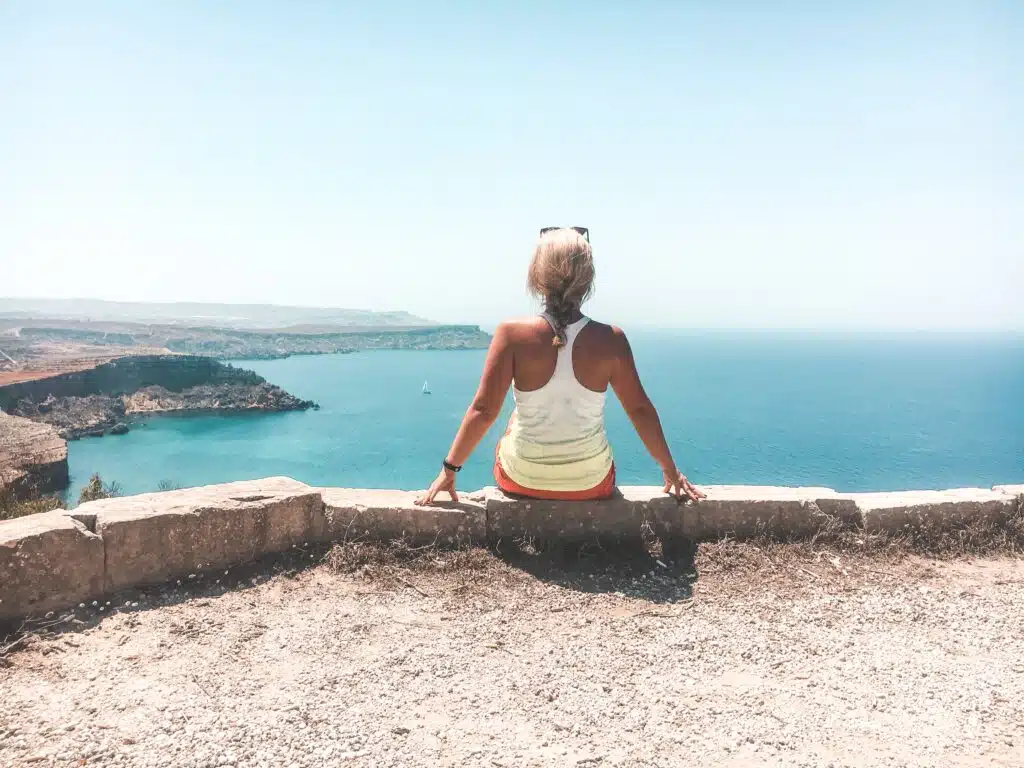
14. Vibrant Island Life
Malta offers a vibrant and diverse nightlife scene, making it a popular destination for young and old seeking entertainment after the sun sets.
From lively bars and clubs to beach parties and music festivals, there is something for everyone.
Paceville, in St. Julian’s, is known for its bustling nightlife with numerous bars and clubs.
Valletta and Sliema also offer a variety of venues where visitors can enjoy live music, cocktails, and a lively atmosphere.
I am not a party gal, but I heard it is amazing!
15. Affordable Luxury
Compared to other islands in the Mediterranean, Malta is relatively cheap. You can stay in amazing hotels for very little money comparatively.
There is a broad selection of fancy hotels and resorts that will make your Malta vacation definitely worth a visit.
Malta is considered a safe destination for tourists. The crime rate is relatively low, and violent crime is rare.
Even though there are Arabic influences around the island (as you can see on the street signs sometimes), we did not feel a need to cover up or dress in any special way to be respectful.
We have also never felt unsafe despite being two young girls exploring on our own. The locals are also extremely helpful and not opposed to having tourists on the island. We didn’t experience any catcalling, as opposed to in Morocco.
17. English is the Second Official Language in Malta
Malta is a former British colony, which means that most locals are fluent in English.
I don’t know about you, but I always find it extremely helpful when I can communicate with locals effectively when traveling.
The main language spoken on the island is Maltese. It also helps that the official currency in Malta is the Euro.

😔 As I mentioned before, the weather in summer can be way too hot for exploring. In the middle of August during our trip, we literally melted.
😔 Malta is not big on white, sandy beaches. They have a couple of nice ones, but they are a bit touristy.
😔 Malta can be a bit messy, and people are unpunctual. That is just typical Southern Europe, nothing to worry about.
The quickest and easiest way to reach Malta is by plane. Most European cities offer a direct connection to the island, usually operated by the Maltese Airline Air Malta.
The biggest and only airport on the island is Malta International Airport. People refer to it as Valletta Airport.
Theoretically, you can also reach the island by ferry (e.g. from Sicily), but the transfer time is quite long.
The capital city of Valletta does allow cruise ships in its port. Many people will arrive in Malta via the big vessels on a Western Mediterranean Cruise.
Based on your preferences there are many possibilities on where to stay on the island of Malta. Slow travelers will most likely find themselves preferring to stay around the Mellieha area (where you can find the best beaches) or in St. Paul Bay.
Sliema and St. Julians are famous beach towns on the island. They are usually very crowded with tourists and young people seeking the nightlife. Therefore, I would not recommend staying there if you are craving a more quiet setting.
If you like being close to historical sights, you might want to opt for Valletta , Rabat or Mdina . Valletta is a great choice for a shorter stay. I would not recommend it for a prolonged vacation due to its lack of beaches.
By ferry, you can reach Gozo island, which also offers plenty of nice places to stay. Gozo is a very small island offering a charming and quiet, yet historically significant place to stay. The other small island close to Malta is called Comino.
On our trip to Malta, we chose the 4-Star Santana Hotel in Qawra , close to St. Paul Bay. The hotel had luxurious and spacious rooms, and the service was absolutely lovely.
We especially enjoyed the rooftop pool after a long day of exploring as well as the diverse breakfast buffet. Conveniently, the hotel has its own restaurant, so good food was always within reach!
Yes, Malta is definitely worth visiting in 2024 and should be on every traveler’s bucket list.
Stunning landscape, impressive historical cities, and amazing beaches make the island worth visiting. I loved how easy it was to explore, and how safe we felt all week.
Malta has become known as a culturally vibrant and budget-friendly summer holiday destination in Europe. Because of all the historical influences you can expect to be amazed at the cultural diversity of the island.
Of course, there are some minor downsides, but all in all, I would rate Malta with a 9/10 points for a European destination.
So is Malta a good place to vacation? Yes, Malta is definitely an amazing place for a summer vacation in Europe.
For more information on Malta, keep reading:
🇲🇹 Why Malta is worth visiting – Ultimate Travel Guide
🇲🇹 One Day in Malta – Valletta Cruise Port
🇲🇹 Malta: Language, Culture, and Geography
🇲🇹 Awesome 10 Days in Malta Itinerary With Map
Yes, Malta is very good for tourists. There are many affordable luxury hotels on the island, the beaches are pristine and the island life is vibrant. Locals are very friendly and hospitable
I suggest staying in Malta for at least a week. There are many points of interest that you should visit on your Malta trip, and a week will cover all of them without having to rush.
Malta has stunningly blue water, amazing architecture, and lots of culture to offer its visitors. There are beautiful historic villages, stunning lagoons, and natural pools that vacationers love.
No, Malta is not expensive to visit. Compared to many other European summer hotspots, Malta is relatively cheap. You can find great accommodation, food, and excursions on a budget in Malta.
Yes, Malta is very safe. There is very little violent crime on the island and we did not feel unsafe at any time on our holiday. We had a blast exploring by ourselves (two young girls) and never got into any unsafe situations.
Malta is surprisingly not yet on the radar of most tourists. Over the last couple of years, it has definitely gained in popularity, but it is not as overrun as the Greek islands for sure. There are definitely some tourist spots in Malta, but we never felt too crowded.
Malta is, compared to other European holiday destinations, still very cheap. Most day trips on the island cost around EUR 50,00. Nice hotels cost around EUR 150,00 per night. Eating out is very cheap as well, and especially alcohol is inexpensive.

Sabrina is a passionate travel blogger and content creator, originally from Austria. She spends most parts of the year abroad at various destinations with her husband.
She provides slow-paced itineraries that focus on quality over quantity. Sabrina wants to help her readers to get more out of their travel experiences – while doing less. Read more.

You May Also Like

One Day in Valletta From Cruise Port: Things to Do in Malta

Awesome 10 Days in Malta Itinerary With Map

Malta: Language, Culture & Geography Questions Answered
- Election 2024
- Entertainment
- Newsletters
- Photography
- Personal Finance
- AP Investigations
- AP Buyline Personal Finance
- AP Buyline Shopping
- Press Releases
- Israel-Hamas War
- Russia-Ukraine War
- Global elections
- Asia Pacific
- Latin America
- Middle East
- Election Results
- Delegate Tracker
- AP & Elections
- Auto Racing
- 2024 Paris Olympic Games
- Movie reviews
- Book reviews
- Personal finance
- Financial Markets
- Business Highlights
- Financial wellness
- Artificial Intelligence
- Social Media
Russian warships leave Havana’s port after a 5-day visit to Cuba
A fleet of Russian warships left a port in Cuba on Monday.
The nuclear-powered Russian submarine Kazan leaves the port of Havana, Cuba, Monday, June 17, 2024. A fleet of Russian warships arrived in Cuban waters last week ahead of planned military exercises in the Caribbean. (AP Photo/Ariel Ley)
- Copy Link copied
The Russian Navy’s Admiral Gorshkov frigate leaves the port of Havana, Cuba, Monday, June 17, 2024. A fleet of Russian warships arrived in Cuban waters last week ahead of planned military exercises in the Caribbean. (AP Photo/Ariel Ley)
HAVANA (AP) — A fleet of Russian warships, including a nuclear-powered submarine , left Havana’s port on Monday after a five-day visit to Cuba following planned military drills in the Atlantic Ocean. The exercise has been seen by some as a show of strength by Moscow against the backdrop of tensions as U.S. and other Western nations support Kyiv in Russia’s war on Ukraine.
The submarine, a frigate, an oil tanker and a rescue tug slowly departed from the port on Monday morning.
It’s unclear what the fleet’s next destination is or where it will dock next in the Caribbean, although U.S. officials said days ago that the vessels could possibly also stop in Venezuela.
Officials with the Biden administration said last week that they were monitoring the vessels and confirmed that they did not pose a threat to the region or indicate a transfer of missiles. Still, the United States docked a submarine , the USS Helena, at its Guantanamo Bay Naval Base in Cuba.
The American naval base, located in the southeastern part of the island about 1,000 kilometers (625 miles) from the capital of Havana, is considered by the Cuban government to be illegally occupied territory.
The nuclear-powered Russian submarine Kazan leaves the port of Havana, Cuba, Monday, June 17, 2024. (AP Photo/Ariel Ley)
Last week, the Russian ships arrived at the port after the Russian Ministry of Defense reported that the fleet successfully conducted military drills in the Atlantic Ocean, simulating a missile attack on targets that could be more than 600 kilometers (375 miles) away.
The fleet, made up of the frigate “Gorshkov,” the nuclear-powered submarine “Kazan,” the tanker “Pashin,” and the tug “Nikolai Chiker,” was received in Havana with a 21-gun salute.
Cuban President Miguel Díaz-Canel visited the frigate on Saturday and interacted with the sailors, according to a post by the president on the social media platform X, formerly known as Twitter.
Meanwhile, Cuban Deputy Foreign Minister Carlos Fernández de Cossío rejected the presence of the American submarine at Guantanamo Base, stating it was unwelcome and uninvited.
A State Department spokesperson said last week that Russia’s port calls in Cuba are “routine naval visits” and do not pose any danger .
On Thursday, a day after arriving, hundreds of people lined up to visit the frigate. The ship was also open to the public on Saturday, which is a common practice when vessels arrive at the port.
Canada’s navy patrol boat Margaret Brooke entered the Havana harbor on Friday.
BREAKING: Noah Lyles wins the men’s 100-meter final, securing a spot on the U.S. Olympic team
Record-breaking rise in deadly infections in Japan renews focus on the mysteries of strep

The summary
- Japan has reported a record number of cases of streptococcal toxic shock syndrome, a rare and dangerous bacterial infection caused by Group A strep bacteria.
- The U.S. similarly saw serious Group A strep infections — including STSS — reach a 20-year high in 2023 .
- Experts think a post-pandemic rebound of bacterial and viral infections could partially explain the trend, but many unanswered questions persist.
A record-breaking rise in potentially fatal infections in Japan is bringing attention to persistent, unanswered questions about the group of bacteria behind the illnesses.
The rare infection, streptococcal toxic shock syndrome (STSS), is caused by Group A strep bacteria, the same type that causes strep throat and scarlet fever. In rare cases, Group A strep can enter deep tissue or the bloodstream, as is the case with STSS.
Up to 30% of STSS infections are fatal: The condition usually starts with a fever, chills, muscle aches, nausea or vomiting but can become life-threatening in 24 to 48 hours if left untreated. It can occur in tandem with necrotizing fasciitis, another bacterial infection that is described as “flesh-eating” because it destroys the soft tissue under the skin.
So far this year, Japan has recorded at least 1,019 cases of STSS, according to a report released earlier this week by the country’s National Institute of Infectious Diseases. That’s its highest total ever, already larger than last year’s record tally of 941.
The unprecedented numbers are renewing focus on the mysterious recent behavior of Group A strep bacteria, which has circulated at unusually high levels over the past few years in both the United States and Japan, resulting in a surge of life-threatening and sometimes fatal infections. Disease experts don’t fully understand why that’s happening yet.
In the U.S., the number of serious Group A strep infections — including STSS — reached a 20-year high in 2023 , according to preliminary data from the Centers for Disease Control and Prevention. This year, the CDC has recorded 395 cases of STSS as of June 8, exceeding last year’s total of 390 with many months to go. The agency noted, though, that Group A strep activity has decreased in the last several months, as is expected at this time of the year.
The United Kingdom also saw an outbreak of severe Group A strep infections in late 2022, then recorded more cases than average from September to February, as well.
Disease experts have attributed the trend, in part, to the broader post-pandemic rebound of common viral and bacterial infections — including strep. During the period when people were avoiding in-person interactions, such pathogens had fewer opportunities to spread. Now, people may be more susceptible again.
“This may be part of this global phenomenon: the comeback of strep,” said Dr. William Schaffner, an infectious diseases expert at Vanderbilt University Medical Center. He added: “Most of these infections were really profoundly reduced during Covid because we stayed at home and wore masks and closed schools and the like.”
However, other viral illnesses that surged as lockdowns eased and socializing resumed have seemingly returned to their baselines, whereas strep cases continue to surpass the usual averages, experts said.
“Any number of infections have come back to normal, conventional levels — but strep has exceeded them. Exactly why that’s happening we don’t know,” Schaffner said.
Complicating the picture is the fact that Group A strep infections were rising in the U.S. for several years before Covid emerged.
So experts think there’s probably more to the explanation than the pandemic. Has the bacteria evolved to cause more severe illness? Are there any unidentified associations between Group A strep and certain viral infections? Are some age groups getting sick now who weren’t in years past? Answers have yet to be determined.
As for who is at risk of STSS, older adults and people with diabetes are generally more vulnerable, and sores from chickenpox or shingles also make people more likely to contract it. That’s because Group A strep can enter the body through open wounds and develop into toxic shock syndrome from there. Experts also think that some viruses may predispose people to secondary bacterial infections by damaging the airways or weakening the immune system.
But in many cases, disease experts aren’t able to determine how a particular person got sick.
“When a patient comes in with group A strep in the blood, unless they have a wound, you often don’t know how it got into the body,” said Dr. Lee Harrison, a professor of medicine and epidemiology at the University of Pittsburgh.
Although a particular country’s level of baseline immunity to the bacteria, or perhaps even certain genetic traits, may influence a population’s susceptibility, Japan’s situation is a reminder to doctors everywhere to monitor for severe strep infections, said Dr. Amesh Adalja, an infectious disease physician and a senior scholar at the Johns Hopkins Center for Health Security.
“What happens in Japan is important for other countries just to be on alert,” he said.
Such awareness is crucial because patients with STSS should be treated as soon as possible after symptoms appear — that may involve antibiotics or a surgery to remove infected tissue.
No vaccine for Group A strep is available, though several are in development , including one that seemed safe in a phase 1 trial . Harrison said the recent rise in infections in Japan and the U.S. could accelerate demand for this research.
Aria Bendix is the breaking health reporter for NBC News Digital.
- AIG Travel Guard Overview
- AIG Travel Guard Plans
AIG Travel Guard Cost
How to file a claim with aig travel guard, compare aig travel guard, aig travel guard frequently asked questions.
- Why You Should Trust Us
AIG Travel Guard Insurance Review 2024
Affiliate links for the products on this page are from partners that compensate us (see our advertiser disclosure with our list of partners for more details). However, our opinions are our own. See how we rate insurance products to write unbiased product reviews.
AIG Travel Guard is a well-established and highly rated name in the travel insurance industry. It offers three main coverage options to choose from, and in general its policies have above-average coverage for baggage loss and baggage delays, plus high medical evaluation coverage limits. If you're looking for travel insurance, consider Travel Guard .
Trip cancellation coverage for up to 100% of the trip cost and trip interruption coverage for up to 150% of the trip cost
- Check mark icon A check mark. It indicates a confirmation of your intended interaction. Trip cancellation coverage of up to 100% of the cost, for all three plan levels
- Check mark icon A check mark. It indicates a confirmation of your intended interaction. CFAR covers up to 75% of total trip costs (maximum of $112,500 on some plans)
- Check mark icon A check mark. It indicates a confirmation of your intended interaction. Medical coverage of up to $500,000 and evacuation of up to $1,000,000 per person
- Check mark icon A check mark. It indicates a confirmation of your intended interaction. Includes COVID coverage
- Check mark icon A check mark. It indicates a confirmation of your intended interaction. Above average baggage loss and delay benefits
- Check mark icon A check mark. It indicates a confirmation of your intended interaction. High medical evacuation coverage
- con icon Two crossed lines that form an 'X'. Premiums may run slightly higher than competitors
Travel Guard is a well-established and highly rated name in the travel insurance industry. It offers three main coverage options to choose from, and in general its policies have above-average coverage for baggage loss and baggage delays, plus high medical evaluation coverage limits.
- Trip cancellation coverage for up to 100% of the trip cost
- Trip interruption coverage for up to 150% of the trip cost
- Preexisting medical conditions exclusions waiver must be purchased within 15 days of initial trip payment
- Annual travel insurance plan and Pack N' Go plan (for last-minute trips) available
AIG Travel Guard Travel Insurance Review
AIG Travel Guard is among the best travel insurance companies with impressive coverage limits, even with its basic plan, Travel Guard Essential. It's emergency medical evacuation coverage is particularly high, making Travel Guard a good choice for insuring cruises, as sea to land evacuations are often expensive.
Additionally, Travel Guard's Premium and Deluxe plans offer coverage that many of its competitors don't, such as its travel inconvenience coverage and ancillary evacuation coverage.
That said, Travel Guard is on the pricey side, compared with its competitors. While age is often a factor in your insurance premiums, Travel Guard tends to quote older travelers higher rates than its competitors. However, you often get what you pay for. In Travel Guard's case, you'll find that its coverage justifies its higher rates.
While great coverage is important, it's also crucial that an insurance company has a smooth claims process, which Travel Guard lacks, according to its customer reviews. Across 135 reviews on its Trustpilot page, AIG Travel Guard received an average of 1.2 stars, with 95% of reviewers giving the company one star. Surprisingly, AIG Travel Guard fares even worse with the Better Business Bureau, receiving an average of 1.08 stars out of five across 301 reviews.
Coverage Options Offered by AIG Travel Guard
AIG Travel Guard offers three primary plans: Travel Guard Essential, Travel Guard Preferred, and Travel Guard Deluxe. Each plan has different coverage limits and various types of protection.
Here's a look at what you'll get with each plan:
Depending on the policy you select, additional coverages may be included at no extra charge, such as a pre-existing conditions waiver , single occupancy fee coverage, worldwide travel and medical assistance services, and more. Be sure to check each policy closely to see what is and isn't covered.
Each of these plans also includes coverage for one child under 17 as long as their travel costs are equal to or under the adult's cost. Additional coverage does not apply to the child.
AIG Travel Guard Pack N' Go Plan
In addition to these three primary plans, Travel Guard offers the Pack N' Go policy along with an Annual plan. This policy is for last-minute travelers who don't need trip cancellation coverage.
This plan includes:
- Trip interruption and trip delay ($200 per day maximum) up to $1,000
- Missed connection up to $500
- Baggage delay up to $200 and baggage coverage up to $1,000
- Medical expenses up to $25,000 and dental expenses up to $500
- Emergency evacuation and repatriation of remains up to $500,000.
AIG Travel Guard Annual Plan
Taking multiple trips throughout the year? Consider the Travel Guard Annual plan instead of purchasing a new policy for each adventure. This plan comes with coverage for:
- Trip interruption coverage up to $2,500
- Trip delay coverag e up to $1,500 ($150 per day maximum)
- Missed connection coverag e up to $500
- Baggage delay coverage up to $1,000 and lost/damaged baggage coverage up to $2,500
- Medical expenses coverage up to $50,000 and dental expenses up to $500
- Emergency evacuation coverage and repatriation of remains up to $500,000
- Accidental death and dismemberment coverage up to $50,000 and security evacuation up to $100,000
Additional Coverage Options from AIG Travel Guard
Like many other travel insurance providers, Travel Guard offers add-ons for an additional cost. These can be selected while you're purchasing your policy.
The availability of these add-ons depends on the policy you're buying. Note also that some are already included in the Preferred and Deluxe plans.
- Medical bundle — Increases coverage amounts for medical expenses and evacuation and adds hospital of choice and additional evacuation benefits.
- Security bundle — Provides various coverages for trip interruption or cancellation due to riot or civil disorder.
- Rental vehicle damage coverage — Reimburses a predetermined amount for physical damage to a rental car in the policyholder's name.
- Cancel for Any Reason Insurance (CFAR) — This is just what it sounds like. Cancel for any reason coverage will reimburse 75% of nonrefundable expenses when you cancel your trip for any reason, up to 48 hours before your scheduled departure. CFAR coverage is only available for Travel Guard's Deluxe and Preferred plans.
- Inconvenience bundle — Offers reimbursement for inconveniences like closed attractions, credit/debit card cancellation, hotel construction, and more.
- Pet bundle coverage — Daily travel benefit for boarding and medical expense coverage for illness or injury of dog or cat. Includes trip cancellation or interruption coverage if the pet is in critical condition or dies within seven days before the departure date.
- Adventure sports bundle — Removes the exclusions for adventure and extreme activities.
- Baggage bundle — Your baggage coverage with AIG becomes primary with increased coverage and baggage delay benefits.
- Wedding bundle — Provides trip cancellation coverage due to wedding cancellation (brides and grooms not covered).
- Name a family member bundle — One person can be named as a Family Member for the purpose of family member-related unforeseen event coverage.
How to Purchase and Manage Your AIG Policy
Getting a quote from AIG Travel Guard is quick and easy. Head to the AIG website and enter basic information about the trip you're looking to cover. You'll get an instant quote for the insurance plans available for your trip, so it's easy to compare each option. Be prepared to provide information including:
- Your state of residence
- Date of birth
- The cost of your trip
- Travel dates
- Destination
- Method of travel
We ran a few simulations to offer examples of how much a Travel Guard policy might cost. You'll see that costs usually fall within 5-7% of the total trip cost, depending on the policy tier you choose.
As of April 2024, a 23-year-old from Illinois taking a weeklong, $3,000 budget trip to Italy would have the following Travel Guard travel insurance quotes:
- Travel Guard Essential: $86.96
- Travel Guard Preferred: $152.01
- Travel Guard Deluxe: $188.59
Premiums for Travel Guard's various single trip plans are between 2.8% and 6.3%, well within, and even below, the average cost of travel insurance .
A 30-year-old traveler from California is heading to Japan for two weeks, costing $4,000. The Travel Guard travel insurance quotes are:
- Travel Guard Essential: $198.77
- Travel Guard Preferred: $240.39
- Travel Guard Deluxe: $305.04
Premiums for Travel Guard's various single trip plans are between 5% and 7.6%, within the average cost of travel insurance.
A couple of 65-year-olds looking to escape New York for Mexico for two weeks with a trip cost of $6,000 would have the following Travel Guard quotes:
- Travel Guard Essential: $471.10
- Travel Guard Preferred: $618.22
- Travel Guard Deluxe: $834.78
Premiums for Travel Guard's various single trip plans range between 7.9% and 13.9%, which is significantly higher than the average cost. That said, travel insurance is often more expensive as you get older.
AIG Travel Guard Annual Plan Cost
Getting a quote for the annual plan requires much less information, only asking for the intended policy start date, your state of residence, and how many people you plan to insure. Quotes from AIG remained at $259 per traveler, regardless of state of residence and number of travelers.
Filing a claim with Travel Guard is a straightforward process. You'll need your policy number and can either go to travelguard.com or call Travel Guard at 866-478-8222 to start the claim. Once submitted, you can check the status of your claim at claims.travelguard.com/status.
See how AIG Travel Guard stacks up against the competition and find the right travel insurance policy for you.
AIG Travel Guard vs. Nationwide Travel Insurance
Nationwide is a household name when it comes to insurance providers and one of the largest and most recognized insurance providers in the US. Similarly to Travel Guard , Nationwide makes it easy to find coverage by offering just two single-trip plans: the Essential and Prime plan.
In addition, Nationwide offers plans specifically designed for cruises along with annual trip insurance for those who travel a lot throughout the year.
The Nationwide Essential Plan comes with trip cancellation coverage of up to $10,000, up to $250,000 in emergency medical evacuation, up to $150 per day reimbursement for travel delays of 6+ hours, and coverage for delayed or lost baggage.
In comparison, the Travel Guard Essential plan covers trip cancellations with up to $100,0000 in coverage, up to $150,000 in emergency medical evacuation expenses, up to $100 per day ($500 total) for trip delays of 12+ hours, along with lost or delayed baggage coverage.
The high-tier Prime Plan from Nationwide offers even more coverage, including trip cancellation up to $30,000, trip interruption coverage up to 200% of the trip cost (maximum of $60,000), missed connection and itinerary change coverage of $500 each, $250 per day for trip delays of 6+ hours, and up to $1 million in coverage for emergency medical evacuation
AIG's highest-tier Deluxe plan comes with trip cancellation coverage of up to $150,000, up to $1,000,000 in emergency medical evacuation, up to $200 per day ($1,000 maximum) reimbursement for travel delays of 12+ hours, and coverage for delayed or lost baggage.
As you can see, it's hard to compare apples to apples when comparing the two different insurance providers. But it helps to know the specifics of the coverages that matter most to you.
Read our Nationwide travel insurance review here.
AIG Travel Guard vs. Allianz Travel Insurance
With Allianz Travel Insurance , you can choose from 10 different insurance plans to find one that suits your needs. Like Travel Guard , it offers one-off policies for specific trips and an annual travel insurance plan for those who take multiple trips a year. Similar to AIG, too, the different plans offer varying levels of coverage.
Allianz's most popular single-trip option is the OneTrip Prime plan. This plan offers trip cancellation coverage up to $100,000, trip interruption coverage up to $150,000, emergency medical coverage for $50,000, coverage for baggage loss, theft, or damage up to $1,000, and up to $800 in travel delay coverage.
The most similar plan from Travel Guard is the mid-tier Travel Guard Preferred plan, which which you'll get up to $150,000 in trip cancellation coverage, trip interruption coverage up to $225,000, $50,000 in emergency medical coverage, coverage for baggage loss, theft, or damage up to $1,000, and travel delay coverage of up to $800.
A variety of factors will determine the final cost of any of these travel insurance policies. However, when comparing quotes with the same factors, Allianz tends to be cheaper. Additionally, Travel Guard seems to be more sensitive to the traveler's age. However, it's best to compare quotes using your specific personal and trip details to determine which policy is the best for you.
Read our Allianz travel insurance review here.
AIG Travel Guard vs. Credit Card Travel Insurance
Before purchasing a travel insurance plan, take a look at the coverage offered through your travel rewards credit cards. Some of the basic coverages you're looking for, like rental car insurance, may already be available through credit card travel protection .
The coverage you have on your credit card couple be sufficient if, for example, you're taking a road trip by car and you don't have any non-refundable trip expenses. It could also be enough if your health insurance covers you while you travel and you aren't overly worried about incurring additional medical expenses during your trip.
It's also worth remembering that credit card coverage is usually secondary versus the primary coverage you'd get with a travel insurance policy. Meaning you'll have to file a claim with the other applicable insurance (like through the airline travel provider) before filing a claim with your credit card company.
Read our guide on the best credit cards with travel insurance here.
Depending on the single trip plan you choose, AIG Travel Guard offers $15,000-$100,000 in emergency medical expense coverage.
All three of Travel Guard's single trip policies offer pre-existing condition waivers as long as you purchase your policy within 15 days of your initial trip payment.
Travel Guard is the name used for AIG's travel insurance products, but AIG also offers other insurance products, like AIG Life Insurance .
Your coverage depends on the policy you buy, but all policies will cover (up to a specified limit) trip cancellation, interruption, delay, emergency medical expenses, lost and delayed baggage, and emergency evacuation.
Yes, Travel Guard plans cover trip cancellation and interruption due to illness, injury, or death of a family member. If your trip is delayed or canceled due to inclement weather, that's covered too. AIG Travel Guard's is also among the best CFAR travel insurance companies.
Why You Should Trust Us: How We Reviewed AIG Travel Guard
The policy that's best for you will be the one that offers the right amount and type of coverage, fits your budget, and is easy to use if you ever need it.
In reviewing Travel Guard , we looked at the company's travel insurance offerings and compared them to plans offered by the top travel insurance companies in the space. Factors considered included things like coverage options, claim limits, what's covered, available add-ons, and typical insurance policy costs. We also considered buyer preferences.
Read more about how Business Insider rates insurance providers .
Editorial Note: Any opinions, analyses, reviews, or recommendations expressed in this article are the author’s alone, and have not been reviewed, approved, or otherwise endorsed by any card issuer. Read our editorial standards .
Please note: While the offers mentioned above are accurate at the time of publication, they're subject to change at any time and may have changed, or may no longer be available.
**Enrollment required.

- Main content

June 18 , 2024
13 Min Read
Seasons 2.0 FAQ
- WONY Expansion
- Seasonal and Non-Seasonal characters
- Manhunt 2.0
- Seasonal Journey
- Multiplayer and Matchmaking
Agents, we've heard your concerns regarding the introduction of seasonal characters in The Division 2 with Seasons 2.0 later this year. We want to clarify how seasonal characters will impact your existing main characters and answer a few questions about Seasons 2.0.
The main idea behind Seasons 2.0 is to break away from the current repetitive seasonal model by transforming the entire experience. With your main characters, we need to consider various progressions and power levels, making it nearly impossible to create a well-balanced experience that is enjoyable for all. Starting all players at level 1 ensures that we have a clear understanding of where they are in their progression journey when faced with specific challenges. To put it simply, in order to craft challenges with precision, we need a fresh start.
Additionally, seasonal resets bring another layer of excitement since modifiers are phased out at the end of each Season, giving us the freedom to impact gameplay far beyond what permanent mechanics would allow.
We omitted one important detail from the year 6 introduction. With the revamped seasonal progression, you will have the opportunity to bring your main character into the last two weeks of each season, known as the Intermission . The Intermission allows you to revisit your main character with new content and seasonal progression, using your current arsenal for experimentation, strategy, and dominance. At the start of the Intermission, all rewards earned with the seasonal character including SHD levels, Proficiency Ranks, Stash items, and collectibles will be transferred to your main character. This transfer ensures that your main character will be more powerful than ever and prepared to tackle the season's Climax (Normal or Master difficulty) should you choose to experience the remainder of the season with your main Agent. Get ready to see your favorites in a whole new way!
During this time, the seasonal character will be added to your roster, giving you the option to play the season's Climax Mission with either the seasonal character or your preferred main character.
In Seasons 2.0, seasonal character progression is significantly sped-up, allowing you to reach level 40 more quickly and gain SHD levels at a faster rate. This progress will be shared with your main character at the start of the Intermission. Expertise upgrades will not be available for Seasonal characters. Instead, the SHD Watch bonuses will be increased to account for the missing power coming from Expertise. Proficiency can still be earned by seasonal characters and will be merged at the end of the season. Please note that proficiency alone does not impact gameplay.
Finally, as a seasonal character progresses to level 40, they will not have to complete the entire campaign again. Instead, they will have the freedom to choose which content they experience without worrying about completing certain missions for specific unlocks.
However, there is more to the upcoming changes than just transitioning to seasonal characters. We will share with you detailed information by hosting live Q&A sessions, our PTS, and during various livestreams in the coming months to guide you through these changes. We also encourage you to explore our Year 6 Season 1 "First Rogue" page, as it may answer some of your questions.
WONY EXPANSION
Q: Is Warlords of New York Expansion now free for new players?
A: The WONY DLC continues to be paid content. The key change that came with the One Endgame update is that owning WONY is no longer a requirement to reach Level 40 and access endgame content, such as gear, game modes, and Manhunts.
Q: What content remains locked behind the WONY Expansion?
A: Skills, story missions and New York map remain exclusive to the Expansion.
Playing Legacy Manhunt Missions won't grant access to Skill variants for Repair Trap, Shrapnel Trap, or EMP Sticky. These skills are tied to specific bosses in the WONY Expansion, and players must unlock the Skill platform in WONY to use them. The only difference is the Climax Mission, where defeating Faye Lau and earning the Achilles Pulse Skill variant will be accessible regardless of WONY ownership, provided you already have the Pulse unlocked through the main game.
Q: Will the New York map remain accessible for playing Legacy Manhunt?
A: Players without ownership of WONY will not be able to access the Legacy Manhunt missions set in New York. If they attempt to fast travel to the climax location, they will receive an in-game notification.
SEASONAL AND NON-SEASONAL CHARACTERS
Q: Will we be given extra stash space and/or extra character slots?
A: An additional character slot will be added to support Seasons 2.0, along with extra storage space. However, it is worth noting that no extra slots will be added for each individual Season.
Q: Do I need to delete a character when a new season starts when all my slots are occupied?
A: As additional slots will not be provided for each Season, you will need to choose which character to retain in your main roster. Starting with Year 6 Season 2, you can have up to 5 characters. For instance, in the beginning of Year 6 Season 2, if you already have 4 characters, you can utilize the additional slot to add a fifth character for the Season. However, if you have 5 characters at the end of Year 6 Season 2, you will need to remove one character to make room for the new seasonal character.
Q: What is the point of keeping your main character if you can't use them for 90% of future content coming to the game?
A: We have taken measures to ensure that both seasonal and non-seasonal characters have meaningful roles and cool things to do in the game. The current model reinforces the way a lot of players are using some characters as support for their main character at the account level. Seasonal characters serve a similar purpose, on top of facilitating an awesome experience in the season through manhunts and modifiers. Additionally, seasonal characters also contribute to the overall account progression, which is represented through the power level of the main character.
The main character remains the foundation of the account, enabling players to take on challenges at the highest power and difficulty levels. Furthermore, upcoming DLCs will present a chance to take on challenges with your primary character and its corresponding power level. Additionally, only non-seasonal characters will have access to Legacy Manhunts.
Q: Will there be any new content for the main non-seasonal characters?
A: Non-seasonal characters will continue to have access to all existing game content, including both WONY and the upcoming DLC. Right now, there are no intentions to introduce another Incursion or Raid.
Q: Will seasonal characters have access to their existing Recalibration Library?
A: The Recalibration Library will be shared between Seasonal and Non-seasonal characters, the only exception being Season-specific gear. During the Season, you can transfer Season-specific gear talents to the Library, where they will become accessible to your main character at the beginning of the Intermission.
Q: Will seasonal characters be able to use the account-wide resources/materials?
A: Seasonal characters will have their own separate pool of shared resources and materials, which will not be shared with the non-seasonal characters' pool.
Q: When I have all my inventory and stash maxed out will I lose the loot after the season ends and the seasonal character is merged with my regular roster?
A: Once the Season ends and Intermission begins, you will be awarded a temporary stash to facilitate the transition of the Seasonal items to the main pool. It is up to you to decide what to keep and what to discard or deconstruct during that process. However, please note that starting from Y6S3, if you still have items in your temporary stash, you will be unable to create a new seasonal character
Q: How will my Hardcore characters be impacted?
A: At the start of each Season, you will have the option to select either a Hardcore or regular Seasonal character. This choice provides the opportunity to add an additional Hardcore character to your roster at the end of the Season when the seasonal and main characters combine. Your existing Hardcore character will retain its progression, which can be shared at the beginning of the Intermission period (the final 2 weeks before the Season concludes).
Q: Will Seasonal characters have access to Global Events?
A: Global Events as they are right now will remain exclusive to non-seasonal characters due to their incompatibility with seasonal progression and modifiers in their current state. They will adhere to the established rotation model already present in the game. Seasonal characters may eventually receive their own version of Global Events tailored to enhance the seasonal experience, but this implementation will occur at a later time.
MANHUNT 2.0
Q: Will the new Master difficulty be in any way available for non-seasonal characters?
A: Yes, Climax Mission on Master difficulty will be available for both seasonal and non-seasonal characters during the Intermission - a two-weeks period between the Seasons.
Q: Why tie the Manhunt to the Seasonal character's participation?
A: In Seasons 2.0, the optimal way to experience the story is through the seasonal structure, utilizing a character with the appropriate power level to capitalize on features such as gameplay modifiers and seasonal items. The story will be adjusted to accommodate this new dynamic, with multiple agents fulfilling their roles throughout the season.
Moreover, after the season ends, players can opt for the Climax mission using either their seasonal or primary character.
SEASONAL JOURNEY
Q: What will Seasons 2.0 consist of?
A: There are 15 weeks of varied activities such as Seasonal Missions, Seasonal Projects, Manhunt Scouts and Priority Objectives to be completed with your seasonal character, followed by a 2-week Intermission period during which you can utilize your main character. Your non-seasonal character can be accessed at any time during the Season, but with no access to Seasonal content except for the two-weeks Intermission.
Q: Approximately how long is the accelerated grind to LVL 40 expected to take?
A: Non-seasonal characters will require approximately 45 hours to complete, while Seasonal characters are expected to take around 15 hours for the same activities.
Q: Will the seasonal grind to LVL 40 consist of the same current activities? Or will it be different each Season?
A: To reach level 40, the seasonal journey will act as a guide, providing simple and quick challenges that offer great completion rewards, while also aiding the player through unlocking key game systems. Additionally, at every point players can complete a variety of other activities in the game at an increased progression rate. Each Season will feature unique Seasonal Modifiers that affect both players and enemy NPCs, providing a different experience in previously played content.
Q: Will the seasonal story beats be introduced during the LVL 1-40 grind, or will players need to reach LVL 40 to experience them?
A: The updated seasonal journey in Year 6 Season 2 will allow all players the opportunity to experience the story, irrespective of their level. In other words, new story content is no longer locked behind level 40 characters.
Q: Will players have to reach LVL 40 to start collecting Season rewards?
A: Seasonal rewards are not restricted to level 40; various rewards unlocked through the Seasonal Journey, Season Pass, and other in-game systems are granted while leveling from 1 to 40. The Manhunt story will also gradually unfold through collectibles, allowing players to progress step by step.
Q: What happens with seasonal collectibles?
A: During the Intermission period, which occurs in the final two weeks before the end of the Season, all rewards obtained with the seasonal character, such as SHD levels, Proficiency Ranks, Stash items, and collectibles, will be transferred to your main character.
Q: Will we get access to the SHD watch?
A: In Seasons 2.0, seasonal character progression is significantly sped-up, allowing you to reach level 40 more quickly and gain SHD levels at a faster rate. This progress will be shared with your main character at the end of the season. However, fast progression will only be possible up until a certain level. Upon reaching it, the SHD Watch progression will resume at a normal speed.
Q: Why can't my existing LVL 40 character engage in the seasonal content?
A: The main objective of Seasons 2.0 is to ensure that all players can participate in endgame content on a level playing field, as well as allowing us to fine-tune the experience based on more controlled progression. Additionally, modifiers and season resets provide levers to ramp up gameplay challenges far beyond what any permanent mechanics would allow, thus avoiding long-term consequences.
Q: How will the introduction of Seasonal characters affect the PVP? A: Seasonal characters will only be able to matchmake with other seasonal characters at an appropriate power level, accounting for the level playing field the seasonal reset brings.\
Q: Will modifiers work both in PvE and PvP? A: Modifiers are PvE exclusive.\
Q: Will Seasonal characters have a separate DZ? A: Yes, DZ pools are separate between seasonal and non-seasonal.
MULTIPLAYER AND MATCHMAKING
Q: How will matchmaking change with the introduction of seasonal characters?
A: Seasonal characters will only be able to matchmake with other seasonal characters at an appropriate power level, accounting for the level playing field the seasonal reset brings.
Q: How do you plan to balance seasonal and non-seasonal instances?
A: If old gear aligns with a seasonal theme, we may rebalance and revamp it. Any changes that are deemed appropriate will also be applied to non-seasonal gear. Our aim is to maintain a balance between seasonal modifiers and seasonal gear. We encourage players to find powerful builds each Season.
/THE DIVISION 2 TEAM
Recommended
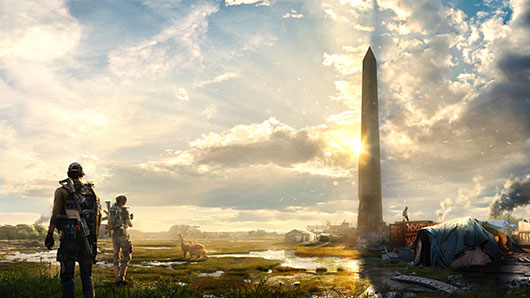
Lead a team of elite agents into a post-pandemic Washington D.C. to restore order and prevent the collapse of the city.
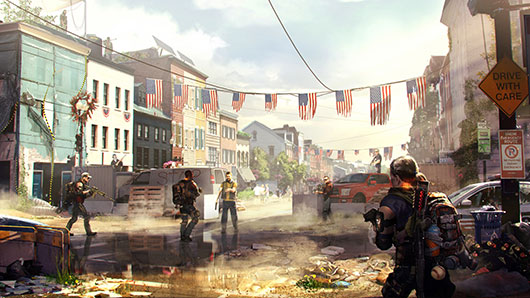
Game Details
Play with your friends in co-op and PvP, earn powerful weapons and gear, and become one of the few who can protect the capitol in the face of crisis.
Visit Other Tom Clancy's The Division 2 Channels
U.S. lawmakers support Dalai Lama amid questions over Tibet’s future
The U.S. delegation gave the Dalai Lama a framed copy of the Resolve Tibet Act that was passed by Congress last week and represents a shift in U.S. policy toward Tibet.
NEW DELHI — A bipartisan U.S. congressional delegation made rare calls for Tibetan self-determination on Indian soil during a visit to the Dalai Lama’s Himalayan home on Wednesday, as speculation mounts over Tibet’s future.
The question of who will succeed the 88-year-old Dalai Lama — and how he or she will be chosen — has intensified in recent years amid reports of the exiled Tibetan monk’s declining health and increasingly rare public appearances.
The Communist Party-led Chinese government, which rules Tibet as an autonomous region, has insisted that it holds the power to effectively choose the Dalai Lama’s successor, a claim rejected by most Tibetans.
Senior monks in Tibet, a deeply religious Buddhist region, have traditionally identified a child as the reincarnation of the leader following the previous Dalai Lama’s death. The 14th and current Dalai Lama, Tenzin Gyatso, has said he or a committee may choose a successor before he dies, and this successor may not be born inside China.
The Dalai Lama, who turns 89 in July, has long said that he may not be reincarnated at all, which would deny legitimacy to whomever Beijing chooses to be his successor in the eyes of many Tibetans.
GET CAUGHT UP Stories to keep you informed

Convicted serial rapist linked to Shenandoah park murders, FBI says

U.S. bans sales of Kaspersky anti-virus software, citing ties to Russia

Trump pledges green cards for college grads, reviving a Hillary Clinton idea

Donald Sutherland, ‘shape-shifty’ movie stalwart, dies at 88

Too broke to join a wedding party? You can say no.
The U.S. delegation, which was led by House Foreign Affairs Committee Chairman Michael McCaul (R-Tex.) and included former House speaker Nancy Pelosi (D-Calif.), told reporters Wednesday that U.S. support for Tibet remains steadfast and urged Beijing to engage in “unconditional dialogue” with the Dalai Lama.
The legislators also presented to the Dalai Lama, at his home in Dharamshala, a framed copy of the Resolve Tibet Act that was passed by Congress last week and represents a shift in U.S. policy toward Tibet. It states that Washington believes the dispute between Tibet and China remains unresolved in accordance with international law, and it rejects China’s claim that the Tibet issue is an internal matter and that Tibet has been part of Chinese territory since “ancient times.” President Biden is expected to sign the bill into law.
For decades, official U.S. policy has recognized Tibet as part of China.
“It is still my hope that one day the Dalai Lama and his people will return to Tibet in peace,” McCaul told reporters following the meeting, according to Reuters. He added that the United States “will not let” Beijing play a role in the selection of the Dalai Lama’s successor.
The Chinese government, which considers the Dalai Lama a separatist, asked the United States to stop meddling in Xizang — the Chinese name for Tibet — while its state media called the trip a U.S. effort to “contain” China.
“Xizang affairs are China’s internal affairs,” Chinese Foreign Ministry spokesman Lin Jian said Thursday ahead of the meeting. “We urge the U.S. to clearly see the sensitivity and importance of Xizang-related issues … and stop sending out wrong signals to the world.”
Tenzin Lekshay, a spokesman for the Central Tibetan Administration, the government in exile, said in comments to The Post that “there is a convergence of the free world in showing solidarity and support for Tibet,” including between India and the United States. He added that in particular the United States has been at the forefront, with many policies adopted for Tibet.
Lobsang Gyatso Sither, a member of the Tibetan parliament in exile and director of technology at the Tibet Action Institute, a Tibetan advocacy group, said the presentation of the Resolve Tibet Act, which would challenge Chinese claims that Tibet has long been part of China, was significant and showed that the United States is no longer cowed by the Chinese government’s warnings and outrage.
“This is China’s playbook, and the world has wisened to it,” he said. “This no longer works.”
Indian officials did not comment on the visit, but the U.S. delegation’s trip was notable given that foreign officials visiting India are usually not permitted to address the media, particularly on political or human rights issues deemed sensitive by the New Delhi government. Pelosi has addressed public audiences on previous visits to Dharamshala, including a visit in 2017, when she called for an “autonomous, authentic” Tibet. But she and other U.S. lawmakers went further on this visit in calling for Tibetan self-determination.
“The People’s Republic of China must respect the rights of the Tibetan people under international law, including their right to self-determination,” Rep. Jim McGovern (D-Mass.) said in a speech. “This is about basic human dignity.”
“The comments on self-determination appear to be a major departure, and what that exactly means needs to be studied,” said Srikanth Kondapalli, an expert on India-China relations at Jawaharlal Nehru University. He added that India tends to be “cautious” about the Tibet issue compared with Washington because of its ongoing border dispute with China, which takes place precisely in the Himalayan highlands once controlled by the ancient Tibetan kingdom.
“One of the issues India is concerned about is the fallout over the territorial dispute and the military clashes,” Kondapalli said. “The U.S. doesn’t have a border with Tibet and China. It’s a luxury the United States has, unlike India.”
Following their Dharamshala visit, the U.S. delegation also held meetings in New Delhi with Indian Prime Minister Narendra Modi and External Affairs Minister S. Jaishankar and discussed the bilateral strategic relationship.


IMAGES
VIDEO
COMMENTS
Essential Information. Whatever type of traveller you are, there's some information you simply can't do without. Whether it's time zones, visas, weather in the Maltese Islands, hospitals, language, or public holidays you have questions about, you're sure to find an answer. And with all the information you need a mere click away, you can ...
22. Binge some movies and TV shows set in Malta before you go. Lastly, this is an incredibly dorky tip, but there are SO many movies that have filmed in Malta over the years, so a really great thing to do in advance of your trip is simply binging some to get excited. Some big name ones you might recognize include….
Dress respectfully when entering a church - having a shawl to cover shoulders is a good idea - and hats and sunglasses should be removed. Away from the beach, cover up with a sarong and T-shirt, and note that topless and nude sunbathing is illegal. When meeting someone for the first time, a handshake is appropriate.
Tip #1: You can negotiate the price and lower it by a few euros. Tip #2: If possible, look for a taxi station instead of catching one on the street. Tip #2: You can also use Uber or Malta's eCabs app. Marsaxlokk fishing village.
Get all the information you need for your trip to Malta! Book tickets, discover new places to visit, find amazing things to do and more!
6. Understanding Malta's history and culture. While the tourists you'll meet in Malta are mostly British and Irish (to a mindboggling degree), Malta itself may be the most quintessentially Mediterranean country in the world. Look for the middle of the Mediterranean Sea and there you'll find Malta.
Getting Around: Malta has an efficient public bus system that connects to the airport, cruise port, and most cities, towns, and tourist sites, including on Gozo. If you decide to rent a car, keep in mind that Malta adheres to British driving rules, meaning cars have their steering wheels on the car's righthand side, and driving is on the lefthand side of the road.
Malta is a small island nation in the middle of Mediterranean Sea and to the southern island of Sicily, Italy. The charming landscape, secluded beaches, warm climate, vibrant life, long-standing history, cultural diversity and especially it possesses massive fortresses, ancient temples that have made this place to be one of the most attractive destinations in […]
The cost of traveling to Malta varies based on what you like and how you travel. Malta is often a good choice for those looking to stick to a budget when compared to other European spots. Staying at a hostel begins at €20-30 per night, while Airbnb options can range from €100 and up.
Malta is located in the Southern Mediterranean sea, just south of the island of Sicily and to the north of Tunisia and Libya in North Africa. Because of its location, it is one of the warmest places to visit in Europe year-round and a great place if you're on the hunt for a bit of winter sunshine. However, it is worth noting that it isn't ...
The Mediterranean climate is one of the reasons for the success of trips to Malta. The weather in Malta is mild in winter and very warm in summer. Malta has less than 60 days of rain per year, compared to Paris, which has about 170 days of rain per year. Summers in Malta are very hot and marked by the arrival of the Sirocco.
The Maltese Cross. VisitMalta is the official website for Malta, Gozo & Comino. Malta is a great place to visit for sea, sun, culture, attractions and all year round events.
Swimming and sunbathing. Malta and Gozo have a number of beautiful beaches to offer. The largest will be the busiest in July/August, however, so it's worth being curious and exploring a few beaches and bays "off the beaten path". Have a look at my list of best beaches in Malta and don't be shy to ask a local for tips!
The bus will get you virtually anywhere you need to go on the island of Malta. For 21 Euros, you can buy a seven-day unlimited travel pass for Malta's bus system. Standalone, one-way tickets are 2 Euros in the summer, 1.50 Euros in the winter, and 3.00 Euros for night journeys and express buses. READ NEXT.
Tips for visiting Malta no. 1 - Get a window seat on the plane as the views of the islands are fantastic as you fly over. The main languages spoken on the islands are Maltese and English. The Euro is the unit of currency. The main airline is Air Malta. Victoria, the capital of Gozo, is also known as Rabat.
Overall Budget: Backpacker: €58 ($65) /day for 2 people. Mid-range: €67 - €89 ($75 - $100) /day for 2 people. Top End: $100 - $1,000+ (€89 - €890) / day. Visiting Malta can be inexpensive and like some places in Eastern Europe (Bulgaria & Macedonia) your travel budget can range very widely.If you were to be on a super tight budget, you could get by on €58 ($65) / day for a ...
With more and more people choosing to live in Malta and tourism on the increase, construction work seems to be endless. With hotels adding additional floors, the building of new apartments and old buildings coming down, there's always work going on somewhere. Luckily, much of the work tends to take place in the winter months when the weather ...
DAY 1: EXPLORE VALLETTA CITY. Start your day in Valletta, Malta's capital city, by visiting the Upper and Lower Barrakka Gardens. These beautifully landscaped gardens offer panoramic views of the Grand Harbour and the Three Cities (which we'll discuss on day 2), making them perfect for a relaxing morning stroll.
How to spend one week in Malta. My Malta Itinerary for 7 days. Day 1: Valletta. Day 2: Comino & Blue Lagoon. Day 3: Exploring Gozo Island. Day 4: Mdina, Rabat and surroundings. Day 5: Floriana and The Three Cities. Day 6: Blue Grotto, Marsaxlokk and Megalithic Temples. Day 7: Mellieħa and surroundings.
Day 1 - Sliema. Malta's largest city of Sliema is the perfect place to base yourself on the island. A stone's throw away from the historical capital of Malta, Valletta, Sliema is also incredibly well connected in terms of public transport with most buses passing through the city. But while it seems like more and more people are basing ...
Valletta: Malta's Elegant Capital. 2. The Idyllic Island of Gozo. 3. The Medieval Hilltop Town of Mdina, Island of Malta. 4. Historical Attractions in Rabat, Island of Malta. 5. Ħal Saflieni Hypogeum, Island of Malta: A Neolithic Cult Site.
Answers to these and many other questions can be found in this section, together with useful tips, bank information and much more. All those little details that put your mind at rest before you travel, as well as information you may need while you're here. More info can be found in the Facts & Tips section and on the FAQ page. If you still ...
I have got the answer for you, and it is a wholehearted YES - Malta is worth visiting in 2024! Slow travelers, couples, and adventure travelers will find themselves drawn to Malta for many different reasons. Even families love Malta - for several reasons. I have just returned from Malta and totally loved it. The small island is located ...
HAVANA (AP) — A fleet of Russian warships, including a nuclear-powered submarine, left Havana's port on Monday after a five-day visit to Cuba following planned military drills in the Atlantic Ocean.The exercise has been seen by some as a show of strength by Moscow against the backdrop of tensions as U.S. and other Western nations support Kyiv in Russia's war on Ukraine.
As an island located at the heart of the Mediterranean, Malta has been a transitional or stopping point for people on the move throughout history. Today, Malta is home to more than 11 000 refugees and 2000 asylum-seekers, predominantly from Bangladesh, Libya, Syria, Sudan and Ukraine. Since the full-scale invasion of Ukraine began in 2022, Malta has also issued over 2000 Temporary Protection ...
Up to 30% of STSS infections are fatal: The condition usually starts with a fever, chills, muscle aches, nausea or vomiting but can become life-threatening in 24 to 48 hours if left untreated.
The most similar plan from Travel Guard is the mid-tier Travel Guard Preferred plan, which which you'll get up to $150,000 in trip cancellation coverage, trip interruption coverage up to $225,000 ...
SEASONAL JOURNEY. Q: What will Seasons 2.0 consist of? A: There are 15 weeks of varied activities such as Seasonal Missions, Seasonal Projects, Manhunt Scouts and Priority Objectives to be completed with your seasonal character, followed by a 2-week Intermission period during which you can utilize your main character. Your non-seasonal character can be accessed at any time during the Season ...
Juneteenth, which commemorates the end of slavery in the United States, became the newest US federal holiday in 2021, though its storied history has held significance for many Black Americans for ...
The U.S. delegation gave the Dalai Lama a framed copy of the Resolve Tibet Act that was passed by Congress last week and represents a shift in U.S. policy toward Tibet.